

comprehensive tourist maps for busy professionals
Essential walking map of venice.
This walking map of Venice includes all the best things to see in Venice , and more! Use this Venice walking tour map to explore top-rated tourist attractions at your own pace and preference.
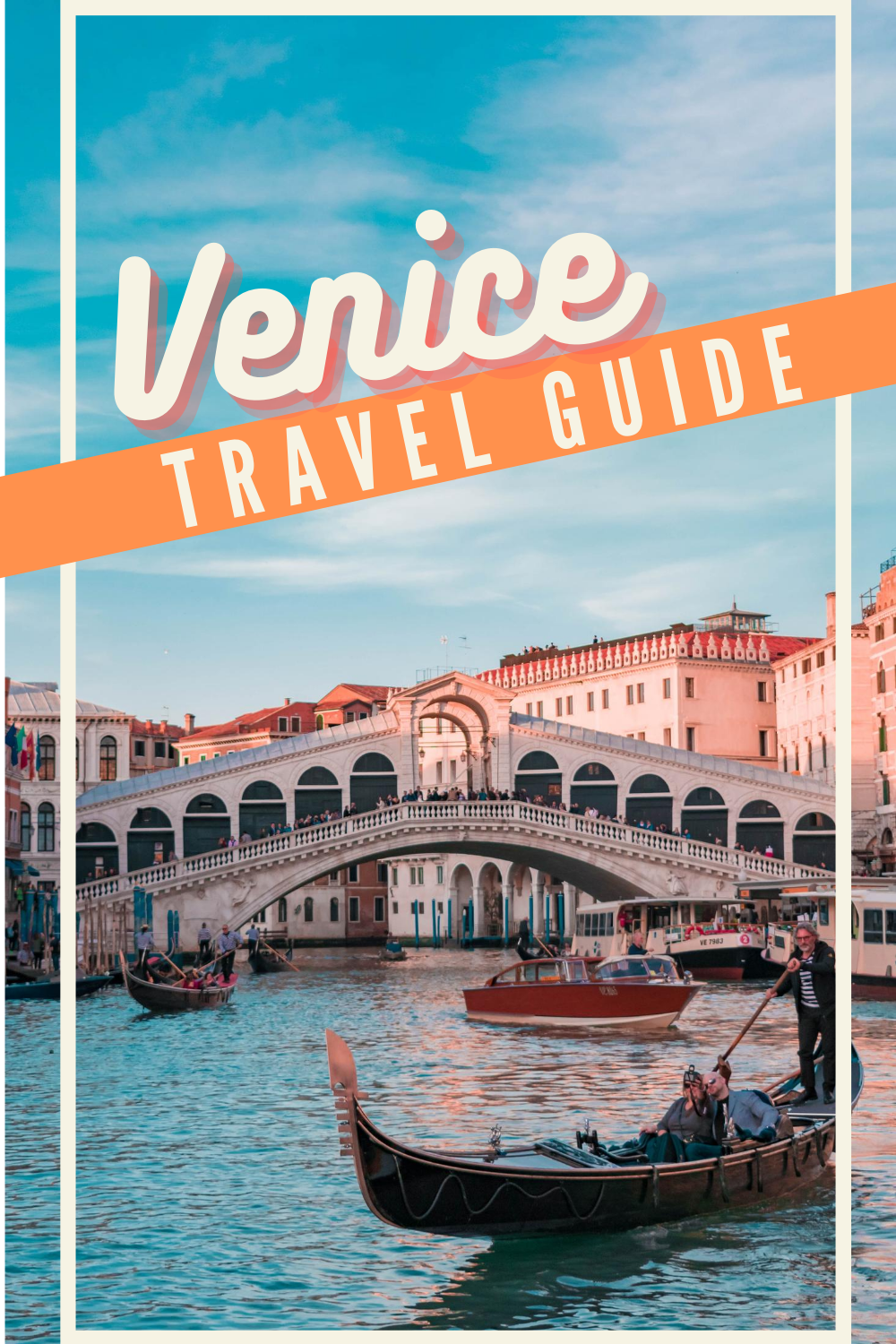
Venice is an iconic European city. It’s winding canals, quaint bridges and living history are legendary. Venice is a romantic city for couples. Many parts of Venice have been designated as UNESCO World Heritage sites .
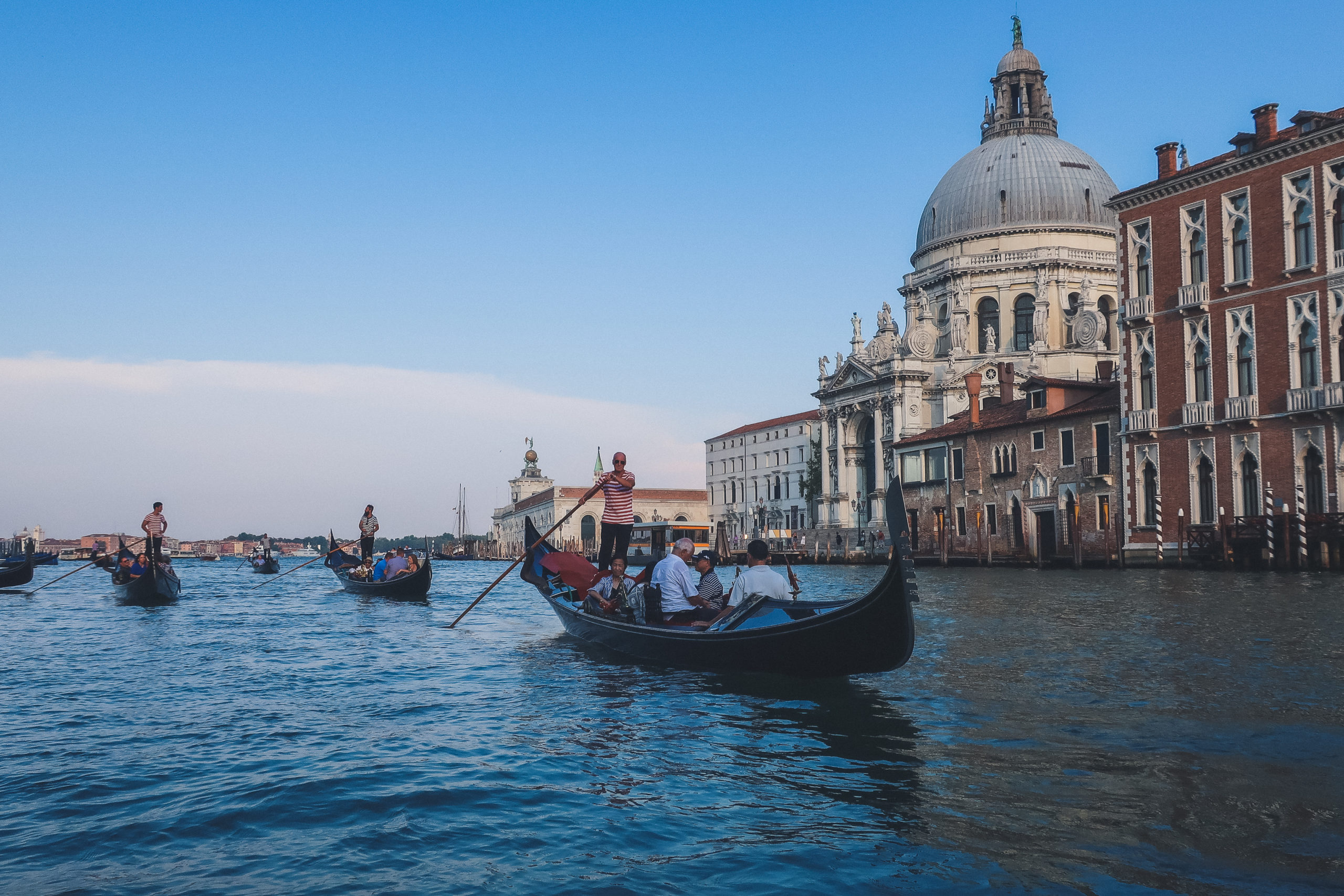
Popular activities in Venice include taking gondola rides, visiting museums, and eating freshly-caught seafood . If you are saying in Venice for 1 day or 10 days , you’ll need a walking guide…
Interactive Walking Map of Venice
Table of Contents
Rialto Bridge
Grand canal , bridge of sighs, saint mark’s square, scala contarini del bovolo, burano & murano, doge’s palace, correr museum, gallerie dell’accademia, peggy guggenheim collection, ca’rezzonico, saint mark’s basilica & clocktower, church of san zaccaria, church of saint julian, basilica san maria della salute.
This Venice Map is interactive, adjustable, and available for offline use . There are many ways you can use this walking map of Venice.
There are a few layers to this Venice Tourist Map. The best things to do in Venice are marked by blue pins. That includes famous landmarks, museums, and churches (in Italy, churches are museums).
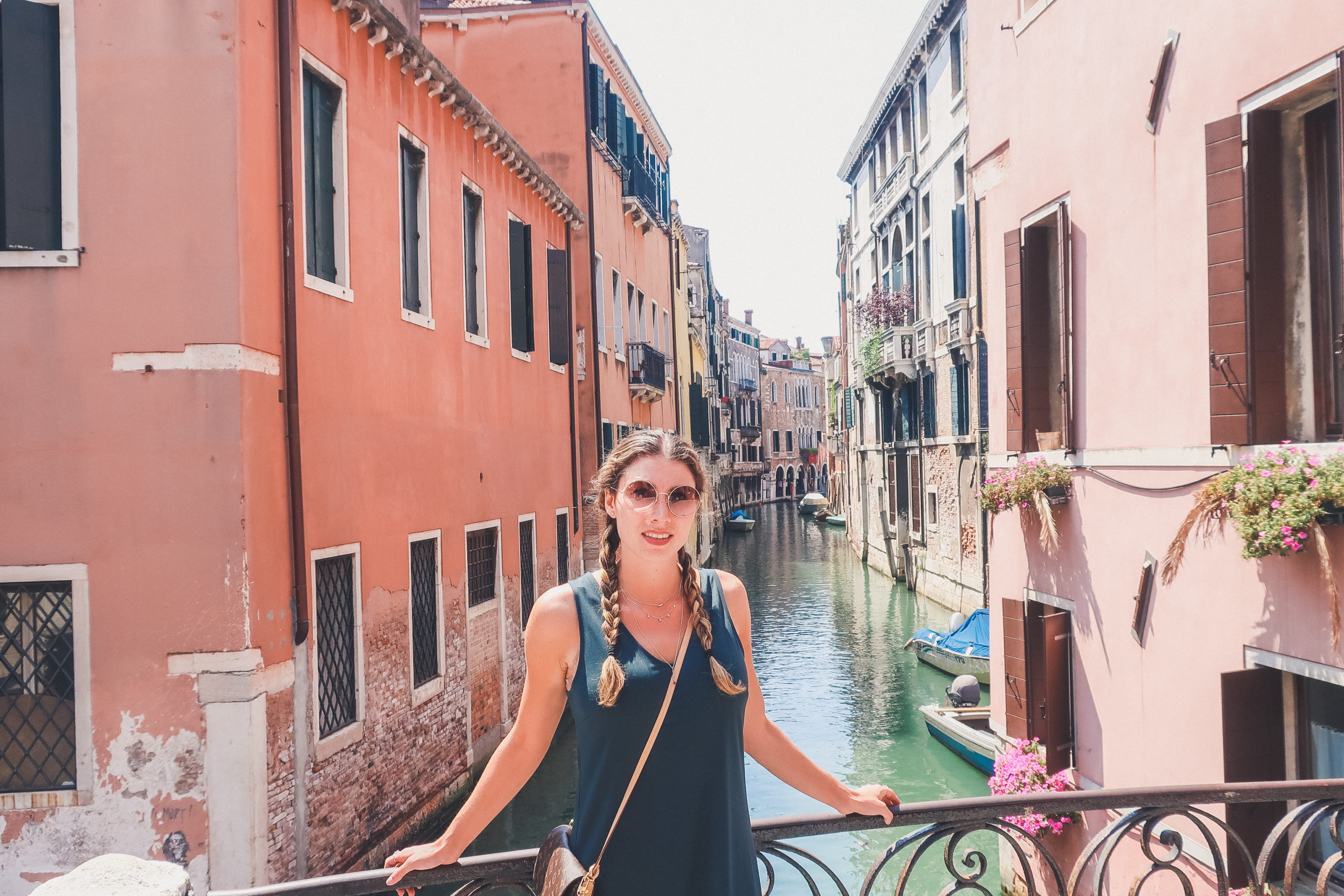
This interactive map of Venice also includes recommended restaurants . You’ll find those are marked with a green knife & fork icon. G elaterie can be identified by the pink ice cream icon. You can even find rooftop bars in this Venice attractions map! Those are indicated by purple drink icons.
How to Use This Map: If you click the tab at the top left corner, you’ll be able to select specific layers. Click the checkmark to select or hide specific categories.
Save This Map: Click the brackets in the top right corner to expand the map in full view. It will open in a new tab. Under the map title, right of the map description, there is a star. Click this star and the map will be saved to your Google account in Google Maps. You can access it later from your computer or device. On desktop, go to Google Maps and click ‘Your Places,’ and ‘Maps.’ On app view, select ‘Saved, scroll down and click ‘Maps.’
Walking Map of Venice
This map of Venice Italy includes a lot of paid attractions. Venice isn’t a cheap destination! Although, if you choose not to enter inside any of the museums or churches, you can use this walking map of Venice Italy to enjoy a completely free experience!
If you’re visiting with a special someone, make sure to check out our Venice guide for couples .
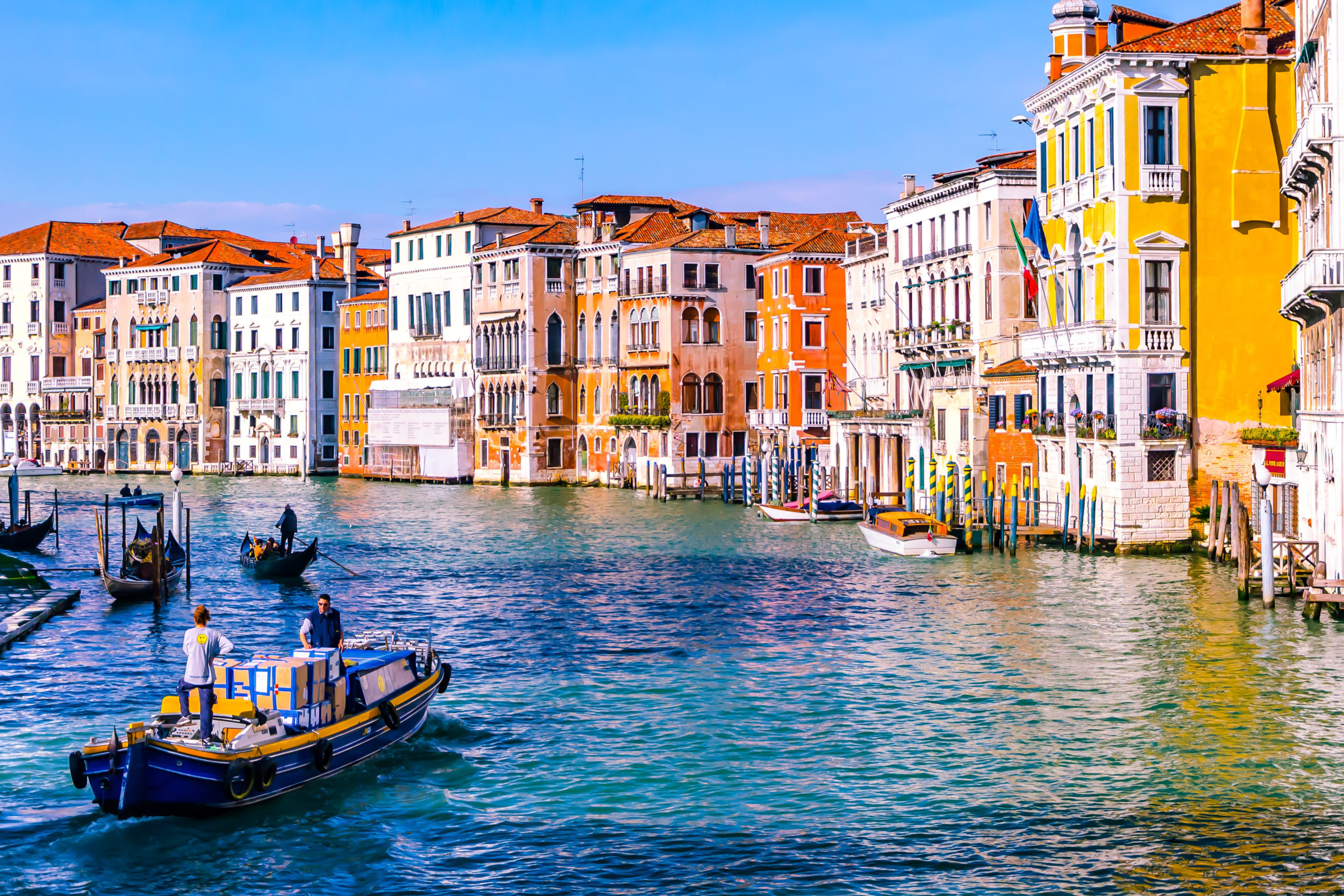
Famous Landmarks
This free Venice walking tour map includes all the famous landmarks you won’t want to miss. Including some famous bridges. Venice is known for its bridges — there are over 400 of them after all! Under those bridges, some 300 gondolas roam about among the winding canals.
Enjoying the waterways and bridges is one of the best free things to do in Venice Italy. Make sure to hit these famous landmarks when you use this Venice self-guided walking tour map!
The Rialto Bridge is one of the Venice main attractions. It is one of four bridges on our sightseeing map of Venice that spans the famous Grand Canal. This is the heart of Venice.
Walking across the Rialto Bridge is one of the best free things to do in Venice. It’s an incredible piece of history — built over 400 years ago! The Rialto Bridge is the oldest bridge to span the Grand Canal.
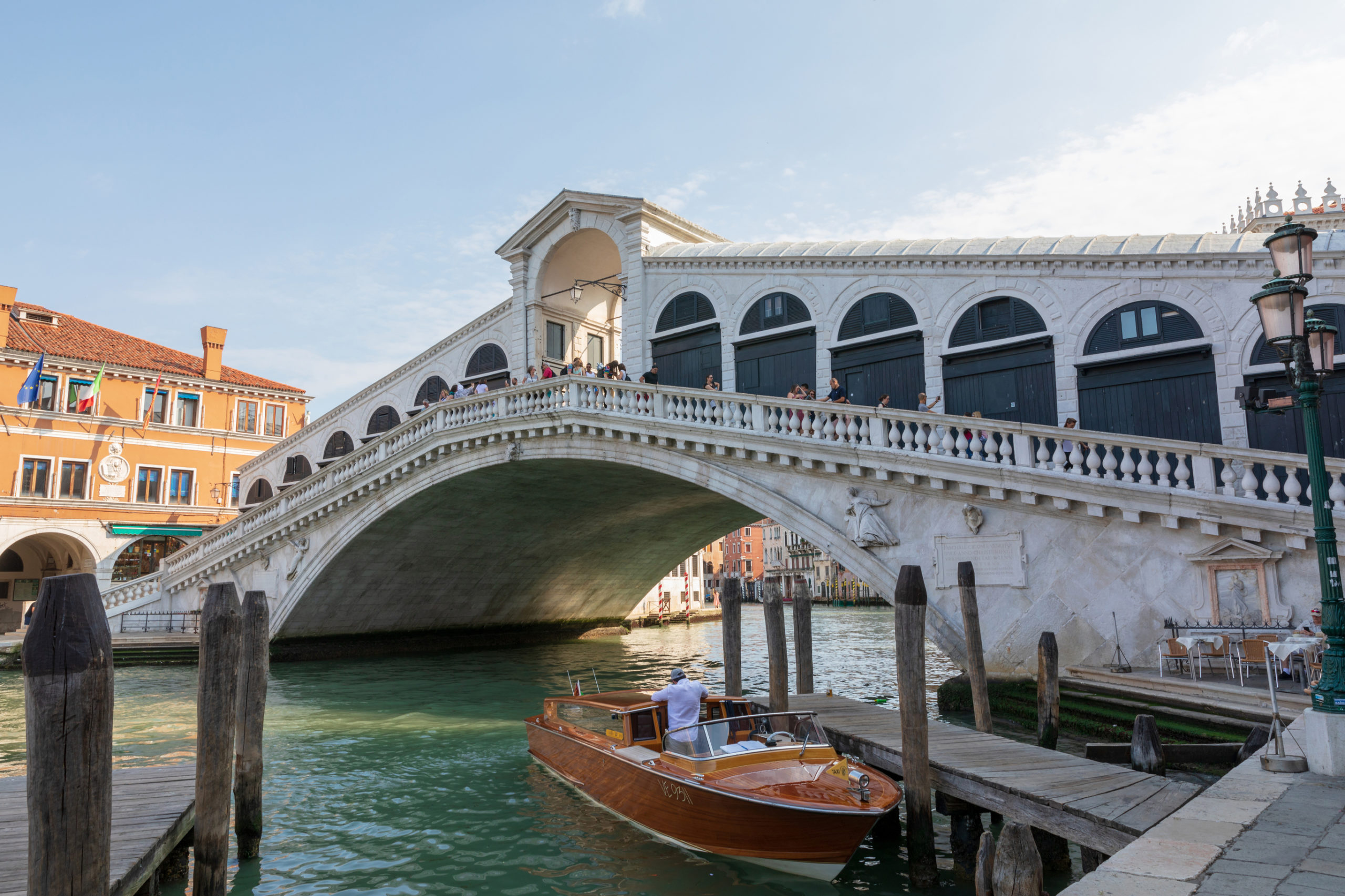
In the present day, it’s usually very busy with tourists. There are many interesting shops on either side. It’s a densely packed, high-traffic area . The real estate surrounding this bridge is some of the most pricey in all of Venice!
If you’re walking in Venice Italy, you can’t skip the Rialto Bridge. Nearby, you can get authentic gelato at Grom or La Boutique Del Gelato . Great places to eat nearby are Baci & Pasta and Osteria alle Testiere .
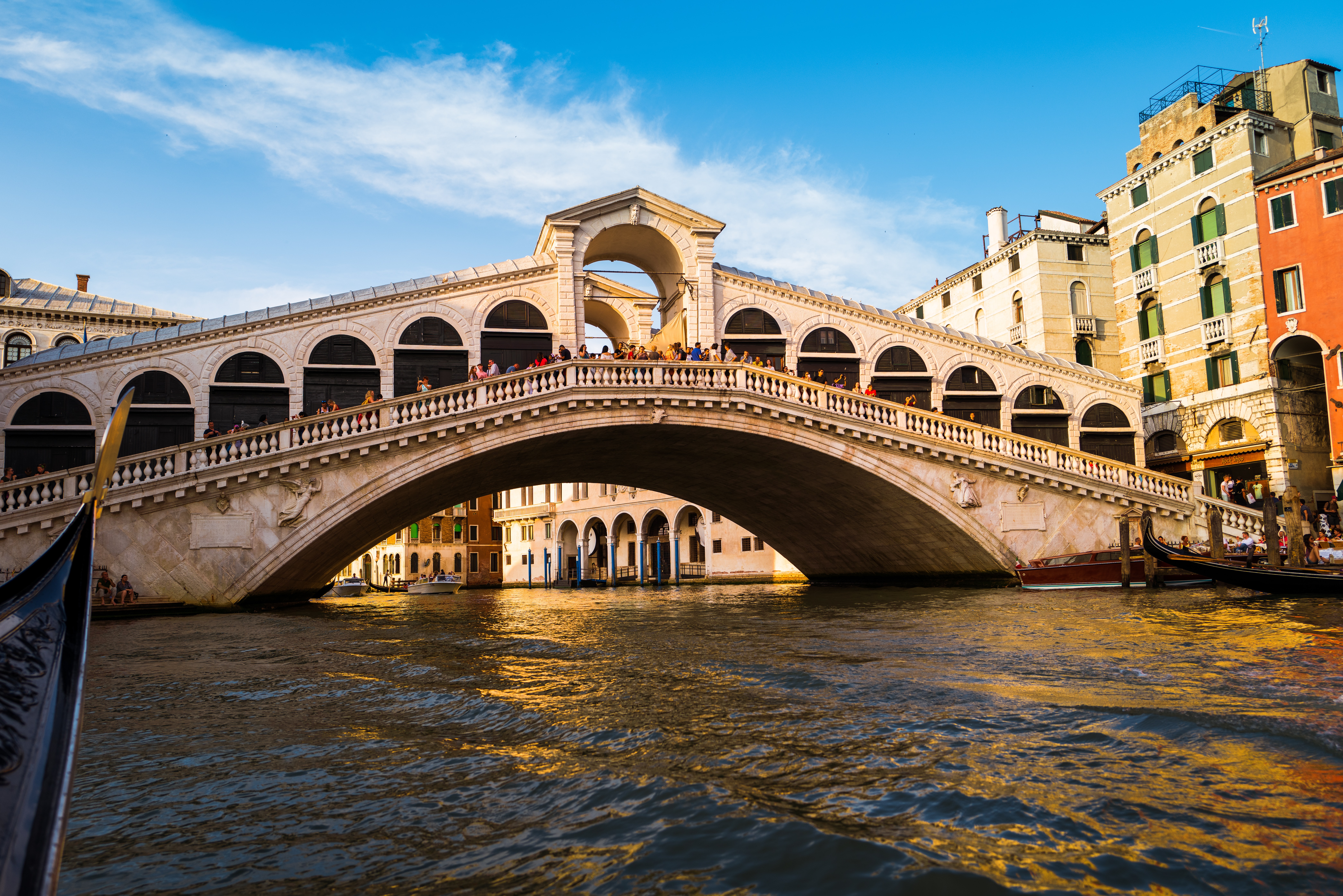
Baci & Pasta is another great joint near the Rialto Bridge that you’ll find on this tourist map of Venice. It’s a casual, budget, option. Osteria alle Testiere is a formal dining restaurant nearby serving authentic Venetian fare.
Experience Venice through food.
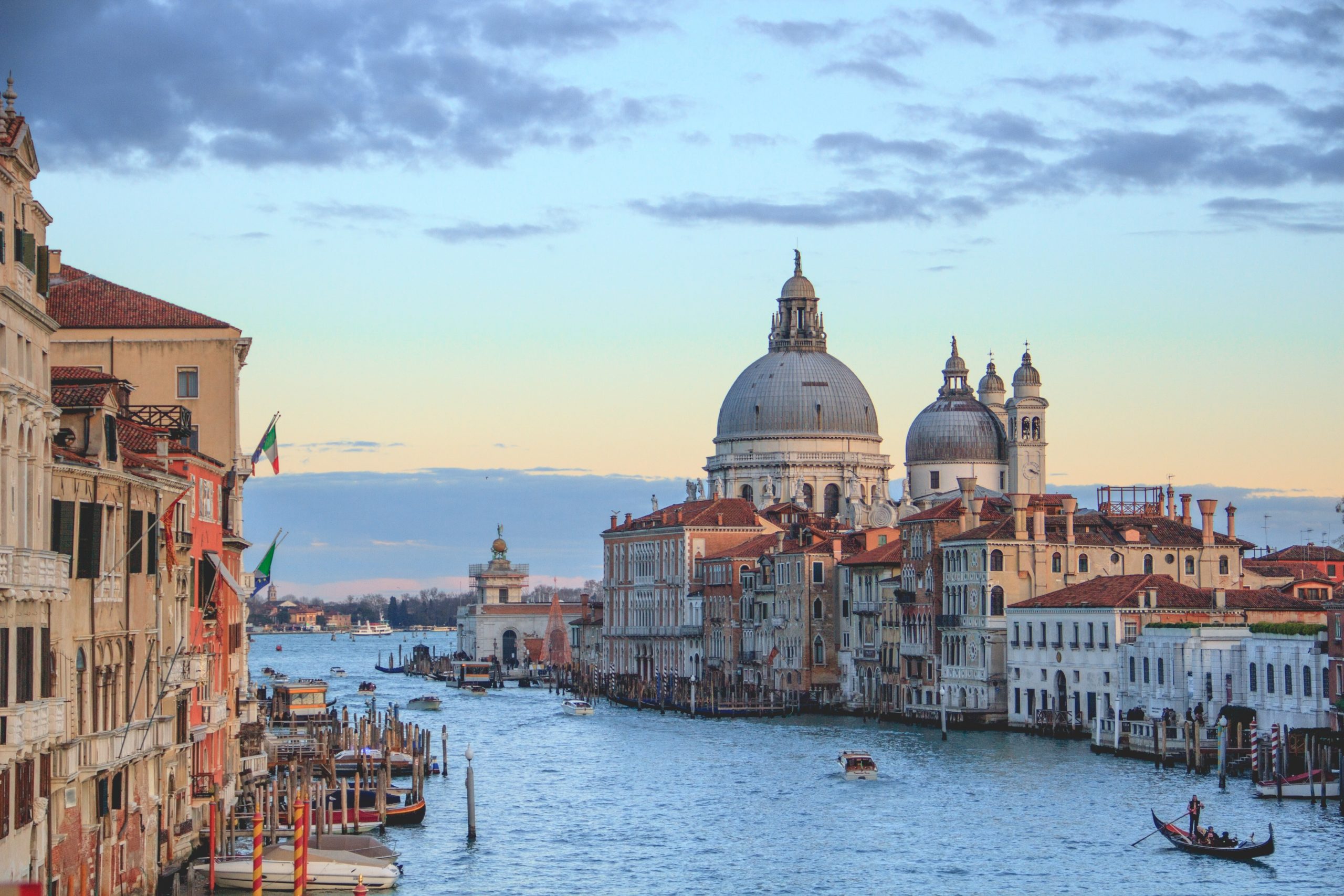
Take a tour of the legendary Grand Canal.
Along the Grand Canal, you can find buildings in Venitian Gothic, Venitian Baroque, and Venitian Byzantine. Hundreds of years ago, the wealthiest and most prestigious families built homes along the Grand Canal. Many of the top sights in Venice today are still lining the Grand Canal.
The Grand Canal isn’t exactly Venice off the beaten path… it’s pretty touristy! Although, it’s an important part of the city and one of the must-do things in Venice.
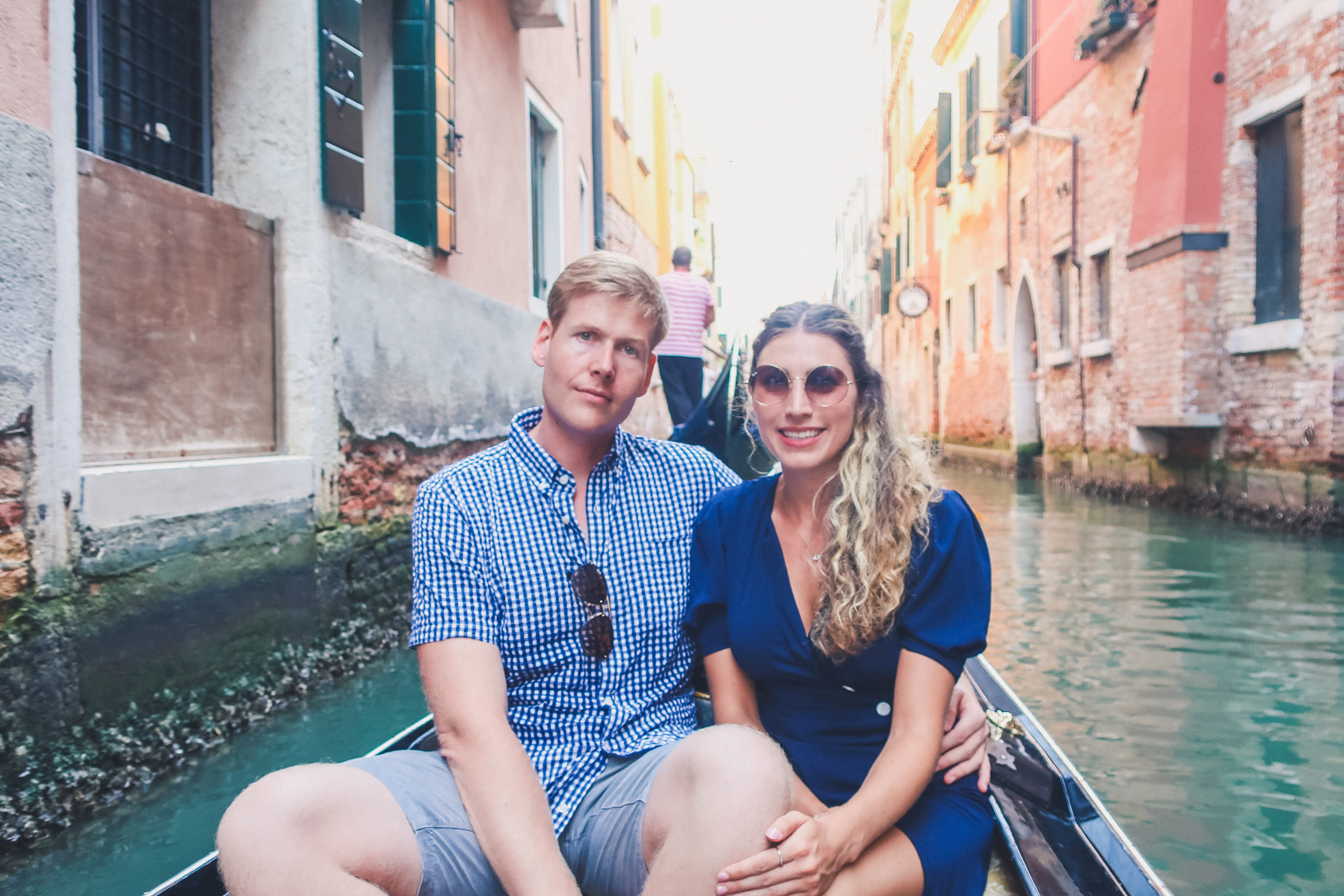
Book your gondola ride today.
A gondola ride through the Grand Canal is one of the must-do things in Venice. There are many gondola operators in this area. A gondola ride is the best way to experience the Grand Canal and it’s one of the most romantic experiences in the city!
If you want romance on a budget, visiting the Grand Canal is one of the best free things to do in Venice at night. You can watch the sunset over the city from the top of this historic bridge. Couples may also consider a romantic photo shoot in Venice.
The Bridge of Sighs is another one of the popular places to visit in Venice. You can’t walk along the Bridge of Sighs, you can only see it!
The best place to view the Bridge of Sighs is from the Bridge of Paglia ( Ponte della Paglia ). The Bridge of Sighs is one of the famous Venice attractions. Its purpose was to link Doge’s Palace with a prison. Legend has it that prisoners would sigh on this bridge as they got their final glimpse of beautiful Venezia .
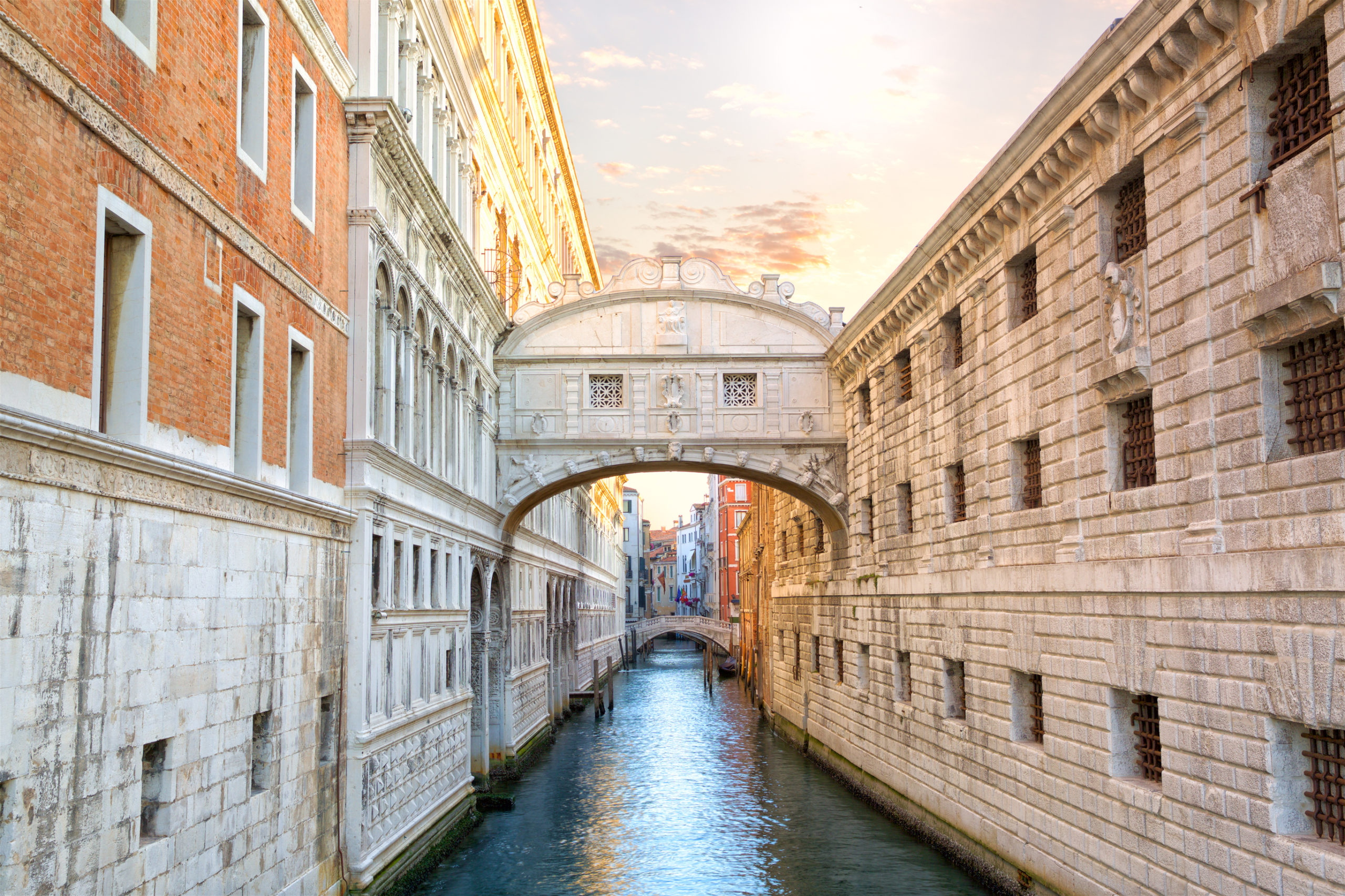
The Bridge of Signs is an enclosed in white limestone . It has windows with stone bars through them. The designer of this bridge was the nephew of the man who designed the Rialto Bridge –adding fame to these Venice tourist attractions.
In reality, not many big-time criminals passed through this bridge. By the time it was built, inquisitions and executions weren’t happening anyone. Also, it wasn’t possible to see much through the tiny barred windows.
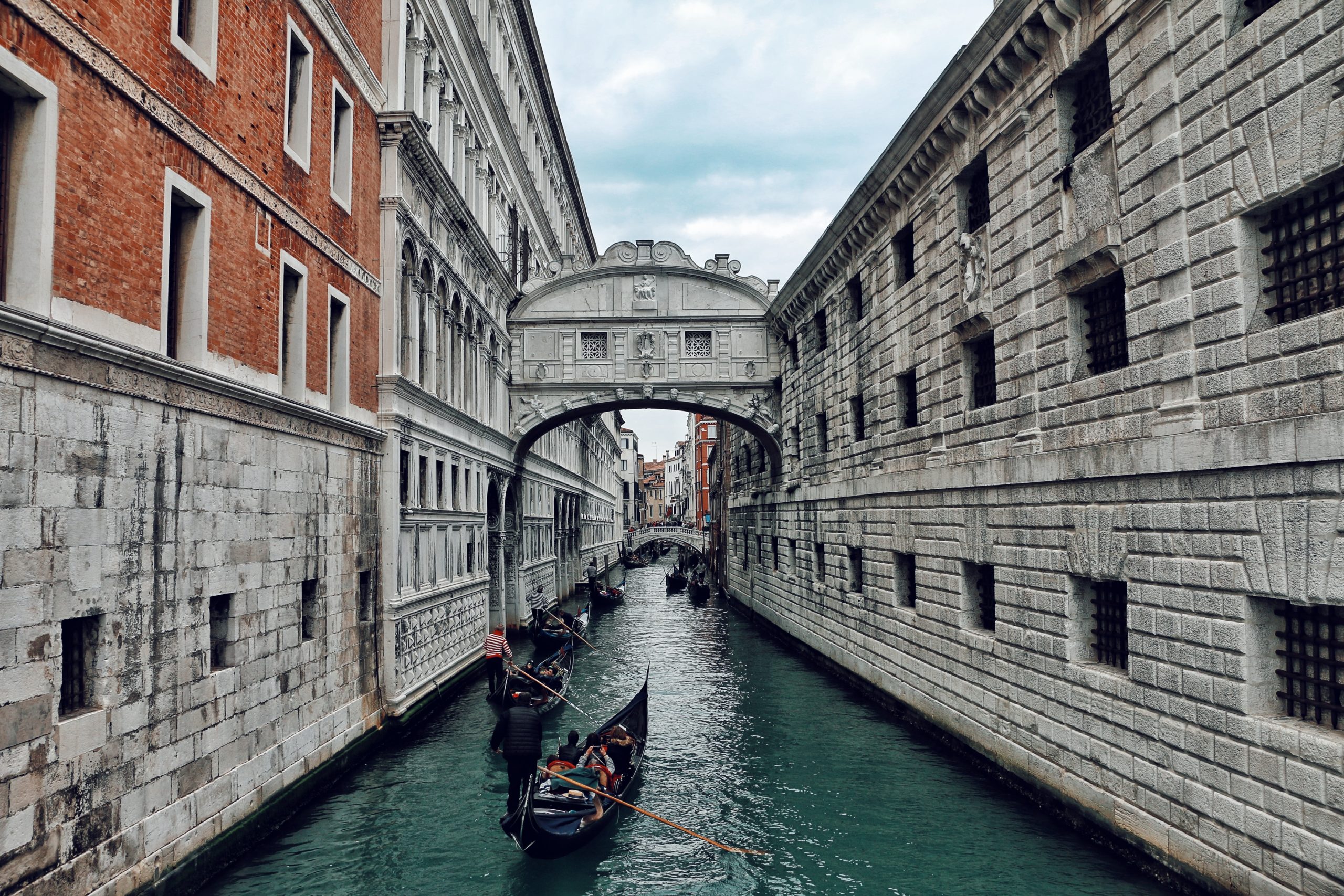
Although, it’s still a beautiful spot and visiting this bridge is one of the top things to do in Venice. Another reason that this is one of the best things to do in Venice is that it’s completely free to visit!
Saint Mark’s Square is one of the best places for Venice sightseeing. This is where everyone in Venice comes to see and be seen. It may be the largest and most important square in Venice, but it’s also considered one of the most famous squares in the world.
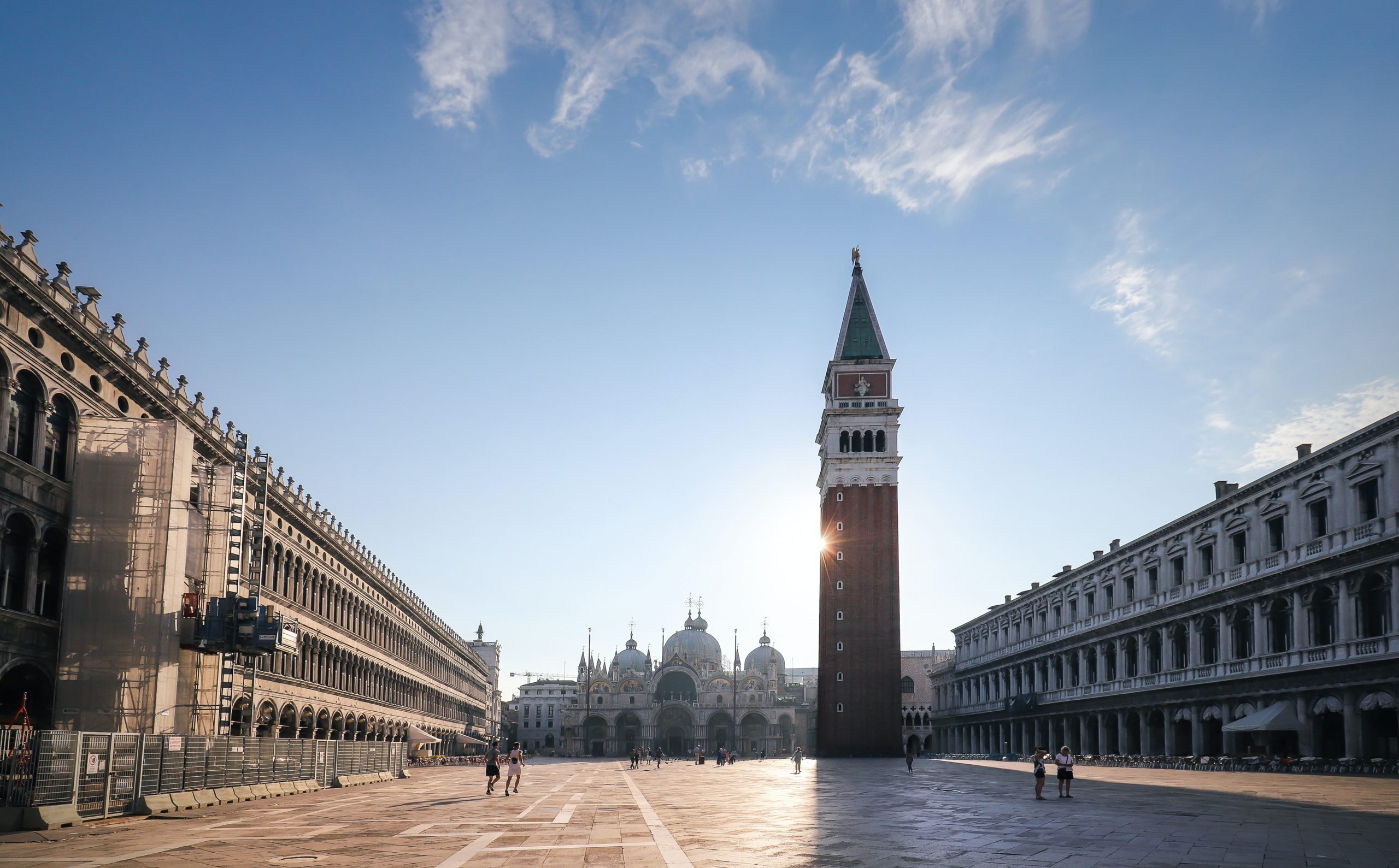
St. Marks Square offers the best views of St. Mark’s Basilica and campanile. This is a common stop on any Venice itinerary and a meeting place for many tour groups. Doge’s Palace and Museum can also be accessed from Saint Mark’s Square. Visiting Doge’s Palace is another one of the activities you must do in Venice.
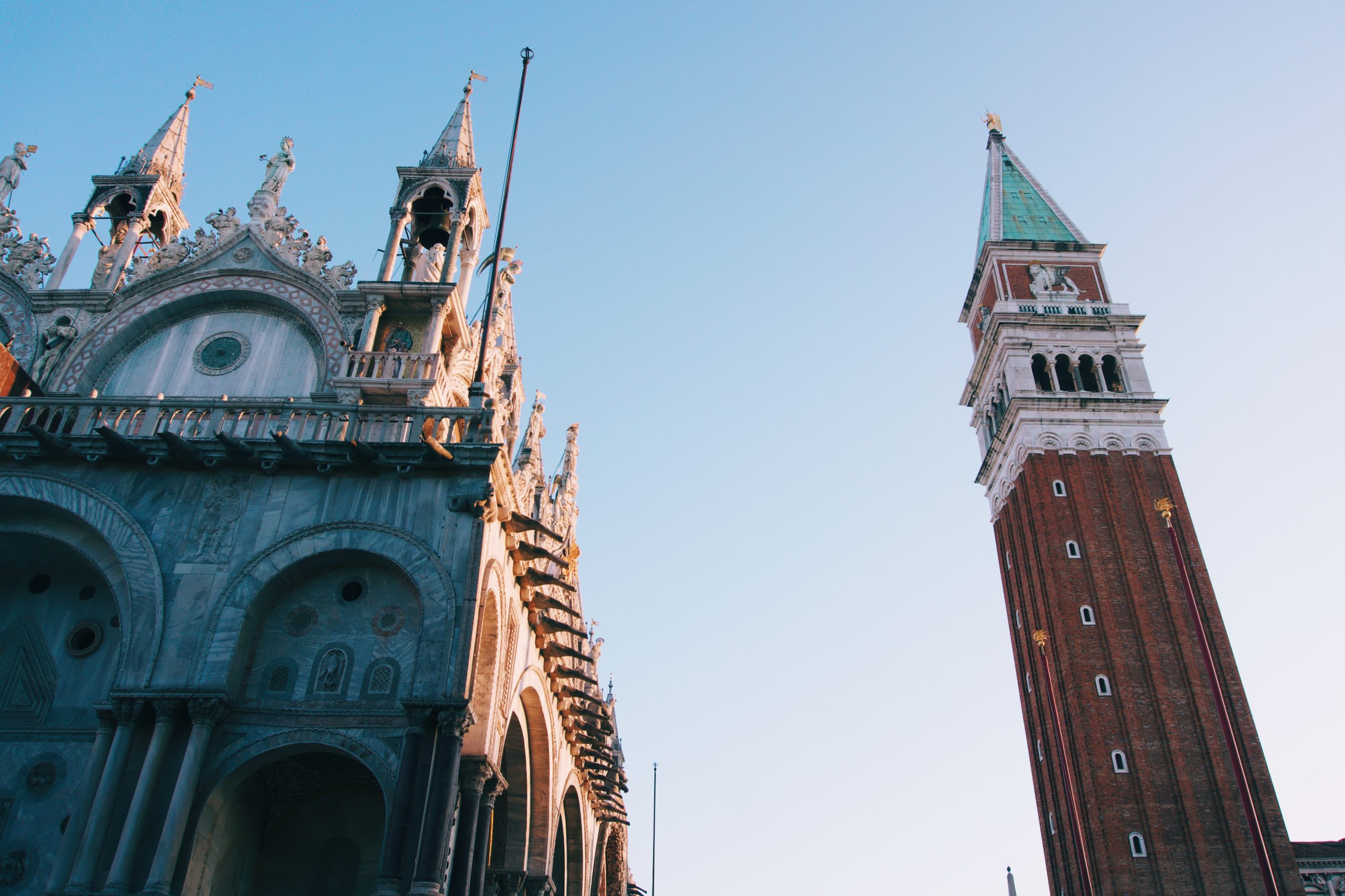
Explore the legendary St. Mark’s Basilica.
St. Mark’s Square is a must see in Venice! The square’s history dates all the way back to the 9th Century. This is a lively and busy part of the city. Stopping by for espresso and dessert at the nearby Caffè Florian is one of the recommended things to do in Venice at night. It’s considered the oldest cafe in Europe!
The Scala Contarini del Bovolo —roughly, “ staircase of the snail ” is one of the best places to visit in Venice. It’s a photographer’s dream! As you climb the staircase, you’ll notice the staircase’s unique design . It has features from a few different architectural styles.
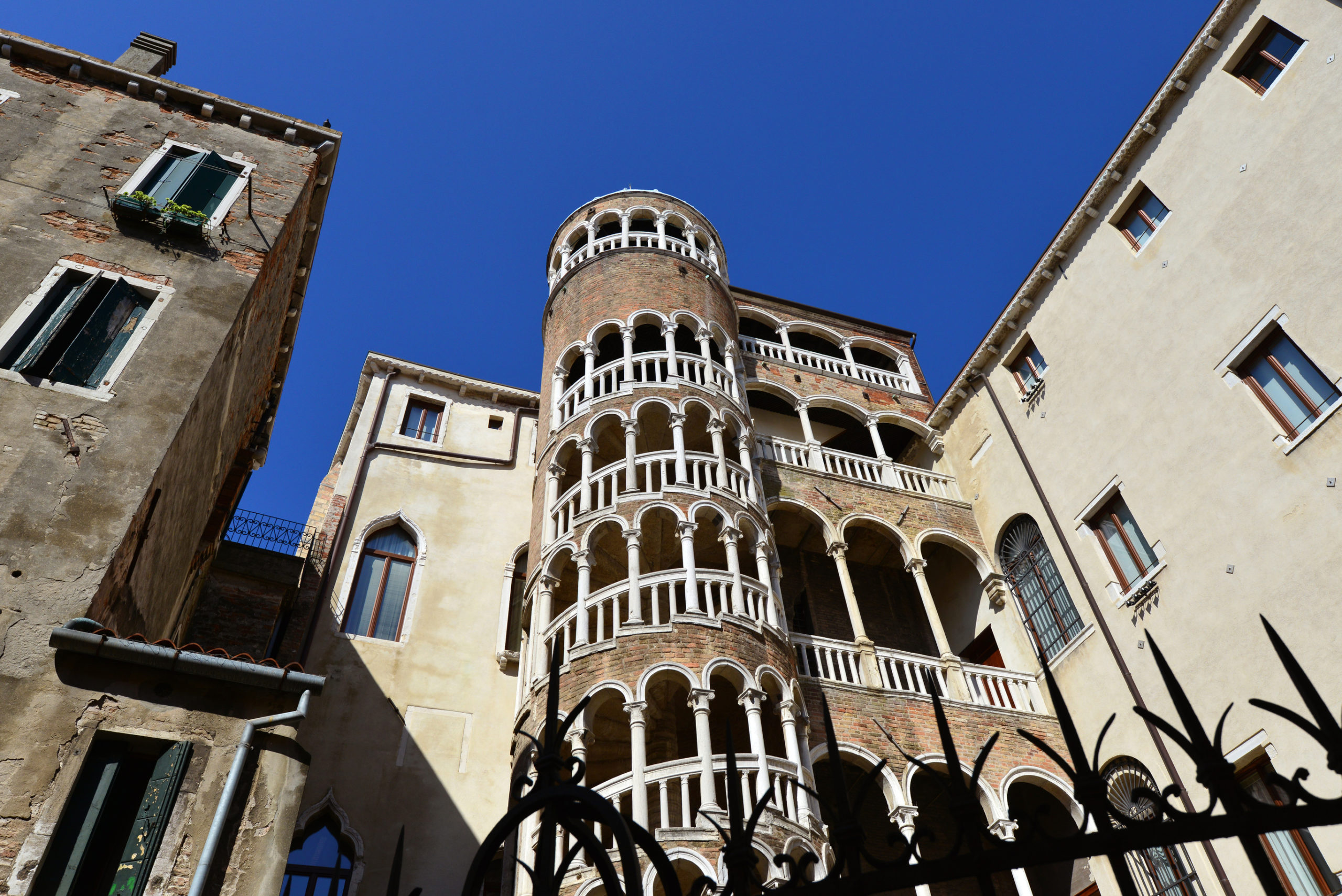
The staircase ascends into a tower. Once at the top, you’ll find amazing views of Venetian rooftops. This is one of the most amazing things to see in Venice Italy.
This staircase was originally built in the 15th Century . Entering does require a small fee, or you may choose to visit with an organized tour. No matter how you choose to visit, this is one of the top things to see in Venice for first-timers.
Burano and Murano are Venitan islands on our downloadable map of Venice that aren’t connected by a bridge. Visiting these other islands by boat is one of the adventurous things to do in Venice.
Each island has a unique vibe and atmosphere. Burano is known for its distinct, brightly painted houses. It’s very magical looking. Lacemaking and fishing are the common trades on Burano. You can shop around for handcrafted goods.
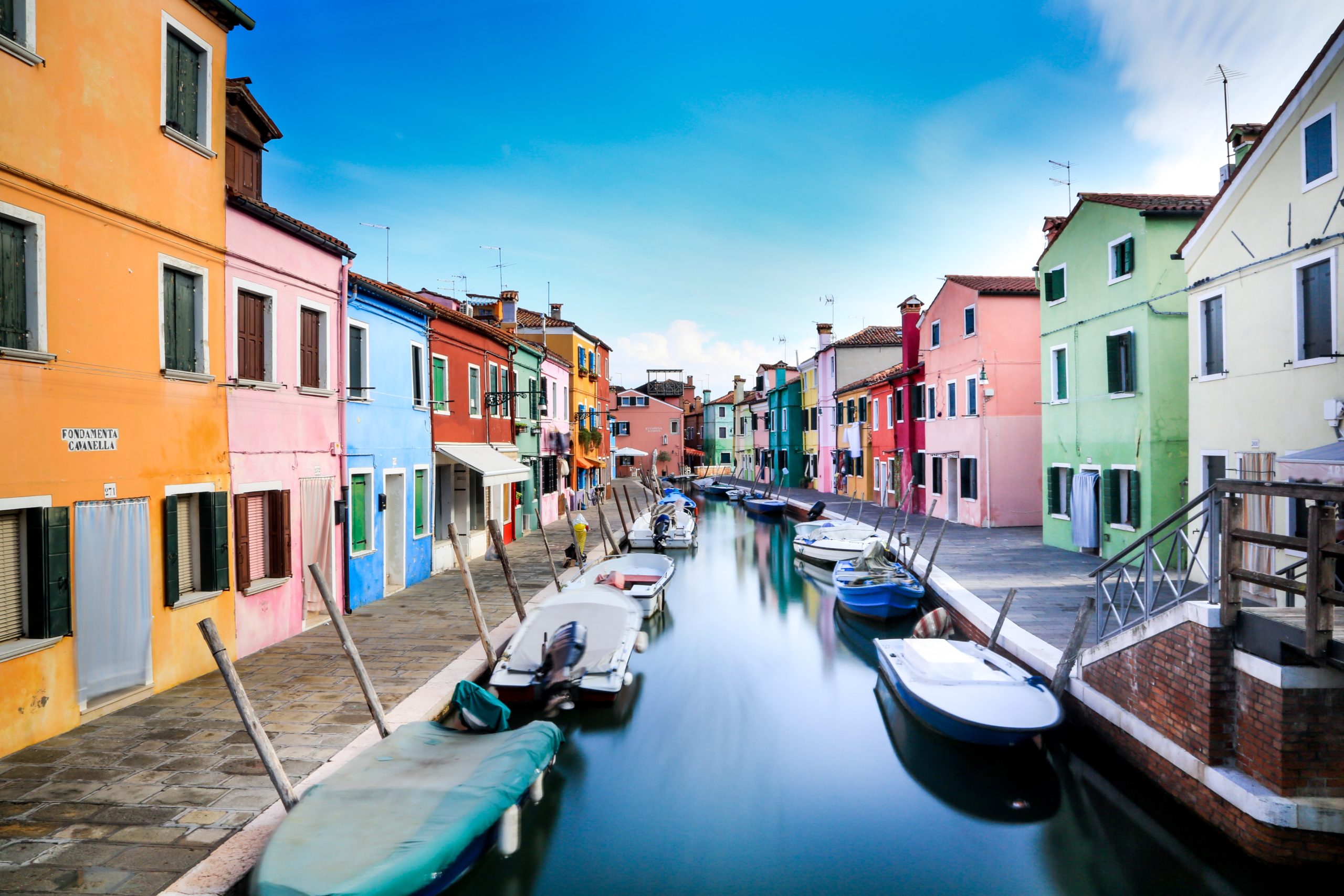
Find out how you can visit Burano & Murano.
The Lace Museum in Burano is one of the famous places to visit near Venice.
Murano island is another one of the Venice top attractions. Murano is well-known for glassmaking. Glass has been made on Venitian islands for over 1,000 years! If you are lucky enough to visit Murano with a guided tour, you’ll likely get to witness the glassmaking process. Make your own glass in Murano.
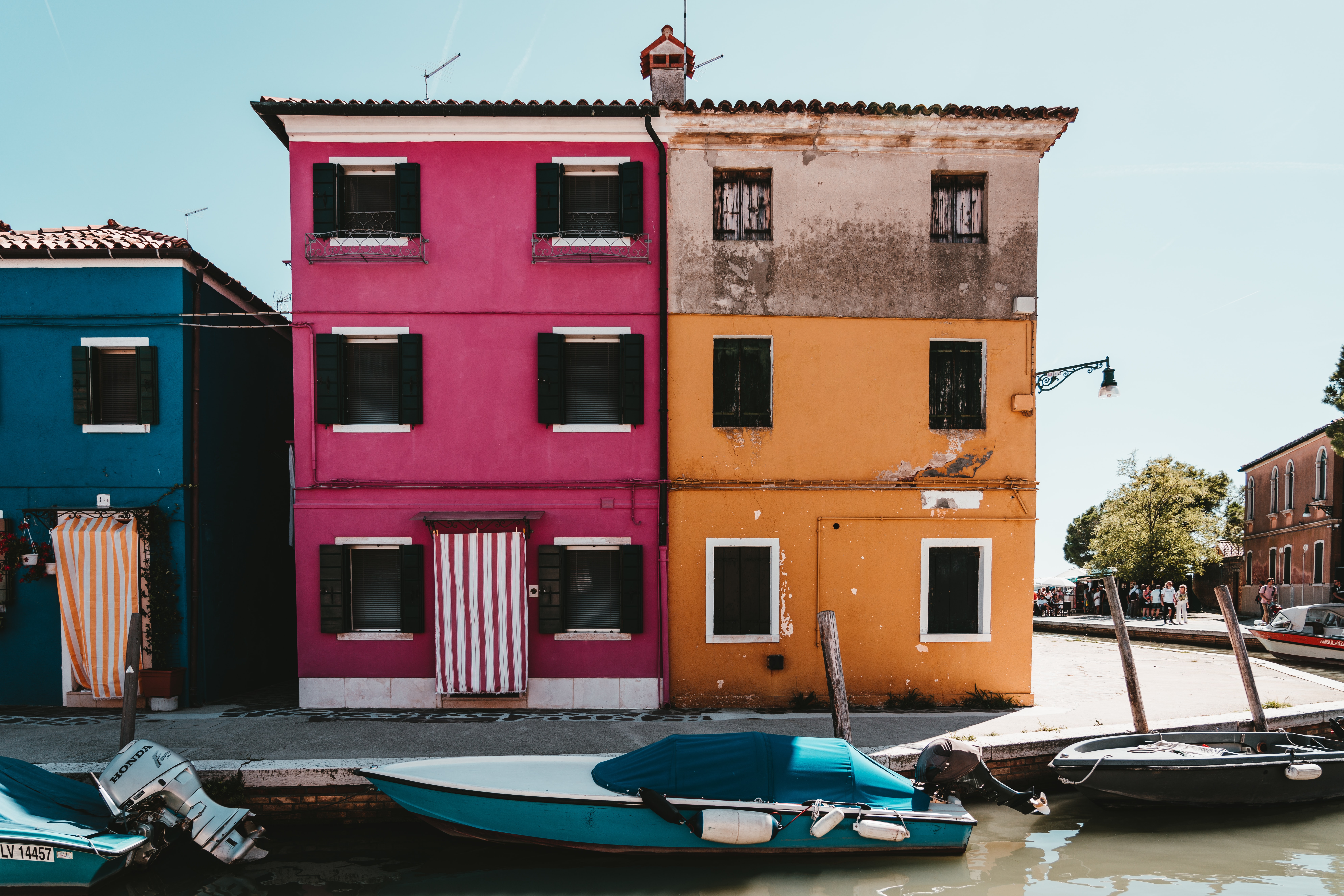
Sign up for an unforgettable glass-making workshop in Murano.
These islands are some of the less touristy places to visit in Venice Italy.
While you enjoy a Venice walking tour, you’ll have to stop at some of the legendary museums. Venice is highly regarded for the art collections and history you can find.
Some of the popular spots on our free map of Venice include Doge’s Palace, the Gallery of the Academy, the Peggy Guggenheim Collection, and the Museum Correr. We will discuss these main highlights.
If you’d rather do art than see art, check out this painting class in Venice.
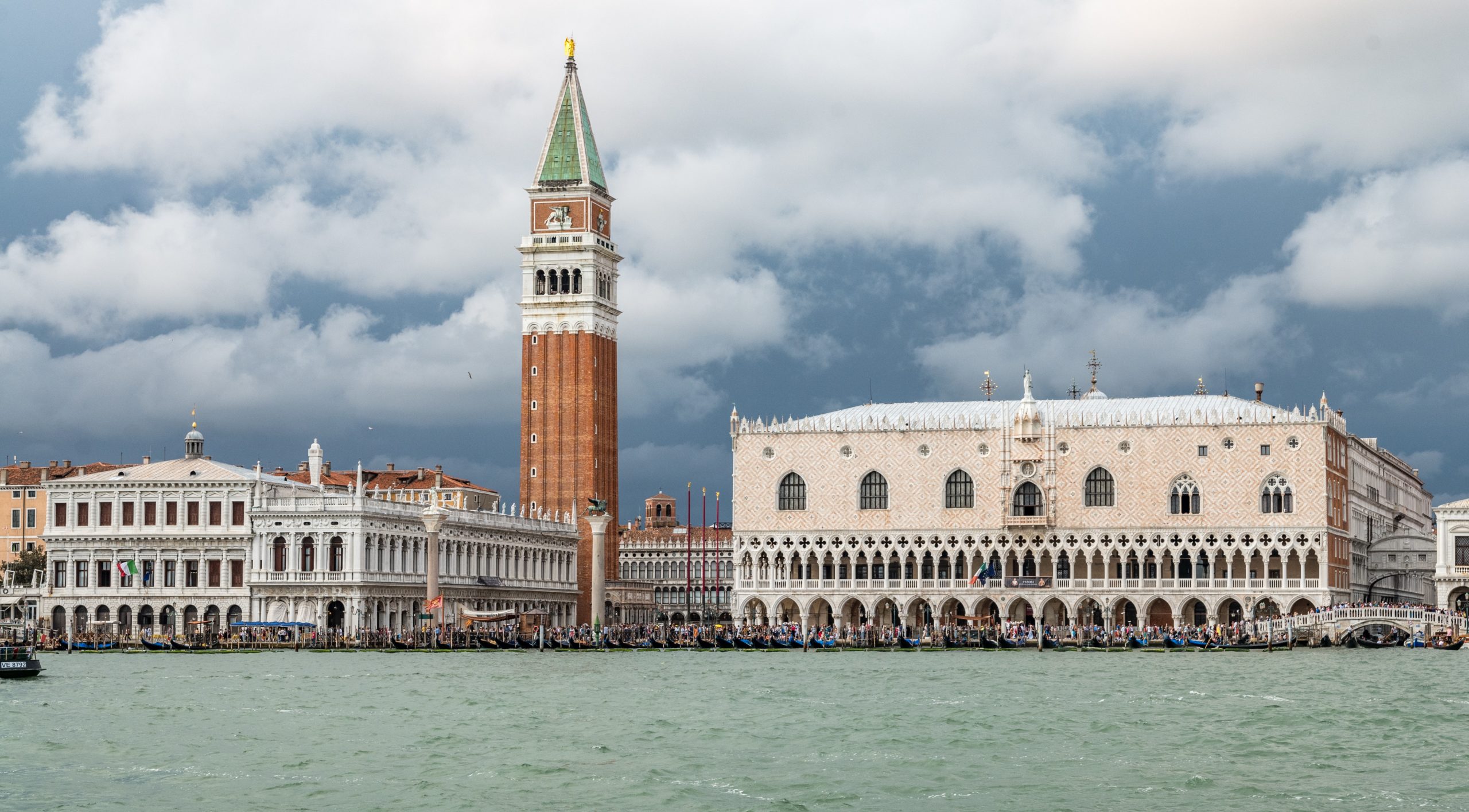
Other museums you can find on the map of Venice with attractions include a music museum at the San Maurizio Church and the Museum of Glass. This Venice walking guide also includes numerous churches (that might as well be museums) because they contain priceless art and artifacts.
Doge’s Palace is one of the top sites in Venice Italy. Doge’s facade is an excellent example of Venetian Gothic architecture . The palace was destroyed, rebuilt, and restored several times since its original construction in the 9th Century by Doge Agnello Participazio.
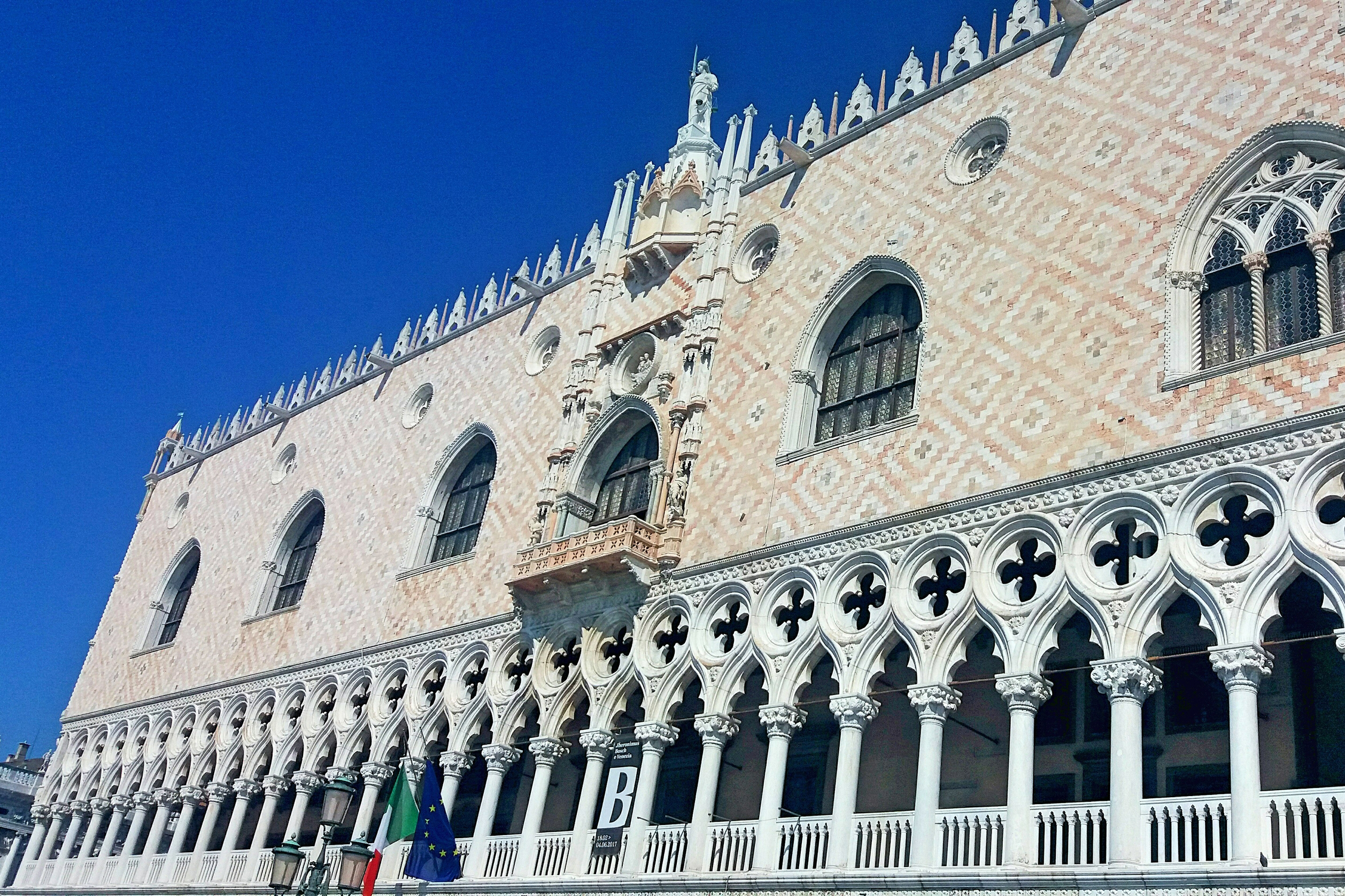
In the 17th Century, the palace served as the seat of g overnment, the city’s courtrooms, and a jail. It was an important base of power for the Venitian Republic. One of the important things to know about Venice is that Venice was an independent republic for over 1,000 years!
Doge’s Palace is impeccably lavish. Including gilded ceilings, frescoed walls, and grand staircases . Visiting the Doge’s apartments and prison cells is one of the things you must do in Venice.
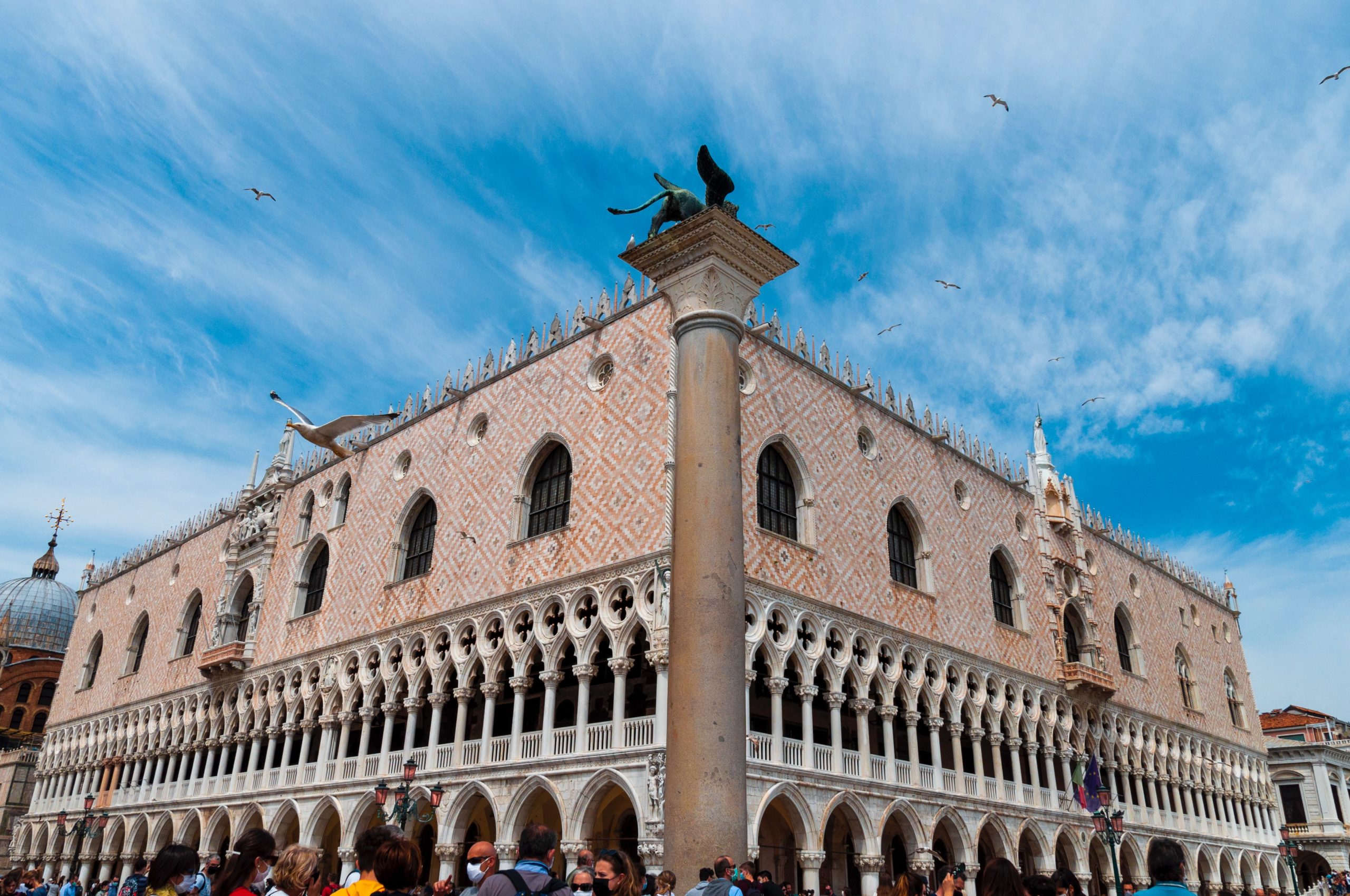
Check out this top-rated tour of Doge’s Palace.
Doge’s is an important landmark and one of the best places in Venice Italy for art lovers. There are many admirable paintings and sculptures to explore. The building itself is an artistic marvel. It’s a must-visit in Venice!
The Correr Museum is one of the most interesting places in Venice. It’s highly regarded Napoleonic Wing dates back to the early 19th Century. During this time, Napoleon held power and Venice remained part of the Kingdom of Italy.
This museum is also located in the bustling St. Mark’s Square. It’s one of the most popular places in Venice. Guests can explore neoclassical residences of Kings and emperors.
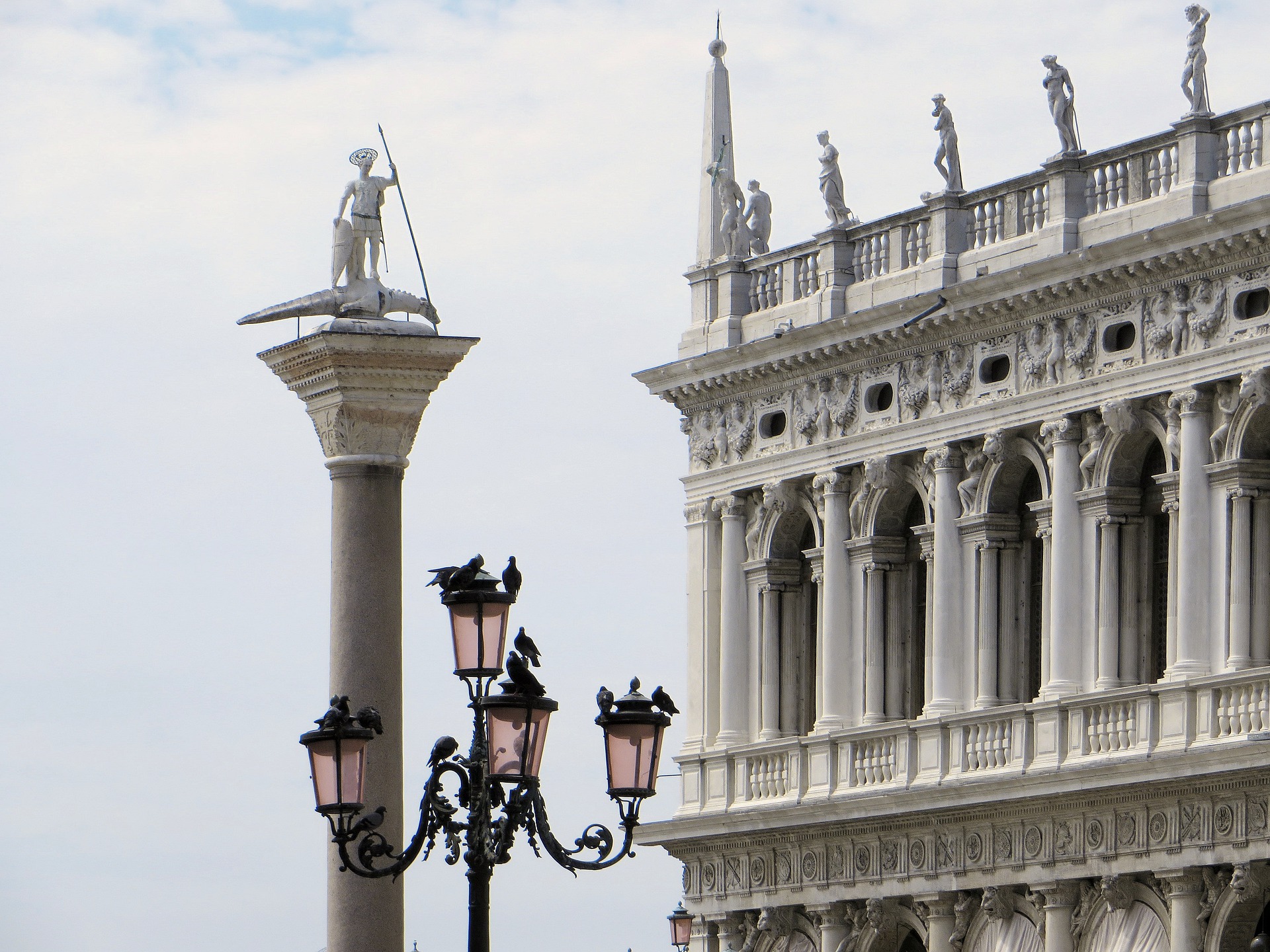
This is one of the Venice main attractions because you’ll find unimaginable treasures . The Correr Museum displays paintings, sculptures, furniture, instruments, and much more!
Cross the Bridge of the Academy and you’ll be in front of the Gallery of the Academy . This bridge is less crowded and maybe a good place to take a traditional canal side photo. It’s one of the places of interest in Venice for art and history lovers.
The Gallery of the Academy is one of the top sites in Venice because it has an impressive collection of 19th Century art. The root institution behind this museum was one of the first to adopt art restoration practices in the 18th Century.
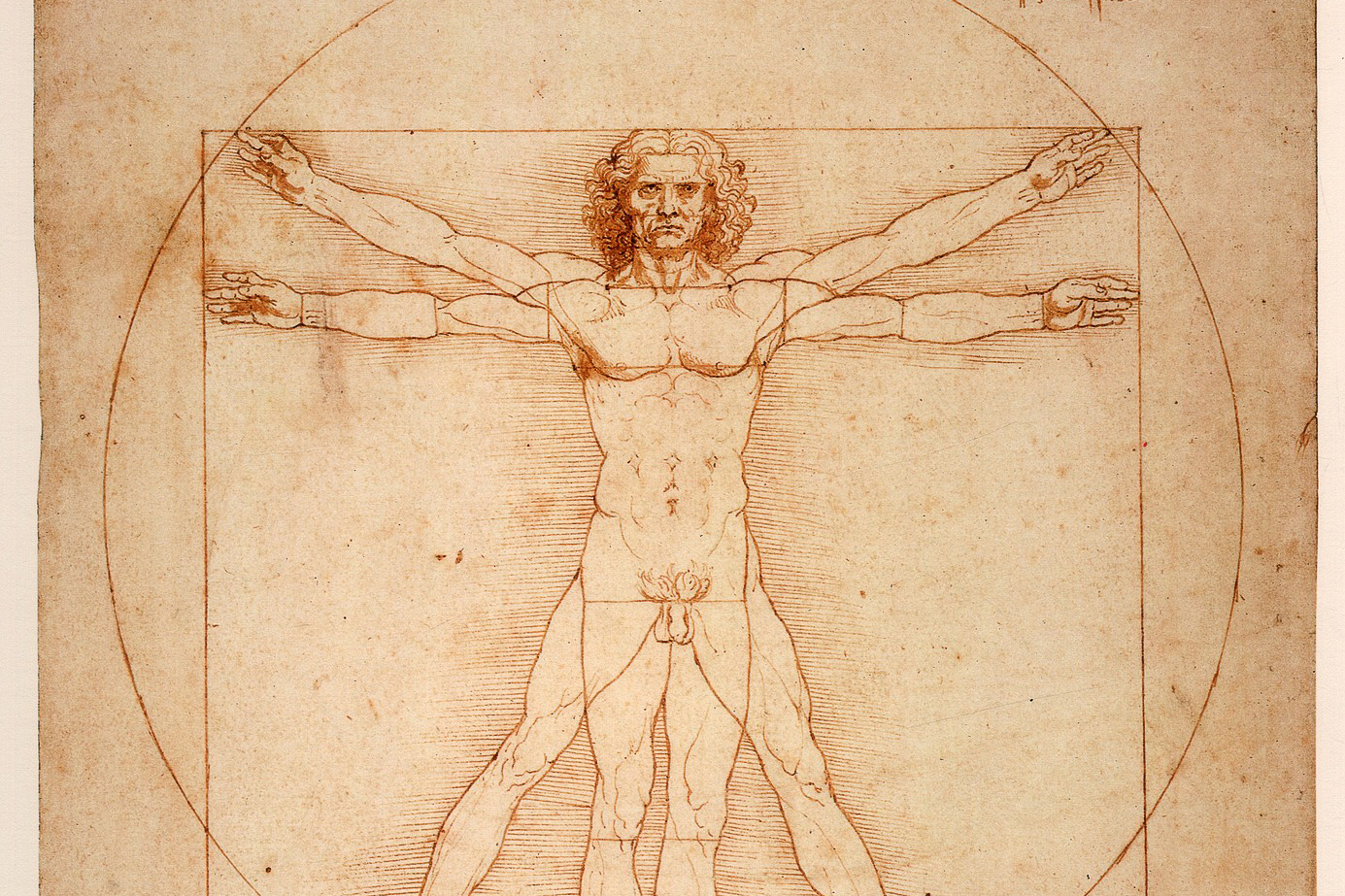
You can find many masterpieces in the Gallery of the Academy of Venice. The collection includes Leonardo da Vinci’s drawing of the Vitruvian Man which is occasionally displayed. This is one of the best sights in Venice.
Let’s not forget that dining and drinking are also some of the best activities in Venice Italy. Near to the Gallery of the Academy are a few great dining opportunities. Cantine del Vino già Schiavi is a wine bar off the beaten path. Osteria Al Squero is a local favorite known for authentic bites in a modest setting. Then, stop by Gelateria Nico for dessert.
The Peggy Guggenheim Collection is one of the most important 20th Century art museums in Italy. Visiting this place to appreciate American and European art is one of the fun things to do in Venice.
The modern art of the Peggy Guggenheim Collection is housed in an opulent 18th Century palace . Peggy Guggenheim lived in this palace for over 30 years. It’s one of the best things to see in Venice!
Peggy Guggenheim was an American heiress and socialite . She later became a prestigious art collector and traveler. Interestingly, her father died during the sinking of the Titanic.
Peggy Guggenheim loved Venice and established her most famous museum there along the Grand Canal. Viewing examples of surrealism, cubism and abstract expressionism at the Peggy Guggenheim Museum is one of the top things to do in Venice Italy. It’s also one of the romantic things to do in Venice for couples.
Surprise, Surprise…another museum inside a waterfront palace. The Ca’Rezzonico Museum was built in the 17th Century for a noble Venitian family . This is one of the most visited Venice tourist spots.
Interestingly, the family that originally commissioned this palace ran out of money before its completion . Also, the architect who designed it perished before it could be complete. The palace was finally completed over 100 years after the project was initially started !
The facade of the museum is a notable example of Venetian baroque and rococo architecture. Even if you decide not to stop inside, viewing the facade of this glorious building is one of the cool things to do in Venice. This is one of the best places to go in Venice for architecture lovers.
Inside the museum, you’ll find plenty of works by Venetian painters of the 18th Century. It’s a living time capsule into the 18th Century . There’s seemingly endless frescoes, sculptures, carved figurines, and other impeccable accents and artifacts.
Ca’Rezzonico Museum is one of the best museums & top places to visit in Venice.
While you’re walking in Venice, you may notice many churches. We’ve included several churches in this tourist map of Venice Italy because churches are essentially museums.
Quick Note About Churches: You don’t have to be Catholic, or even religious, to appreciate the history, culture, and architecture of Roman Catholic churches. While you should be respectful while inside, churches in Venice are open to visitors of all faiths and backgrounds.
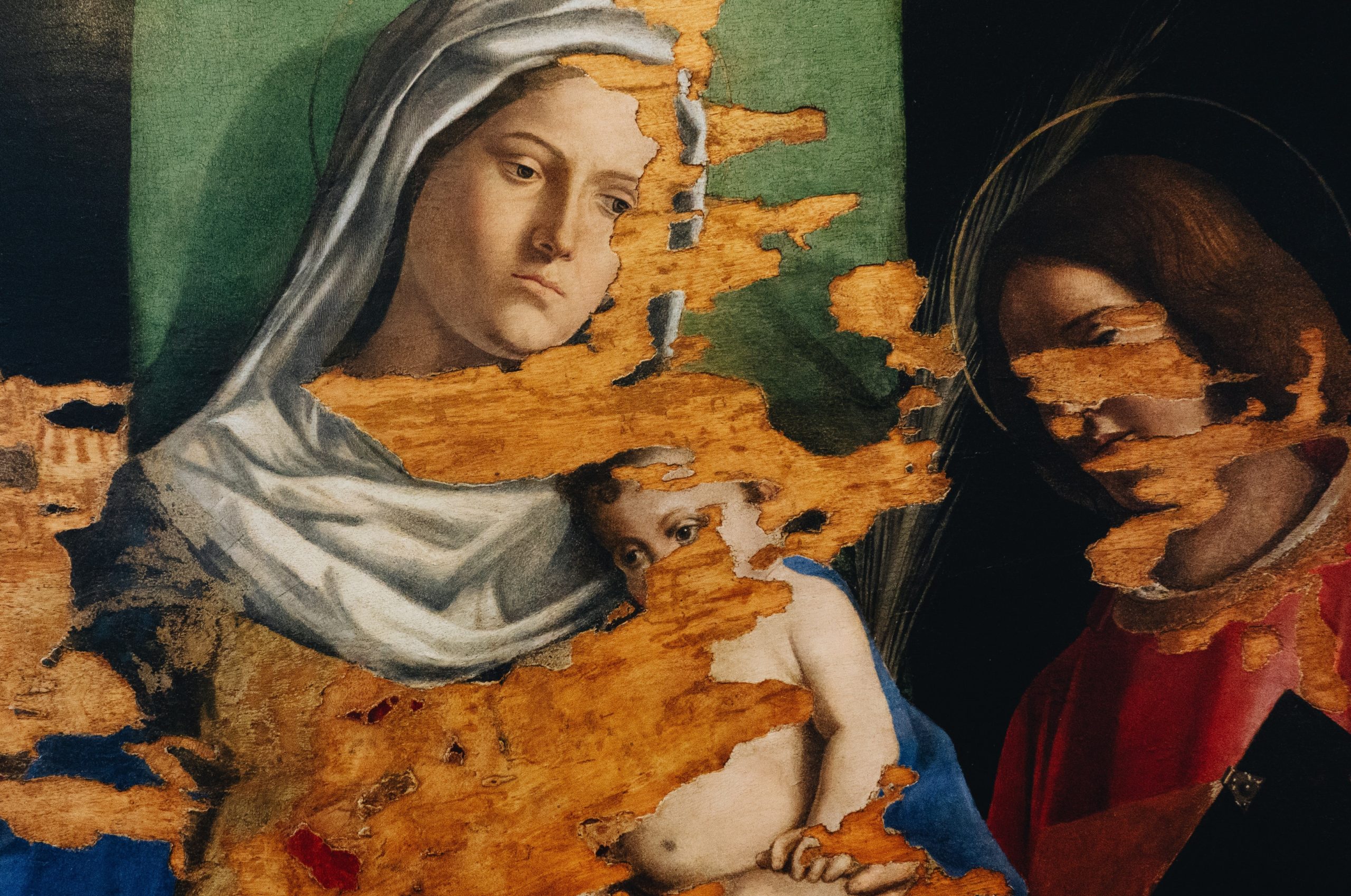
So, while you’re walking around Venice, stop inside a church or two. While they are treasure troves of art and history, admission into churches is much cheaper than that to museums.
Gaining entry allows you access to beautiful frescos, elaborate tombs, and unique stories . Although, entry is by no means necessary. Seeing these churches from the outside is worth your time.
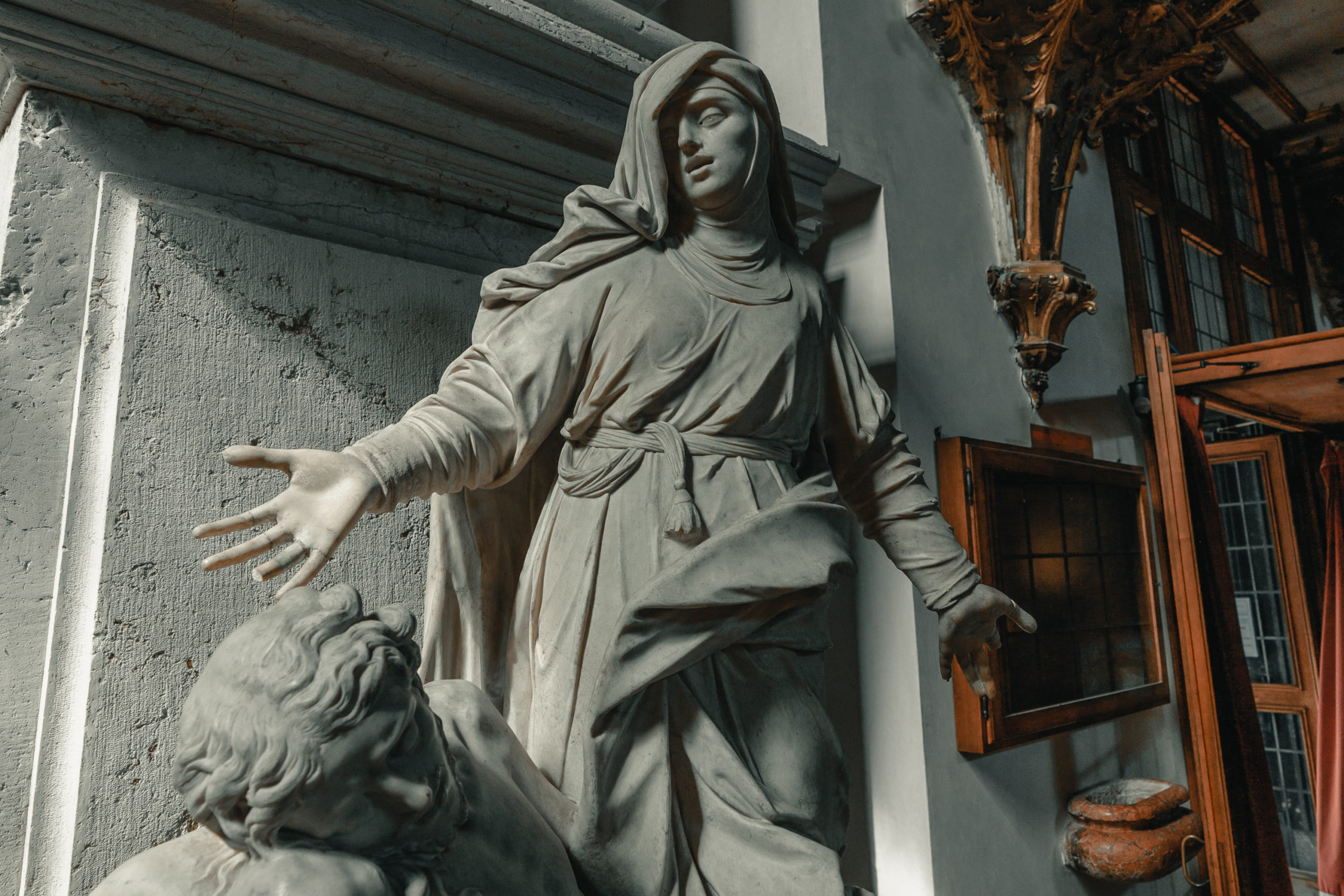
The following discussion focuses on some of the most important religious buildings on this map of Venice.
St. Mark’s Basilica is one of the most popular Venice sites to see. It is a cathedral style church , and it is considered one of the best examples of Italo-Byzantine architecture .
The facade of St. Mark’s Basilica has over 500 columns . Even if you don’t venture inside, St. Mark’s Basilica is one of the famous sites in Venice that you need to appreciate.
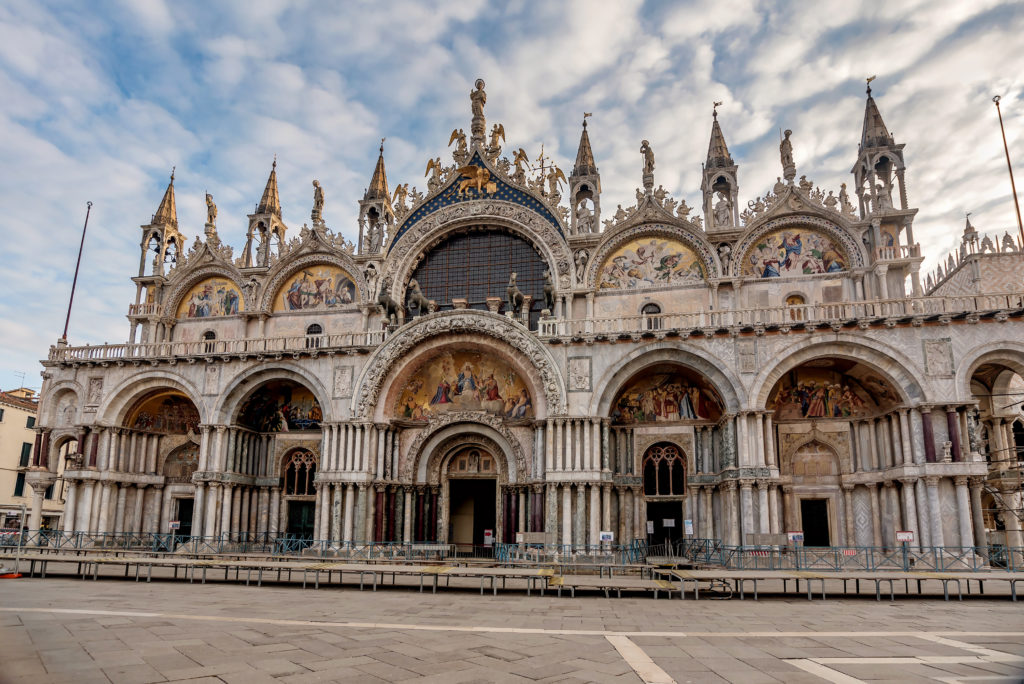
Inside Saint Mark’s Basilica, there are over 850,000 square feet of mosaics ! Wow. Many of these mosaics were added over 800 years ago . Much of the tile inlay of these mosaics are made of gold . Much of the treasures you’ll find inside come from the Crusades. So, it’s no wonder this is one of the best Venice Italy tourist spots.
The grounds of St. Mark’s Basilica also include a Renaissance style Clocktower and a prominent public square. Visiting this place is one of the legendary activities to do in Venice Italy.
The Church of San Zaccaria is one of the lesser-known famous things in Venice. This 15th-century Gothic church has somewhat a simple façade. However, it holds renowned paintings and precious artifacts.
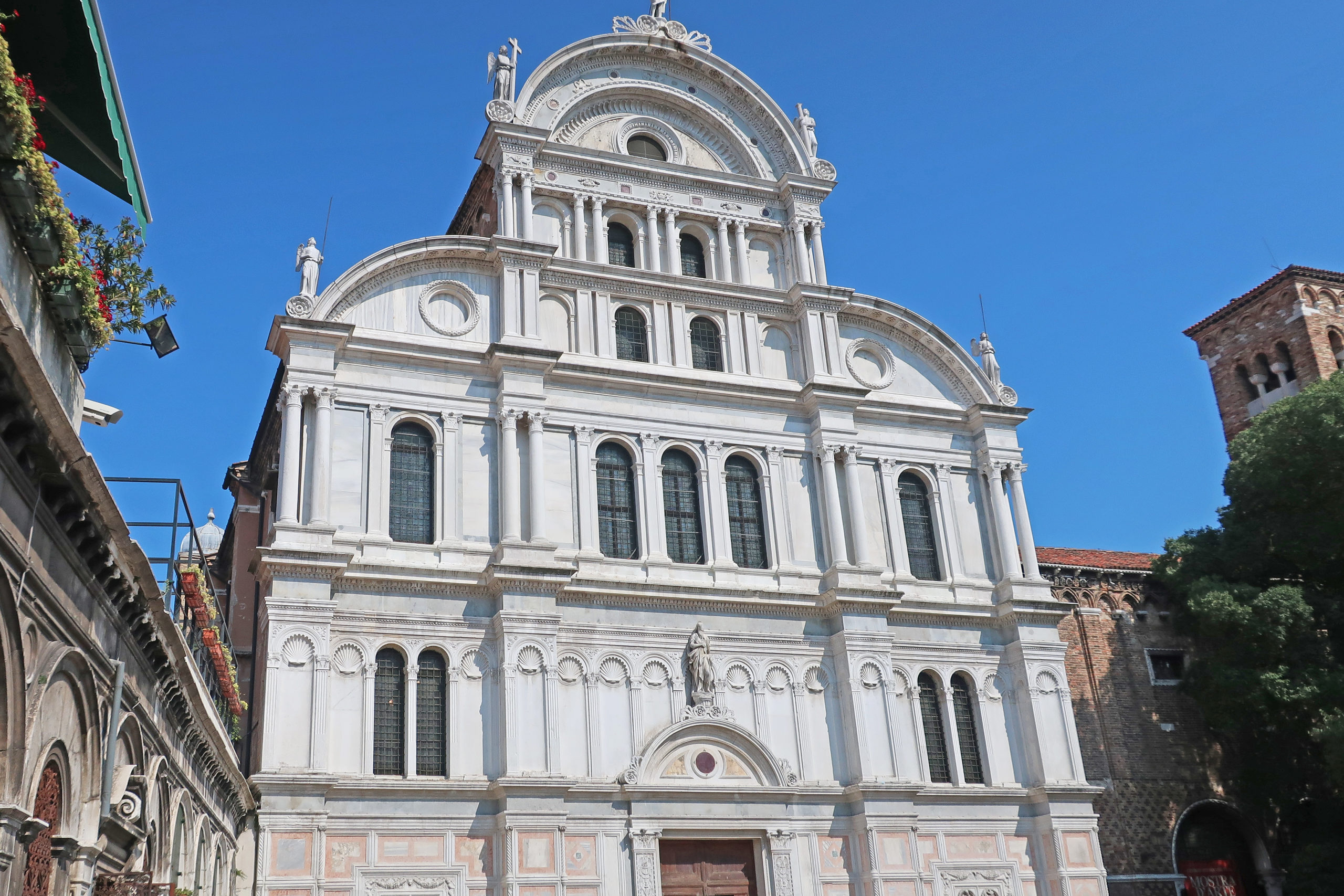
This church is significant for being one of the earliest monastic foundations in the city. It was first established in the 7th Century! For this reason, it’s one of the best attractions in Venice.
Despite its small size, the marble facade of this church is quite stunning. One of the noteworthy pieces you’ll find within is Giovanni Bellini’s Madonna and Four Saints . This is one of the top places in Venice for the off-the-beaten-path traveler.
The Church of Saint Julian is one of the important religious sites to see in Venice. The facade of the Church of Saint Julian follows th e traditional flattened temple style .
The consecration of this church was made possible by a local scholar and physician. You’ll see the statue of Tommaso Rangone above the door to the Church of St. Julian. Rangone grew his wealth by selling herbal remedies to Syphilis and yellow fever.
The Church of Saint Julian is one of the interesting places to go in Venice to view masterpieces and living history. These are incredible frescoes, sculptures and marble works inside.
The Church of Saint Julian is not far from the Church of San Salvador –another one of the must see things in Venice. As you walk from one church to the other, you’ll be in the main shopping street in Venice. This is a great spot to grab a magnet, leather goods, or other local trinkets.
Visiting historic churches is one of the unusual things to do in Venice . There’s no better Venitian church than the Basilica San Maria della Salute.
You can view this church while you’re enjoying the sightseeing in Venice Italy at Saint Mark’s Square. Look out past the Grand Canal, and you’ll be able to spot it!
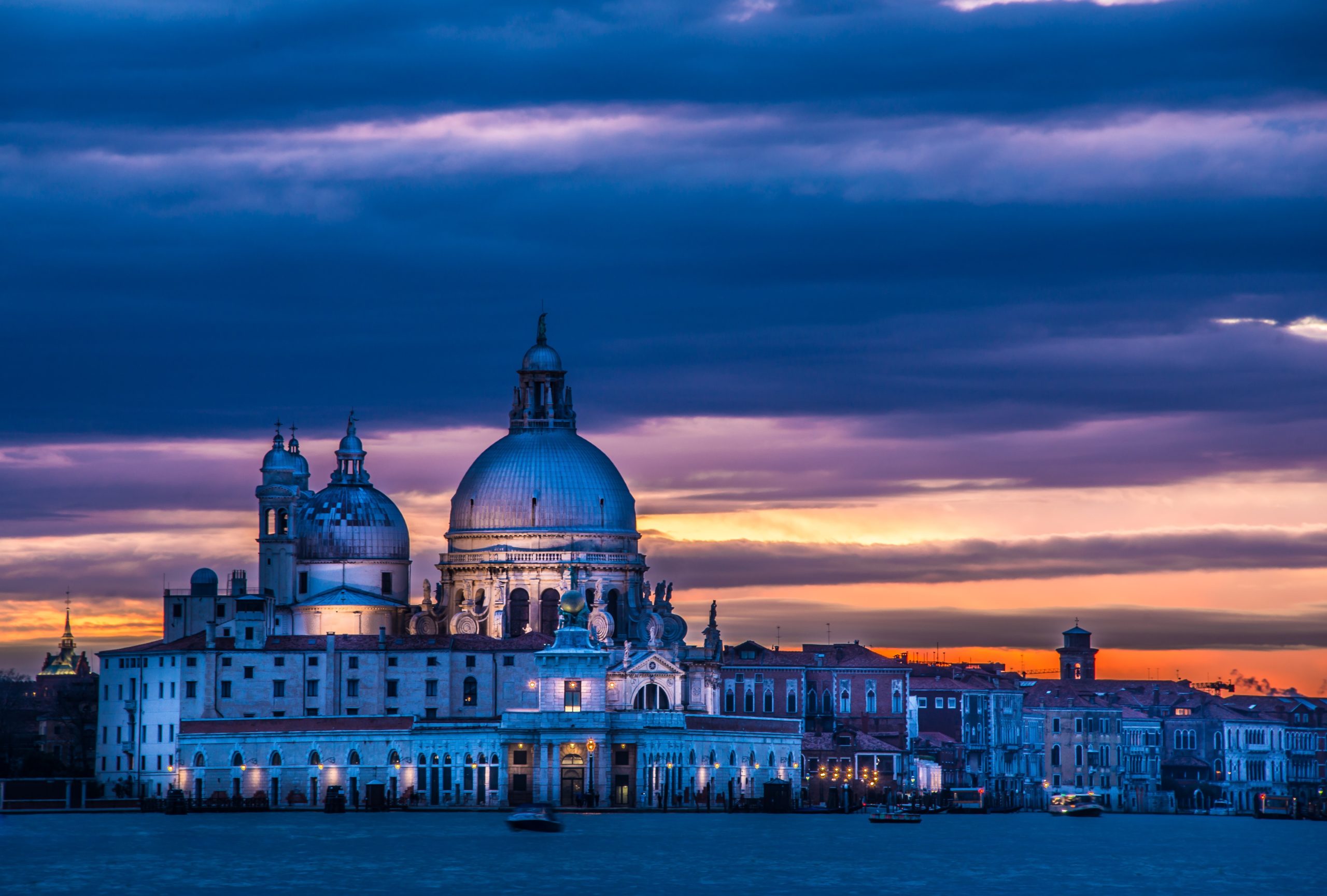
The facade of San Maria della Salute is remarkably baroque . It was built during a devastating outbreak of the plague, and many references to the Black Death can be observed in this church.
These are the best places to see in Venice. The top museums, churches & famous landmarks. They’re all mapped for you to enjoy.
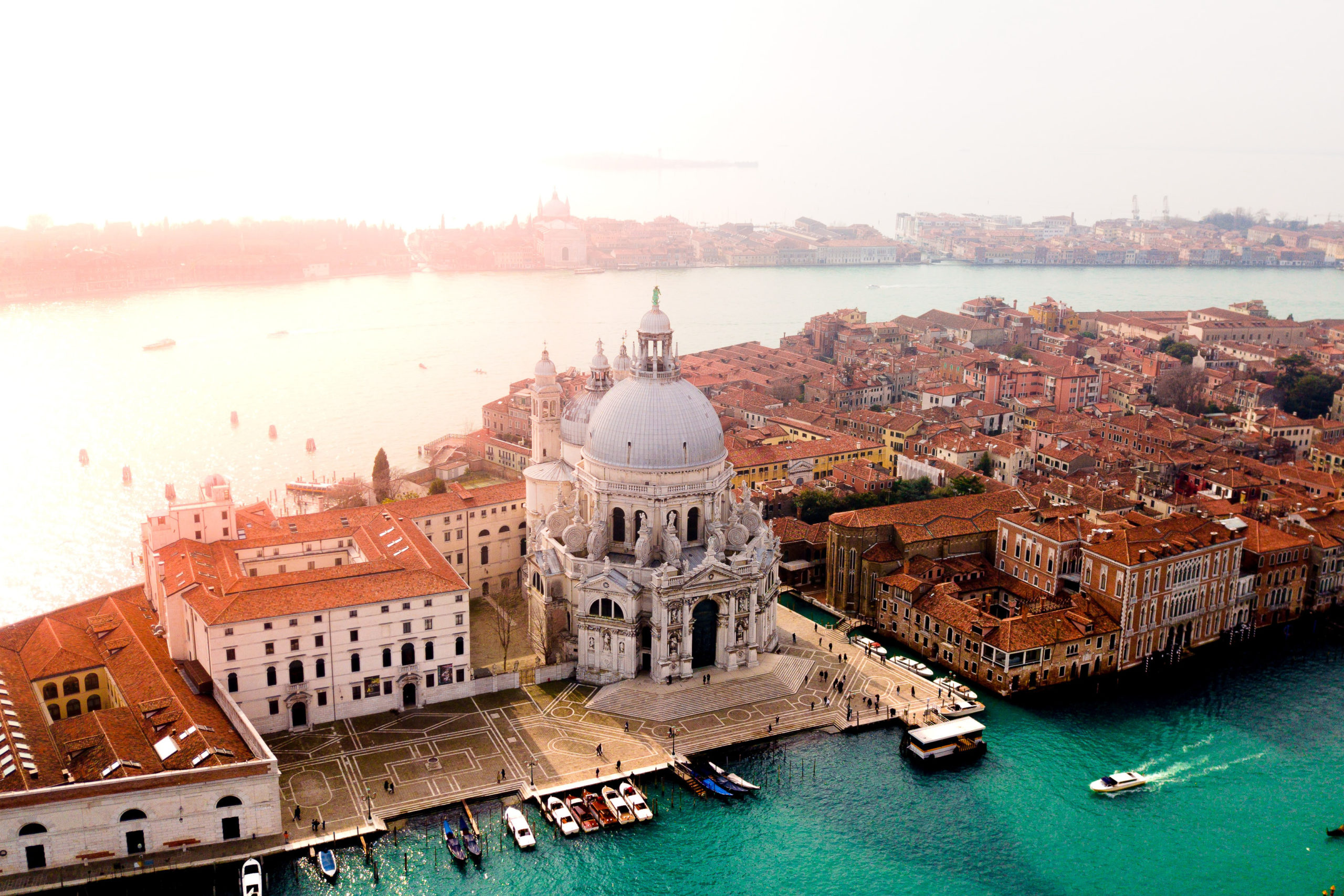
Learn more about how to use this map while you navigate around to the best tourist attractions in Venice Italy.
Think I missed something on my map? Comment below.
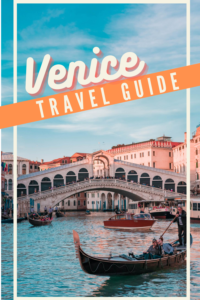
This post may contain compensated links. Please read our disclaimer for more info.
How to Find The Best Gelato in Italy
20 best views of chicago + 8 free chicago skyline views, you may also like, 16 romantic things to do in venice for..., dining in italy: how to find the best..., leave a comment cancel reply.
Save my name, email, and website in this browser for the next time I comment.

The Ultimate Self-Guided Venice Walking Tour [UPDATED 2023]
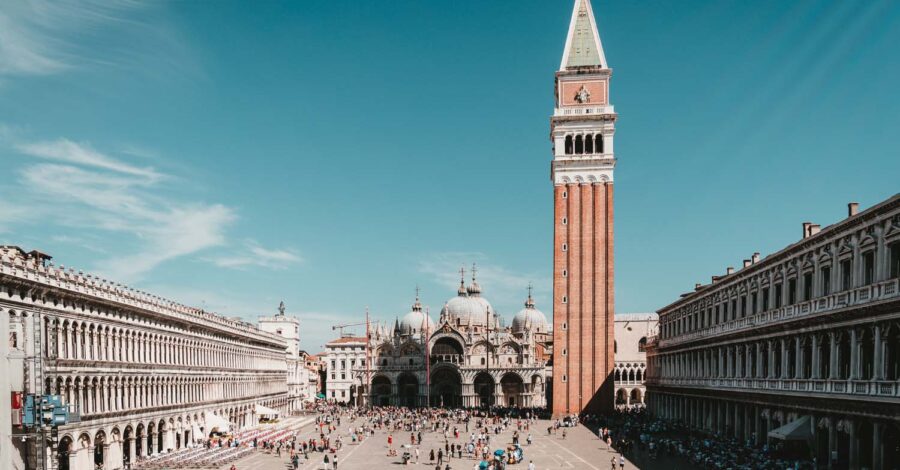
The city of Venice is made up of 118 islands, 400 bridges and 150 canals. But you might be surprised to learn it’s a pretty walkable city. The entire island can be explored in one, albeit long, day. No one neighbourhood is ever too far away from another. As such, there is a real connection between all the different parts of the island. Venice had only so much land to grow on before spilling into the ocean. Every brick, every stone and every bridge needed to be made with thoughtful consideration. The city’s architecture needed to be a cohesive part of this great puzzle. And walking around, it feels like entering a living art and history museum.
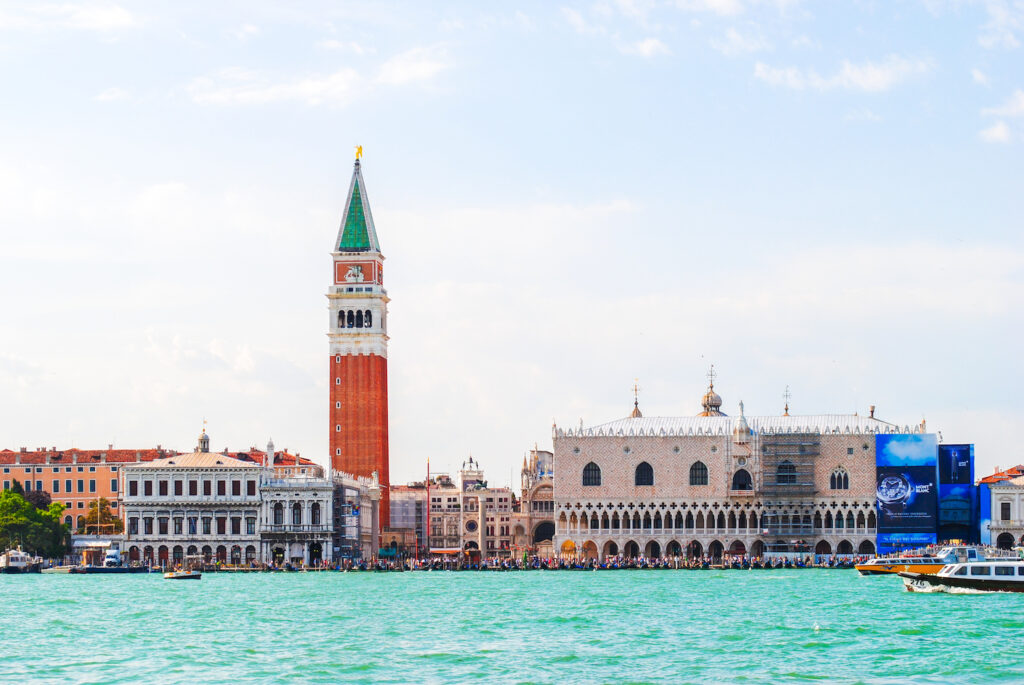
You could take dozens of walking tours around Venice, specializing in different themes or neighbourhoods. But this walking tour is perfect if you have limited time to see the city. Or you just want a good introductory tour to take you around the iconic places which helped form the history and culture of this city.
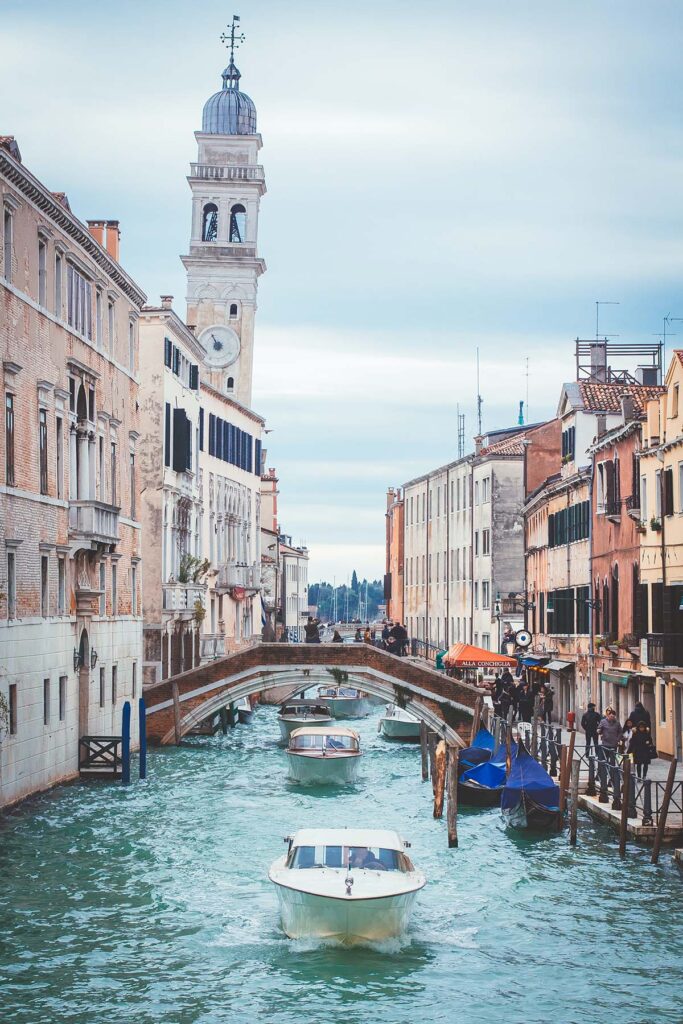
Walking Tour Details
How long is this walking tour.
This walking tour takes you around some of the most important landmarks around the island. I recommend leaving a whole day for it since it spans almost the entire city. Or you could break the tour into sections to spread over a few days. This tour serves as a great introduction to the various districts. Giving you a glimpse of where you might like to come back and explore more later.

When Should I do this walk?
Monday is a great day to do this tour. Most museums are closed on Mondays, yet the churches we will visit will remain open. Mondays are also when people have gone back to work, so you’ll get a better idea of what the neighbourhood looks like when all the shops are open. Businesses are bustling, and the cafes serve their daily customers. You can, of course, for this tour any day of the week, but I always recommend Mondays due to the museum’s closures.
Start the tour early in the morning. The earlier, the better. I usually wake up before dawn and go to St. Mark’s Square. As the sun rises above the city, the square is almost empty , except for the pigeons . There’s nothing like it. Well worth the sacrifice of a little bit of sleep.
When is the Best Time to Visit Venice
The best time to visit Venice is during the shoulder seasons of spring and fall, from April to June and September to November, respectively. During these months, the weather is pleasant, and the crowds are fewer, allowing you to explore the city without the hustle and bustle of peak tourist season. However, keep in mind that Venice experiences high tides, known as acqua alta, from November to March, which can make certain parts of the city inaccessible.
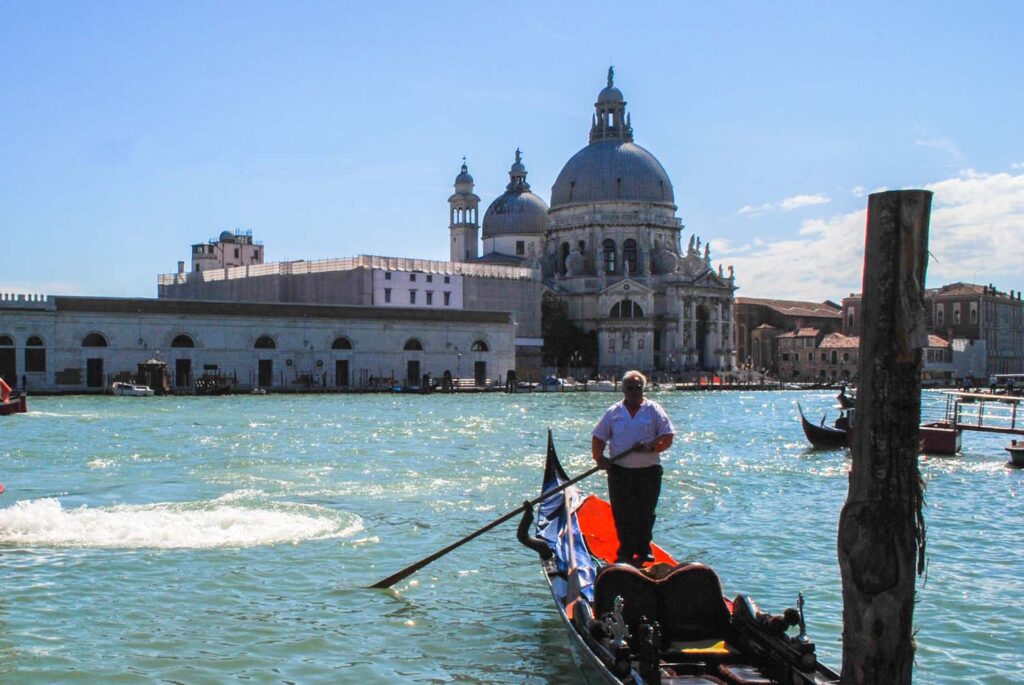
Venice Tourist Tax
Starting January 1st, 2023, Venice will implement a Tourist Tax for anyone staying in the city overnight. This tassa di soggiorno or tourist tax will be included in your hotel, B&B and alternative accommodation fee.
But soon, the city will be implementing a day-visit ticket. This is set to cost anywhere from €3 to €10. Visitors from cruise ships or the mainland must book their tickets to visit Venice in advance. This system has not yet been activated, but once online, day visitors will need to pre-register and select the day on which they plan to visit the city.
This new system is being implemented to help visitors contribute to the protection and safeguarding of Venice. All the money from these taxes goes directly toward improving the quality of public services and museums. As well as maintenance to prevent this historic city from sinking into the ground forever.
Start of the Tour: St. Mark’s Square
The best place to start your tour is standing in the centre of the Piazza San Marco or St. Mark’s Square. Arrive here as early as you can. There is something truly magical about being here as the sun rises on the square. You’ll see the beautiful rose-gold sunlight begin to kiss the cobblestone and bricks around you. The sun seems to bring the square to life as cafe owners take out their colourful chairs and pigeons flock around gawking tourists (but please don’t feed them!)
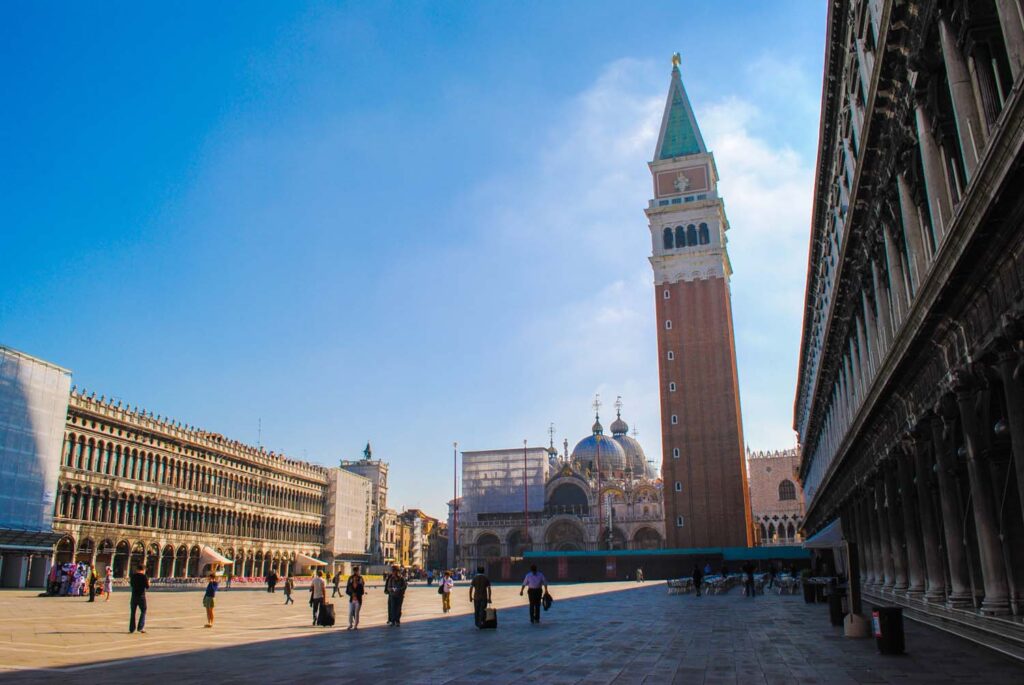
Standing in the centre of the square, in front of the Basilica, you can turn around 360 degrees and see one spectacular sight on top of another. In this small area, you’ll find the St Mark’s Basilica , the great Campanile (Belltower), the Procuratie, the Piazzetta, Doge’s Palace , Bridge of Sighs and Torre dell’ Orologio . There is rarely a time when you’ll visit the square when they aren’t some form of construction or renovation going on. With all these historical sights in one place, something is bound to be falling apart and in need of repair. Try to look past that and don’t let it ruin your experience.
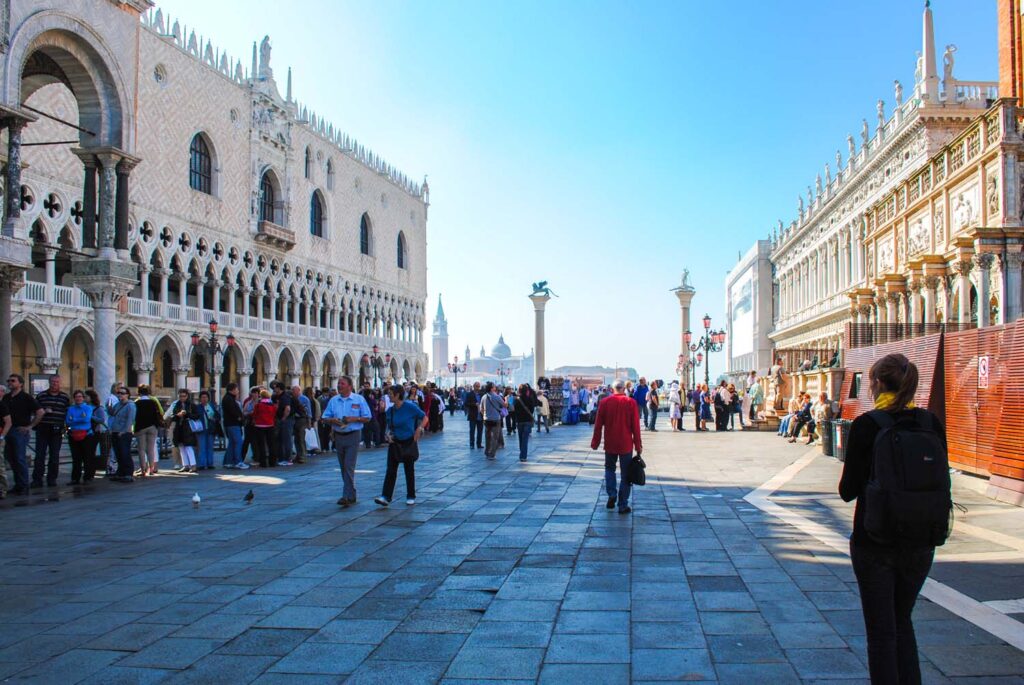
The square is named after the patron saint of Venice, Saint Mark . In 828, a relic of St. Mark was stolen from Alexandria and brought back to Venice by La Serenissima’s great naval fleet. The Venetian Doge, awed by the acquisition of this precious relic, adopted Saint Mark as the new patron Saint of Venice (whose honour had previously been given to Saint Theodore).
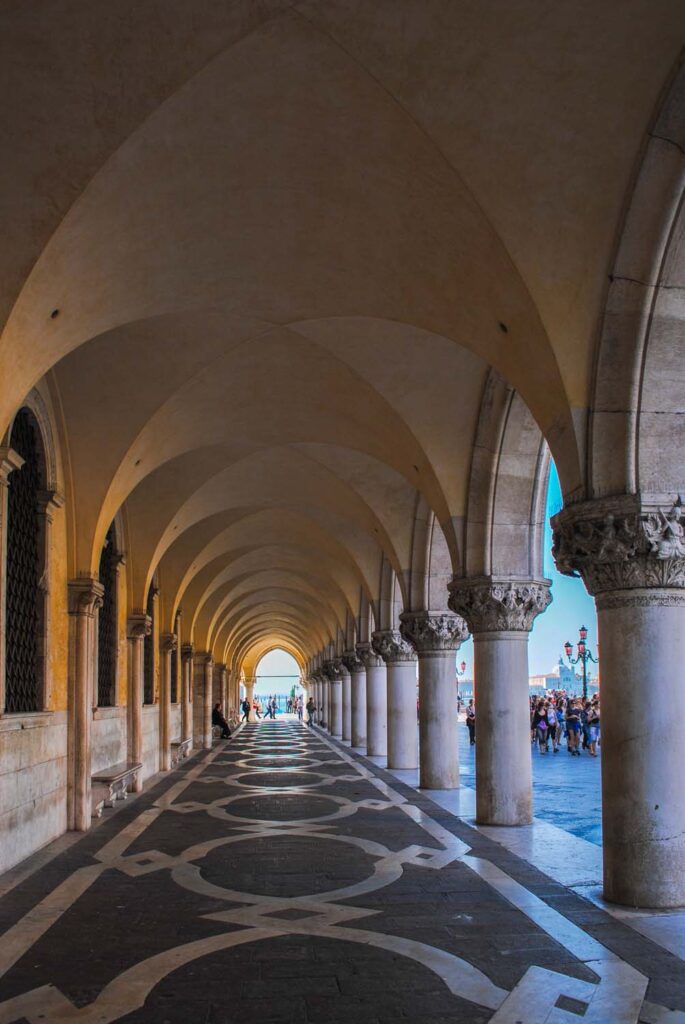
A city with a saintly relic immediately rose in power and prestige. Relics were the first tourist attraction of the medieval world. Pilgrims would come from all over the world to pray at the churches that preserved these relics. Pilgrims, much like tourists today, needed food and shelter. And therefore, they brought lots of money into the city.
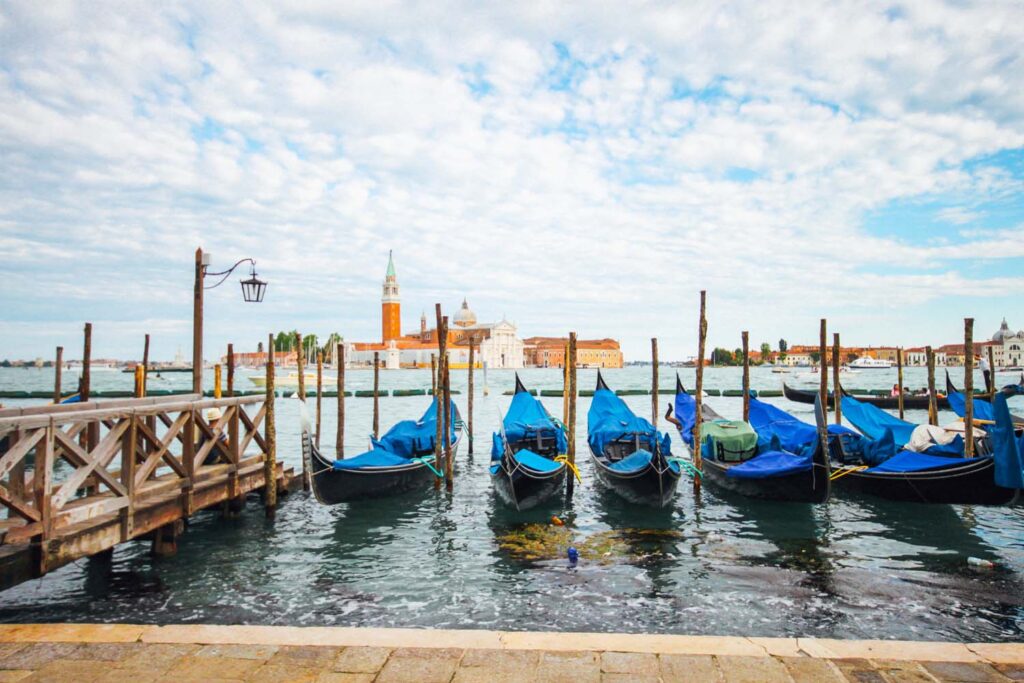
A grand church to house the precious artifact began to be built in 836. Even back then, the church and the nearby Doge’s palace were highlights of the medieval city of Venice. A great square was needed to further showcase the opulence the Doge wanted to project. In 1172, orchards were demolished surrounding this area, and the Piazza San Marco was built. It’s been rumoured that upon visiting St. Mark’s square for the first time, Napoleon himself degreed that it was “ the drawing room of Europe .”
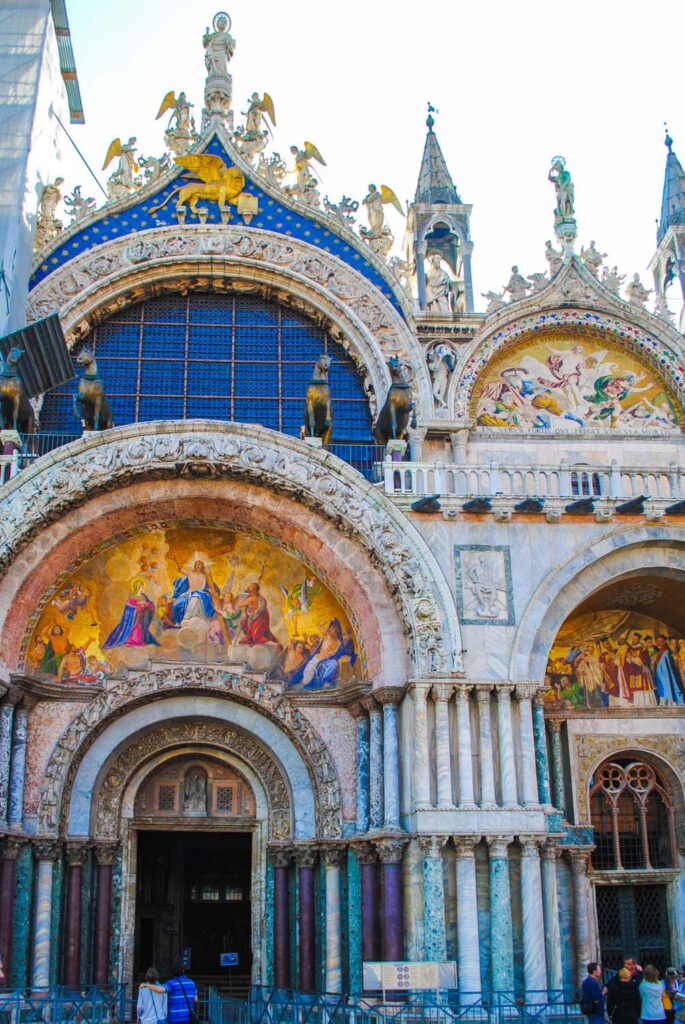
The Procuratie
The simplistic yet elegant buildings along the north and south sides of the square are called the Procuratie. The Procuratie is most identifiable by the stunning arcade that wraps around this side of the square. The arcade features distinct Byzantine arches that shield visitors from the elements.
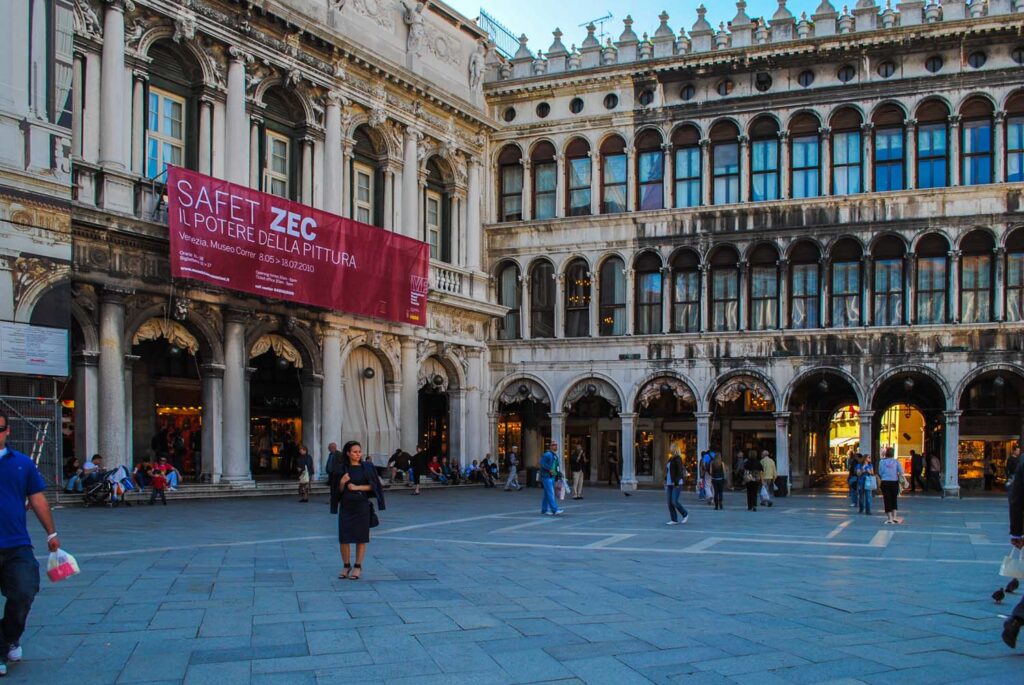
The Procuratie once served as the offices of the Venetian Republic, also called La Serenissima . Today they house the Correr Museum , the Museum of the Risorgimento , and the Archeological Museum . Each one of these is an incredible place to visit. But the Correr Museum is my favourite with its collection of art detailing the history of the city of Venice.
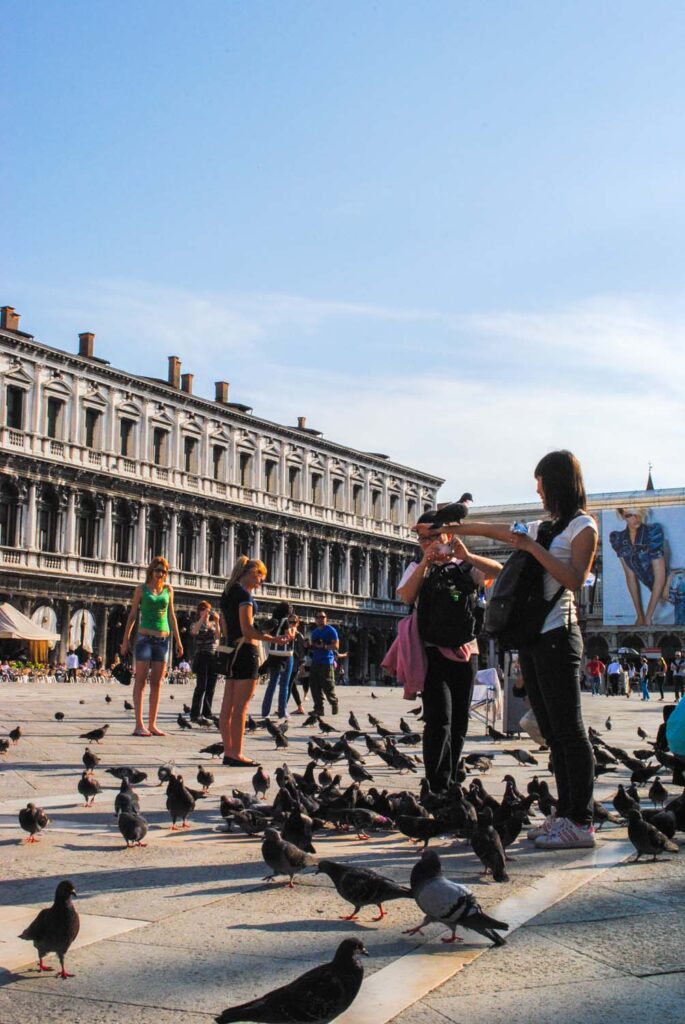
The Lion of Venice
Throughout St. Mark’s square, you’ll see various lion sculptures adorning doorways, columns and facades. The official ‘Lion of Venice’ is usually seen with his paw resting upon a bible. And he is not just any lion, but St. Mark’s Lion. St. Mark was often referred to as a lion, as he preached the word of the lord so powerfully it almost seemed like a roar. Legend says that when St. Mark was travelling through Europe and arrived in Venice, he was visited by an angel. The angel told him Venice would be where his body would rest for eternity. His remains were originally interred in Alexandra but moved to Venice, where the basilica was built to honour them as the angel had foreseen.
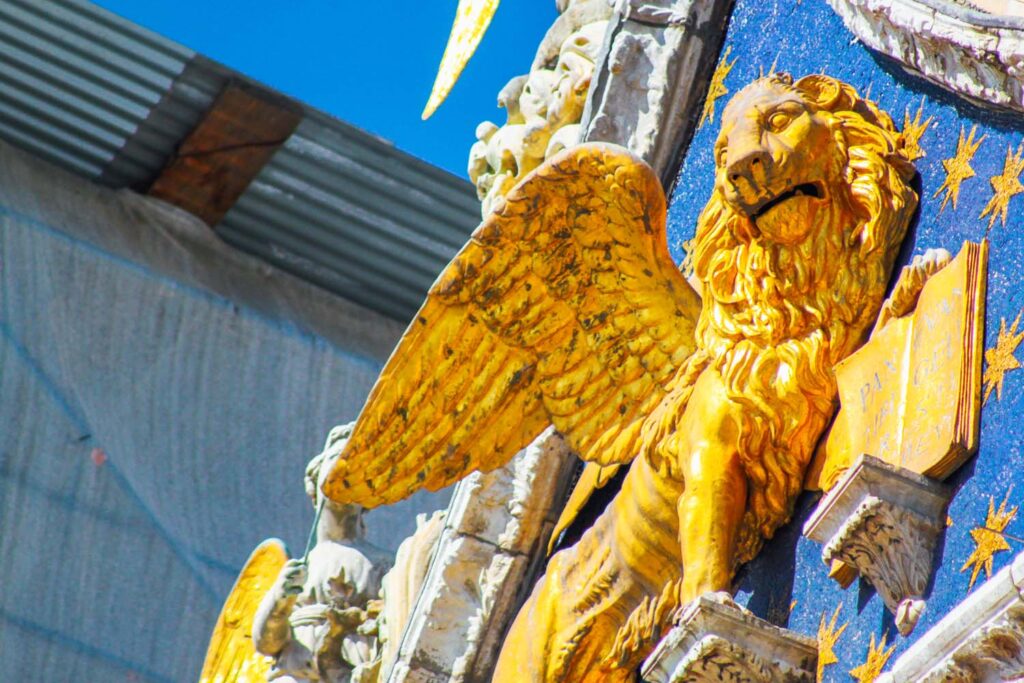
Caffe Florian
Now housed inside one of the old Procuratie is perhaps the most sumptuous cafe in Venice or perhaps Europe itself. Although this cafe is by no means cheap, it’s a splurge that I think is worth it to experience the incredible interiors and history to be found within. The Caffe Florian was founded in 1720 and has served patrons like Charles Dickens and Lord Byron . There is a €6 cover charge to even enter the cafe. But along with enjoying the lavish interiors, you’ll also be treated to live music throughout the cafe. Palacial red velvet couches and chairs are spread across the huge cafe, a maze of cozy antechambers. Each room is covered in ornate paintings, large Murano glass mirrors, gold foiled frames and intricate frescos plastered on the ceiling.
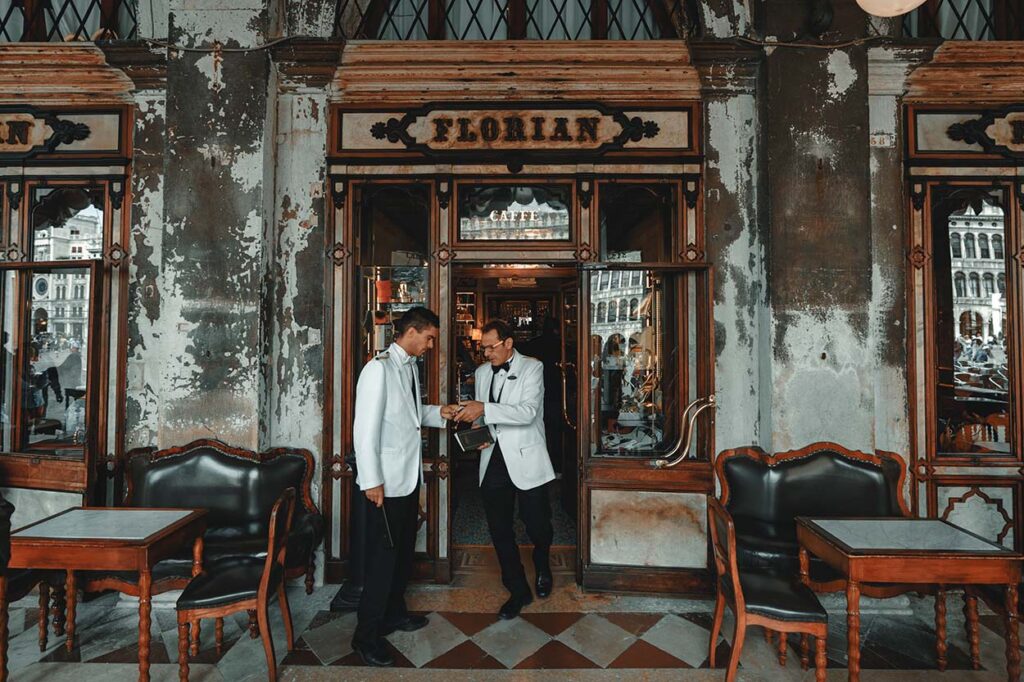
To save money, go to the bar and order your food or drinks there. Although you won’t get a seat, the bar menu is vastly cheaper than table service. An espresso at the bar will still run you €5, but again, you’re here for the atmosphere. If you’d rather save your money, you can opt to give this a miss. Instead, grab a coffee on your way toward St. Mark’s square from any local cafe to enjoy while you peruse the sights around you.
The Campanile
Standing guard in the centre of the square is the 323ft tall Campanile or Belltower . The low-level buildings throughout Venice are in stark contrast to the towering red brick Campanile. Its little pointed tower pokes out atop the skyline no matter where you end up in Venice. While the original tower was built in 1514, the current one is a reconstruction from 1912 after its collapse in 1902. It’s incredible to imagine that such a tall structure could survive for so long-standing atop the shifting waters below. But it wasn’t actually the water which proved to be the biggest enemy of the tower; it was lightning. Lightning struck the tower multiple times over the years, causing several fires and severe internal damage to the structure.
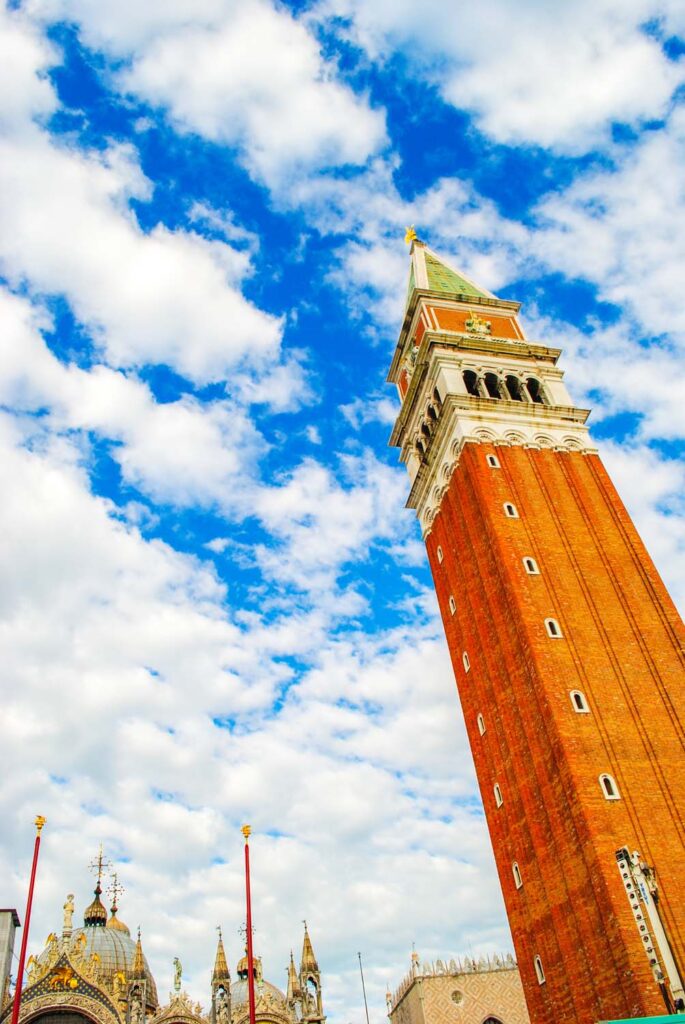
The Bells of the Campanile
The tall base of the tower is designed with a fluted shaft that reaches up towards the belfry. On each side of the belfry are a series of arched windows looking out over the square. Inside the belfry are five huge bells. Each one was used to call the people of Venice to attention. The bells have their own distinctive name and special significance. The Renghiera bell announced executions. The Mezza Terza would declare that a session of the Senate was taking place. The Nona sounded the midday hour. The Trottiera was used to assemble the Maggiore Consiglio and the Marangoni, the largest of the bells, rang to mark the beginning and end of the working day. Before anyone even had watches to tell time or Twitter to announce the day’s news, these bells were all the public had to get collective, daily information.
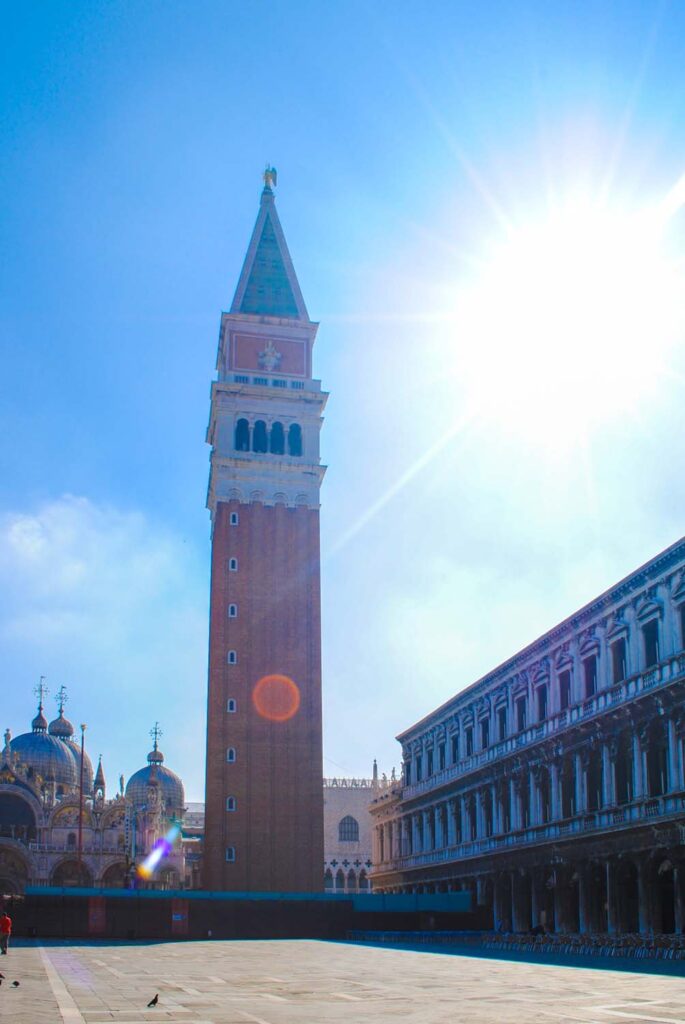
Above the arches of the belfry is another level of brickwork decorated with various sculptures on either side. On one farside, you’ll see the Lion of St. Mark and on the other, the female representation of Venice, in the shape of the Lady Justice. The golden weathervane which crowns the tower is sculptured into the angel Gabriel. He stands tall, reaching out toward the citizens below.
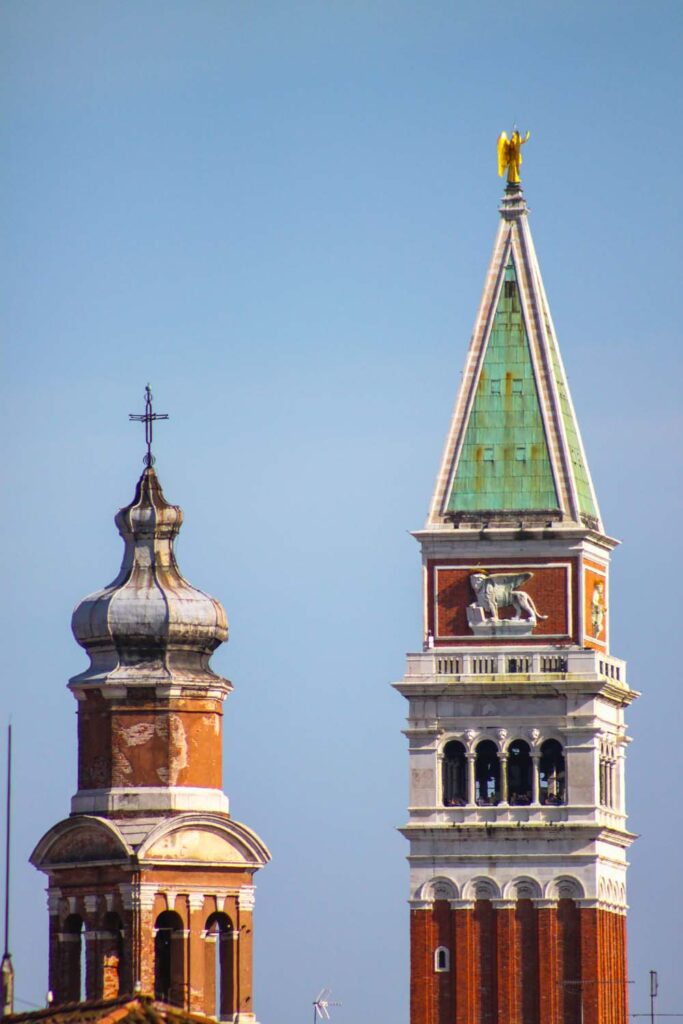
Torre Dell’Orologio
Turn to the square’s northeast corner, and look up at the bright blue and gold details decorating the fantastical Torre Dell’Orologio . In the morning light, the sun glints off the golden dials. The clock was built in the 15th century when the possession of a mechanical clock symbolized the wealth and power of a city. The clock was positioned facing out towards the water so that any foreign ships could see the time from the canals as they passed through. With a spyglass, of course, their eyesight wasn’t that good.
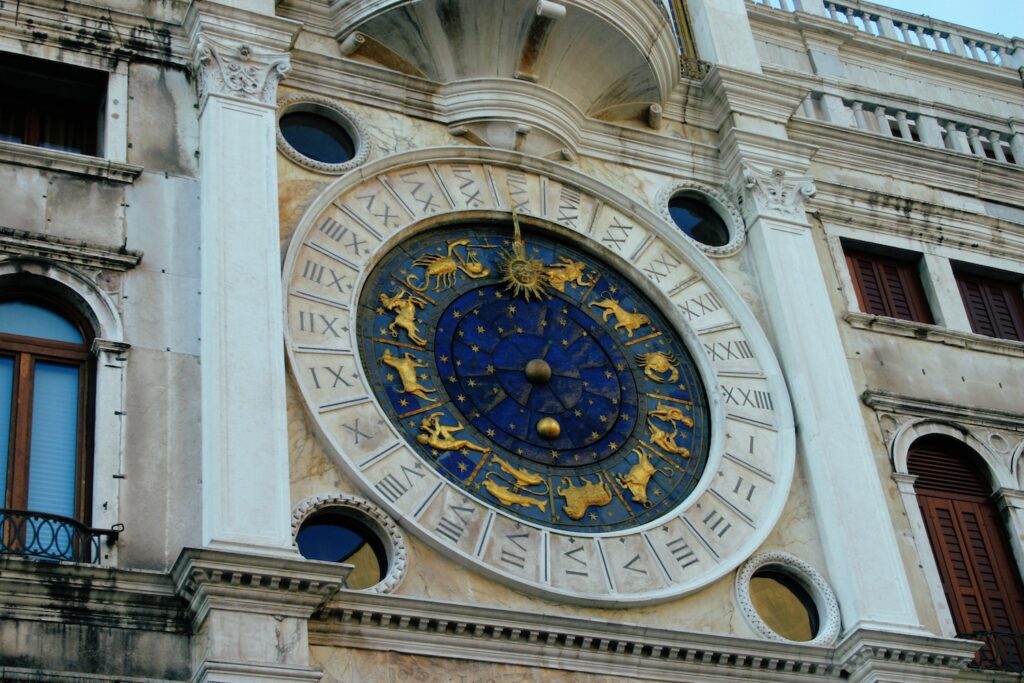
Atop the tower containing the clock, you can see two small bronze figures who carry large hammers in their hand. These figures move upon the hour to strike the bell, causing the bells to ring. One of the figures is a young man, and the other is an old man, symbolizing the passage of time. Once more, we see the image of the Lion of Venice above the clock, set against a blue sky of golden stars. Below the lion is the figure of the Virgin Mary with the baby Jesus wrapped in her arms. On either side of her are two blue panels with the time represented in roman numerals on the left. And on the right in Arabic numerals, as was the tradition during the Byzantine era.
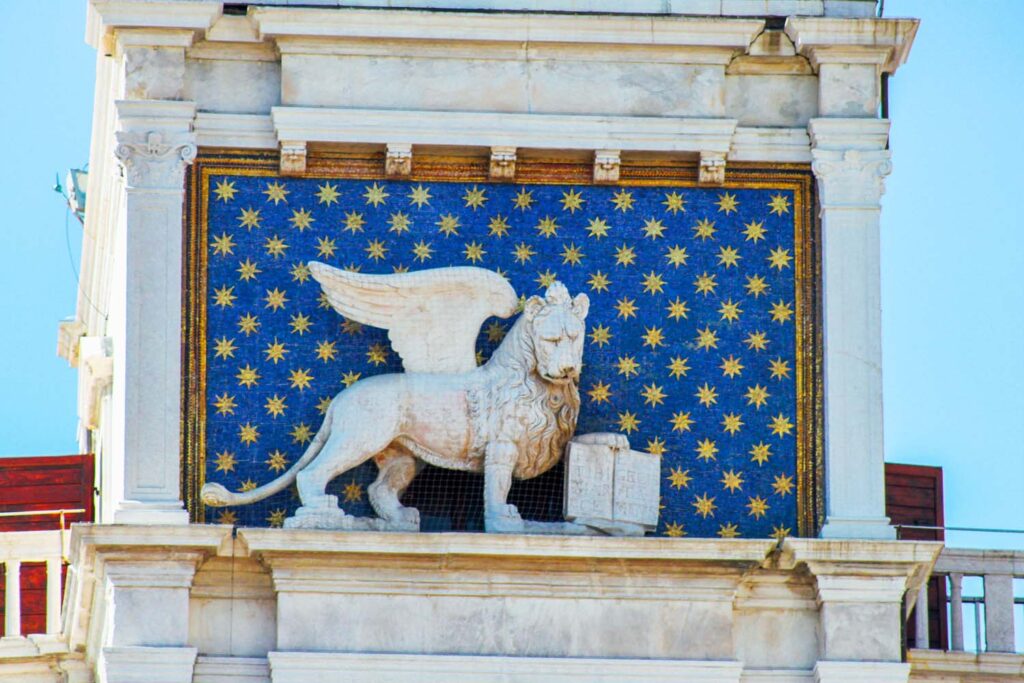
The Clock Face
The most impressive feature of the clock are the blue and gold sculptural engravings set within the numerals. Each one was fantastically carved to represent the signs of the zodiac. The central dial, emblazed with the sun’s image, revolves around the zodiac signs. But rather than showing the time, the sundial marks the date. The smallest dial, closest to the central, holds a tiny orb representing the phase of the moon that changes throughout the year.
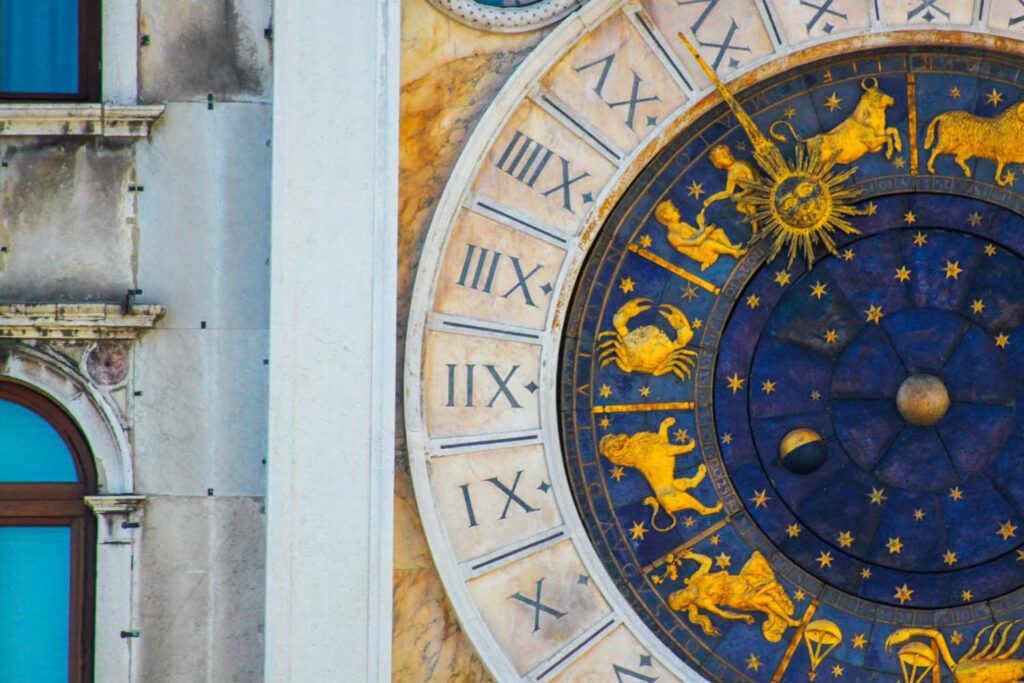
St Mark’s Basilica
St. Mark’s Basilica is one of the most precious treasures from the Byzantine period. Preserved in amber, there are so many aspects of history, art, culture and faith from that era. The most significant elements of the church’s design are the mighty, tiled onion domes that glitter against the sea-blue sky. The bulb-shaped domes with their golden finials lanterns give the church that middle eastern appearance that defined Byzantine art and architecture.
Exterior Design of St. Mark’s
The exterior of St. Mark’s Basilica can be studied by looking at its three distinctive areas; the lower level, upper level, and domes. The lower-level mosaics portray scenes from the life of Saint Mark, for whom the church derives its name. In the central arch where the enormous doorway is located, there is the largest mosaic, which depicts the Last Judgment. The original mosaic would have been made in the 13th century, but this current incarnation is from the 19th century after much-needed restorations. The portals that lead into the church are held up by marble columns in a plethora of colours and patterns. Each one is set inwards, towards the doorway, creating a foreshortening perspective. Giving the viewer the effect of being pulled into the church.
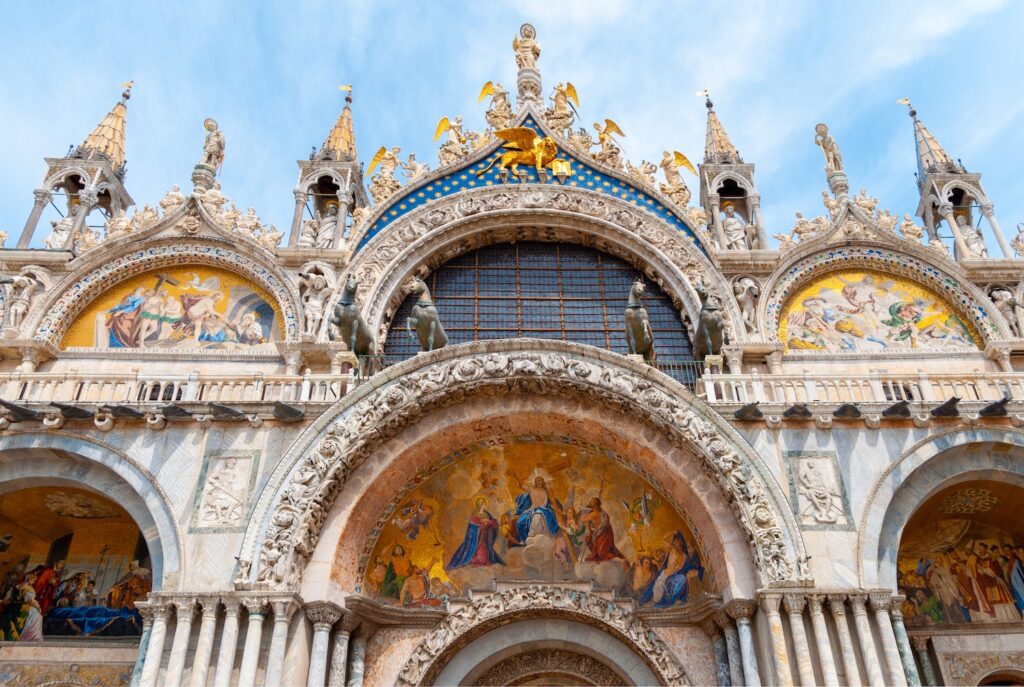
On either side of the central portal, the mosaics depict the life of St. Mark. The mosaic on the left is the only surviving piece from the 13th century. Above these central portals, we can study the arched lunettes. These mosaics depict the life of Christ.
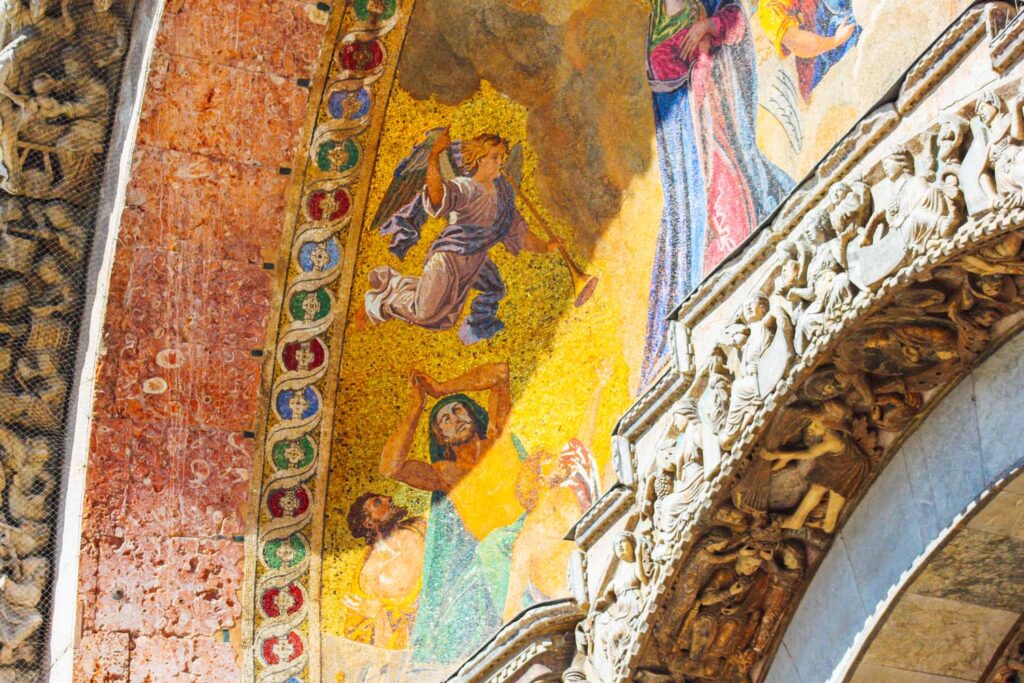
The Balcony
The upper-level balcony is home to four important bronze horses. These are the Horses of Saint Mark-Lysippos . Originally stolen from Constantinople in 1252. The ones outside the church today are replicas of the original sculptures, as these suffered terribly from the elements. They were brought inside the church museum to ensure they could be preserved for years. The bronze horses date all the way back to classical antiquity. It is rumoured that perhaps they were once a part of the Arch of Trajan in Rome . Positioned pulling an emperor’s chariot. But these horses were one of the many trophies collected during the Crusades, which is how they journeyed to Venice.
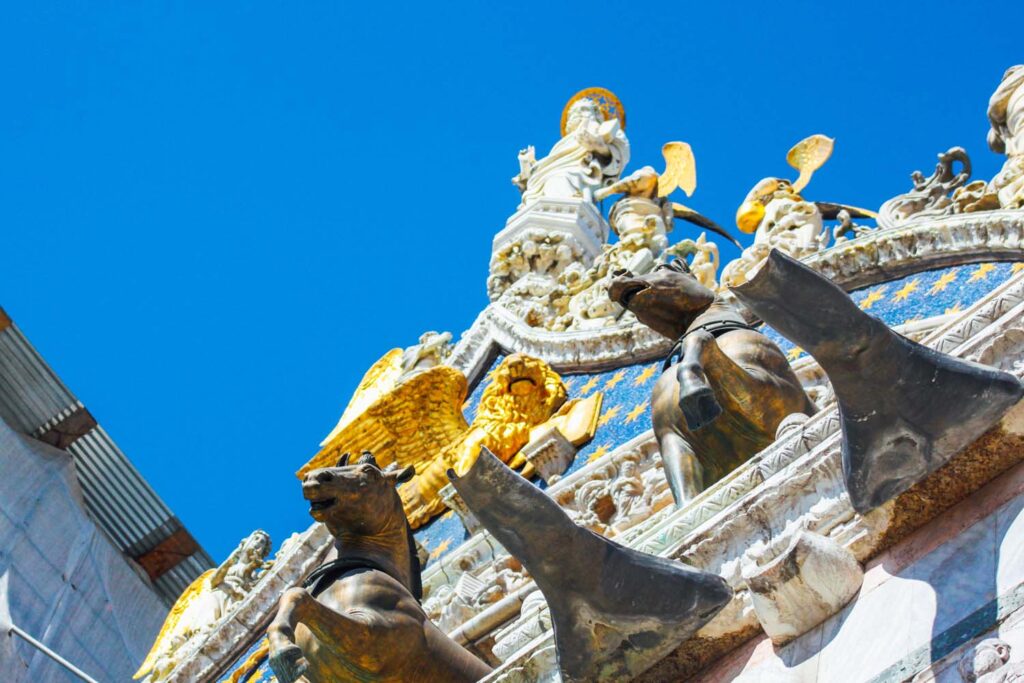
Ogee Arches
Arching behind the golden horses and above the second-floor lunettes are a series of ogee arches. Ogee arches are a type of arch with an S-shaped curve consisting of two arcs that meet at a point. Not only do these designs add an aesthetically pleasing element to the building, but they also serve a functional purpose by providing additional support for the structure. Ogee arches have a rich history in architecture and can be traced back to various ancient civilizations, including the Romans and the Greeks. However, the use of ogee arches in Islamic architecture during the 12th and 13th centuries is where they gained prominence and influenced such structures as the basilica we see today.
Set within the central arch is the gilded and winged lion of Venice. Standing brightly against the blue-tiled sky and golden stars. Saint Mark and his choir of six angels decorated the top of the facade, looking down on the throngs of visitors below.
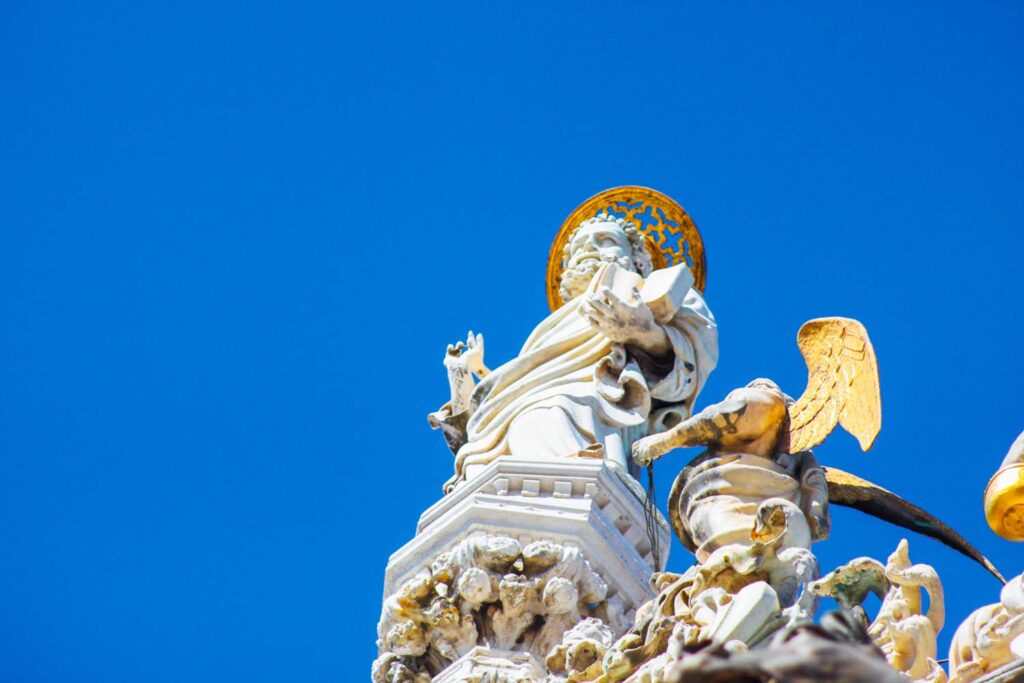
Admission & Tickets to St. Mark’s Basilica
If you want to go inside the Basilica, be warned that the queue can get very long. And you need to book your tickets in advance and select the exact arrival time. But even with these timed tickets, you will still need to wait in line. Reserved timed tickets to cost €20.50 and include an audio guide. There is also an option to purchase a skip-the-line ticket, but this will cost €39. Free cancellation is included in your ticket, which must be done 24 hours in advance for a full refund. I would choose the earliest reservation time to ensure you are the first in the door, leaving the rest of your day open.
No large bags or backpacks are allowed inside the basilica. If you have one, leave it at the Ateneo San Basso in the Piazzetta dei Leoncini (at the north facade to the left of the main entrance.) Be sure to do this before you get in line as you don’t want to be turned away and have to line up again. Remember that the basilica requires guests to adhere to their dress code. No bare shoulders or shorts, and men should wear shirts.
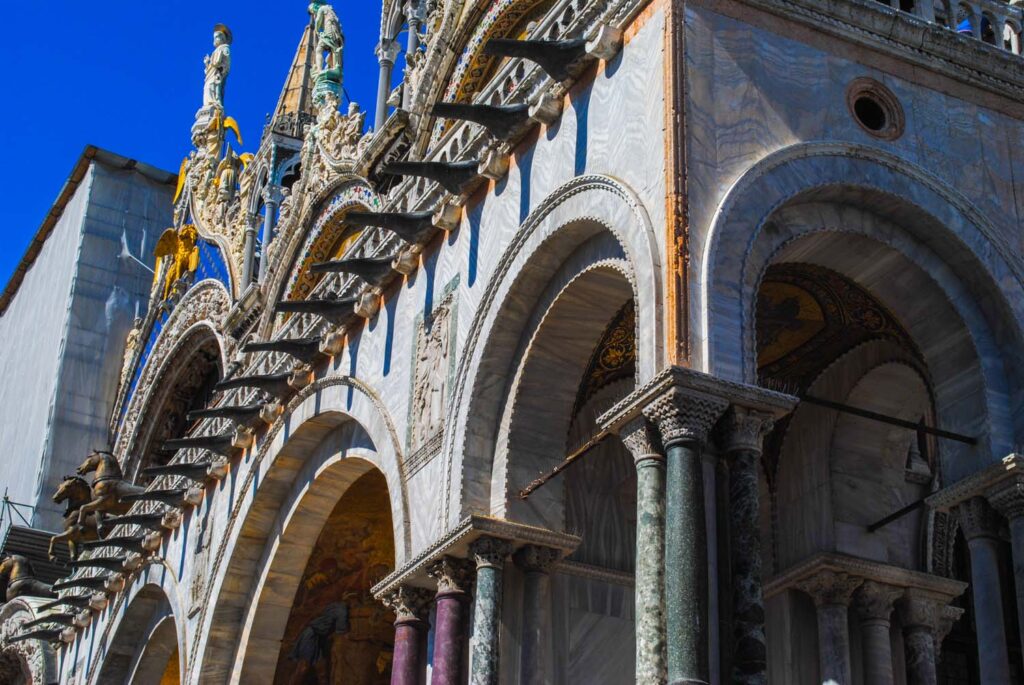
Interior of St. Mark’s Basilica
Upon entering the church, you’ll first notice the overwhelming amount of golden mosaics covering everything from the floors to the ceiling of the building. There are over 85,000 square feet of mosaics in St. Mark’s Basilica. The light reflects off the surface of the glass, and depending on the time of the day, the light can change the effect and the appearance of the interior. There was such a large amount of gold used in the church’s construction that the residents of Venice began to call it the Chizea d’Oro or the Gold Church .
View this post on Instagram A post shared by Erika Diehl (@circa_naviculam)
Because the Basilica was built during the Byzantine age, architectural methods weren’t as advanced as they are now. You’ll notice thick walls, hundreds of columns and the heavy use of marble, which were used as rudimentary supports. They needed to use the strongest of materials to help keep the multi-domed ceiling from caving in.
Inside the church are the treasures of the fourth crusade on the holy land. During the 4th century, Venice deemed itself the holiest place on earth. And therefore, all the treasures crusading armies found were brought to Venice. One such treasure was the Pala d’Oro . The Pala d’Oro is the frame enclosing the high altar inside the church. It is decorated with panels featuring 1,300 pearls, 300 emeralds, 300 sapphires, 400 garnets, 100 amethysts, rubies, and topazes. A glittering masterpiece.
View this post on Instagram A post shared by Matt Rochell (@mattrochell11)
Porta Della Carta
When you exit the church, be sure to take a moment to study the Porta della Carta on the south side of the church. In 1442, the ceremonial entrance was built to connect the basilica to the Doge’s Palace . The doorway is dripping in gothic ornamentation, with two tall, thin pinnacles flanking either side of the statue of the Doge Francesco Foscari. The statue of the Doge is seen kneeling before the Lion of Saint Mark. Below each pinnacle, we can also spot various statues representing the cardinal virtues.
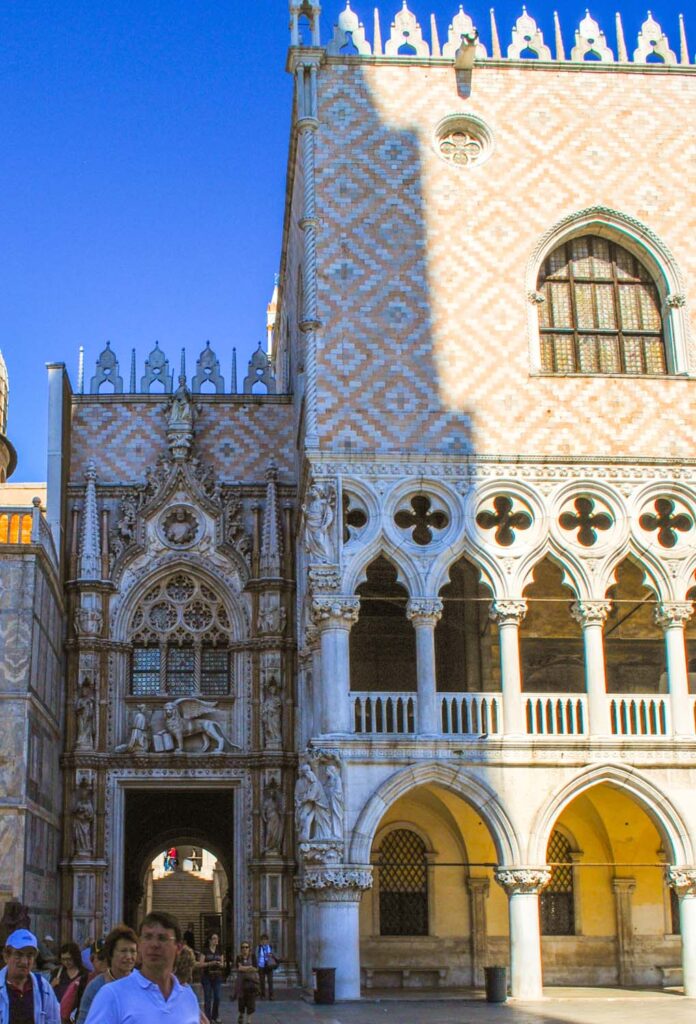
Doge’s Palace
A Venetian Doge is something that many of you may not have heard of before. A Doge is pretty much like an English Duke; who served as the leader of the Republic of Venice from 726 to 1797. The Doge would rule over Venice from his seat of power inside the incredible Doge’s Palace . Today the building serves as a public museum .
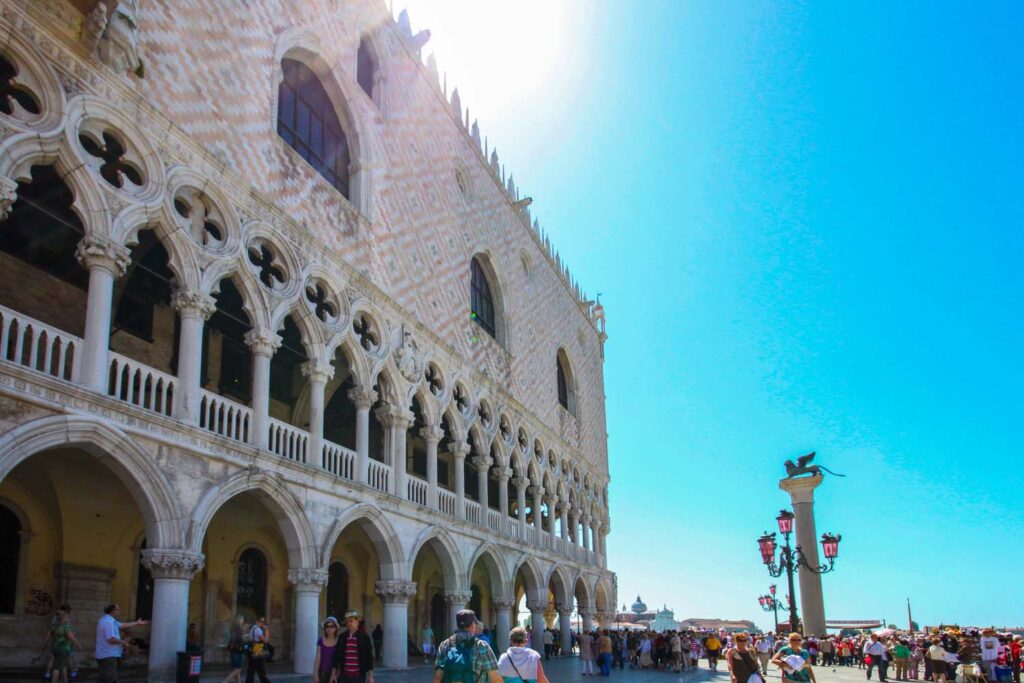
The building itself is a wonder to behold. Despite the enormity of the upper structure, it looks almost weightless as it is supported by these delicate pink Verona marble columns. The columns are decorated with a lacy pattern, making them look even more fragile. The top of the building is adorned with spiked merlons that look like meringue frosting atop this architectural cake.
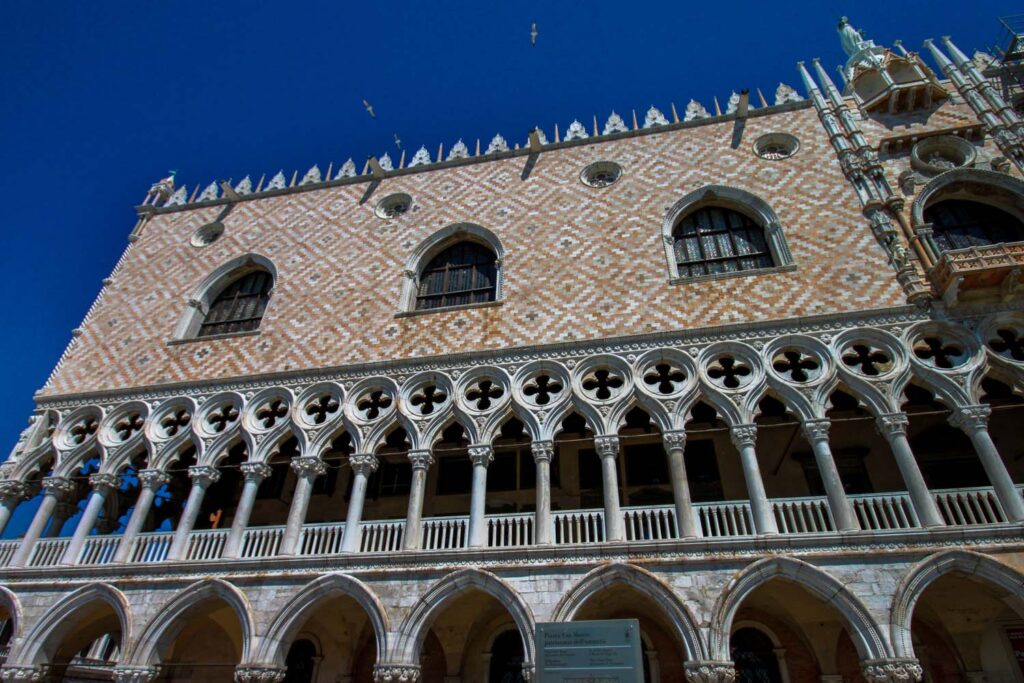
Walk through the arcade under the Doge’s Palace and study the individual capitals atop the exterior columns. Each one features a different set of sculptures with various animals, vegetal designs and more!
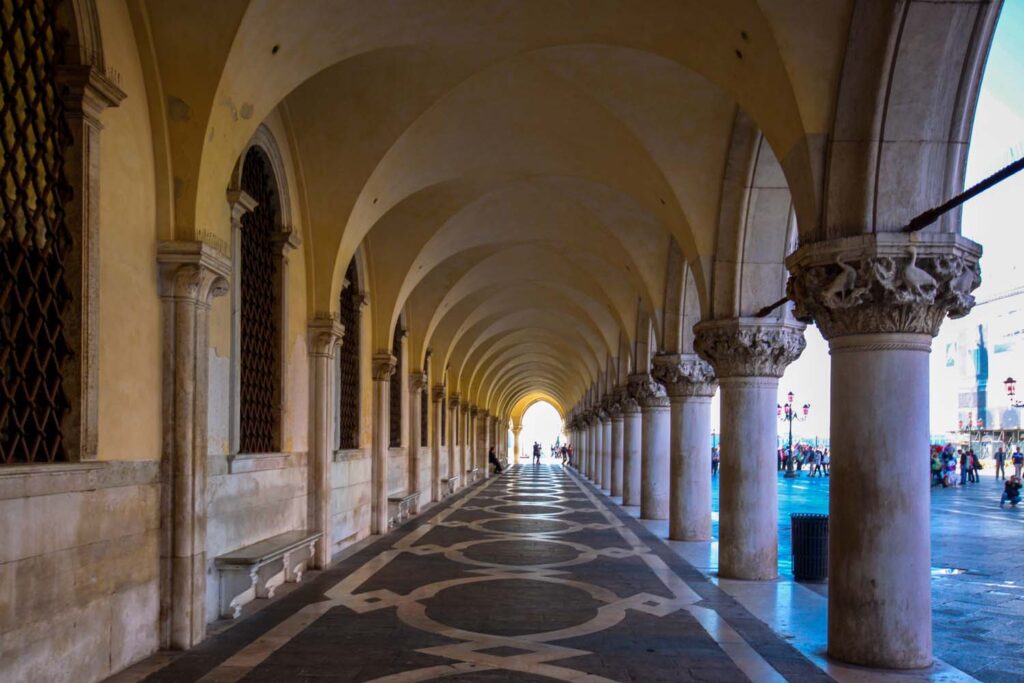
Piazzetta
Past the Basilica, walk south towards the water, where you can find the Piazzetta . The Piazzetta is the smaller square to the south of the main square. In the middle of the square are two large two columns made of red marble. These two columns were where death sentences were announced during the medieval ages.
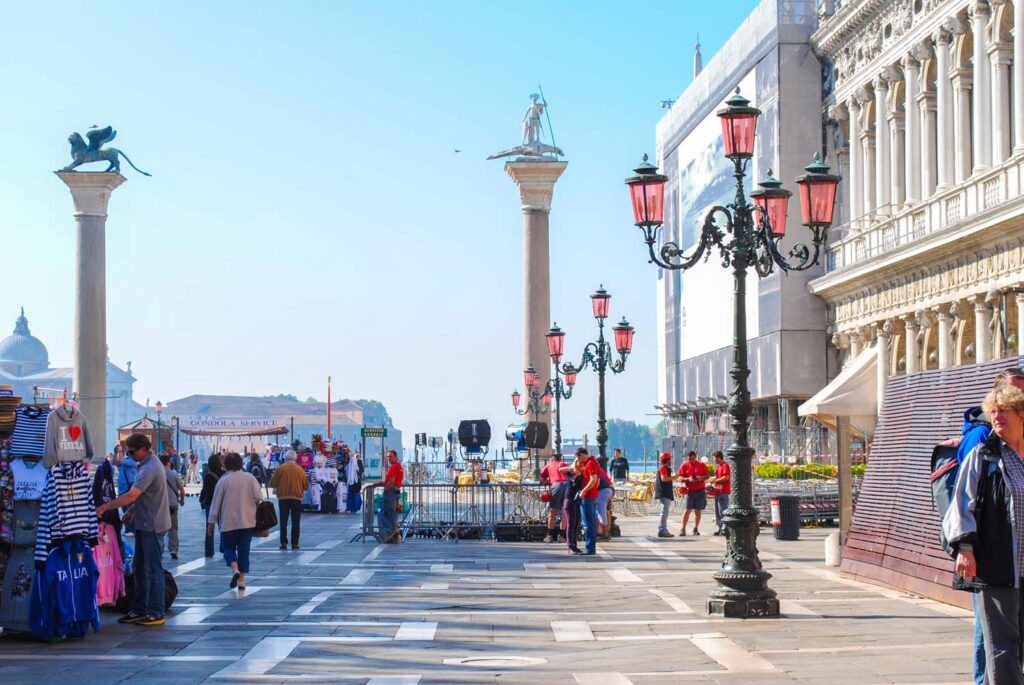
At the top of the columns are two statues. Each depicts one of the patron saints of Venice, St. Mark and St. Theodore , on the left and right, respectively, if you’re facing the water. St. Mark is depicted as the winged lion of Venice, and St. Theodore can be seen standing atop, of all things, a crocodile . In his hand, he holds a spear which we can assume he used to slay the giant crocodile. Saint Theodore is commonly known for slaying a dragon, not a crocodile. But perhaps the Venetian artists of the time had little knowledge of what a real dragon looked like, so instead, they carved the next best thing, which I guess was a crocodile. Makes sense when you think about it!
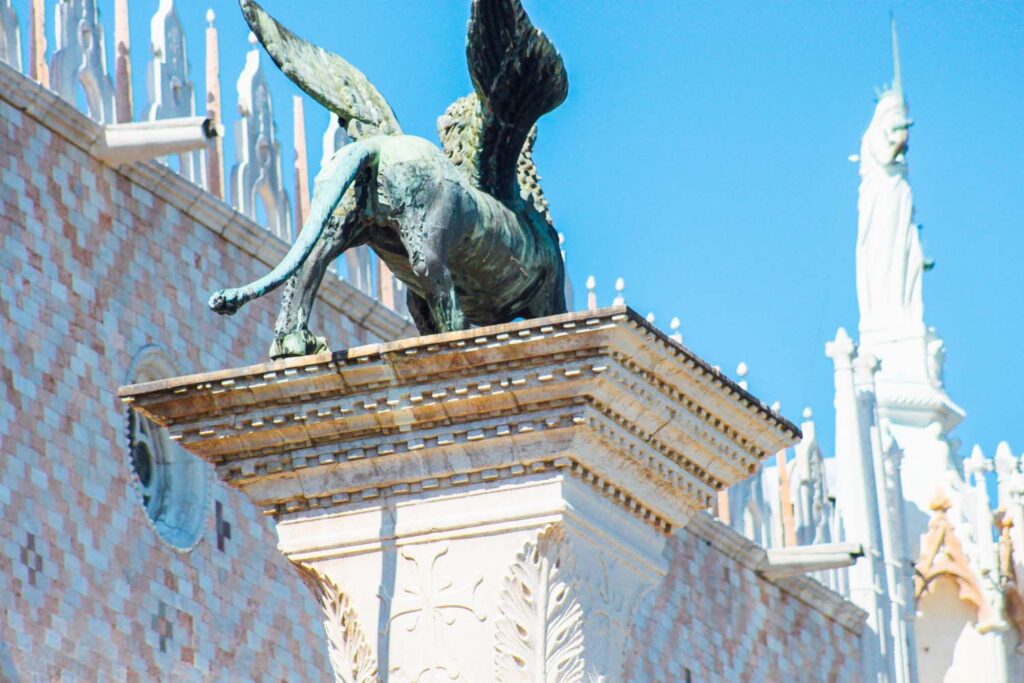
The Bridge of Sighs
Walk around the Doge’s Palace until you turn to face the Bridge of Sighs . The bridge of sighs was created to join the interrogation rooms of the Doge’s Palace to the prison across the canal. If you were found guilty by the Serenissima, you were sent to prison, but upon crossing the bridge, you were allowed to look out at Venice one last time. Two small, square windows on the bridge allowed prisoners this one moment of reflection before facing their possible lifetime of imprisonment. The windows on the bridge are covered in tightly knit wrought iron bars, so no one could make an escape.
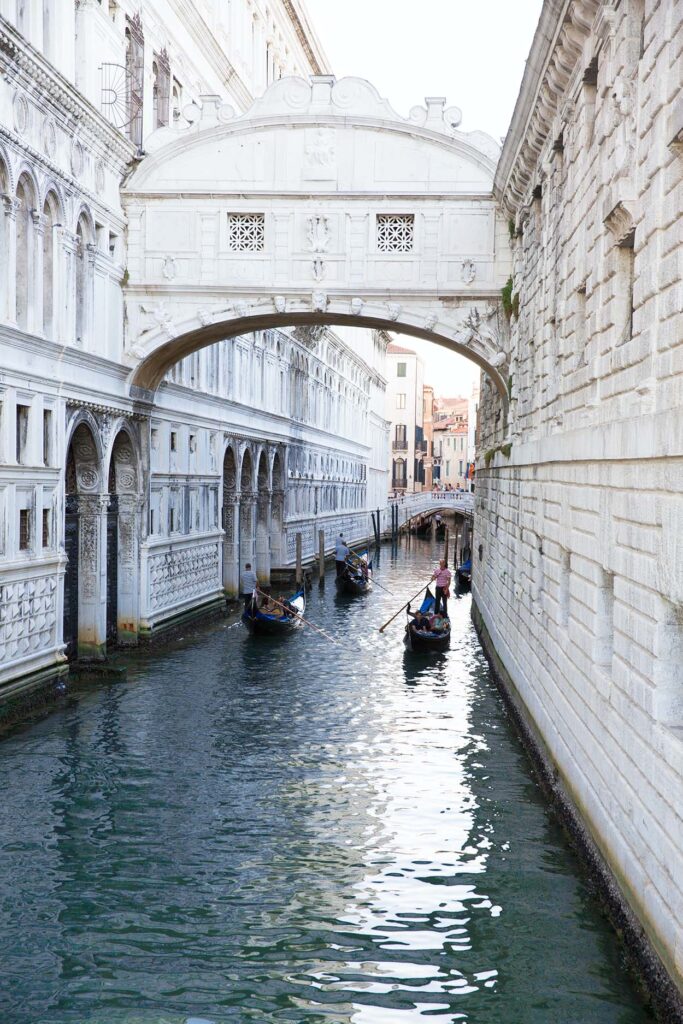
Calle de Fabbri
Head back to the area in front of the Basilica, and walk north along the Calle de Fabbri , crossing over the Ponte dei Dai . Calle is the Italian word for a narrow street. Like many streets in Venice, this one is named after the occupation of the people who worked in this area. Fabbri means locksmith , and it was along his street where you’d once have found the city’s locksmiths at work. Head northwest on Calle dei Fabbri and turn left onto Calle S. Gallo until you reach the Ponte Tron .
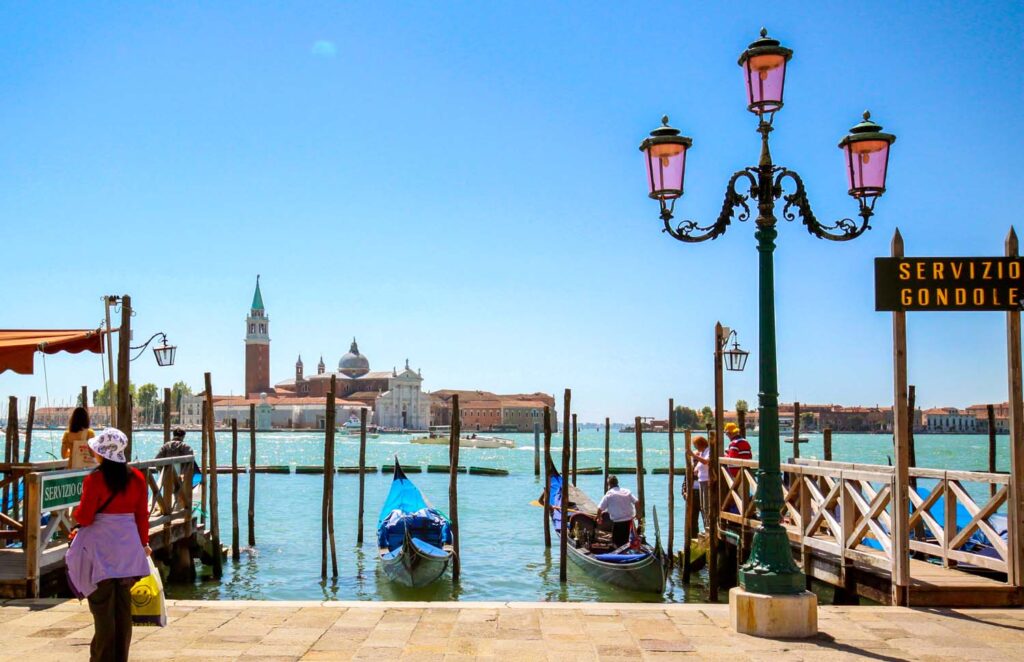
Due to the proximity to St. Mark’s square, this bridge is often pretty crowded. But its old stone design and views out to the gondola-covered canals aren’t anything to whizz past. If you’re lucky enough to be here when it’s quiet, this is one of the more romantic spots in the city. Even on busy days, I love just standing here just watching the gondola traffic. Sometimes dozens of gondolas get stuck in this narrow canal. See, even Venice has traffic jams!
View this post on Instagram A post shared by Nat & Mase: GoTo Travel Guides (@natandmase)
Pont dei Fuseri
Continue southwest on Calle Tron, turning right onto Calle Frezzaria as it curves and becomes Calle Barcaroli. Make a right north onto Ramo dei Fuseri to the bridge Ponte Dei Fuseri. There are 400 bridges in Venice which cross 150 canals! Before Venice’s bridges were built, these little islands all acted as their own private communities. These communities needed to be self-serving with their own churches, markets, shops, and micro-culture. Even today, you can still make out the borders of these various micro-neighbourhoods as you cross from one bridge to another. As you reach the Pont dei Fusari , you are finally starting to get away from the tourist crowds, and the real Venice starts to open up for you.
View this post on Instagram A post shared by Mirko Franzo (@mirko.pn)
Continue along Calle dei Fuseri and turn left onto Calle de la Vida o de le Locande. Then, turn left onto Scala Contarini del Bovolo, where you’ll find the towering Palazzo Contarini del Bovolo.
Palazzo Contarini del Bovolo
This brick Palazzo Contarini del Bovolo has become an iconic viewpoint in Venice. The Palazzo’s incredible, honeycomb-like spiral staircase, with a fantastic balcony at the top, provides one of the most amazing views across the city and over St. Mark’s square. The staircase is called the “Scala Contarini del Bovolo ” or “the snail.”
Built in the 15th century for the wealthy Contarini family , the house became notable for its unique outer staircase. In 1952 Orson Welles also fell in love with the house. He even featured it in his film adaptation of Shakespeare’s Othello . The Palazzo was closed for many years, but in 2016 it opened its doors to the public. You can climb the stairs to the top for three euros and get a snap of the skyline.
View this post on Instagram A post shared by Janet Magnin (@janets.planet.25)
Corte Teatro & Teatro Goldoni
Head back to the Calle de la Vida o de le Locande and walk west towards the Calle de la Vida o de le Locande/Campo Manin. Turn right onto Rio Terrà S. Paternian, then make another left onto Calle Minelli. Walk along Minelli until you reach the Corte Teatro. Walking along the Corte Teatro until you come to the square at the end of the street.
This dreamy square, with a lovely nearby cafe, is surrounded by red and yellow-painted buildings. But dominating the square is also a HUGE boring grey wall. Why are we looking at a large grey wall , you ask? Well, this is the back entrance to the Teatro Goldoni . But Why are we looking at the back, not the front? Well, the front is even less interesting if you can believe it. But the history of this building is such an important part of Venice’s past that it’s worth stopping here for the story!
During the 17th century, trade had begun to twindle in Venice, with other European ports being able to accept larger ships than Venice. Rich families who had made their money in trade needed to suddenly find other means of earning funds. In the 17th century, Opera was quickly becoming the most popular activity for the aristocrats to indulge in. But at the time, it was only performed in private courts. Seeing an opportunity here, rich Venetian families began to invest in building theatres that could bring Opera and music to the public.
View this post on Instagram A post shared by M. Colley (@colleytravels)
Teatro Vendramin
Suddenly, theatres began to pop up all over Venice, each vying for the most popular singers to draw in the biggest audience. The Teatro Vendramin was the original name of the first theatre, which stood here in 1622. It was built by the illustrious Vendramin family . The theatre was renovated in 1720 and named after the infamous Venetian actor Carlo Goldoni .
But the renovation of 1720 destroyed all of the original, elaborate Renaissance architecture, and we were left with the boring interior and exterior design you can see today. Luckily, some intelligent historians preserved the archives before the renovation. This included a copy of every play, the list of previous actors and, most importantly, the original architectural drawings was saved as well.
The theatre was kept in the same family for years. And when it came time to restore it in the 19th century, architects could discover precisely what the original theatre looked like inside and restore its interior to its former beauty. Sadly, we are still waiting for the exterior to get the same treatment. Today, the theatre is used by the Teatro Stabile del Veneto to put on modern productions and musical performances.
View this post on Instagram A post shared by Elvis Nick (@elvisnick_official)
The Grand Canal
Continue walking north along the Corte Theatro , through an almost impossibly narrow alley, until you emerge out into the bright light of the Grand Canal along the Riva del Carbon . As this is the first time we are really faced with the view of the Grand Canal, we should talk a little bit about this ever-so-important waterway. The Venetian Grand Canal splits the city of Venice in two.
The original waterway was much narrower and was a branch of the river Brenta . Ancient Venetian fishermen were once the only ones who lived along its shores in simple stilt houses. Stilt houses ensured the rising tides didn’t wash their houses away.
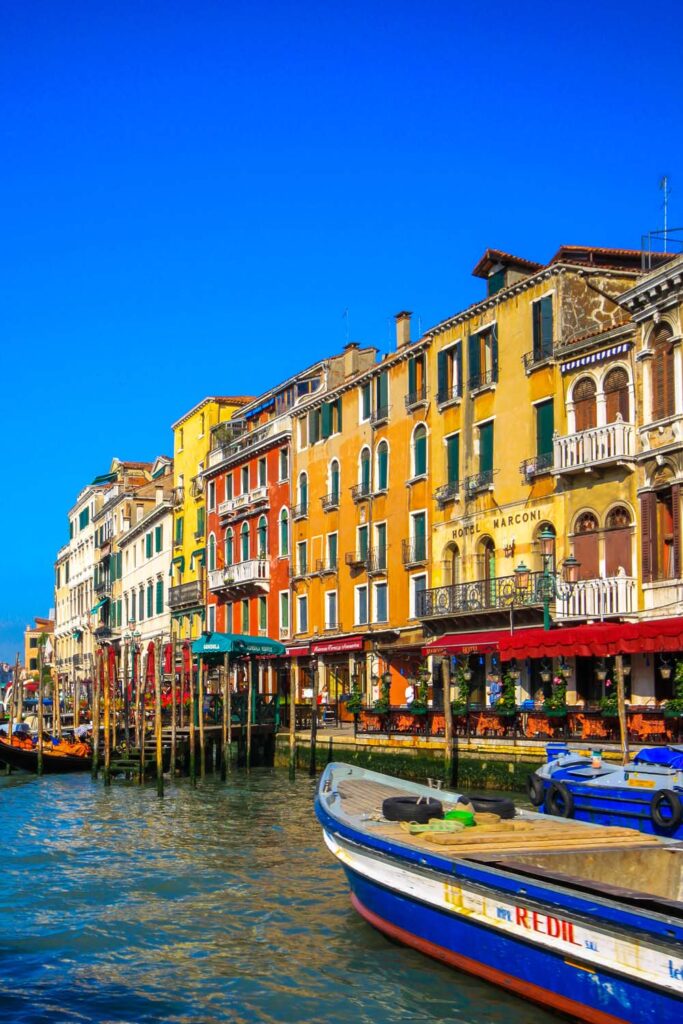
History of the Grand Canal
It wasn’t until the 9th century, when the Doge moved his palace into the more protected area of what would become St Mark’s square, that the canal was widened. A broader canal was needed to make room for the enormous ships which were brought in and used to bring building materials for the grand palace. The canal soon became less of a fishing spot and more like a luxurious main street, but one made of water. Wealthy families began buying cheap property and building huge manors along the now Grand Canal.
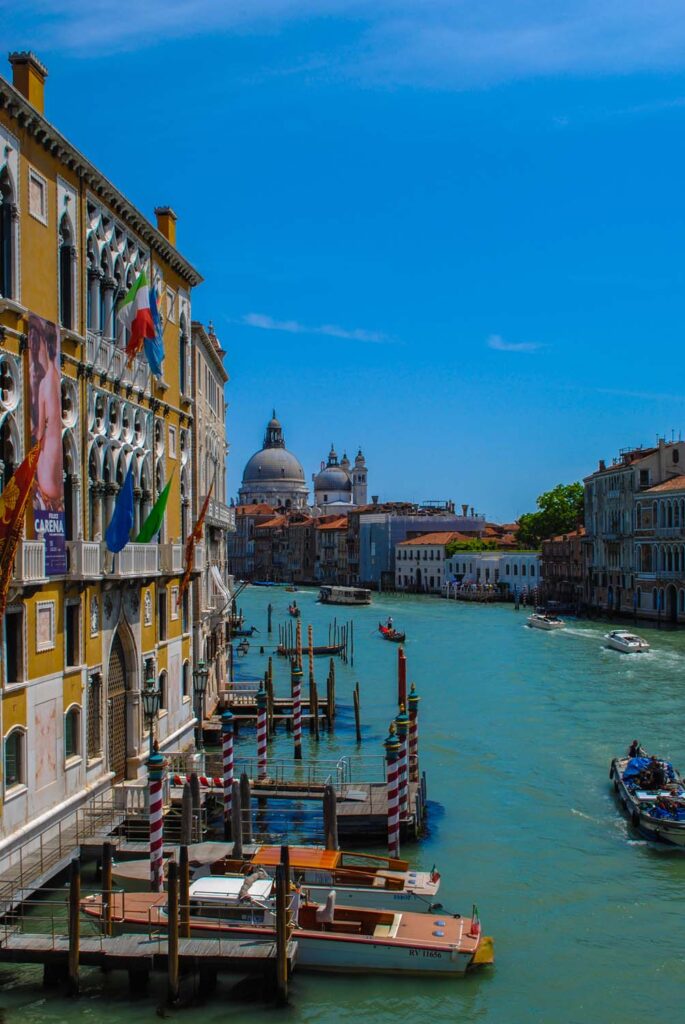
The grand canal was now the main entryway into the city, and the Venetian Republic wanted every building lining it to demonstrate the city’s power, wealth and artistic sensibilities. Like a parade of the best architecture Europe had to offer. This huge canal is now flanked by 170 illustrious buildings. Some dating back to as early as the 13th century.
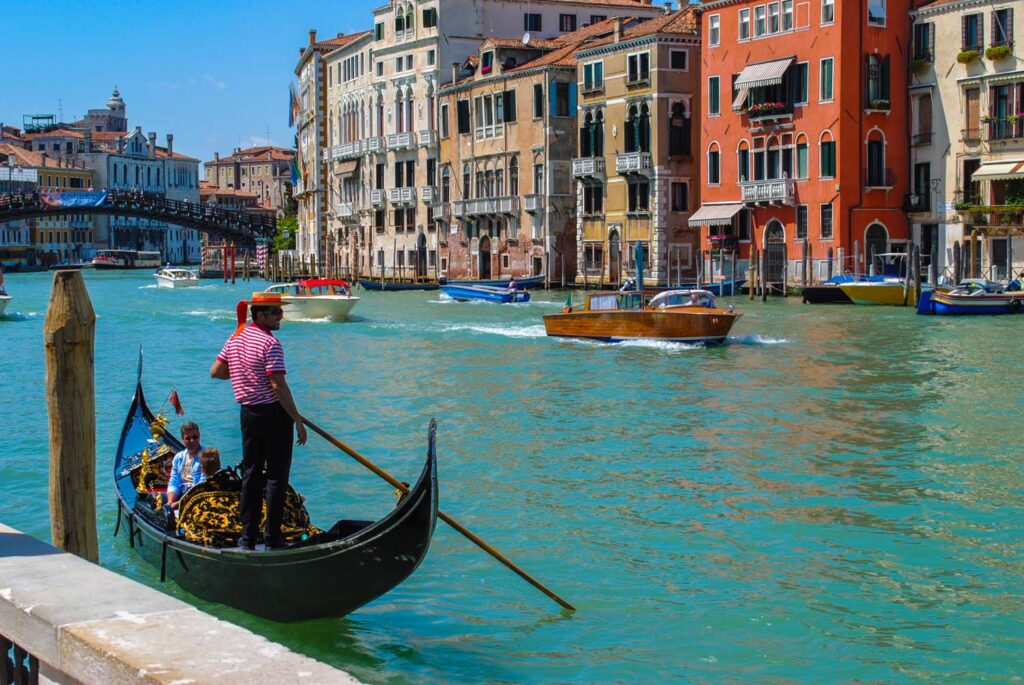
Palazzo Bembo
Turn right and walk along with the Riva del Carbon until you reach a stone bridge. Stop just before the bridge to admire the red building to your right. This is the Palazzo Bembo . This unbelievable building was owned by the Bembo family and was built in the 15th century! Obviously, there has been many renovations and restorations over time, but the original structure shockingly remains much unchanged.
The design of the building encompasses much of what traditional Venetian architecture looked like in the 15th century. The Byzantine influence was still going strong! And you can spot various of their traditional elements fused together here in the polyforms which cover the facade. A polyform is a multi-light window used on the upper floors to bring light into the structure by using wider openings.
View this post on Instagram A post shared by Manuela (@manubi6)
Pietro Bembo was born in Venice in 1470 and built the Palazzo Bembo as his lavish residence. Pietro Bembo was one of the most influential Venetian scholars and writers who helped develop the Tuscan language. He also spent much of his life creating and promoting a madrigal , a secular form of music developed during the Renaissance. He believed that music should be for more than just religious devotion. That music could be used to express everyday human emotion. That seems obvious to us now, but at the time, music was mainly composed for the church. And the subject matter was exclusively religious. We have Pietro Bembo to thank, in a small part, for why we have pop and rock music today!
Rialto Bridge
Continue along with the Riva del Carbon as it turns into the Riva del Ferro , walking along the edge of the Grand Canal. Emerging from the last arcade, you’ll be greeted almost immediately by the sight of the bright white stones of the Rialto bridge . The Rialto Bridge is the most famous of Venice’s canal bridges. It is also the oldest of the four major bridges connecting the various districts and neighbourhoods. The original bridge built here in 1173 was first made of wood. It went by the name Ponte Della Moneta , which means “ money bridge .” The name reflected the industry of the area. This was where the largest mint in Venice once stood. People would flood into their area and cross the bridge at all hours of the day to deposit and take out their cash!
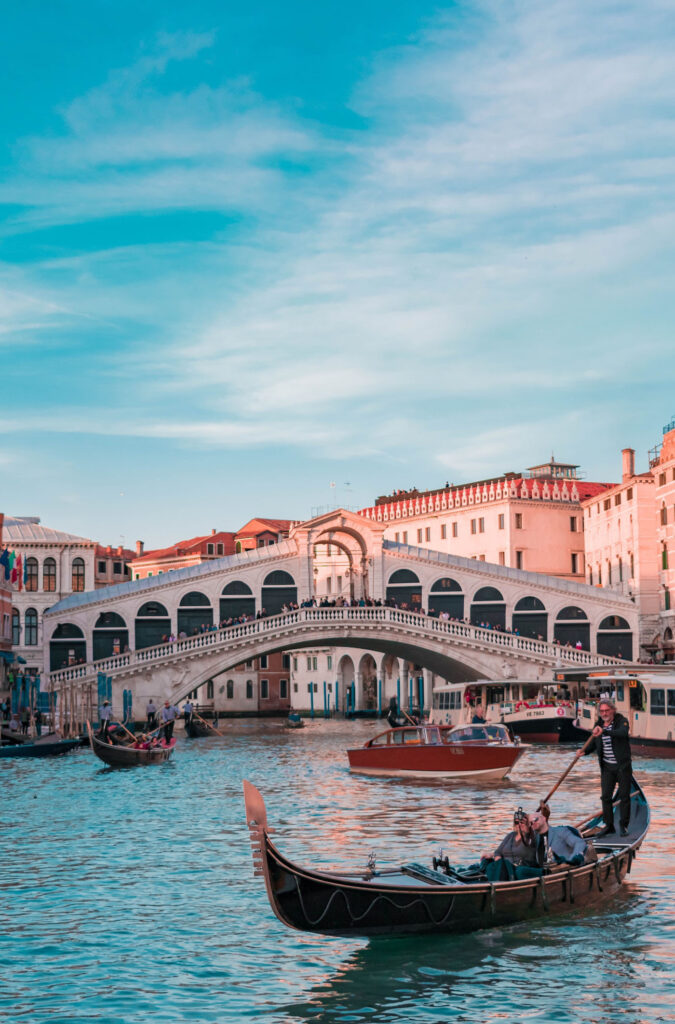
The old wooden bridge was split down the center and could be raised on either side to allow tall ships to enter these narrow canals. This was of the utmost importance, especially when the Rialto Market opened, as boats would come in mass to deliver fresh fruits, vegetables and fish to the centre of Venice. But as time passed, the old wooden bridge wasn’t up to snuff. After years and years of wear, riots, fires and crowds, eventually, it collapsed.
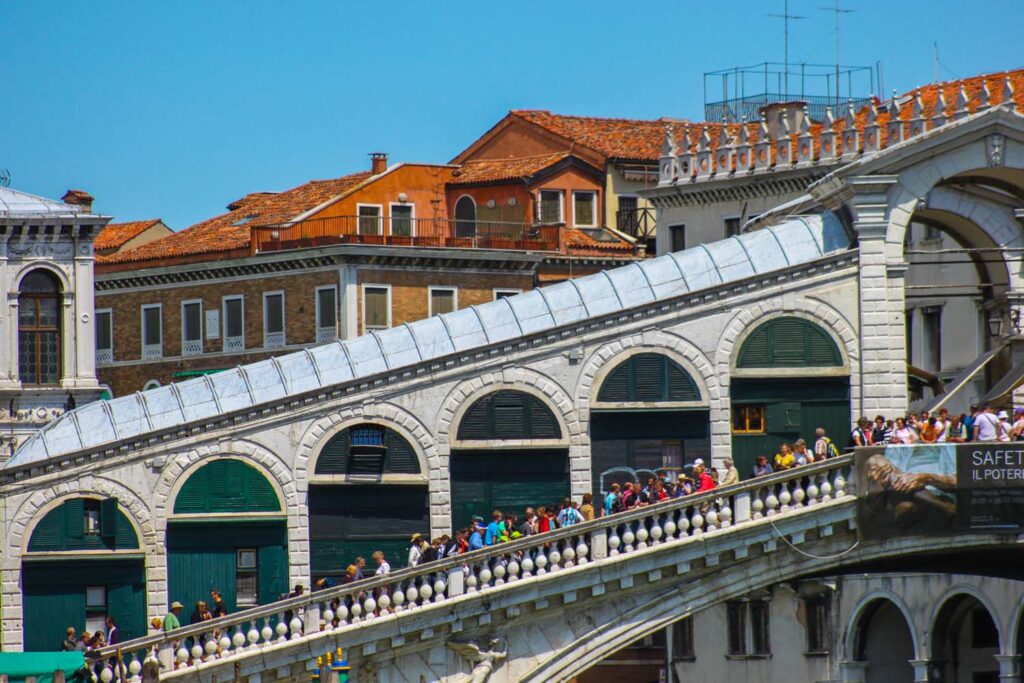
New Rialto Bridge
The new Rialto bridge design was completed in 1551. The architect who designed it did away with the raised wooden design and favoured stone as it was more durable and could last the test of time. Since the stone bridge couldn’t be raised, he needed to ensure that it was tall enough at its peak to accommodate the galley ships that needed to pass through. The result was this grand arched design that has such a theatrical quality to it.
Atop the stone bridge are a series of covered porticos which contain shops on either side. The addition of shops allowed the bridge to earn rent on the space. The money from this goes towards the maintenance of the bridge. A large arch, like the crown, is set in the center of the porticos atop this stunning structure.
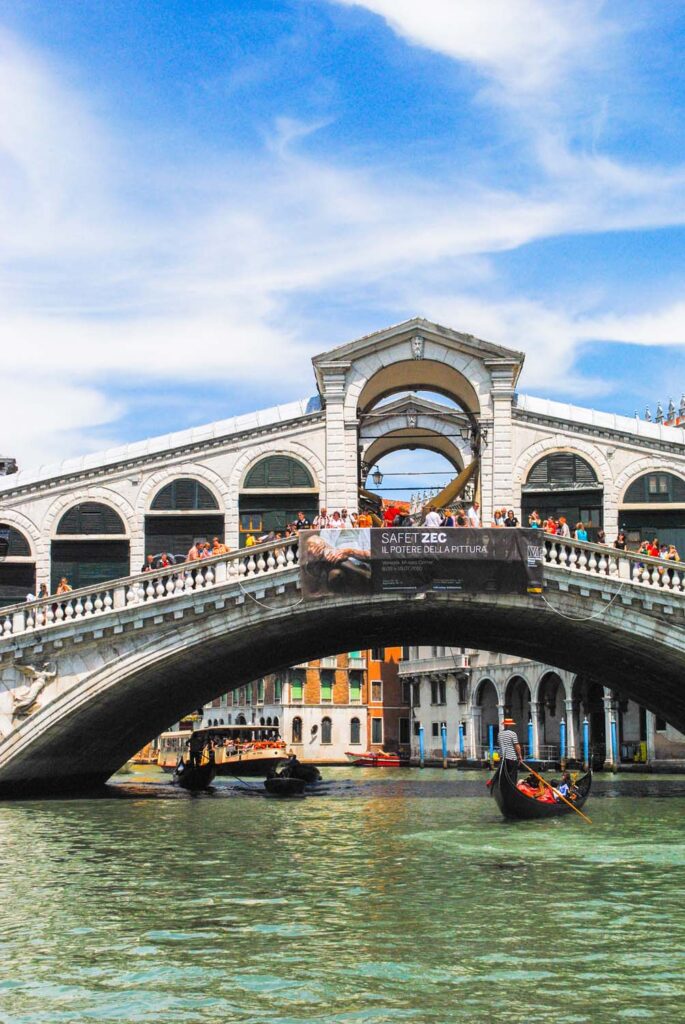
Avoiding the Tourist Traps
Unfortunately, the shops along the bridge are somewhat of a tourist trap, selling tacky souvenirs along the entire walkway. But, if you look at it from afar, you can ignore the tourist tat and focus only on the gorgeous silhouette it forms about the teal waters of the canal.
If you’re looking for a spot to sit to enjoy the view, there are these two little nooks on the bottom of the bridge where you can sit beside the water. This is one of the most amazing places to watch boats and gondolas float by, with stacks of fruits and vegetables coming into the market as the midday sun casts its bright rays down on the city. Once you’ve taken in all, there is to see below, walk up the bridge and make sure to stop in the centre to get that iconic view across Venice and the Grand Canal.
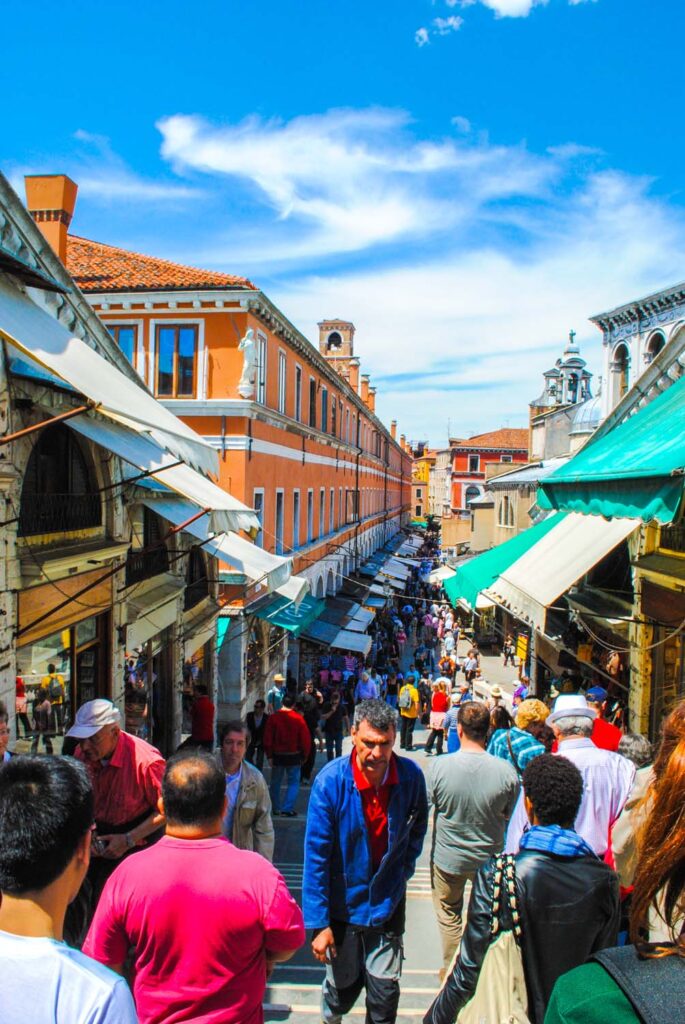
Chiesa di San Giacomo di Rialto
Crossing the bridge and heading to the island on the other side, you’ll walk through the Campo de San Giacomo di Rialto . This unassuming square is dominated by a rather small, strange-looking church. This is the Chiesa di San Giacomo di Rialto , supposedly the oldest church in Venice, consecrated in 421! The most unique aspect of this church is the huge clock set into its 15th-century facade.
This area of Venice, known as San Silvestro , was where all the wealthy bankers of the city lived. The bankers who lived here funded the church’s renovation, and while construction went on, they added a large clock and bell tower to its design. Being able to tell the time was of the utmost importance for traders and bankers. While clockfaces aren’t that uncommon on buildings around Venice, this one is absurdly large. Those bankers really wanted the most bang for their buck! It’s also interesting to note that the hours aren’t positioned as they are on modern-day clocks. Whereas most clocks now only have 12 number positions, this one displays all 24. Ironically enough, this clock is a notoriously bad timekeeper. So don’t be fooled if you think you’ve lost an hour of your life somewhere in the streets of Venice.
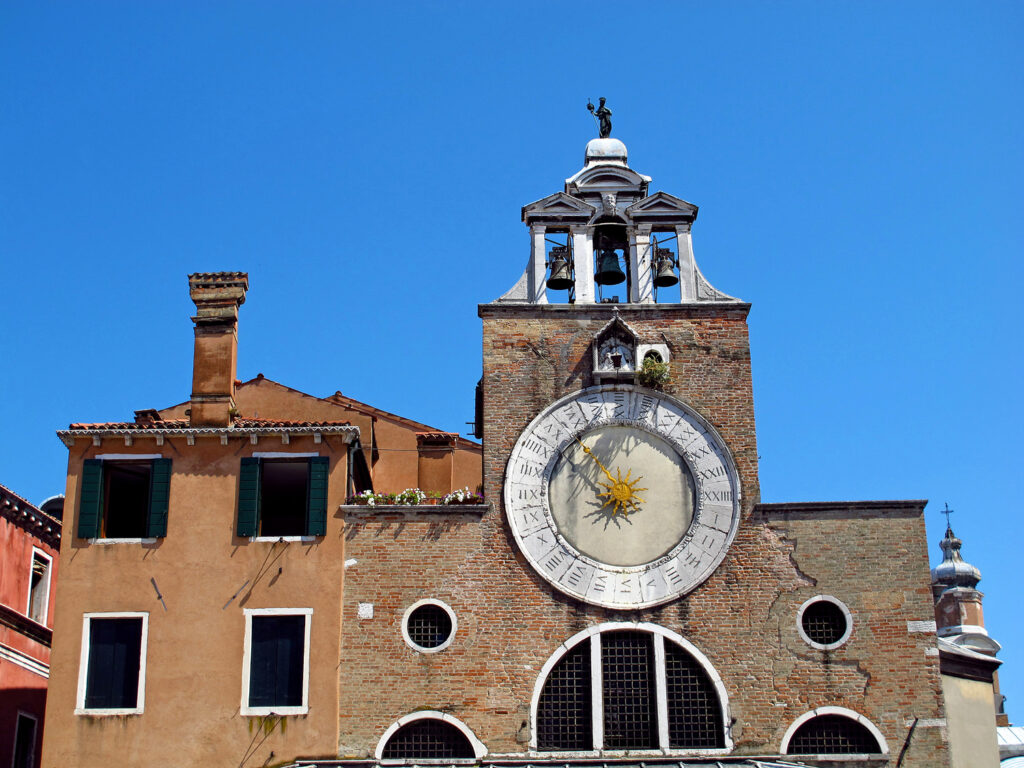
Venetian Street Names
As we make our way toward the Mercado di Rialto, we walk along the Ruga Degli Oresi. Like many streets in Venice, the Ruga Degli Oresi gets its name from the professions or trades which once were active in the area. Orsi means goldsmith , as there was once a large faction of gold and jewellery traders working here. Many other notable streets in Venice have the same kind of naming convention. There is the Calle de la Malvasia, where you’d find the winemakers.
The Campiello del Remer for the rowboats, the Calle de Forni, which was where you’d find the bakers, the Botteri for the coppers, Calle de Magazine for the grocery shops and even the C alle de Fiubera for the buckle makers! This would have made finding what you were looking to buy so simple! No need for yellow pages or even google! Find the street with the corresponding name, and you’re in the right spot.
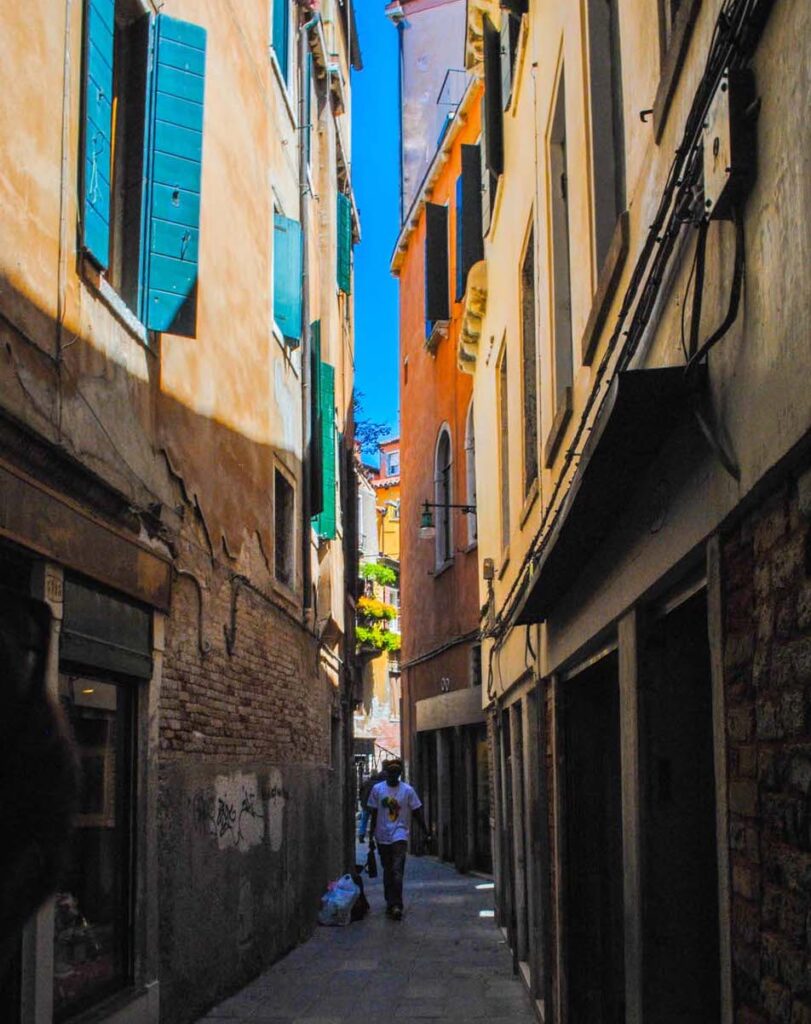
Mercado di Rialto
Now that you’ve been introduced to the city’s history, it’s time to meet the people of Venice. And there is no better place to get a peek into the real lives of its residents than to head to the Rialto Market ! The Rialto Market is one of the last remaining fresh food markets in the city and, as such, is a bustling place for locals to come and buy their food. Unlike in North America, where we shop for a week’s worth of food at a large chain grocery store, Italians buy only what they need for that day. And repeat the process every day of the week. While this might sound exhausting, it means fresh food every day and the chance to make lasting relationships with the vendors you buy your food from. Something I dearly long for and admire greatly when visiting cities like Venice.
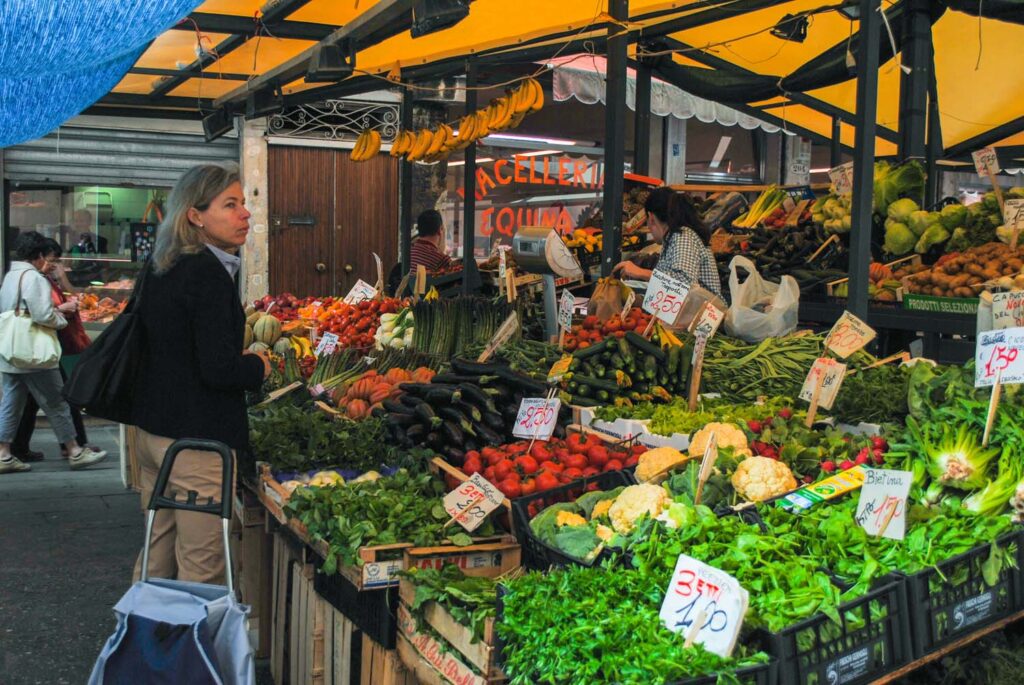
History of the Rialto Market
But the Rialto Market is much more than just a place to get some of the best food in the city! It is also a place of great historical value. Of all the rich bankers and traders who lived in the region, the most famous were the Rivoalto family. The Rivoalto traders were one of the first families to come into the lagoon to set up a trading post. They picked this location because it was well situated along the bend of the canal. This meant it was located on higher ground and therefore was spared from some floodings that other parts of the island suffered through.
The first known market opened here in 1097. Because the family didn’t have to constantly rebuild their homes, they were in a much better financial position than many other families in the area. There wasn’t home insurance to help you back then. The Rivoaltos grew in prominence and wealth and soon controlled so much of the neighbourhood that the area was named after them.
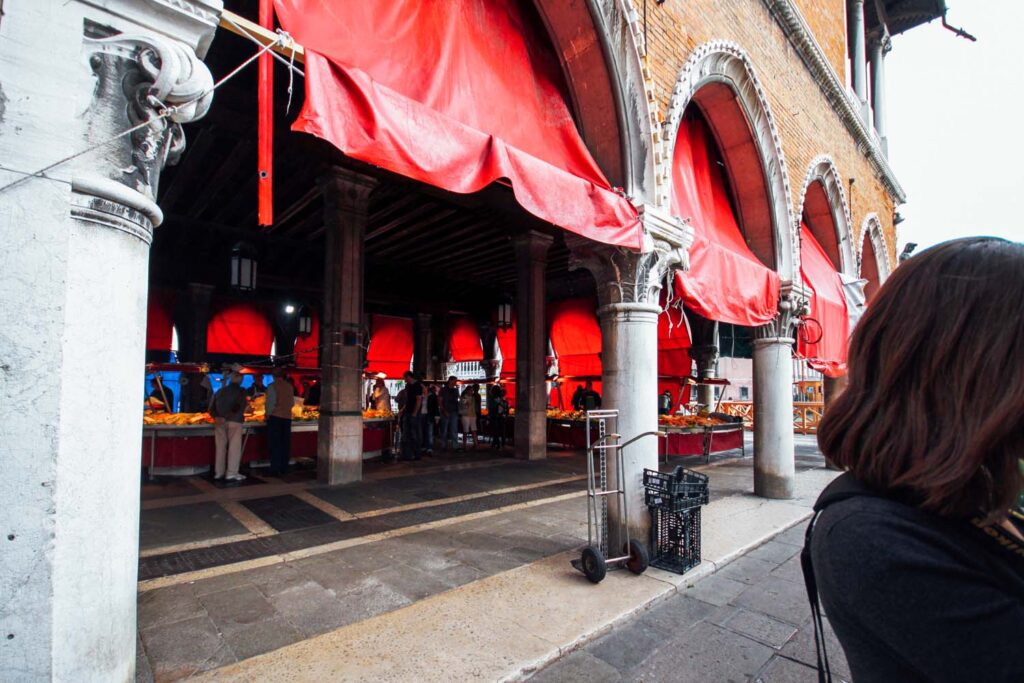
Layout of the Market
The outdoor portion of the market is where you’ll find seasonal fruits and vegetables under brightly coloured awnings. If you’re looking for a snack, there is nothing more refreshing than a basket of fresh fruit!
Opposite the green awning of the outdoor market is the neo-gothic fish hall, or Pescheria, built in the early 1900s. Outside the red brick building, there is still a marble plaque which you should study before heading inside. This plaque denotes the different types of fish allowed to be legally sold here when the marketplace was first built. Certain varieties of fish were being overcaught, and laws were set in place to ensure there was a limit on how many a household could buy to prevent their depopulation.
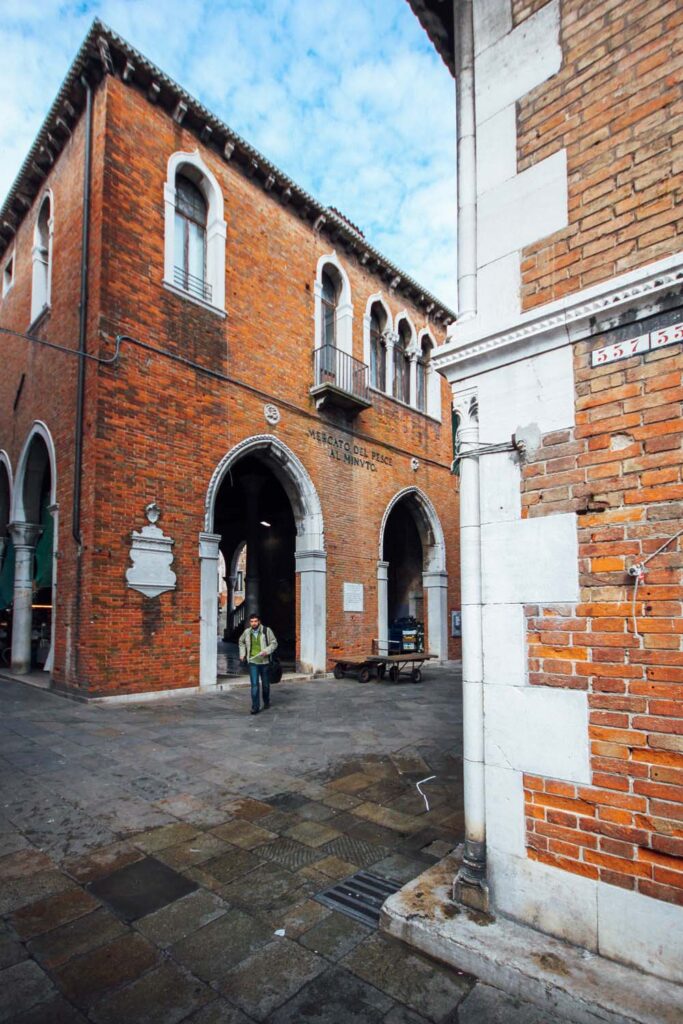
The Fish Hall
The fish hall is a rustic building with dramatic arches surrounding the exterior. Towering columns continue throughout the interior, making a simple stone building feel rich and illustrious. Fresh fish has long been one of the most important resources in Venice. All they have to do is throw out their rod, and the freshest fish comes jumping out of the sea and pouring into the market. It can’t get much more local than that!
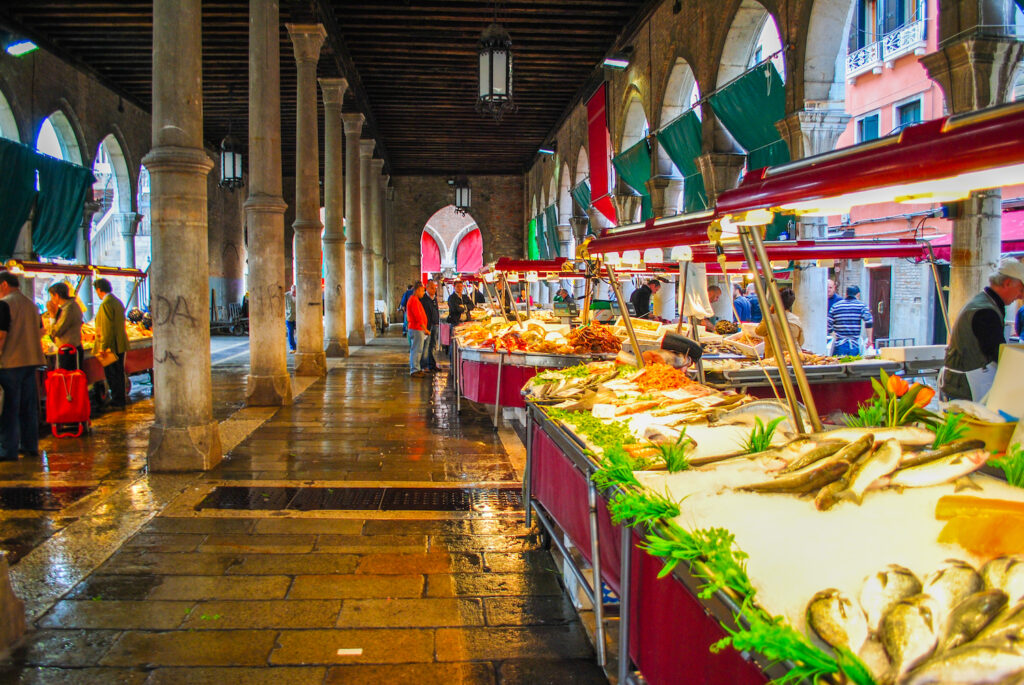
The marketplace was facing the chance of being shut down a few years ago due to a possible canal expansion for cruise ships. Thankfully, the citizens convinced the city to put a stop to this, and the market was saved. But as more and more people shop at larger grocery stores on the island, markets like this always face the chance of being closed. So if you visit, buy at least a little something to show your support. We bought some fresh raspberries and cherries, and they were absolutely delicious. The perfect on-the-go treat!
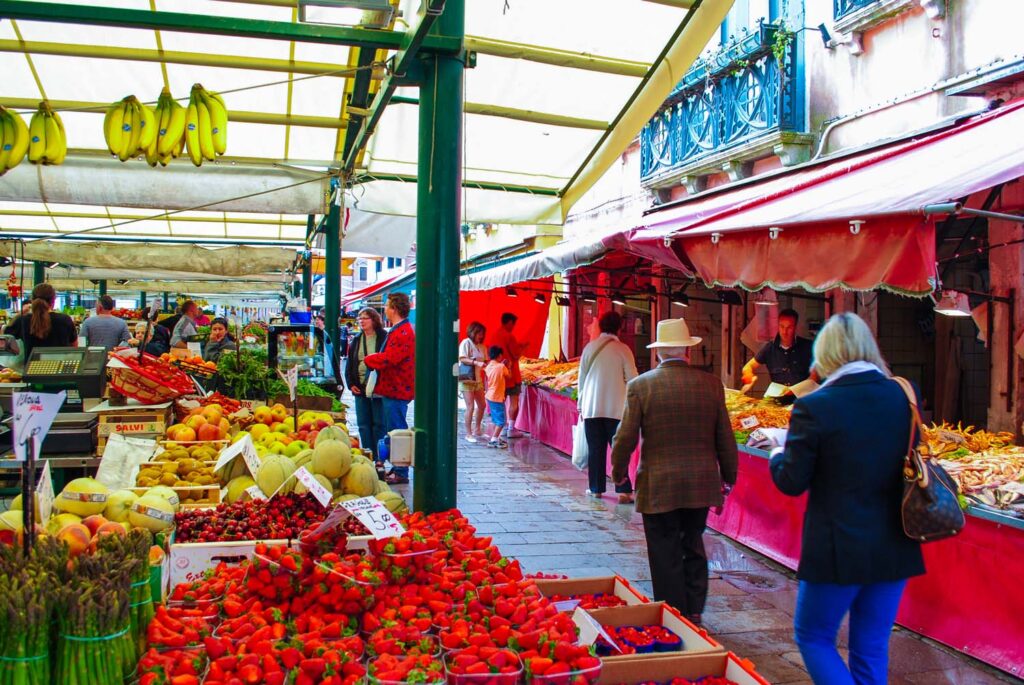
Ca’ d’Oro
Before heading to our next stop, walk to the corner of the Fondamenta de le Prigioni, across from the Campo de la Pescaria. From here, you have a perfect view across the Canal towards the Ca’ d’Oro . The Ca’ d’Oro of Palazzo Santa Sofia was an illustrious palace built along the Grand Canal for the Contarini family in 1428. The Contarini family was responsible for rearing eight different Doges and was one of the wealthiest families in Venice.
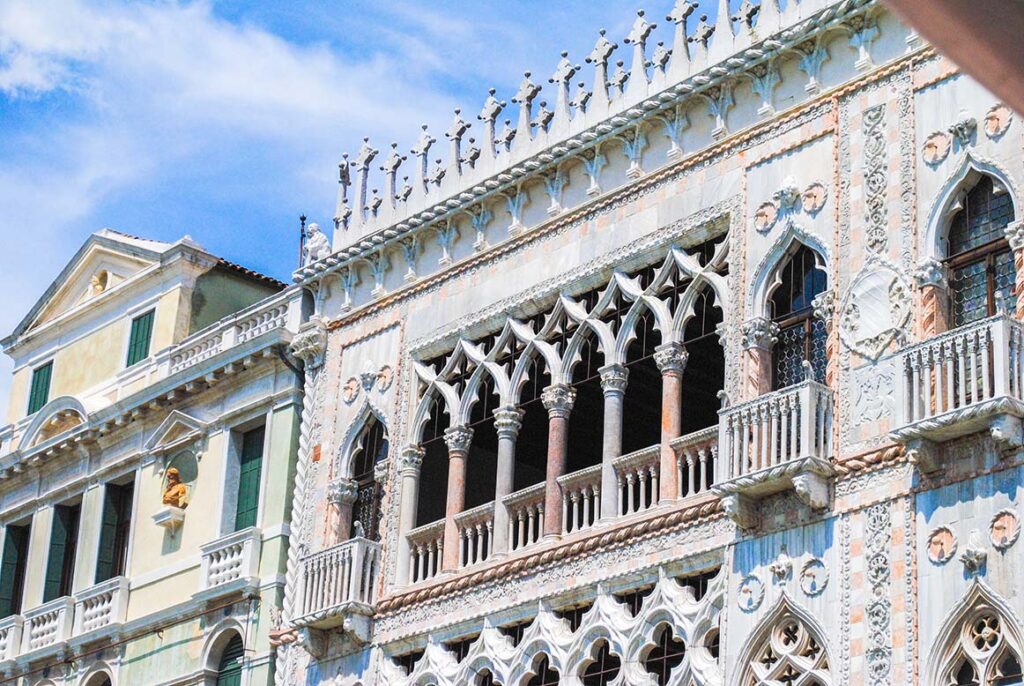
To show off their wealth and power, they wanted to create a palace that mirrored the greatness of the Doge’s Palace in St. Mark’s square. Ca’ d’Oro means the golden house . When the building was first constructed, the entire facade was covered in gilt polychrome, giving the effect of being made entirely of gold!
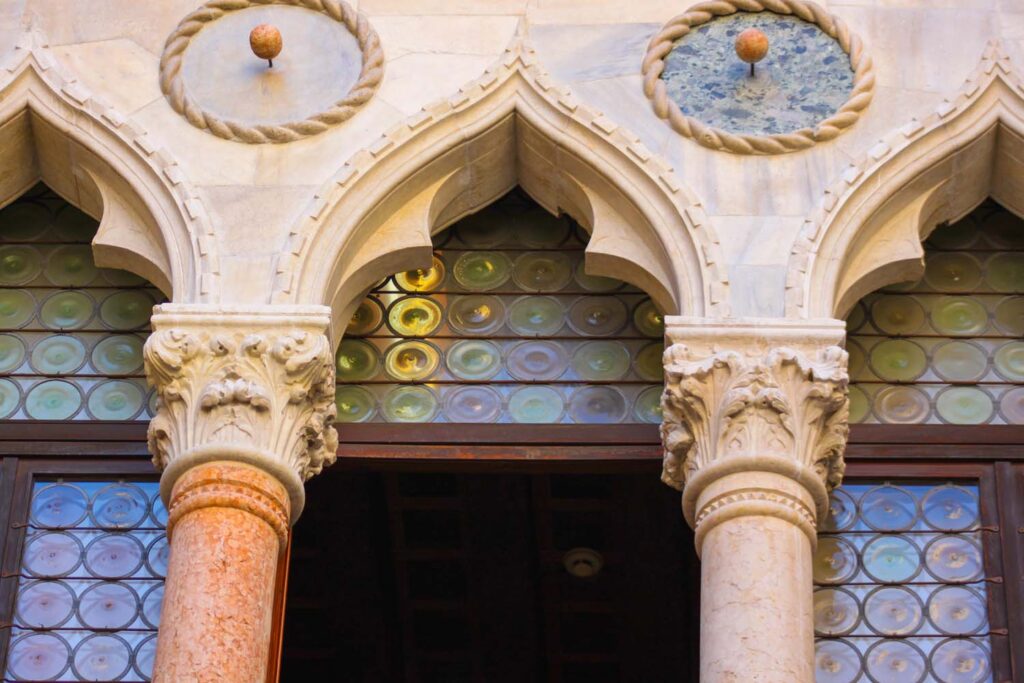
Venetian Gothic
The palace’s architecture is one of the best-surviving examples of Venetian Gothic architecture . The iconic elements characteristic of this style are gallery windows with heavy tracery details featuring quatrefoil designs and byzantine-inspired decorations. Ogee arches span the balcony’s facade, each capped with a wonderfully carved relief ornament.
Inside, the lavish details continue. Even the flooring was made into a work of art. Different coloured stones were used to create fanciful patterns. Since 1927, the building has served as the Galleria Giorgio Franchetti , which features a wonderful collection of 15th-century art.
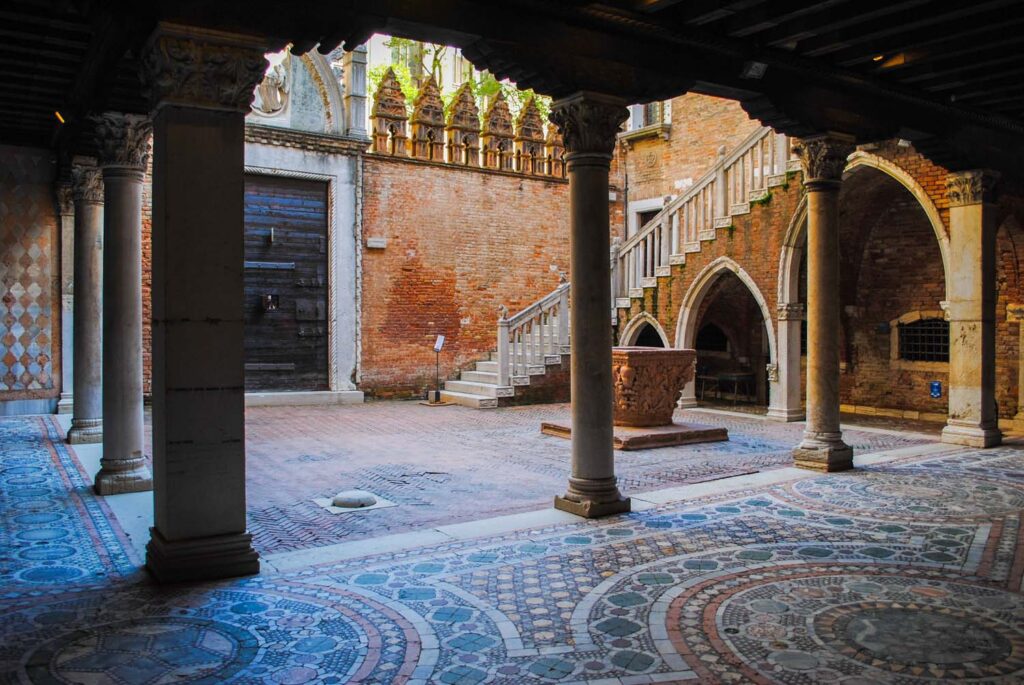
Riding a Traghetto
Instead of backtracking over the Rialto bridge to get to Cannaregio island (our next stop), we’re going to opt for a very Venetian method of crossing the canal, a Traghetto ! You can find the Traghetto ferry dock along the Fondamenta de le Prigioni , across from the Campo de la Pescaria . Walk over to the water’s edge, where you’ll see a small dock and what appears to be a series of black gondolas. “ But gondolas are so expensive! ” you say. And rightly so, they are. But these are not gondolas; they are traghetti . A traghetto (or traghetti if you’re referring to them as plural) means ferry in Italian. These little ferry boats take passengers across the Grand Canal when there are no nearby bridges.
This is essentially how many Venetians would have made these crossings long ago. A trip on a traghetto costs €2, which might seem a bit pricey for a quick journey, but they save you a ton of time. Plus, it gives you a short but sweet experience on a gondola-type boat. Sure, you might have to share it with a group but it’s the same design, just less romantic. The trip across the water provides a beautiful view of the Ca’ d’Oro from afar, so you can better study all of it in all its glory before getting up close and personal. The Traghetto will let you off at the Santa Sofia in the neighbourhood of Cannaregio.
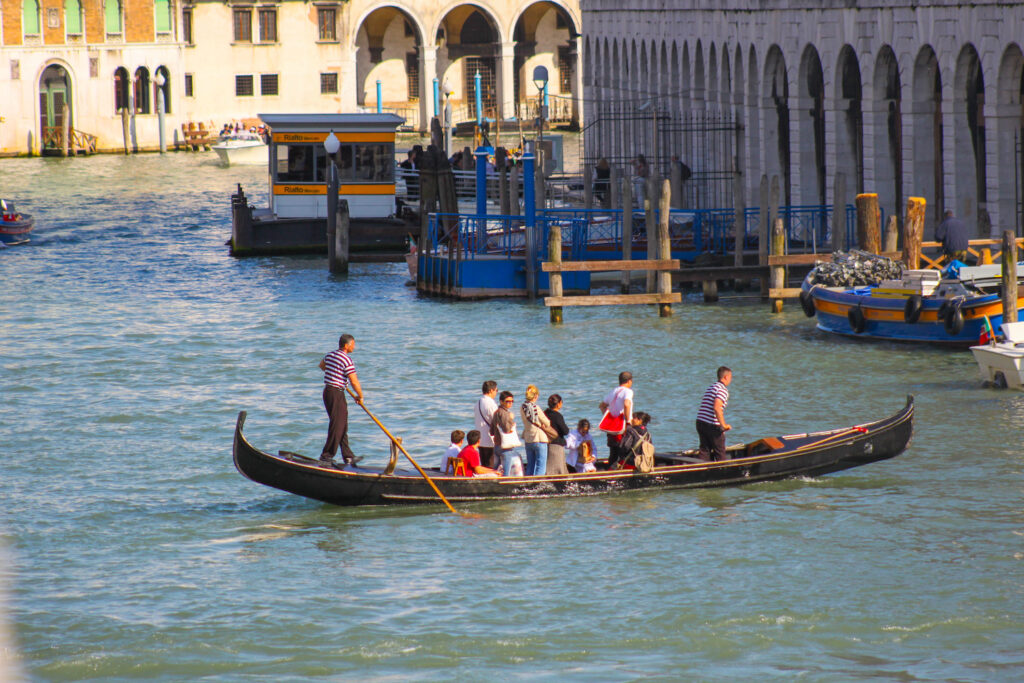
This area of the island is called Cannaregio . Cannaregio is home to the old Jewish Quarter and is where most of Venice’s permanent residents live. This means that you’ll see things more than just tourist attractions. Places like schools, corner stores, and traditional Venetian houses aren’t sprawling palazzos. If you’re looking for somewhere to stay in Venice, Cannaregio is my favourite spot, as it feels like the community’s beating heart.
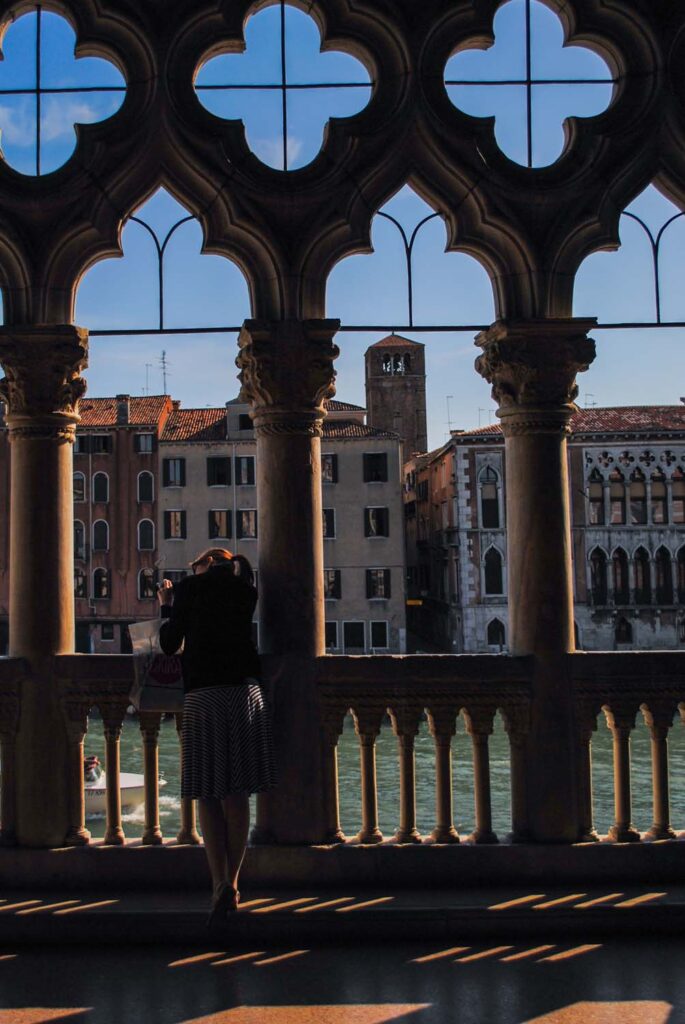
Ponte Chiodo
We are going to set off into Cannaregio via the Strada Nova. The Strada Nova a wide pedestrian street lined with shops and cafes. Turn right from the Strada Nova onto Fondamenta S. Felice. This is such a picturesque street and peaceful canal. As you look down along the canal, you can see four different bridges all along one short stretch of water. The most interesting of these bridges is towards the end of the street, called the Ponte Chiodo. The Ponte Chiodo dates back to the fifteenth century and is one of the last two bridges that doesn’t have any balustrades to prevent people from falling right into the canal! The city built another bridge just next to it with proper railings but kept the old one as a memory of the past.
View this post on Instagram A post shared by Matteo Belotti® (@_belotti.matteo_)
Scuola Grande della Misericordia
We continue west into Cannaregio across the Ponte della Misericordia to the first of two old schools we will look at. The Scuola Grande della Misericordia dominates the northern side of the sestiere Cannaregio. The Scuola Grande della Misericordia (New School of Mercy) was one of seven Scuole Grandi in Venice. These “Scuole Grandi” or “Great Schools” were religious and charitable organizations. Developed in the 13th century, they were the most important social institutions in the Serenissima Republic of Venice. The secular institutions played a crucial role in the fabric of political and religious life. The Old School of Mercy was built in 1308 in the typical gothic style (we will see this building at the next stop.)
But as the organization grew in size, a new building was commissioned to house the growing organization. Jacopo Sansovino was brought on to build the “Scuola Nuova,” or New School. Built in 1532, the imposing quadrangular structure was strongly influenced by Roman classicism. Building work continued over the next fifty years; unfortunately, Sansovino died before the building was completed. Today the building is used as a gallery and events space, but the exterior architecture has been preserved for us to admire.
View this post on Instagram A post shared by Caprioglio_Architects (@caprioglio_architects)
Scuola Vecchia della Misericordia
Head northeast on Sestiere Cannaregio toward Campo de l’Abazia . In this small square, you can see the old Chiesa dell’Abbazia della Misericordia in one corner and the original Scuola Vecchia della Misericordia in the other. The Scuola Vecchia della Misericordia (“Old School of Mercy”) was the first seat of the organization. When they built the new school, this building was sold off to the guild of the silk weavers in 1634.
View this post on Instagram A post shared by Leonardo Zonta // 1996 (@_zontaleonardo_)
Casa del Tintoretto
Continue west along Fondamenta de l’Abazia, across the wooden Ponte dei Muti, then along Corte dei Muti and turn left toward Fondamenta dei Mori. Along this canal-side street is the old Casa del Tintoretto . This crumbling old house bears a small plaque with the bust of a man on the top. This is the Casa del Tintoretto, where the artist Tintoretto lived from 1574 to 1594. Tintoretto is one of the few artists who lived and worked in Venice but who was also born here . Many artists flocked to Venice during the Renaissance as the art scene exploded, but Tintoretto was the original trendsetter. His great work helped form the Venetian school of art and even perhaps the artist style which defined the Renaissance itself.
View this post on Instagram A post shared by Hotel Roberta (@hotel_roberta_mestre)
Campo dei Mori
Continuing west, you are greeted by the small, peaceful square Campo dei Mori . As you turn into the square, take note of the strange statue on the corner of the Osteria l’Orto dei Mori . This statue looks almost as if it has a beak. Three carvings were made in the 13th century, one in each corner. They represent the three merchant brothers who famously opposed the Republic of Venice. Back then, it was treason to speak up against your government. In reaction to their controversial attitude, these unflattering carvings were made to mark their treason in stone forever. Years later, their bravery in speaking out against injustice is honoured, and the statues are revered. Venetians today are known to hang satirical comments on these statues. Addressing and airing their problems with local politicians.
View this post on Instagram A post shared by Best Venice Guides (@bestveniceguides)
Church of Madonna dell’ Orto
Continue north, along the Campo Dei Mori , and head across the bridge. Here you’ll come face to face with the grand Church of Madonna dell Orto. Considering this church’s history and beauty, you’d think it would be overrun with tourists. But, since it’s located so far away from the city centre, often you’ll find this square empty and all to yourself!
The church was first constructed in the mid-14th century for the Humailiati order. Never heard of them? Not surprising since they were ousted from Italy in 1462. Despite their name Humiliati , meaning “ humble ,” the pope famously referred to them as humiliating . He believed them to take part in sacrilegious behaviours, which included gluttony and lust. One of their members even tried to assassinate archbishop Carlo Borromeo, whose task was to reform their order. While the order was definitely not the most pious, they were certainly great art lovers, which can be seen in the design and decoration of this great church.
View this post on Instagram A post shared by Jozef Vlk (@wolfverine333)
Church Facade
This church’s facade is one of my favourite pieces of architecture. There are so many tiny details packed into this small space. The current facade dates back to 1460. The sloped sides of the church are lined with a series of twelve niches, where dozens of statues are placed depicting the twelve Apostles. The niches are each framed in bright white columns creating this very visually powerful ribbon effect along the roofline. On either side of the entrance door are two huge quadruple-mullioned windows that allow light to flow into the church’s interior.
View this post on Instagram A post shared by Marisol Michielin (@marisolmichielin)
Atop the ornate ogee archway leading into the church is the statue of St. Christopher, the patron saint of travellers. This was the saint the church was initially dedicated to. However, it changed consecration to the Holy Virgin later in the century. On either side of St. Christoper are statues of the Madonna and the Archangel Gabriel. Above St. Christoper, the pointed roof is decorated in small arches and bas-reliefs with geometrical motifs. The large Eastern-style onion-domed bell tower is surrounded by four statues of the Evangelists. And at the very top is a statue of the Redeemer made in white marble.
Church Interior
Enter the church if it’s open, as this church contains some fantastic works of art. As this is the district where Tintoretto lived, this church contains three different pieces from the great artist. Works by Tintoretto in the church include a Presentation in the Temple ( South aisle, close to the East end), Adoration of the Golden Calf, Last Judgement (both in the apse, either side of the main altar) and the Four Cardinal Virtues (in the upper storey of the apse, behind the altar), all from 1562 to 1564. Walk into the apse and find your way to the right Chapel. On the floor is a simple engraved tomb where master Tintoretto is now laid to rest. Happily surrounded by his amazing works of art.
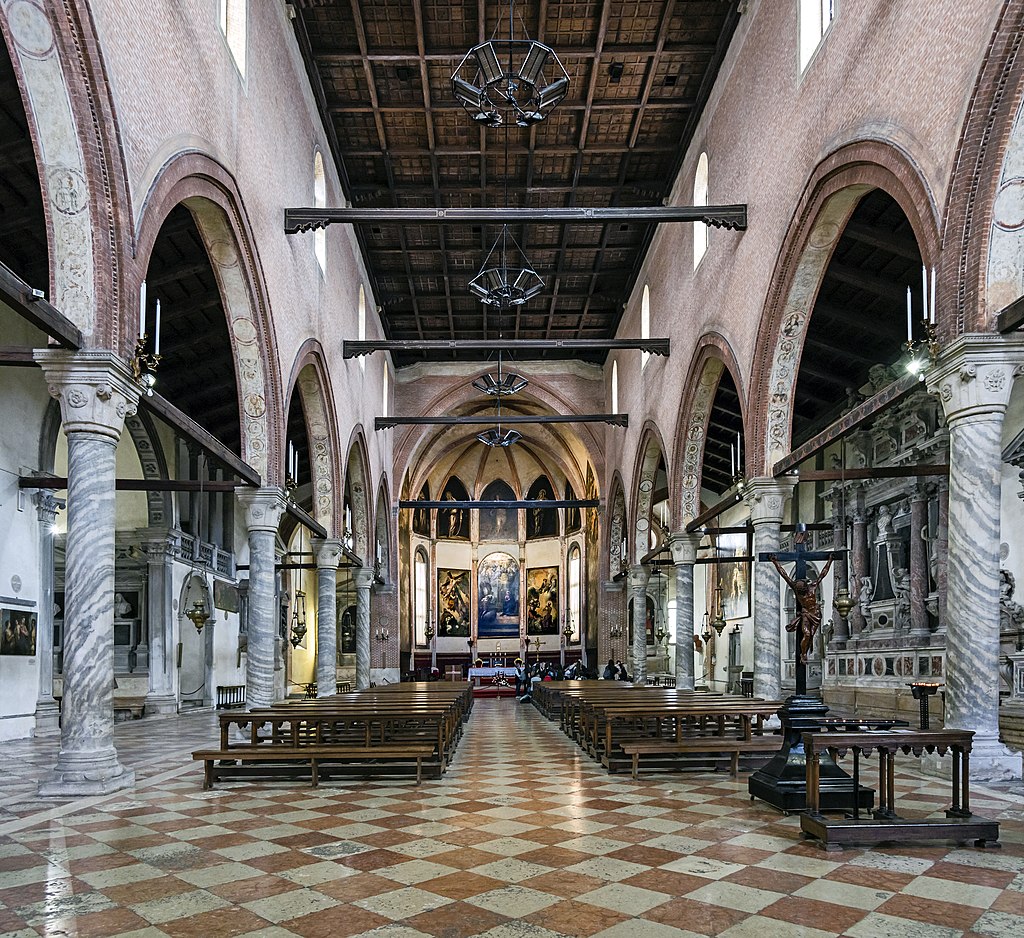
Jewish Quarter
From the Campo della Madonna dell’Orto head southwest along the Fondamenta Madona de l’Orto. Turn left onto Calle Loredan, where you’ll pass over a few little wooden bridges. When you arrive at Ponte del Forno, cross over onto the Calle del Forno. Turn right onto Fondamenta dei Ormesini and walk for a few minutes admiring the many different cafes and restaurants along this street beside the canal. When you spot the gorgeous iron bridge covered in swirling filagree, turn left onto Cl. Ghetto Vecchio into the heart of the Jewish Quarter. Hearing the words Jewish Ghetto , you might think we are entering an area built during WWII, but this ghetto had nothing to do with the Nazis. This neighbourhood actually area predates WWII by more than 400 years!
History of the Jewish Quarter in Venice
In 1509, a large portion of the Jewish community from Germany fled the mainland and moved to Venice. Venice had agreed to allow these Jewish refugees to live inside a small neighbourhood on the island of Cannaregio. But in that area alone. The area they were segregated inside was no bigger than an acre and contained hundreds of Jewish refugees. The old district had once been the location of the old copper foundries. The word ghetto was actually coined in Venice. In Italian, the word ghetto or ‘ get’ translates to ‘ foundry’ or ‘ foundries .’ But over time, the word became synonymous with an area where members of a minority group live, as was in the case of the original Jewish ghetto in Venice.
View this post on Instagram A post shared by @jewishvenice
Although Venice had given them a place to live, that didn’t mean their life was free and easy. Jewish Venetians were forced to make their living only by selling rags and running pawnshops. This was the only type of employment they were allowed to have at the time. The only exception was Jewish doctors and those with skills in the printing press industries. They worked on printing Hebrew texts and keeping their religion and culture alive in the Ghetto Ebraico or Jewish Ghetto .
Merchant of Venice
In the 16th century, Jewish citizens from Spain fleeing the Spanish inquisition also arrived in the ghetto. These Jewish Spaniards developed the narrative of the “ merchants of Venice .” They were skilled and sought-after traders and merchants. Soon, the Jewish quarter was the centre of foreign trade in Venice. This new industry brought in a substantial amount of money to the Serenissima, allowing them to stay in business despite previous restrictions on this kind of work in the quarter.
Although Venice allowed Jewish people to live and worship in this area, their lives were highly regulated and segregated. As early as the 16th century, Jewish citizens had to wear either yellow hats or yellow badges to distinguish them from Venetian Christians. The ghetto also had a strict curfew which the residents had to follow. Boats filled with members of the Serenissima would circle the canals at night to ensure no one broke curfew. The punishment for doing so was severe. To many residents, this area must have felt more like a prison than an escape from the persecution they had been trying to flee.
View this post on Instagram A post shared by Paola Scaccabarozzi (@paolascaccabarozzi_travel)
The First Vertical City
Despite these restrictions, the Jewish quarter’s population grew and flourished. More synagogues began to be constructed. But residential development was difficult. Since they were limited to this small island, their only chance for expansion was to go up vertically. The Jewish quarter in Venice was known to be the first real “vertical city.” Even today, walking around this part of Cannaerigio, you’ll see how much taller these buildings are compared to the rest of the city.
In 1797, Napoleon’s entry into Venice freed the Jewish people from their ghetto. Napoleon abolished these divisions. Jewish Venetians were finally free to buy property throughout the rest of the city. Since they were now some of the wealthiest citizens, they were able to buy up some of the most beautiful palazzos on the Grand Canal. Over the years, these Jewish citizens became as much a part of Venice as any other native Italian. Perhaps because they were such an important part of the fabric of Venetian society, their betrayal at the hands of Italian fascists later in WWII was so devastating. And almost led to their extinction.
View this post on Instagram A post shared by Guido (@guysebas)
World War II in Venice
Jewish people throughout Europe were rounded up and sent to concentration camps during WWII. But, thanks to the sacrifice of Giuseppe Jona , head of the Jewish Community in Venice, a large portion of Jewish Venetians managed to escape. When the Nazis demanded Jona make a list of Jewish people living in Venice, he agreed but used the time to warn his community. On the day he was told to deliver the list, he burnt the papers and took his own life, fearing he would be murdered for his actions. The Nazis were only able to find 243 Jewish Venetians who were deported. Only eight of them returned home.
Before WWII, Venice had a Jewish population of around 150,000. After the war, little more than 1,200 people returned to their homes. On one side of the Ghetto Nuovo square is a large bronze monument in honour of the victims of the Nazis. It was created in 1980 by artist Arbit Blata . The seven bronze panels depict several horrific tragedies Jewish people suffered during WWII. Today there are merely 450 Jewish Venetians left in Cannaregio. But they work hard to preserve and share their history with locals and visitors alike.
View this post on Instagram A post shared by 20 Regions in 2 Years (@20regionsin2years)
Scuola Spagnola
The Scuola Spagnola , or Great Spanish Synagogue , is one of the last remaining synagogues in modern Venice. The synagogue was built in 1555, founded by Jewish Venetians who had been expelled from the Iberian peninsula. The great synagogue was built by one of Venice’s most famous architects, Baldassare Longhena . He is also notable for designing other iconic Venetian buildings, such as; the church of the Madonna Della Salute, Ca’ Pesaro and Ca’ Rezzonico .
But the exterior of the synagogue isn’t anything like these other buildings. The facade is rather austere, with a plain, four-story cream-coloured finish. But it wasn’t for lack of inspiration, funding or skill that the exterior was so lacklustre. It was a condition of the Venetian state government in the 16th century. Although Jewish citizens were allowed to build their own places of worship, they needed to be concealed within a building that gave no appearance of being a house of worship. Essentially hiding their religion from the eyes of Christian Venetians.
View this post on Instagram A post shared by Jesús Ángel Carrasco Carmona (@jezucarras)
Inscribed upon the arch on the entrance of the building is a piece of script that reads, “ Blessed are they that dwell in Thy House and continue to praise Thee .” On the side of the building, there is also a stone plaque with the names of all the deported Jewish Venetian families who suffered death at the hands of the Nazis. Take a moment to pay respect as you pass by.
How to Visit a Synagogue?
Although tourists can’t enter the synagogue on their own (unless attending a service), I recommend booking a guided tour through the Jewish Museum of Venice if you are interested. They have a great connection with the local community, and you know this way you are supporting the preservation of their history through your contributions.
If you were to peek inside, you would be amazed at what you’d find. Stepping inside is like walking into a fantastical jewel box. Ornate carved wooden balustrade frames the ceiling in a variety of geometric shapes. Lavish red velvet curtains with golden tassels hand in front of the windows. Giant brass chandeliers drip from the ceiling and illuminate the rest of the room with warm candlelight. The highlight of the interior is the magestic sanctuary lamp known by its Hebrew name, Ner Tamid . The light inside this holy lamp symbolizes God’s eternal presence, which will never be extinguished.
View this post on Instagram A post shared by Axel Lapp (@axellapp)
Panificio Giovanni Volpe
Just down the street from the old Spanish Synagogue is Panificio Giovanni Volpe , one of Venice’s last remaining kosher bakeries. While visiting the Jewish quarter, it’s a good tourist practice to patronize their businesses. This is such an easy way to ensure their community continues to flourish. In this bakery, they still make many traditional Venetian desserts and also some unique Jewish recipes. Don’t be shy to ask what they recommend! Everything is delicious though.
View this post on Instagram A post shared by Panificio Volpe Giovanni (@panificiovolpe)
Guglie Bridge
To cross onto the next island of Santa Croce , we need to pass over the great Guglie Bridge . This crossing was established in 1285 with an early wooden bridge, but the current stone incarnation was built in 1580. The large balustrades which run over either side of the bridge are inlaid with gargoyles that watch over the canal. It is therefore dubbed the “ bridge of spies .”
View this post on Instagram A post shared by HAIR STYLE and MAKE UP VENICE ITALY (@luigimarchiori)
Chiesa di San Geremia
Standing in the centre of the Campo San Geremia is the church of the same name. The Church of San Geremia has stood here since the 13th century, and the old brickwork on the bell tower is some of the only remaining pieces of the original church. The rest of the edifice dates back to 1753.
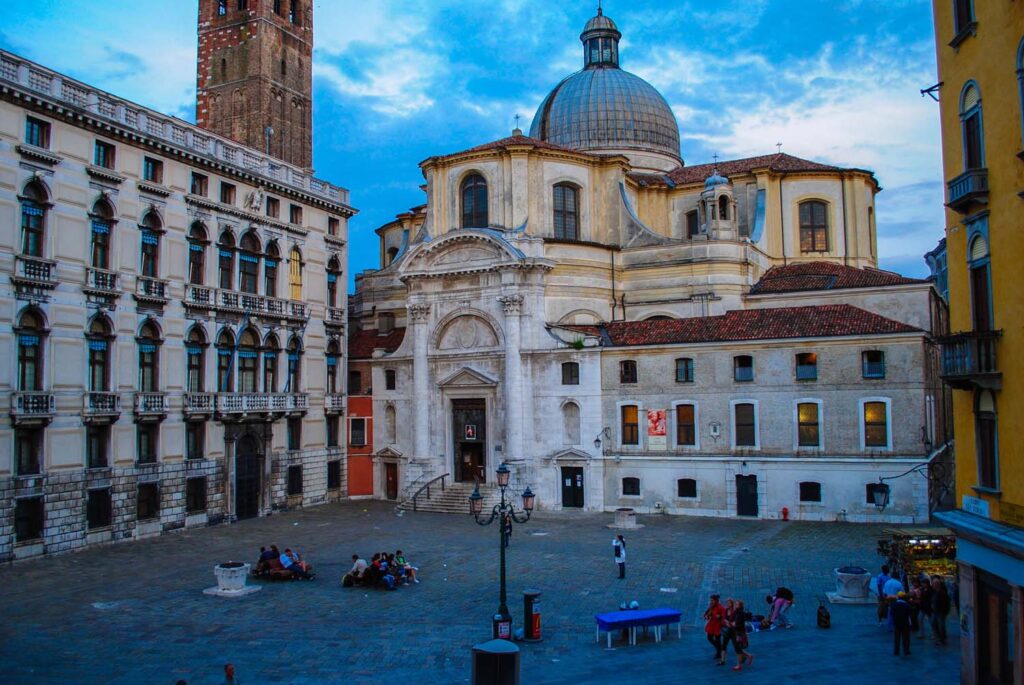
While the interior lacks any flashy ornamentation, this church is often seen as a pilgrimage sight because it carries the relics of Saint Lucy inside. Saint Lucy is the patron saint of eye illnesses. The story goes that she had devoted her virginity to God and would not marry. To make herself less desirable, she tore out her own eyes. When she was buried in the family mausoleum, they discovered her eyes had been miraculously restored, a sign of her martydom. She is seen frequently in paintings holding a golden plate with a pair of eyes laid upon it. Many people make a pilgrimage to this sight to pray for their own eye related illnesses.
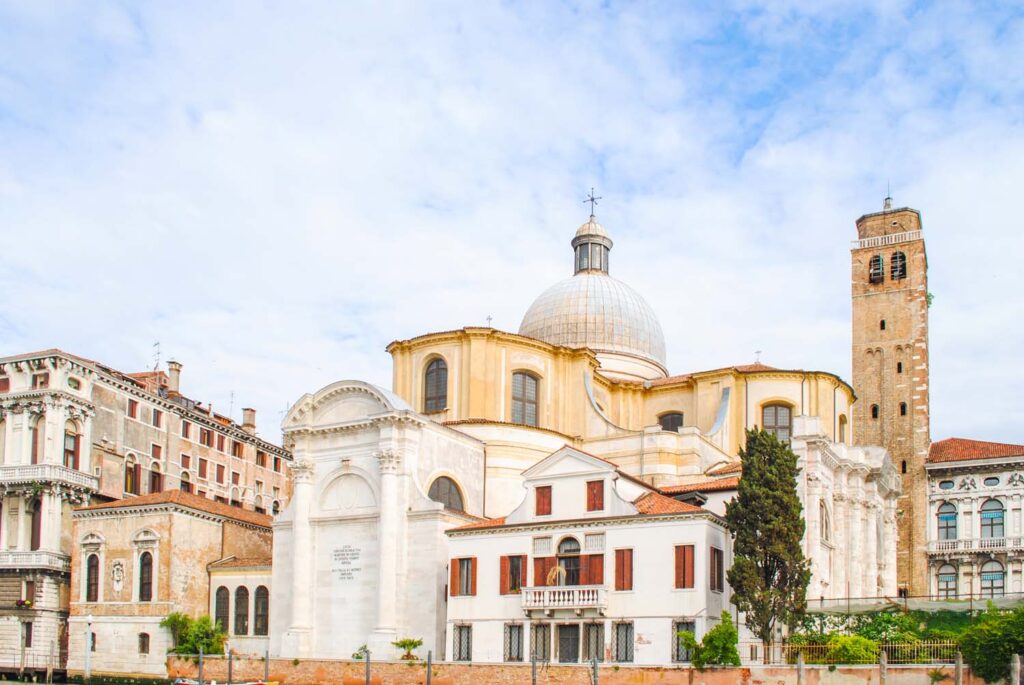
Pasticceria Dal Mas
You’ll find my favourite bakery on the charming Rio Terà Lista di Spagna street. The Pasticceria Dal Mas has some of the best cream-filled pastries in town! Their bright green pistachio cannolis are a dream. There are a few seats inside where you can sit and order an espresso or even an Aperol spritz to enjoy with your food. If you’d rather just stand at the counter and chat, you can also do that; how very Italian of you.
View this post on Instagram A post shared by Erica Eckman (@everythingerica)
Scalzi Bridge
You’ll come upon the Scalzi Bridge at the end of this street before reaching the train station. The Scalzi Bridge means “ bridge of the barefoot monks ” in Italian. The first bridge to be built here was right beside the old Carmelite order, also known as the “order of the barefoot monks.” But this current incarnation of the bridge is one of the city’s newest, completed in 1934. While the bridge isn’t as remarkable as some others, its modernity allows it to feel light and airy, almost defying the laws of gravity.
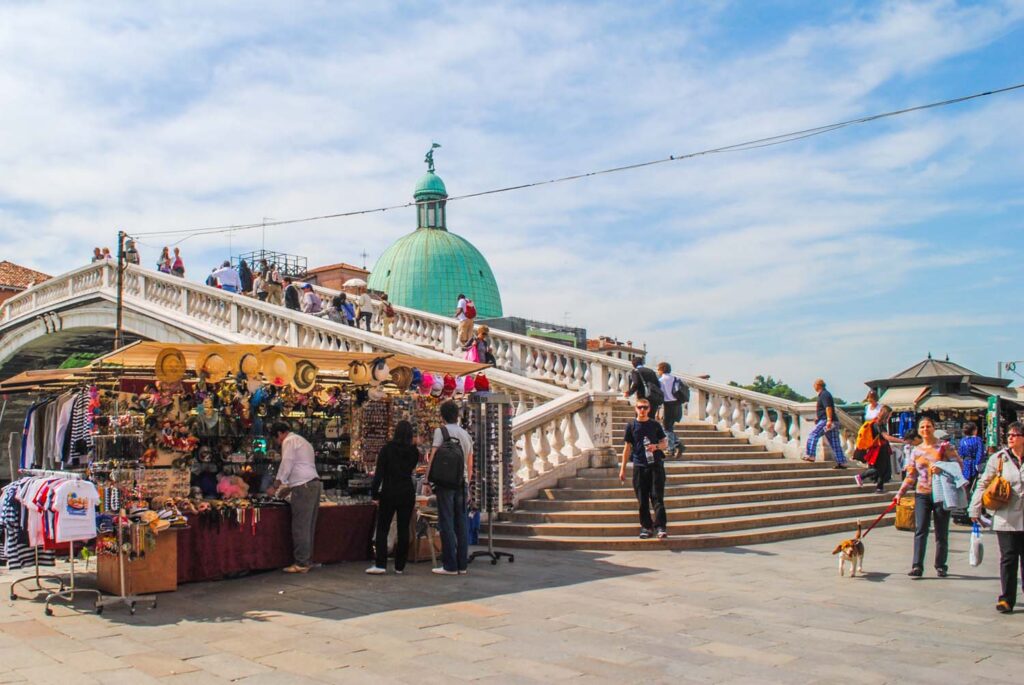
Santa Croce
Walking over the bridge, we are moving into the Santa Croce district. Santa Croce is where you’ll find the large train station, which brings people in and out of Venice every day. Leading to this neighbourhood being referred to as the city’s “transport hub.” Being located away from the top attractions, you’ll also find that Santa Croce has the least amount of tourists. This may be one of the reasons I find it the most pleasant to walk around. The people you’ll find on the street are locals, and there is an honest air about this neighbourhood.
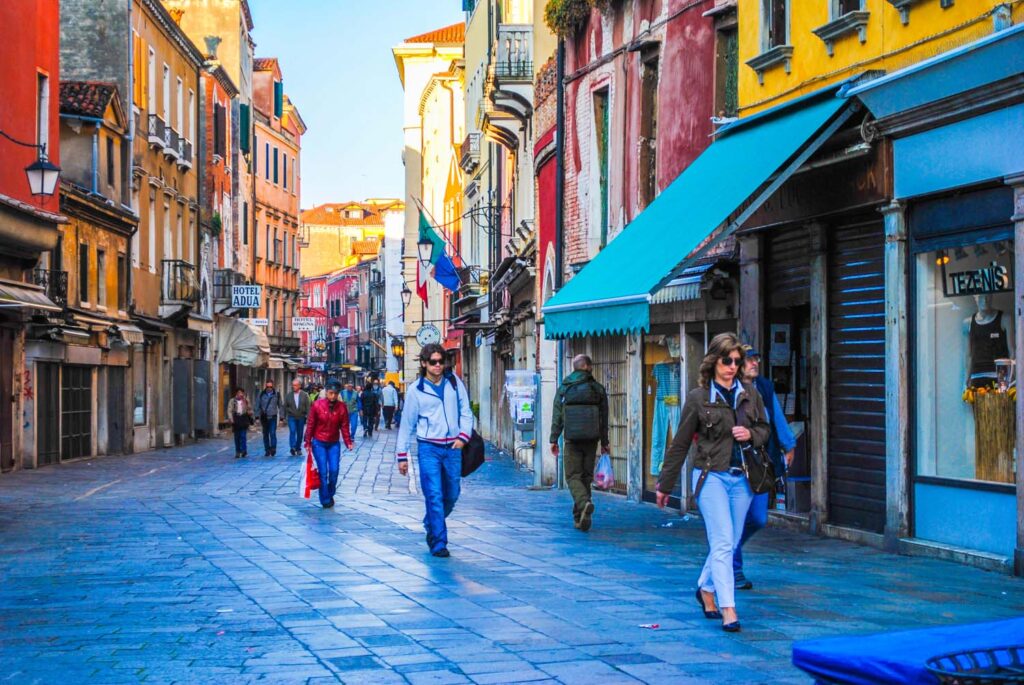
Crossing over the bridge, walk southwest on the Fondamenta del Monastero to tread along water’s edge. This area of the Grand Canal is bustling with action. You’ll find more than just gondolas and vaporettos here. Motorboats carrying fruits and vegetables chug up and down the water, and boats piled with wooden beams and other construction equipment jet over to their various destinations.
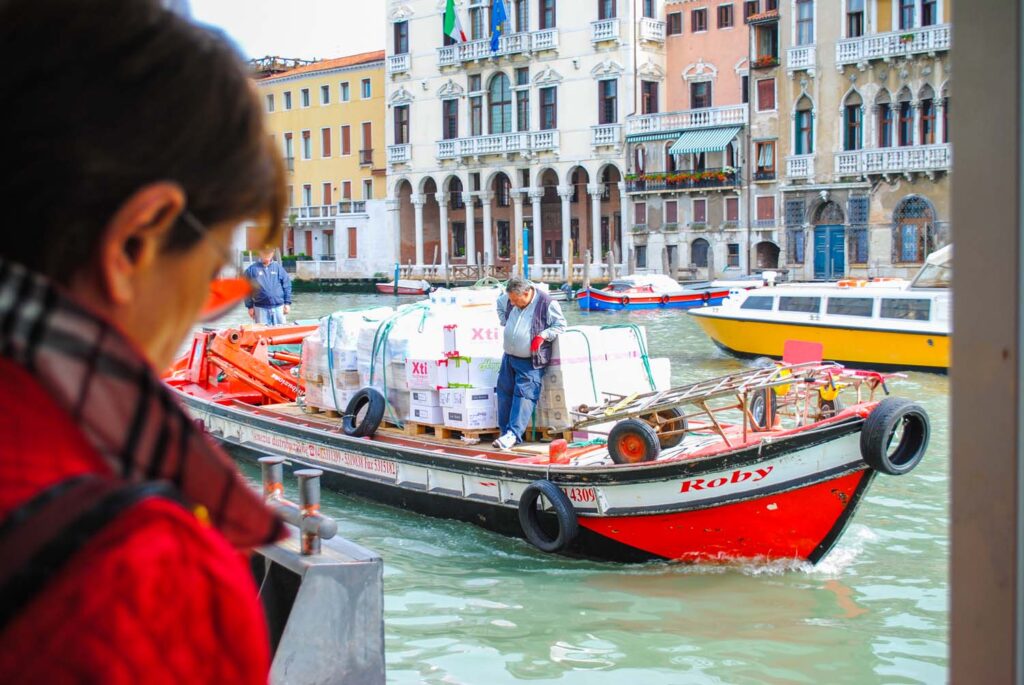
Giardini Papadopoli
Turn left down Fondamenta Papadopoli where you’ll quickly see the bright green trees sticking their heads above a brick wall. This is the Giardino Papadopoli , a beautifully manicured garden where locals Venetians come to get some shade and enjoy a bit of green space. The park spans more than 8,800 square meters and was built in 1834. While Venice has ample squares and waterways, there is surprisingly little greenery and lush parkland. The Giardino Papadopoli is Venice’s version of Central Park .
Among the gravel and stone paths are a variety of different trees like cypress, cedar, different fruits, elm, oleander, mulberries, and laurel. If you are even looking for someplace to come to escape the crowds and the noise, this is the oasis you’ve been looking for!
View this post on Instagram A post shared by Loredana Rossi (@lori_lo68)
Campo San Rocco
Walking through the park, exit at the south end, and cross the bridge over to the Calle dei Amai. Walking along the Calle dei Amai (which turns into the Calle de le Sechere) and turn right onto Ramo Cimesin. Ramo Cimesin veers slightly right and becomes Calle Tintoretto, and passes through Campo San Rocco.
Campo San Rocco is a charming square whose centrepiece is the church of San Rocco, an impressive Renaissance structure adorned with intricate marble carvings and frescoes. The surrounding buildings feature colourful facades and elegant balconies, creating a picturesque backdrop for a leisurely stroll or a cup of coffee at one of the outdoor cafes.
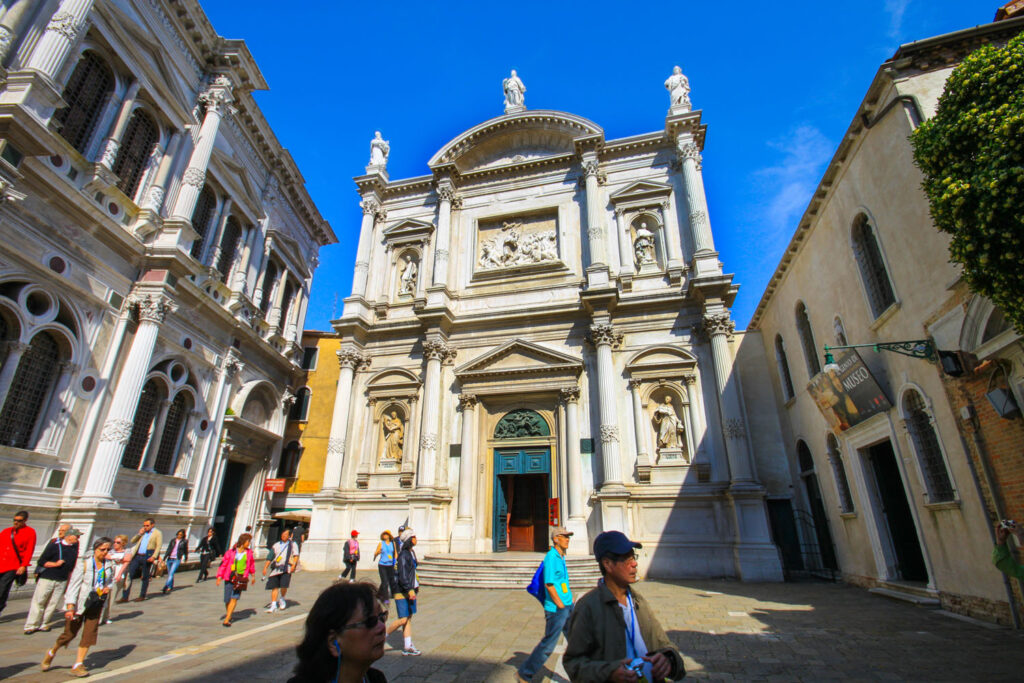
Basilica dei Frari
From the Campo San Rocco, walk toward Calle Fianco de la Scuola and continue onto Salizada S. Rocco. Turn left onto Campo dei Frari, where you are immediately struck by the towering Basilica dei Frari or Santa Maria Gloriosa dei Frari . But most people just call it the “ Frari ” for short. The church is the beating heart of this neighbourhood. In 1231 the Doge Jacopo Tiepolo donated this land to the Franciscans. The original church he had built was very small. As the Franciscans rose to power, they demolished it in exchange for a larger, more impressive design that better reflected their status in the city. The current version we see today was built in the 14th century in a high Venetian Gothic style.
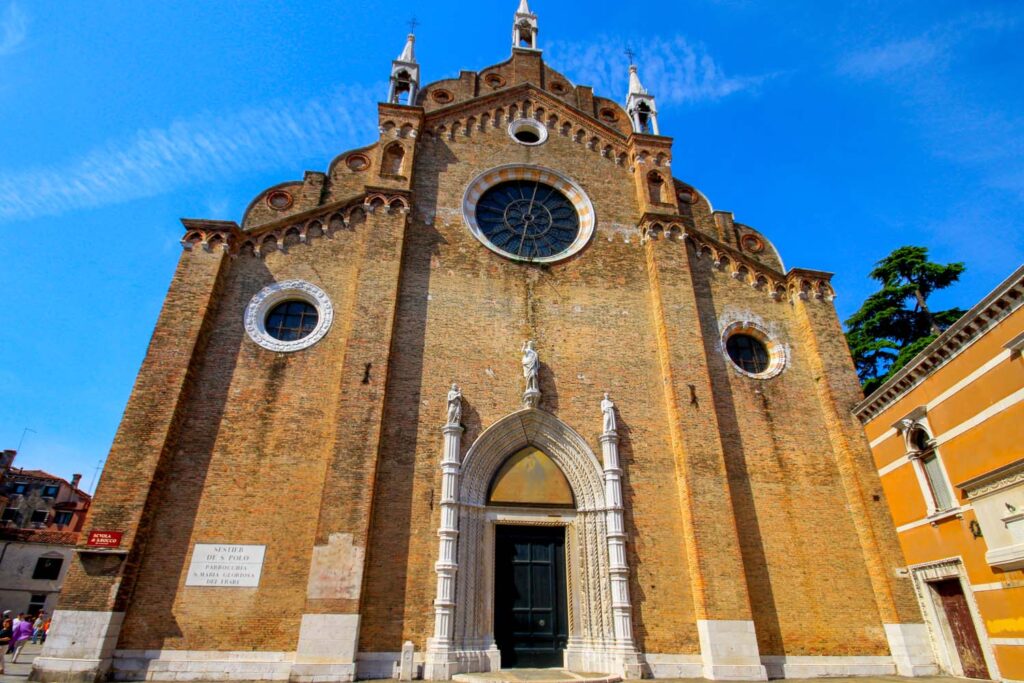
Looming over church is the great campanile, the second tallest tower in the city. The bell tower was built in 1396 and somehow still stands today! The unassuming facade might fool you into thinking at first blush this church isn’t very important. But in actuality, it is perhaps one of the most significant churches in the entire city.
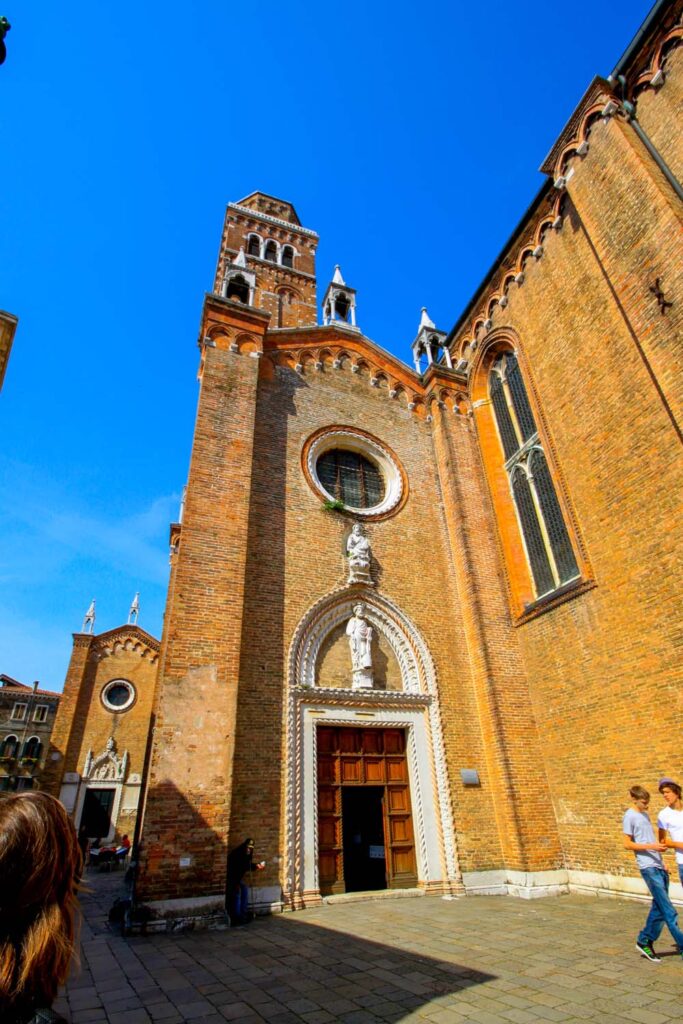
Entry into the Church
There is a small fee to enter the church (€ 3,00), but it is more than worth it to gaze upon the interior of this church and the famous works of art found inside.
Many Doges were buried here under the watchful eye of masterful works of art by the painter Titian . Titian, a Venetian himself, painted the great altarpiece inside the church. The Assumption of the Virgin by Titian is one of the first things your eye is drawn toward as you enter the church. It sits behind the high altar, lit by the glow of the stained glass windows behind it. This piece is perhaps the best example of Titan’s masterful work. Setting the standard for Venetian art during the Renaissance.
View this post on Instagram A post shared by @rebecca.photo.cese
Titian died of the plague at 94 years old, and a memorial to his life and death stands inside the great Basilica. The monument is gigantic! Looking like a small structure rather than a statue. A version of his famous painting is carved in relief into the stone. The image of the great master himself sitting in front. On either side of the artist are two figures representing universal nature and the genius of knowledge . The other four figures set in between the large columns represent Painting, Sculpture, Graphic Art and Architecture, each one being a critical force possessed by Titian’s art.
View this post on Instagram A post shared by Luca Brussato (@luca_brussato)
Campo Santa Margherita
From the church, head south through the Campo dei Frari. Turn right along Salizada San Rocco and left onto Calle S. Rocco. Cross over the Sestiere Dorsoduro and continue south down Calle S. Pantalon as it passes over the bridge, and the street turns into the Sestiere Dorsoduro. Leading you right in the Campo Santa Margherita.
The Campo Santa Margherita is a huge square in Dorsoduro District . Surrounding this square are houses that date back to the 14th and 15th centuries. Cafes have a tremendous amount of outdoor space in this large square, so you’ll hear the murmur of people laughing and the clinking of wine glasses at all hours of the day. Lovers lounge on the bright red benches, kissing under the sunlight. If you’re tired, this is a great place to end the tour early if you don’t want to explore the rest of the Dorsoduro District.
View this post on Instagram A post shared by Clairethefrenchbooklover (@clairethefrenchbooklover)
Dorsoduro District
The Dorsoduro district is located on the bottom of the Venetian islands. This area borders the Grand Canal and the Venetian Lagoon, making it a prime spot for traders to live. While it’s not as flashy as the other districts, think of this as a blue-collar neighbourhood. I still find it to be one of the most charming areas in Venice. Dorsoduro lacks the pretensions of the other spots. Since it’s home to Venice’s Ca’ Foscari University , you’ll also find the new blood of Venetian society, its students, who liven up the streets with modern music, food and entertainment.
View this post on Instagram A post shared by Francesca (@francescanr_)
Ponte dei Pugni
Head to the southern end of the Campo Santa Margherita and make a sharp left onto the Rio Terà Canal. Turn right to stay on Rio Terà Canal until you reach the Ponte dei Pugni . I love the view from this bridge. If you look towards the west, you can see the brick bell tower from the church of Santa Maria del Carmelo sticking its head up above the other buildings.
On either side of the bridge are a pair of footsteps marked onto the stones. This marking reveals a strange practice from the 18th century. Whenever two rival families were feuding, they would come here to battle it out with their fists. Unlike gun duals in the United States which were common to settle violent disputes, Venetians would fight each other with their fists. The first one to fall into the canal off this bridge was deemed the loser.
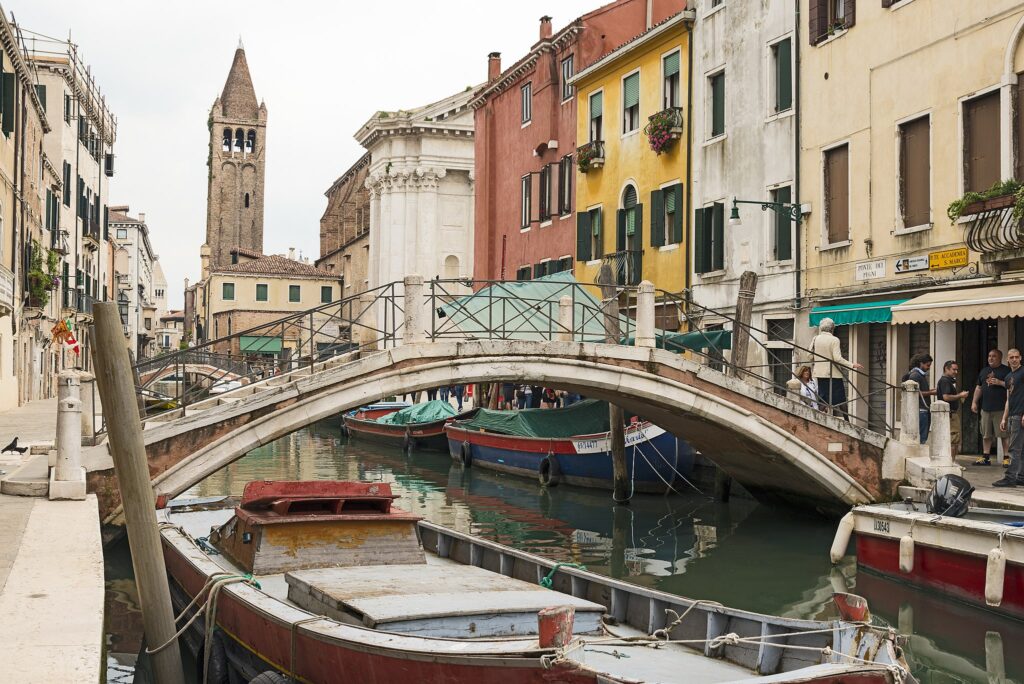
Cantine del Vino già Schiavi
We are approaching the evening by this time, but it’s not time for just yet dinner. Oh no, first we must have an aperitif ! And one of the best places to get it in Dorsoduro is Cantine del Vino già Schiavi . This bar sells Cicchetti (small snacks), which include Venetian classics like crostini topped with salt cod and wild garlic, pistachio cream or aioli with flower petals. Grab an Aperol spritz to drink while standing at the bar to feel very much like a local.
View this post on Instagram A post shared by Cantine del Vino già Schiavi (@cantinaschiavi)
Calle Nuova Sant’Agnese
Head northeast until you reach the Calle Nuova Sant’Agnese . This narrow street is filled with a variety of different shops. Being so far away from the touristy areas, these stores are known to sell authentic Venetian goods but at reasonable prices . In addition to the tourist shops, you’ll also find unique boutiques, which are a great way to support local businesses.
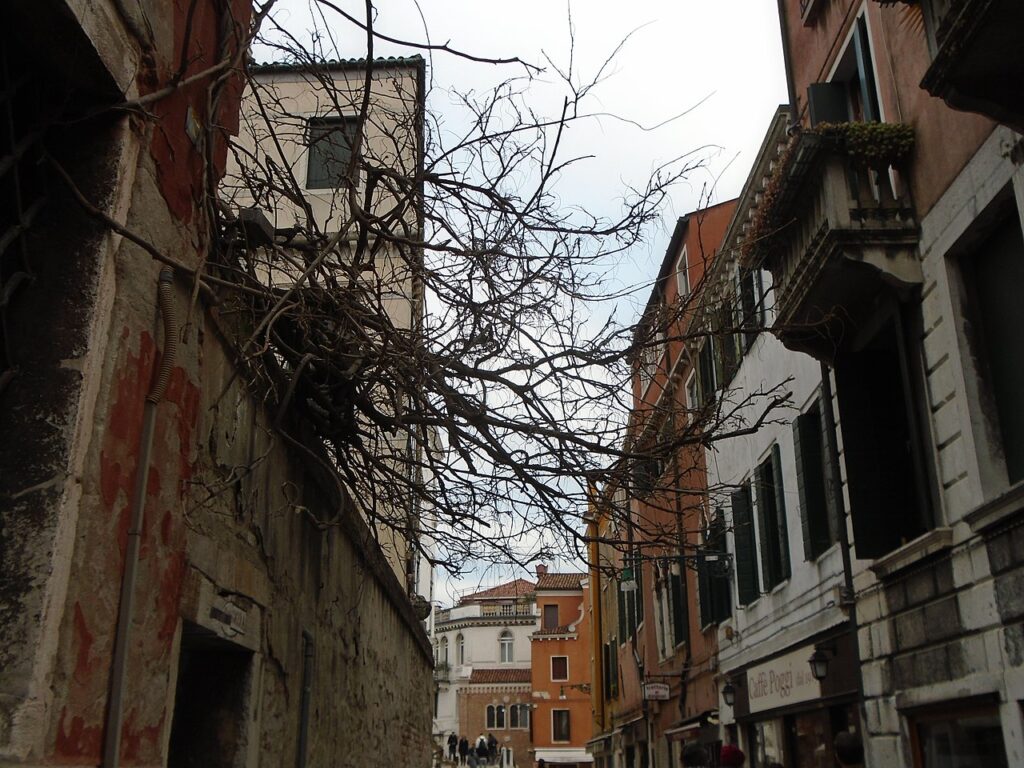
Basilica di Santa Maria Della Salute
If you’re still feeling up for it, continue walking through Dorsoduro, eastwards, along the Calle Nuova Sant’Agnese (which turns into Piscina Forner.) Continue onto Calle de la Chiesa and make a slight left onto Fondamenta Venier dai Leon walking along as it becomes Fondamenta Venier dai Leon. Turns left along Dorsoduro Street and follow the street into the Campiello Barbaro. Walk east along the Calle Barbaro as it becomes Calle San Gregorio and veer onto Calle de l’Abazia.
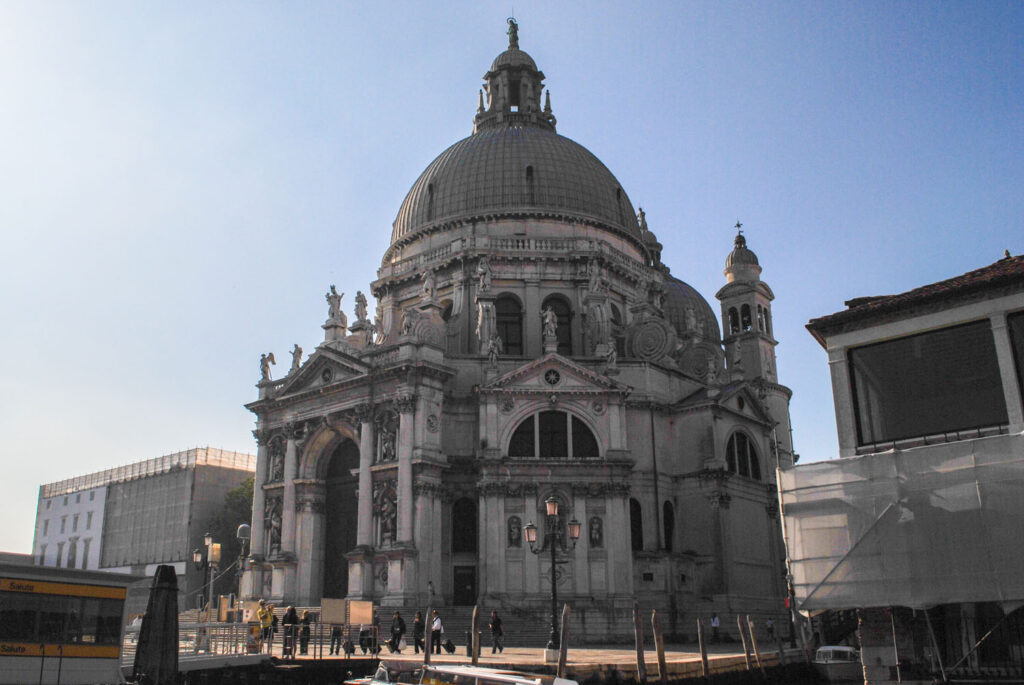
Stepping onto the stone of the Fondamenta Salute, you find yourself standing in front of the stunning white marble church of Basilica di Santa Maria Della Salute. Take a moment to both soak in the view of the church but also turn around to look at the great view of Saint Mark’s square across the river. This is where we first started the tour, and it’s amazing to see this spot from another perspective.
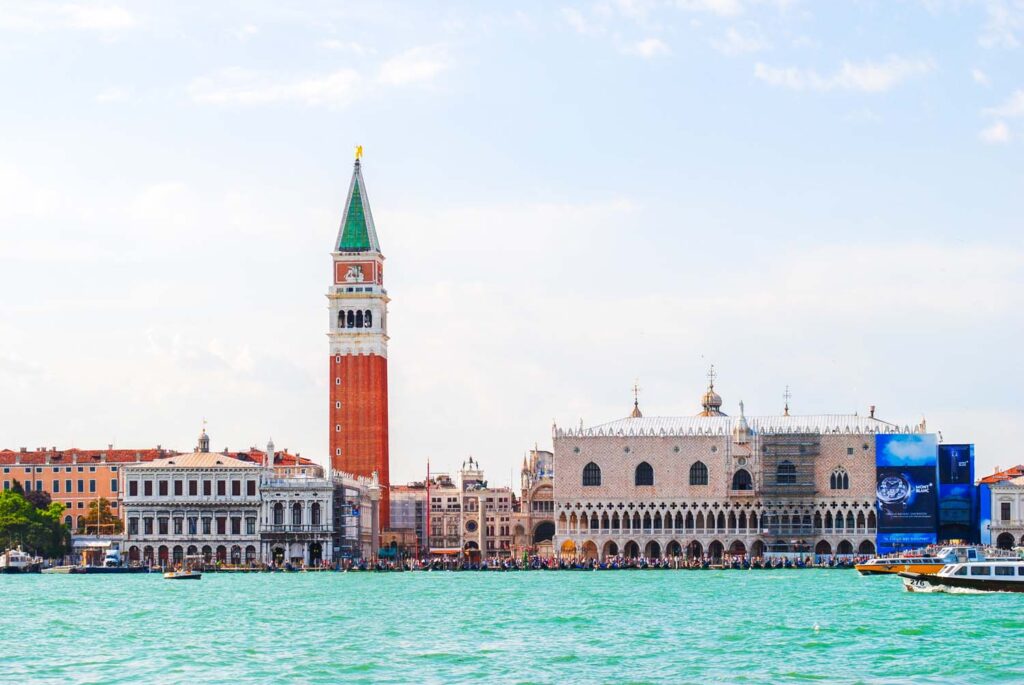
The Venetian Plague
In 1630 Venice was being ravaged by the plague. At the time, one of the ways people thought you could stop the plague was by making an offering to God and praying he would send deliverance to the city. So, the Republic of Venice built the church of Our Lady of Health as a last resort . Eventually, the plague period passed, and the city was able to start rebuilding itself. Nearly a third of the population of Venice died during the plague. Those that survived would remember that harrowing experience forever. Since the church was made in honour of stopping the plague, most of the art and symbolism you’ll find throughout the church in some way refers to death or the plague. Making it a very uniquely themed church.
The church is most notable for its humongous white dome, which dominates the sky. The dome, which almost seems to defy gravity, became a symbol of inspiration for artists in the city. To support the huge dome and weighty marble church, 1 million wooden piles were used to hold up the floating building.
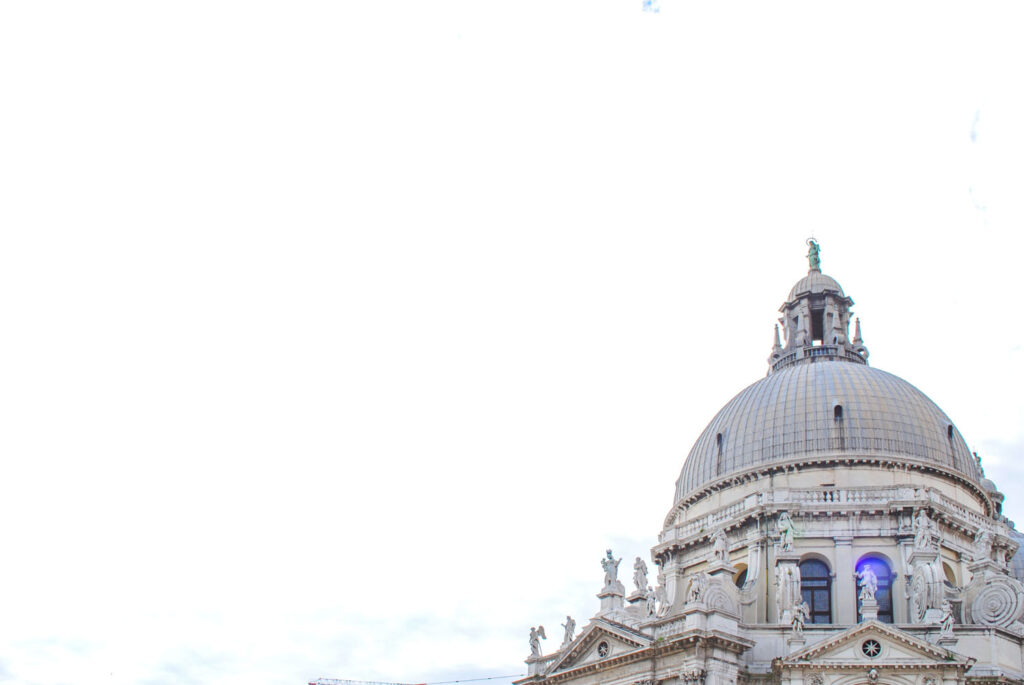
To finish the evening, walk down south towards the island’s far edge. The stone promenade which flanks the large waterway is called the Zattere . Zattere in Italian means rafts . In the 16th century, timber would arrive in the city on large rafts. Timber was not only used to construct the walls of grand palazzos and houses in Venice; it was literally the ground on which the houses were built. Timber was one of the most important imports in the city. It was also used to make gondolas up until the 18th century. Suffice it to say, the city was built around the timber industry, so its importance is not to be ignored. The earliest parts of the Zattere date as far back as 1520. Today the wide promenade is a great place to watch the sunset, reflection down against the mirror like waters of the canals.
View this post on Instagram A post shared by Giulia Zoppelli (@giulietta.z)
Trattoria San Basilio
If you’re feeling like you would like to dine somewhere close to your accommodation, there are Vaporetto stops all along the Fondamenta Zattere . But if you’re looking for something special along the water’s edge but away from the touristy hub, you should check out Trattoria San Basilio .
This down-to-earth restaurant is located inside the corner of one of the older buildings in the Zattere. It barely looks like a restaurant except for the awning and a few tables and chairs out front. But don’t let its modesty fool you; here, you’ll find a relaxing atmosphere, friendly staff, and traditional Venetian cuisine. Their seafood spaghetti with mussels, clams and squid tastes so fresh you’d swear the food jumped right onto your plate straight from the water. Try to get a spot outside to enjoy the sunset or watch as gondolas paddle past into the moonlight.
View this post on Instagram A post shared by Bettina Holstein (@bettinaholstein)
Phew, well, that brings us to the end of this tour. Hopefully, if you packed this all into one day, you found things along the way to return to see tomorrow! Let me know which neighbourhood was your favourite or what you’re most looking forward to visiting!
Happy Travels, Adventurers!
Buy the downloadable pdf for this walking tour.
With our downloadable PDF guide, you can take the tour at your own pace, without worrying about schedules or large tour groups. Plus, you can download the PDF to your phone or tablet to use even while offline.
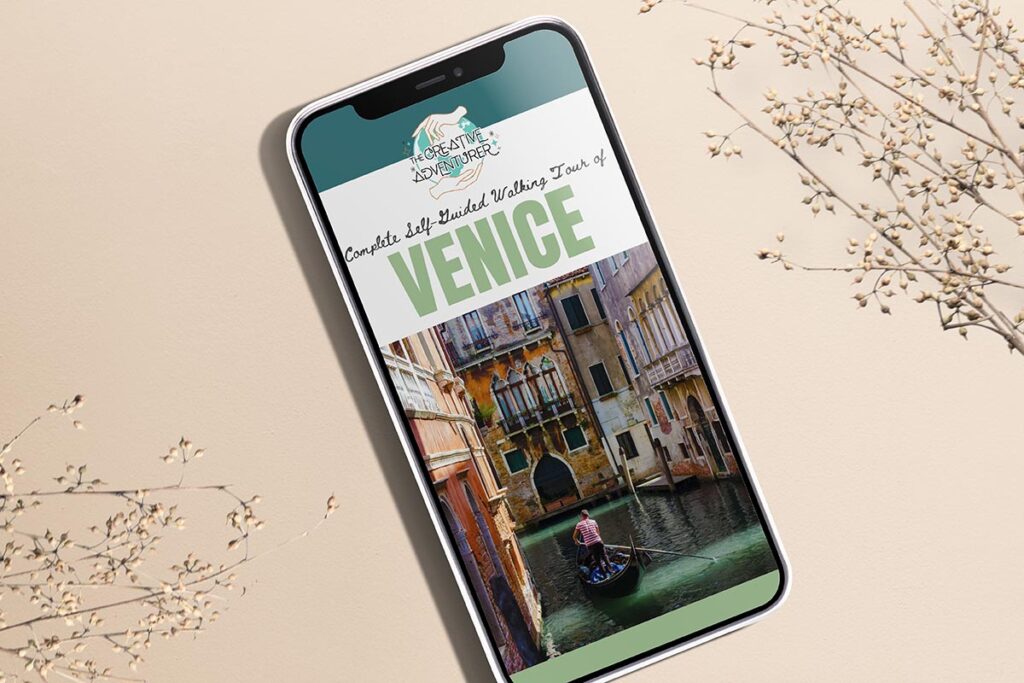
Happy Travels Adventurers!

« The Ultimate Guide to Exploring Teotihuacán, the Wonderous Pyramid of the Sun | Updated 2023
Ultimate self-guided murano island walking tour [updated 2022] », you may also like.
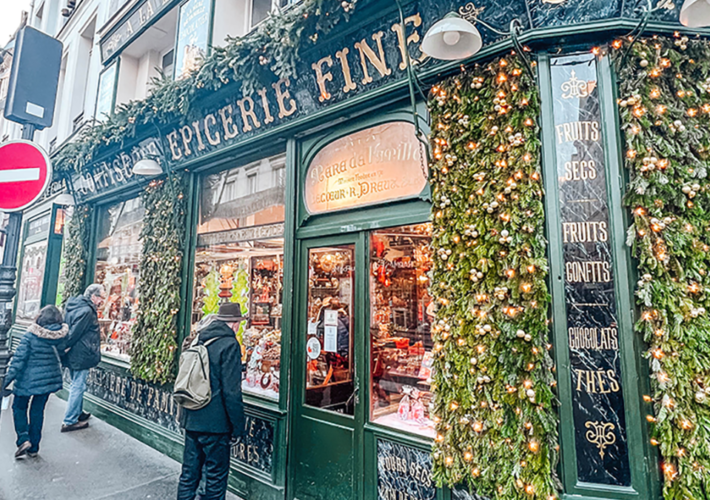
The Best 11 Historical Shops from All Over the World
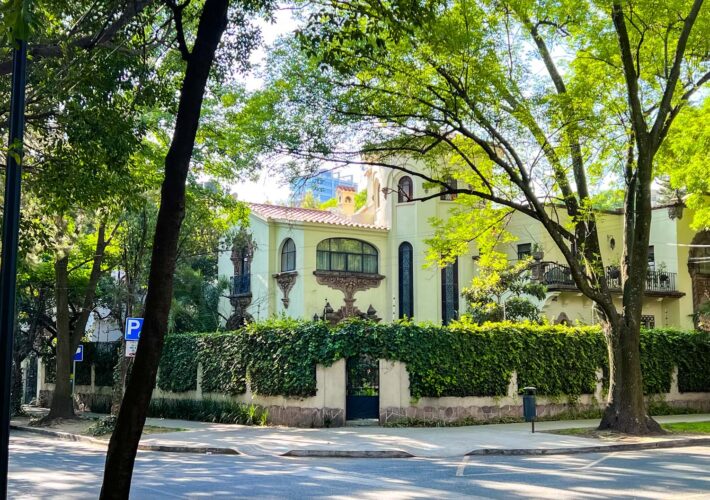
Self Guided Walking Tour of the Upscale Streets of Polanco: The City’s Most Exclusive Neighborhood
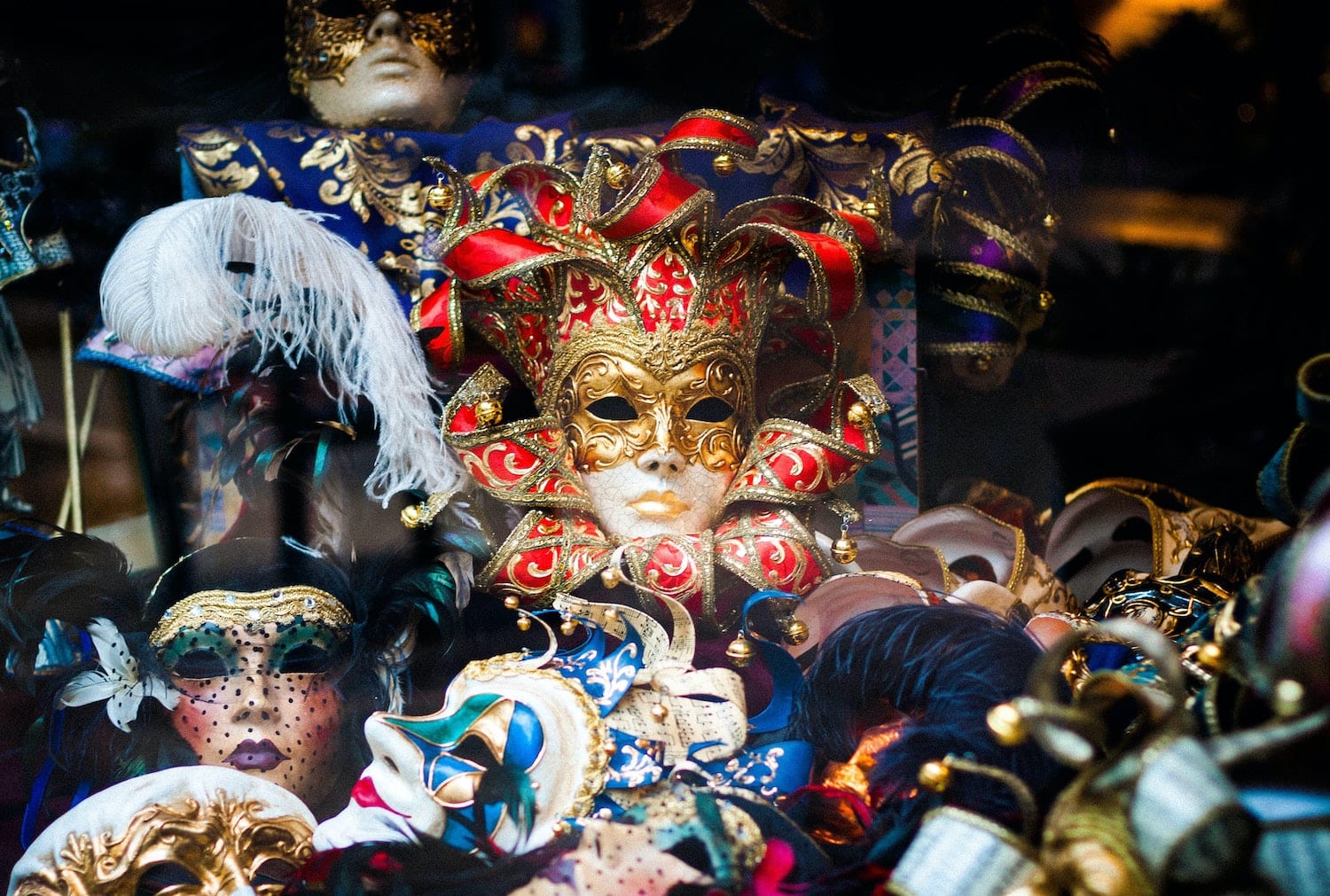
The Complete Guide to Venetian Carnival Masks
12 comments.
My wife and I took this walking tour just last week – June 2022. It was fantastic! We spread it out over two days as we stopped at lots of places to shop, east, and in 2022 there are lots of free art exhibits. Add a night tour of the Palace and the basilica and you will have a great trip!
laura.f.whelan
Thanks for the comment Phil, I’m so happy you and your wife enjoyed yourself on the walking tour. Two days is the perfect leisurely way to spread it out and make your own stops along the way. I’ve never known they had a night tour of the palace and Basilica but I looked it up and it looks incredible! What a special way to spend an evening in Venice!
Hello Laura, thanks so much for putting together these amazing walking tours! I’m heading to Italy next week and would love to do your Venice tour. However, wondering if it is possible to download it into my phone to follow it while I’m in Venice. Do you know if that is possible?
Thanks in advance, Juliana
The Creative Adventurer
Hi Juliana, I’m still working on the downloadable version of this walking tour! But you can always copy and paste the text to you notes app in your phone and download the google map I provided. Google has an offline map option you can download before you leave if you won’t have roaming while you’re in Italy. Hope this helps 🙂
Hi Laura Thank you so much for sharing this wonderful walking tour of Venice. My husband and I are going in April and as the previous commentator wondered if you had managed to complete a downloadable version yet? I am not very techy so not sure I could manage to copy and paste! My thanks in anticipation , Judi
Hi Judy! We finally have the downloadable version of the walking tour available in our store! You can purchase the PDF here to get all the information in this post and more available on your phone, iPad or desktop even when offline!
https://thecreativeadventurer.com/product/self-guided-walking-tour-of-venice-downloadable-pdf/
I hope you have a fantastic time on your vacation to Venice.
All the best, Laura (the Creative Adventurer)
Hi Juliana,
I am going to Venice next year and am so excited to do this walk. The effort and detail you put into this is incredible. What a wonderful person you are to share this. So appreciate. Can’t wait to discover this walk.
Thanks so much Nicole! I hope you have a fantastic time, Venice is spectacular and a true dream of a location.
Amazing, very well done! Anyone that wants to get of feel of venice should read and walk this. You should really make a documentary…..getting to know venice. thank you
Wow! Thanks for the amazing comment Jim!
I purchased the PDF on my computer but trying to figure out how to now open/save it on my phone. There wasn’t a follow up sent to my email with a link or anything. Please let me know how to obtain it, thanks!
Hi Tommy, I just sent you an email but you should receive an email shortly after payment with the link to the download. If you don’t get one shortly just reply to the email I sent and I will email it to you directly.
Leave a Comment Cancel reply
Your email address will not be published. Required fields are marked *
Copyright @ 2023 The Creative Adventurer | All Rights Reserved | Privacy Policy
World Wanderista
Magic happens when the adventure begins
Italy , One Day in , Travel Guide , Venice · September 5, 2020
One day in Venice: places you must see | Walking map
If you want to spend one day in Venice and don’t want to miss out on places you must see, then this is the perfect one day Venice itinerary for you! This wonderful unique city is the perfect place to get magically lost with its labyrinth of canals and narrow streets. But if you’re only here for a day, it’s not the best way to spend your time, because you’ll probably miss out on many things. I created this one day itinerary leading you to many beautiful photo spots and the highlights you don’t want to miss! Now let’s go!
This walk is about 9 km. How long it will take you depends on how fast you walk and how much time you need to take photos. It can be done in half a day!
One day in Venice: walking itinerary
San marco area.

You start this one day in Venice walk at the Piazza San Marco , the most famous place in Venice. It’s dominated by the Basilica di San Marco and surrounded by the Campanile, Palazzi and the Torre dell’Orologio (the Clock Tower). Take your time to explore it and then continue to the Piazzetta where you can admire the Palazzo Ducale (Doges Palace).

From there walk to the Canale di San Marco and turn left to the Ponte della Paglia that offers a view of the Ponte Sospiri (Bridge of Sighs). Then continue and turn left at the Calle de le Rasse. At the end turn left to the Campiello Sant Filippo e Giacomo and cross the square to take the Rughetta S. Apollonia. From the bridge you’ll get another view of the Ponte Sospiri. Cross the bridge, turn right and go left taking the the Calle Canonica to reach Piazza San Marco again. Walk through the gate of the clock tower taking the Merceria Orologio and go right at the Campo San Zulian, passing the church, taking the Calle al Ponte de la Guerra. Cross the Ponte de la Guerra and continue via the Calle Bande Castello, again cross the bridge and keep left to reach the Campo S. Maria Formosa . This is a nice square with some beautiful sights.
Castello Area

After wandering around the square take the Calle Lunga S Maria Formosa. In this street you’ll encounter the old book store Libreria Acqua Alta, which you should definitely visit! At the end of the street turn left and cross the Rio della Tetta. Then don’t cross the next bridge but turn right into the Fonamenta Laterano. Then turn right again at the Calle S. Giovanni Laterano and follow along the canal until you reach the beautiful Ponte Cappello .

Then turn left into the Calle Bianca Cappello, cross the bridge into the Calle Muazzo and at the end at Barbaria de le Tole turn left. Then continue to the square and turn left into the Corte Veniera (Calle Vesier). At the end you will reach the Ponte dei Conzafelzi which offers a nice view on a corner house that is surrounded by 2 canals.

Return to the Campo Santi Giovanni e Paolo . This beautiful square has a nice basilica and lays by the water. Cross the bridge to the Calle Larga Giacinto Gallina. Continue until the Campo Santa Maria Nova. Take in the view of the canals and the Santa Maria dei Miracoli church.
Cross the bridge and walk around the church. Cross the bridge on the other side of the church to reach the Calle Miracoli. At the end of the street turn left (Salizada S. Canzian). Follow until the T-crossing and go left, crossing the bridge to follow the Salizada S Giovanni Grisostono.

Cross the bridge and continue your way via the Salizada del Fontego dei Tedeschi until you reach the Campo S Bartolomio. Turn right and continue until you reach the Ponte di Rialto .
San Polo Area

Cross it and check out the Riva del Vin watching the boats and gondolas passing by. Continue by taking the Ruga dei Oresi, Ruga dei Spezieri and arrive at the Campo Beccarie. Cross the bridge in the west corner of the square and continue to the Calle dei Botteri. Turn left and continue until the end and turn right into the small alley, you reach a small square with a sign “Carampane”. Then take the other small alley in the left corner and continue passing the Sotoportego Carampane until you reach the Rio Tera de le Carampane. Turn right and continue to cross the Ponte delle Tette and take the Calle Agnello/Calle de l’Agnella. Continue by crossing the bridge and taking the Calle de Ca’ Bonvicini. Turn left at the end to the Calle Seconda del Cristo and arrive at the Ponte del Forner which offers a nice view on the canals.

Cross the bridge and turn right at the C.D. Scaleter. Go left at the Rio Terra Secondo and continue to the Calle Chiesa. Cross the left bridge and turn left following the Calle Dona Castello/Calle de Ca’ Dona until you arrive at the Campo San Stin. Turn left to the rio do San Stin and cross the Ponte S Stin. Continue to get a nice view of the Basilica Santa Maria Gloriosa dei Frari . Cross the other bridge to the Campo dei Frari. Turn right at the Salizada S Rocco. Continue to the Calle Tintoretto to reach the Campo S Rocco. Keep following the street till the cross road and take the Calle de Castelforte S Rocco to the left. You arrive at a square Campo de CastelForte with stunning views.
Dorsoduro Area
Continue your way under the white arches of the Scuola Grande di San Rocco. Cross the bridge on your right and follow the Calle della Scuola. Turn left at the Calle Grosera and right at the Calle S Pantalon. Follow it until the Campo San Pantalon, cross the left bridge (Ponte Santa Margherita) to the Calle de la Chiesa (Sestiere Dorsoduro) and continue to the Campo S Margherita.
Walk to the other side of the square of the massive square and take the street on the left side. Try a gelato at Il Doge and follow the street at its left side (Rio Terra Canal). Cross the Ponte dei Pugni and follow to the left until you reach the Campo San Barnaba. Continue via Calle Lotto/Calle Lombardo (Sotoportego del Casin dei Nobili), cross the bridge and follow Fondamenta Toletta to the Sacca della Toletta and the Calle Toletta until you can cross a bridge (Ponte de le Maravegie) again. Then turn left and take the Calle Contarini Corfu and follow it to the right side to Campo della Carita (you’ll pass the Accademia bridge here, but you don’t take it yet).

Keep going straight ahead to the Rio Terra Foscarini and turn left at the Calle Sant’Agnese. Cross the bridge to the Calle Chiesa. Continue via the Fondamenta Venier dai Leoni and keep following it left until you reach Campiello Barbaro. Keep left and take the Calle Barbaro/Calle del Bastion, cross the bridge, continue straight ahead following the Calle del Bastion, cross another bridge and and arrive at Fondamenta Salute with the Basilica di Santa Maria delle Salute and Punta Dogana .

Then return until you reach the Accademia bridge again and cross it. Don’t forget to take in the view of the Grand Canal. It’s sublime! Go straight ahead until you reach Campo Santo Stefano . Cross it and take the opposite street Calle Frati Dorsoduro to reach the Campo Sant’Anzolo. Take Calle Mandola and continue straight ahead via Calle de la Cortesia to reach Campo Manin.

Take the street on the right named Calle de la Vida o de le Locande (there’s an Arrow pointing to Scala Contarini del Bovolo ). Visit the special stairs and continue your way via the Calle Locande to the Calle Fuseri. Turn right, cross the bridge and continue to Frezzaria. Turn right here, cross the bridge to the Calle Frutarol, continue straight ahead via Calle Barcaroli and at the square turn left into the Calle del Caffettier. Follow this street, cross the bridge over Rio de la Veste and turn right at Piscina S Moise . Walk until the end to find a great photo spot.

Then take the Calle del Cristo and arrive at the Calle Larga XXII Marzo. Turn left and keep going until you reach Chiesa San Moise . This is your final stop of your one day in Venice walk!
I recommend taking the vaporetto for a tour on the Canal Grande or a gondolla if you have some time left.
Pin this one day in Venice itinerary for later!

Book your stay for your one day in Venice
What are your favorite places in Venice? Don’t hesitate to share it in the comments down below ! Or let me know if this itinerary was helpful!
I hope you enjoyed this “One day in Venice” article! Don’t hesitate to leave your comments down below! If you want to help me a little please share this post on Facebook, Twitter or any kind of social media and book your next trip via my link. A small thing for you to do that can make a big difference for me! Massive thanks! If you like the pictures in this article, I suggest to follow my Instagram account where you can find a lot more.
Share this:

- Share on Tumblr
You’ll Also Love

April 27, 2016 at 6:29 PM
This is awesome, but I’m having a hard time following! Printed out the map but it’s so difficult for me since I don’t know any italian! Might have to do some dissecting! AH! I might be getting lost in the streets in Venice after all!
April 27, 2016 at 7:52 PM
You lost me, all the directions are in English 🙂 You don’t need to speak Italian to understand them? I don’t translate names of locations because after all they are in Italian over there. 🙂 I’m sure if you are over there and you see the street names, you can follow the instructions. I made it super detailed so it’s impossible to go wrong 🙂 Also, if you have a detailed map you’ll see it. You can highlight the route on your map.
December 13, 2016 at 5:05 AM
I (sort of) followed these directions when I had a day in Venice last month! The street names were a little confusing, but I was so glad I had this as a guide. I got some great shots! Thank you!
December 13, 2016 at 6:42 PM
Glad I could help! 🙂
May 5, 2017 at 1:32 AM
Hi Joelle! Going to Venice this July and am very excited to walk your itinerary. Just wondering roughly how many hours this took you? Also can you tell me a little bit more about the vaporetto tours of the Grand Canal? Thanks!
May 5, 2017 at 6:54 AM
Hi Celina! Thanks for your comment! The walk takes a complete day. I advise to start early in the morning. If you take a lot of photos like me you’ll be busy until the sun sets ? You can find vaporetto timetables here: http://actv.avmspa.it/en/content/water-bus-service-timetable-0 They’re the public transport in Venice ? Enjoy your trip! Grts Joëlle
May 28, 2017 at 5:45 PM
Wow, such a detailed description. This is really helpful!
June 6, 2017 at 8:11 PM
Going to Venice this weekend. I will be using your detailed blog to get some great shots.. thank you!
February 21, 2018 at 3:46 PM
Hi Joelle, I will have around 5 hours (from 14 to 19:20) in late April 2018 to spend in Venice. I really would like to walk around, strolling the beautiful streets and bridges from your itinerary, however I cannot do the whole of it. So i have to choose one part of this route or make some combinations. Here come my questions… -What do you recommend to see? Which part offers the most to see : *The central part (St.mark’s square, Chiesa San Moise,Calle de la Rasse,up until Basilica Santi Giovanni) or there are more beautiful spots not to be missed rather *around Basilica Frari, Campo Becane, Rialto bridge zona….. or may be the third part where is *Santa Maria de la Salute, Academia,Campo Santo Stefano and Campo Manin on the other part of the bridge?
– And secondly your route at some points seemed awkward in regards to the streets it was winding through..(like for example after calle de la Rasse you turn back to St. Mark again and choose Merceria Orologio. Or why from calle Fusseri not go straight to Chiesa San Moise, but take a longer route passing by Ateneo Veneto) So how do you choose which street to take from one sight to another? I mean, i suppose you have tried these streets and have picked the ones you think are more beautiful and better to walk through, right?
I will appreciate it so much, if you give me some more details, so i can be well equiped when making decisions about my itinerary in this limited hours I will have! Thanks and awesome job you have done here!
February 21, 2018 at 4:19 PM
Ciao Valentina!
This walking itinerary is made of the streets I walked around. When I was there I just picked the street that appealed the most to me at that moment and took it. I don’t know what your personal preferences are. The areas near the Piazza San Marco and the Rialto bridge are more touristy, while the other areas are more calm. I’d say take a look at the pictures and decide what sights you like most if you have to choose due to time limits. But Venice won’t disappoint you, whatever route you’ll choose 😉 Enjoy your stay! Spread the word about World Wanderista and don’t hesitate to ask me more questions! Cheers!
March 17, 2018 at 8:42 AM
This is super awesome! But it’d be nice to have a google map link with all the points instead of a picture of the map. Anyways, I’d try this out!
April 1, 2019 at 6:40 AM
We love your walk and the stunning pictures you posted!! Would you mind sharing which camera you used for this amazing pictures of Venezia! The colors are fantastic!! We are heading to Italy in 23 days and would love to buy a good but affordable camera to capture the beauty! Thank you!
March 23, 2018 at 2:43 AM
We’re going to Venice in a few weeks and we’re very happy to have found your map and notes. We’ll be sure to use them. Thank you very much for posting your travels.
April 30, 2018 at 7:42 AM
Amazing! So detailed – only thing missing is a map charting out this route. Have been to Venice years ago and going back soon, this time only have one evening and one full day so your walking tour is going to be very useful! Thanks.
April 30, 2018 at 7:51 AM
Hi! There’s a map on top of the post.
May 25, 2018 at 4:36 PM
Thanks so much for the map and directions. We used it on our recent trip to Venice and it was fun to have a “designated route” to see the city. We started at the Rialto bridge and went north. We got “lost” toward the end but did find our way back to the bridge. It took us about seven hours including stops for lunch and coffee breaks. We didn’t go inside very many buildings and we did take a ride in a gondola. Having left Piazza San Marco to late in the day it was very crowded when we got there so we just passed through. We also managed to miss the interesting building with the spiral staircase.
The second day we just wandered around and found ourselves on many interesting side streets. We were also there when the Vagalonga was taking place so we searched out good vantage points to watch the start as well as returning boats.
Your map and idea of just wandering is more fun than taking the direct route between major attractions. Most people take the direct routes and that makes them very crowded. Finding the path less traveling is way more fun.
Thanks again for the map and directions.
May 28, 2018 at 9:17 AM
Great to hear my map was a big help! I really love it when people use it and then confirm it was great fun! I’m so glad you enjoyed your trip!
Keep traveling!
August 12, 2018 at 1:26 PM
Thank for the map, really useful. I’m planing a trip in a few days and I found the routes you’ve suggested very helpful. To help with my journey, I tried my best to translate your map into a shared google map.
You can access it here: https://drive.google.com/open?id=1lgMOCraKy78bW4upMrNfj3_CeBQI5ZK1&usp=sharing
February 24, 2019 at 6:45 PM
This is awesome! Thank you. I am going to Venice in 3 weeks and only have a day to explore. Hopefully this will make cut down on lost time.
November 25, 2018 at 2:38 PM
Hi Joëlle, I had only 1.5 day to visit Venezia and used your recommended tour. It was perfect to have a great overview of the city, far from the crowd. Thanks a lot for sharing this, it was very useful!
November 25, 2018 at 3:47 PM
Great to read that! Glad I could help 🙂
January 21, 2019 at 4:27 PM
Thank you !! We took your map and route details with us this weekend (19/21 Jan 2019) and it was a great way to structure our weekend visit. We did manage it, but for us it was definitely a 2-day route if you stop for lunch or a coffee and pizza and visit the churches on the way. We did the left half on Saturday and the right half on Sunday…Some of the churches were closed on Sunday, but there was still masses to do. The route took us into some of the very crowded areas (Rialto, Bridge of Sighs, Academia etc – busy even in freezing January) but also into the most beautiful, quiet areas. I can highly recommend the route, but I *guarantee* , even with the map and GPS back-up, that you will get lost at some point 🙂 It’s a rite of passage in Venice! The tiny ‘calle’ and squares with 5 exits are baffling at times. But Venice is very safe and it adds to the delight to get lost. I’d just say, take it slow if you can…visit the tiny churches with Tintoretto and Bellini paintings, stop for a coffee, get lost, take photos of everything…
January 21, 2019 at 7:43 PM
thanks for you kind feedback! Keep traveling 🙂
March 22, 2019 at 5:21 PM
I’m heading to Venice in a few weeks and cannot wait to take this tour!! It’s perfect and just what I had in mind. I only plan to have a few hours here and didnt want to take an organized tour. I’d planned to just wander around and see what I see. Now, I have an actual plan to attempt to follow-LOL
March 22, 2019 at 6:28 PM
Great! Enjoy your trip!
June 9, 2019 at 2:24 PM
Fantastic thanks, made everything so much handier.
September 5, 2022 at 2:01 PM
This excellent tour of Venice can be done in about 5 hours at a medium walking pace (excluding the extra time to rest, take pictures, go inside buildings, etc.), provided you do not get lost in the labyrinth of Venetian streets (which is likely to happen when using a paper map; I recommend a combination of an offline, electronic map showing a predefined path, a device with high GPS sensitivity and a compass to figure out entry/exit angles across a few small, confusing areas). As of September 2022, there is a problem with getting through the suggested route in the area of Basilica dei Santi Giovanni e Paolo (a blocked off street?), you might have to go through Ponte dei Conzafelzi instead. *** Thanks for the tour, Joëlle!
September 8, 2022 at 8:24 PM
You are very welcome! Glad you enjoyed it!!
Leave a Reply Cancel reply

The Ultimate Wallonia Road Trip: Chasing Castles & Fairy-tale Villages

Newsletter & Free Travel Essentials
Email address:
WORLD WANDERISTA
ABOUT PRIVACY POLICY COOKIE POLICY (EU) DISCLOSURE POLICY TERMS & CONDITIONS
Copyright © 2024 World Wanderista · Theme by 17th Avenue

Find your way in one of the world’s great cities:
Venice Itineraries
A series of walking maps dedicated to the culture, sights, art, architecture, folklore, and food of ‘La Serenissima’. The walks are based around the six ‘sestiere’ (districts) that were established in the year 1171.
F re e San Marco maps here
Three walks in the historic heart of Venice. Shopping, sights and history. 74 points of interest over 5 kilometres of walks.
Free San Polo maps here
Three walks in the historic city centre including the markets and the amazing ‘Frari’. 61 points of interest over 4.1 kilometres.
Free Santa Croce maps here
Two walks in the western part of the city featuring one of the city’s finest public spaces. 40 points of interest over 3 kilometres.
Free Castello maps here
Three walks in the eastern side of the city taking in Vivaldi, the Arsenale and some great art. 80 points of interest over 5.2 kilometres.
Free Dorsoduro maps here
Three walks in the expansive south west region of the city with cultural and artistic highlights. 65 points of interest over 5.5 kilometres.
Free Cannaregio maps here
Three walks in the peaceful and charming north western part of the city. 69 points of interest over 5.9 kilometres.
Walks around the city’s open spaces
Maps covering St. Mark’s Square, Campo San Polo and others here.
Walks taking in the works of Venice’s great artists
Follow the trails of artists like Titian, Tintoretto, Veronese and others. See their greatest works here…
20 amazing spaces most visitors won’t see
Visit gardens, lesser-known scuole and hidden cloisters…
Further afield
- Walks by other themes
- Other Islands
- Missing sections of the city!
- Venice Webcams
- Gratuito per gli italiani
- Tips & tricks
- You can contribute!
- Privacy Policy
- Return and refund policy
Get free samples
- Short walks around the city's open spaces (campo)
- 101 places to buy shoes in Venice
- Artist walks: G. Bellini, Titian & more...
- 20 Amazing spaces most tourists won't see

- Privacy Overview
- Strictly Necessary Cookies
This website uses cookies so that we can provide you with the best user experience possible. Cookie information is stored in your browser and performs functions such as recognising you when you return to our website and helping our team to understand which sections of the website you find most interesting and useful.
Strictly Necessary Cookie should be enabled at all times so that we can save your preferences for cookie settings.
If you disable this cookie, we will not be able to save your preferences. This means that every time you visit this website you will need to enable or disable cookies again.
Venice Travel Tips
Venice one day itinerary
Venice Itineraries , Venice Travel Guides Last Updated · Jan 4th, 2024 · Maddy [post_comments before=""] -->

Ciao and welcome to this Venice one day itinerary.
Firstly, is it possible to visit Venice in one day and see everything worth seeing? If you ask me, I’d say no: you should stay for longer to dive deeper into its history and explore without rushing past the main attractions and discovering hidden gems.
To really enjoy the city slowly and ideally spend time looking out for off-the-beaten-path gems, you need at least 3 days in Venice to be honest.
Unfortunately, not everybody has always much time available, and the truth is that Venice can bewitch its visitors right from first glance.
The good news is that the Veneto region’s capital city is perfect to visit in 24 hours as all the top attractions are located along a clear walking path.
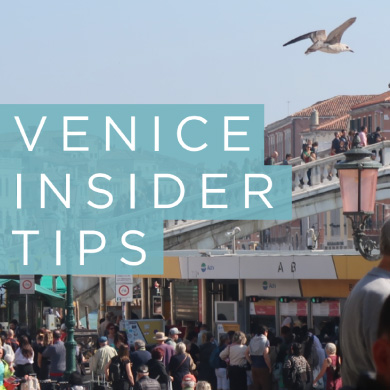
What's in this guide?
Below I’ll share a one day in Venice itinerary that includes useful information on its iconic landmarks and a couple of off-the-beaten-path gems that you’ll encounter on your way from one place to the other.

I also suggest when to visit each attraction based on its opening times and share some extra travel tips that might come in handy during your 24 hours in Venice.
Your day trip to Venice starts from the Santa Lucia railway station or Piazzale Roma as you most likely get to the city by train or by bus and from here you’ll walk towards Rialto Bridge where your itinerary starts.
Venice in one day walking map
Below you’ll see a Venice walking map that will come in handy once you arrive in Venice. That way, you can plan and make the most of your 24 hours in the city.
Do you want to know how to get from the airport to Venice? Or looking for advice on the best mode of transport to save you money? See my: Marco Polo airport to Venice or Treviso airport to Venice guides, where I outline all the options you have.
Rialto Bridge
8.30 am – 9.30 am
Your one-day in Venice itinerary can easily start from this location and the main reason is that usually it is not too overcrowded early in the morning.
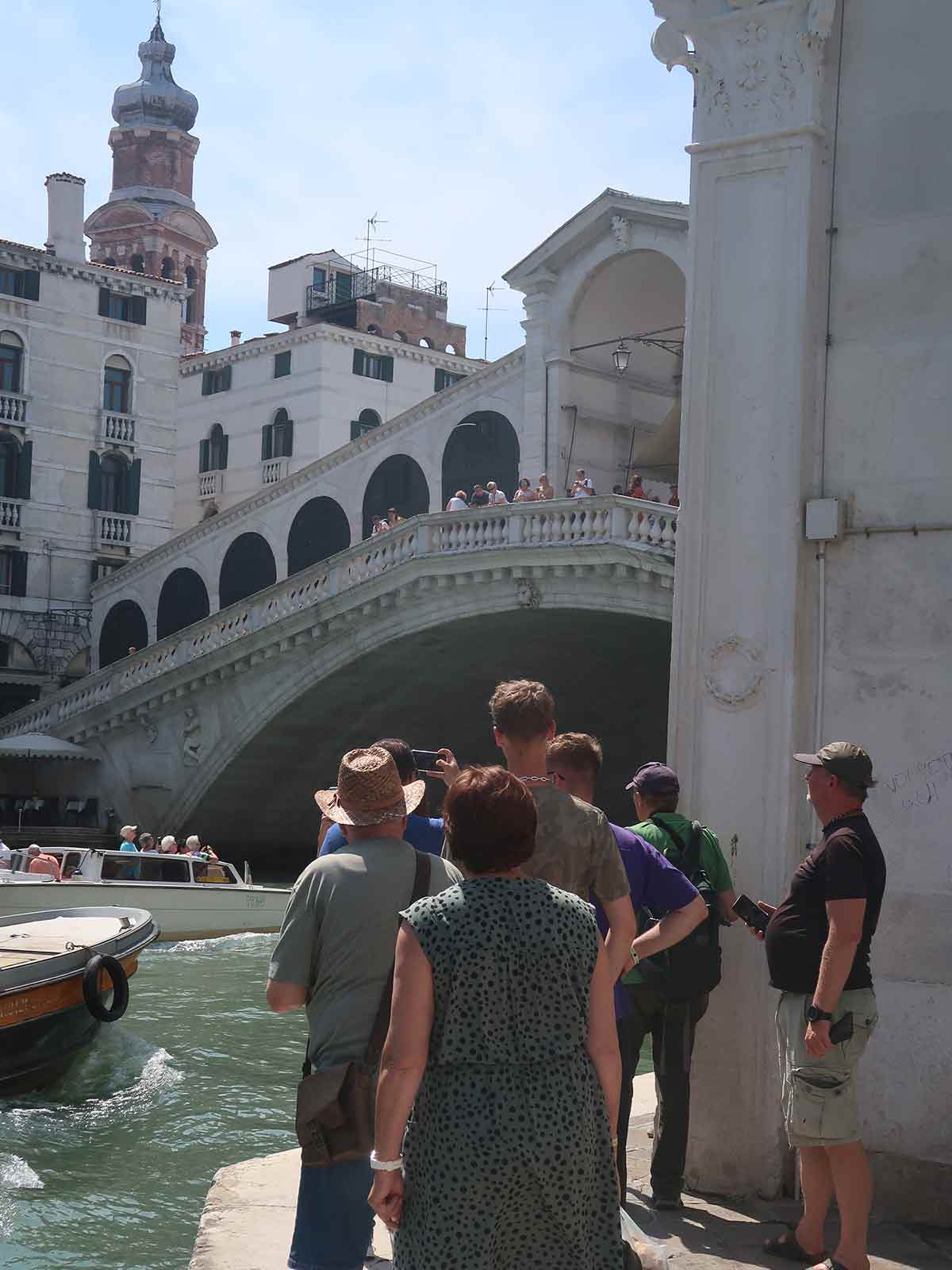
There are hundreds of bridges in Venice you can see, but only four span the Grand Canal. Among these, the best known is the Rialto Bridge , which is also a symbol of Venice. This is one of the most visited attractions of the city and a huge number of people cross it every day.
The Rialto Bridge (Ponte di Rialto) is a covered stone bridge . It’s 48 meters long and 22 meters wide. The original structure was made in wood and built in the late Middle Ages but was replaced soon after collapsing due to the weight of people that were on top.
The current stone bridge was designed by Antonio Da Ponte at the end of the 16th century . On one of its banks beside the bridge you can find the Rialto Market , the most famous indoor fruit and vegetable market in Venice.
A Gondola Tour
9.30 am – 10-15 am
Whether it’s your first time in Venice or not, a gondola ride is one of those unmissable experiences to live in the city of water!

But, what is a gondola ride in Venice all about anyway? I hear you ask. Well, the gondola is a traditional boat used to move around the Venetian lagoon.
Today it’s mainly used for tourism purposes, but around the 14th century, they represented the main mean of transport for Venetian people .
This is when the first gondolas started to be used to transport people from one bank of the Grand Canal to the other. The gondolier, is a Venetian man driving the gondola, that wears a hat, a black and white striped t-shirt and black trousers.

Depending on the time of the year you’re visiting Venice, you’ll soon realize that the Rialto Bridge area, it’s particularly overcrowded and many tourists want to ride a gondola from here to cross the Grand Canal.
For this reason, I recommend booking one of these gondola ride tours:
- Private Rialto Bridge Gondola Ride for an exclusive gondola ride for you or your group.
- Grand Canal Gondola Ride with App Commentary the cheapest option available to ride a gondola.
- Grand Canal by Gondola with Commentary with live guide.
- Shared Gondola Ride Across the Grand Canal if you wish to save and share with other people the gondola.
St. Mark’s Square
10.30 am – 11.30 am
If in Venice for a day, you must absolutely visit Piazza San Marco . There’s no doubt that St. Mark’s Square is one of the most beautiful squares in the world! It dates back to the 11th century and Napoleon used to call it ‘the drawing room of Europe’.
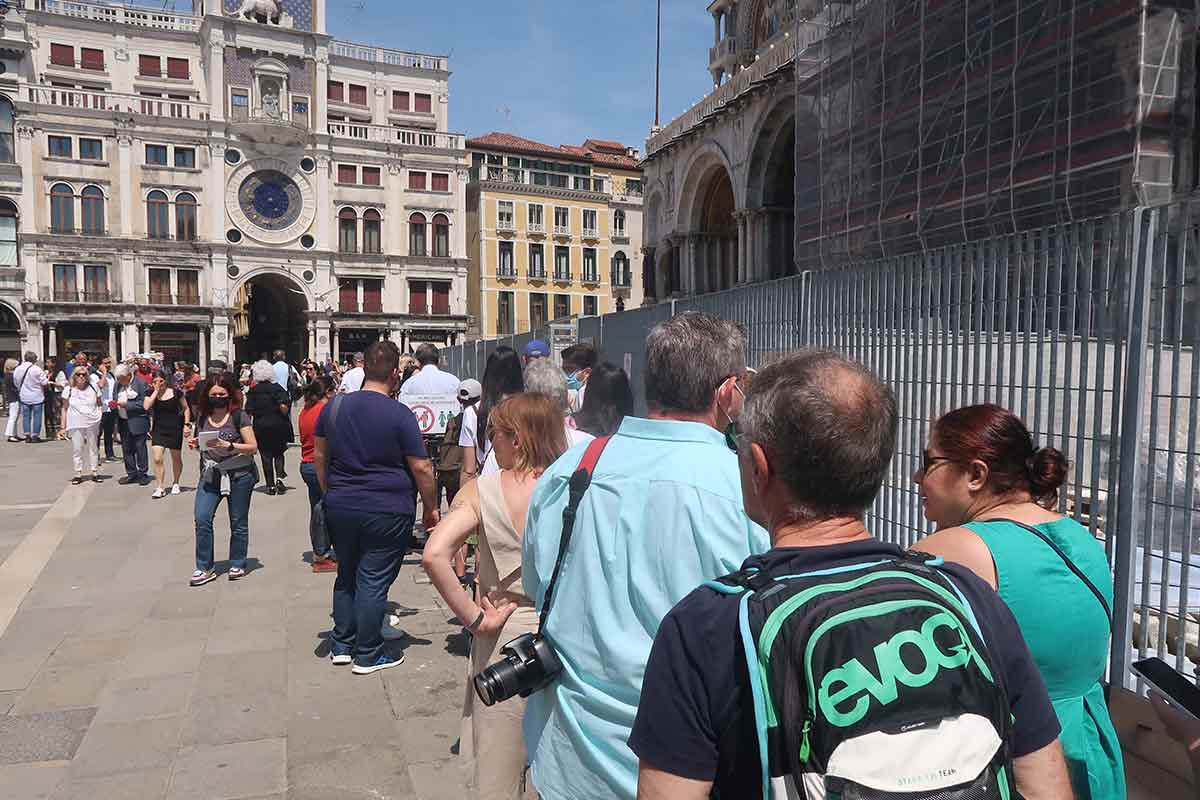
The piazza is surrounded by the Procuratie Vecchie and Nove , three buildings connected to each other that were built by the procurators of St. Mark.
The Procuratie Vecchie occupy the northern side of the square, whilst the Procuratie Nove stands on the south. The latter were the former residencies of the procurators and here is where the famous first bar in the world, the iconic Caffè Florian .
The eastern side of St. Mark’s Square is dominated by the stunning St. Mark’s Basilica . It’s worth knowing that St. Mark’s Square is actually the only square in Venice as the other piazzas are called instead ‘campi’.
On the adjacent small piazza (called ‘Piazzetta’) is where you’ll find Doge’s Palace , the Marciana Library and the two granite columns of St. Theodor and St. Mark.
St. Mark’s Basilica
11.30 am – 12.30 am
The St. Mark’s Basilica (Basilica of San Marco) is the religious heart of Venice and, together with the bell tower (Campanile di San Marco), is one of the symbols of the city. There are more than 5 million visitors visiting it every year!
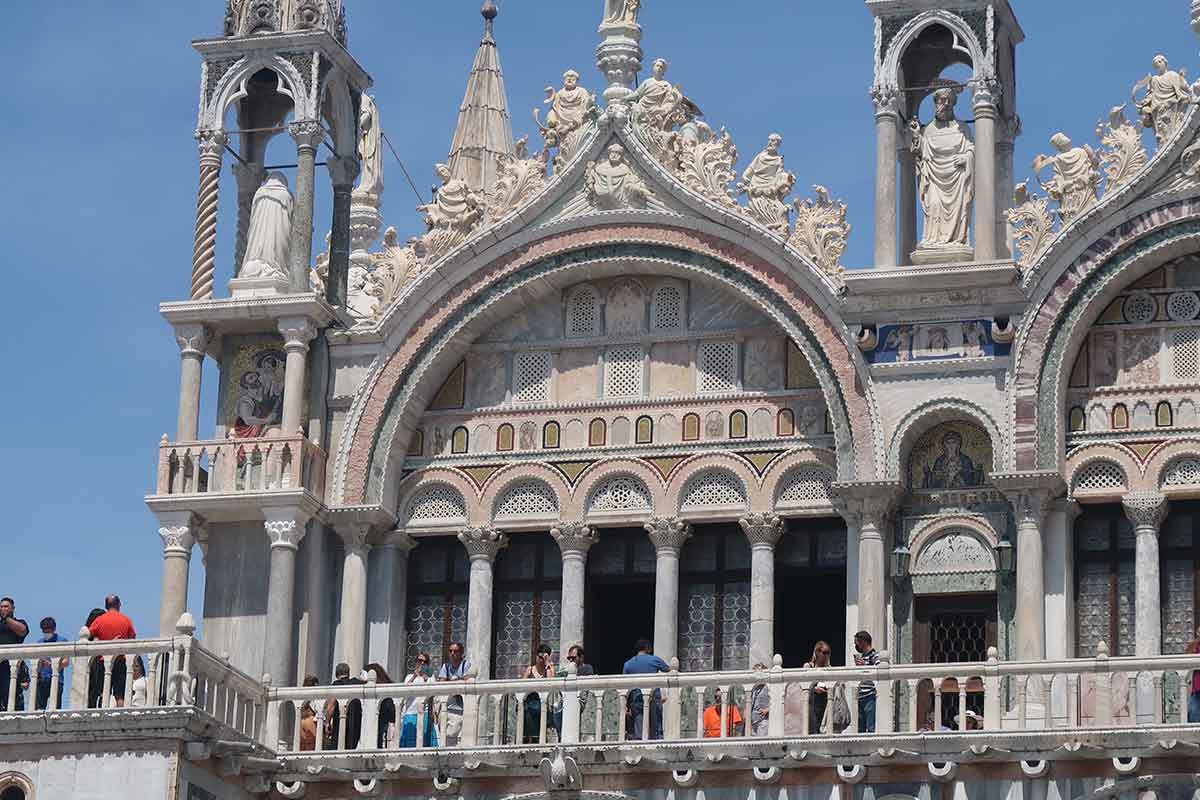
The church is also called ‘ the Golden Cathedral ’ for displaying thousands of gold tiles that make up various mosaics you can see on the ceilings. Expect to see an impressive 8,000 square meters of gold mosaics during your tour of the basilica .
The basilica style is a blend of Romanesque and Byzantine architecture . The church’s shape is a Greek cross with a large central dome and four side domes.
The church was built in the homonymous Piazza San Marco after the relics of the patron saint St. Mark , previously kept in Alexandria in Egypt, was brought back to Venice in the year 828. The church we can see today was consecrated in the year 1094 and follows the architectural scheme of the splendid Church of the Holy Apostles in Constantinople (today Istanbul).
Considering that the church is one of the most popular landmarks in Venice, I strongly recommend booking your access or tour in advance.
For example this Doge’s Palace & St. Mark’s Basilica tour (with terrace access) is the best combination of guided tours, that includes access to the Basilica and its terrace as well as priority entrance to the Doge’s Palace.
Ticket info:
- 3 euros adults, free for children up to 6 years of age
- Pala d’Oro access – 5 euros supplement, children free up to 6 years of age
- Museum + Loggia dei Cavalli access – supplement of 7 euros, free for children up to 6 years of age
12.30 am – 1.30 pm
There are many restaurants and bars all around the St. Mark’s area. For a quick lunch, I recommend the Enoteca Al Volto , only 5 minute walk from St. Mark’s Basilica. The traditional restaurant serves a great selection of ‘cicchetti’, Venetian tapas, and lovely wines for accompaniment.
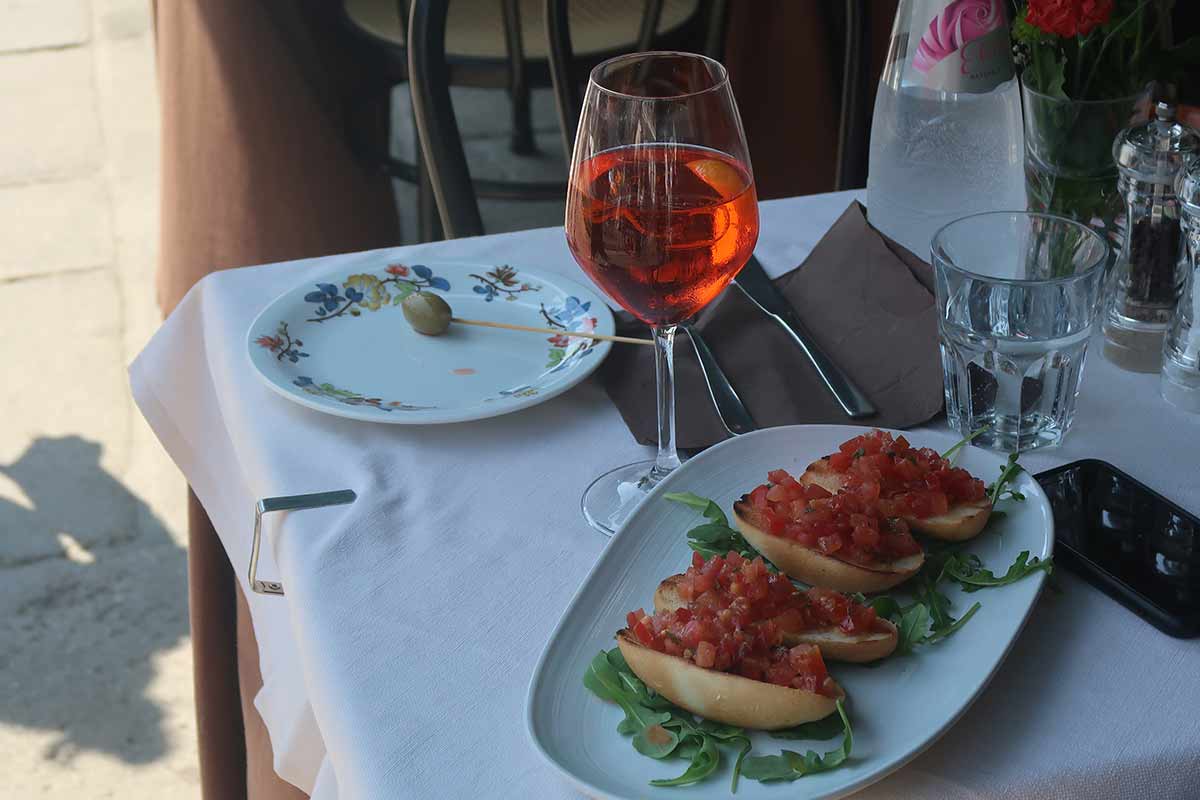
St. Mark’s Campanile
1.30 pm – 2.30 pm
The Campanile di San Marco, with its 98.6 meters of height, is one of the most famous symbols of Venice in the world. Also called ‘el paròn de casa’, or the Venetians’ landlord, it stands on the homonymous square, right in front of St. Mark’s Basilica.
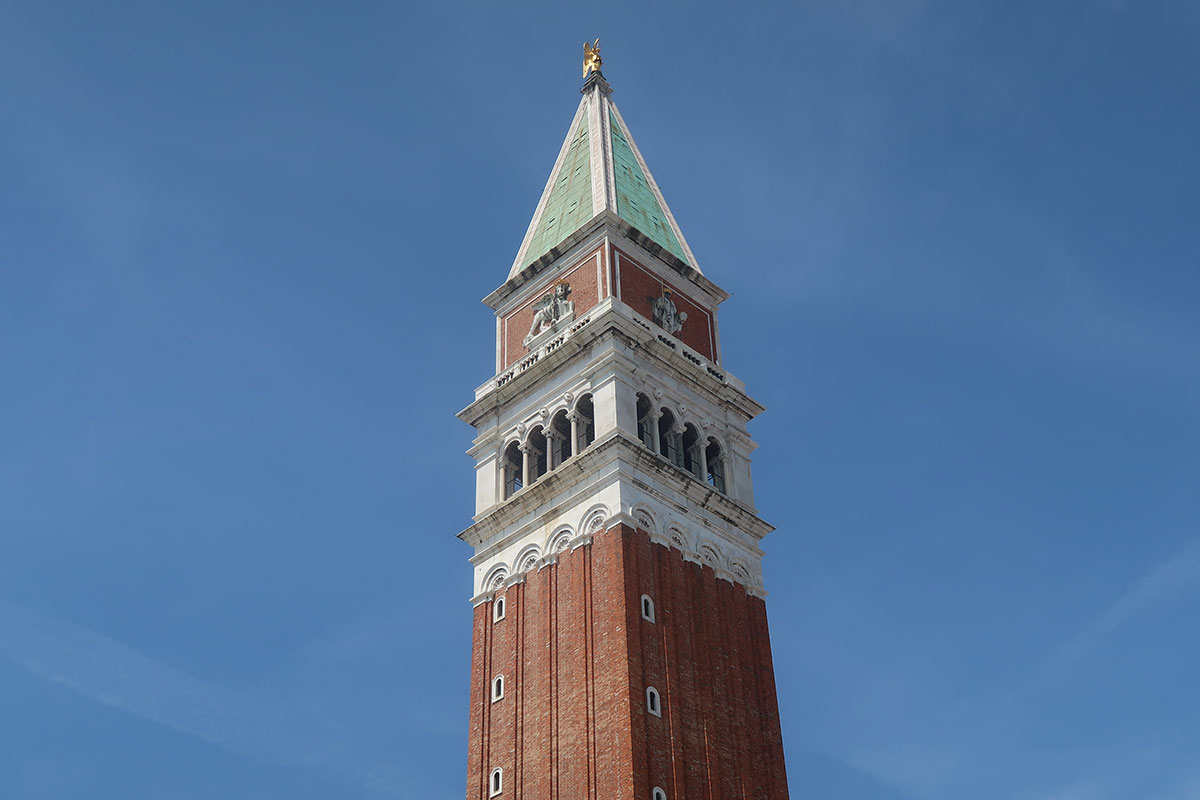
In the year 912, Venetians plan a new lookout tower that has been restored several times due to lightning or fires. Towards the end of 1400, they add a statue in wood and covered in copper of the archangel Gabriel which indicates the direction of the wind.
Around the mid-1500s, Jacopo Sansovino designed a loggia at the base of the tower, called ‘ Loggetta di Sansovino ’. On 13th July 1902, the bell tower completely collapsed and after 10 years a new one was inaugurated. There are 6 bells and each one of them plays a note that was announcing to Venetians imminent events such as the start of the Senate meetings.
- 10 euros adults, free for children up to 6 years of age. Get your ticket here
Doge’s Palace and Bridge of Sighs
2.30 pm – 4 pm
The Doge’s Palace in Venice is another symbol of the city. Located in the magnificent nearby small square of St. Mark’s Square, this was the Doge’s residence and the seat of the municipality and city’s assemblies .
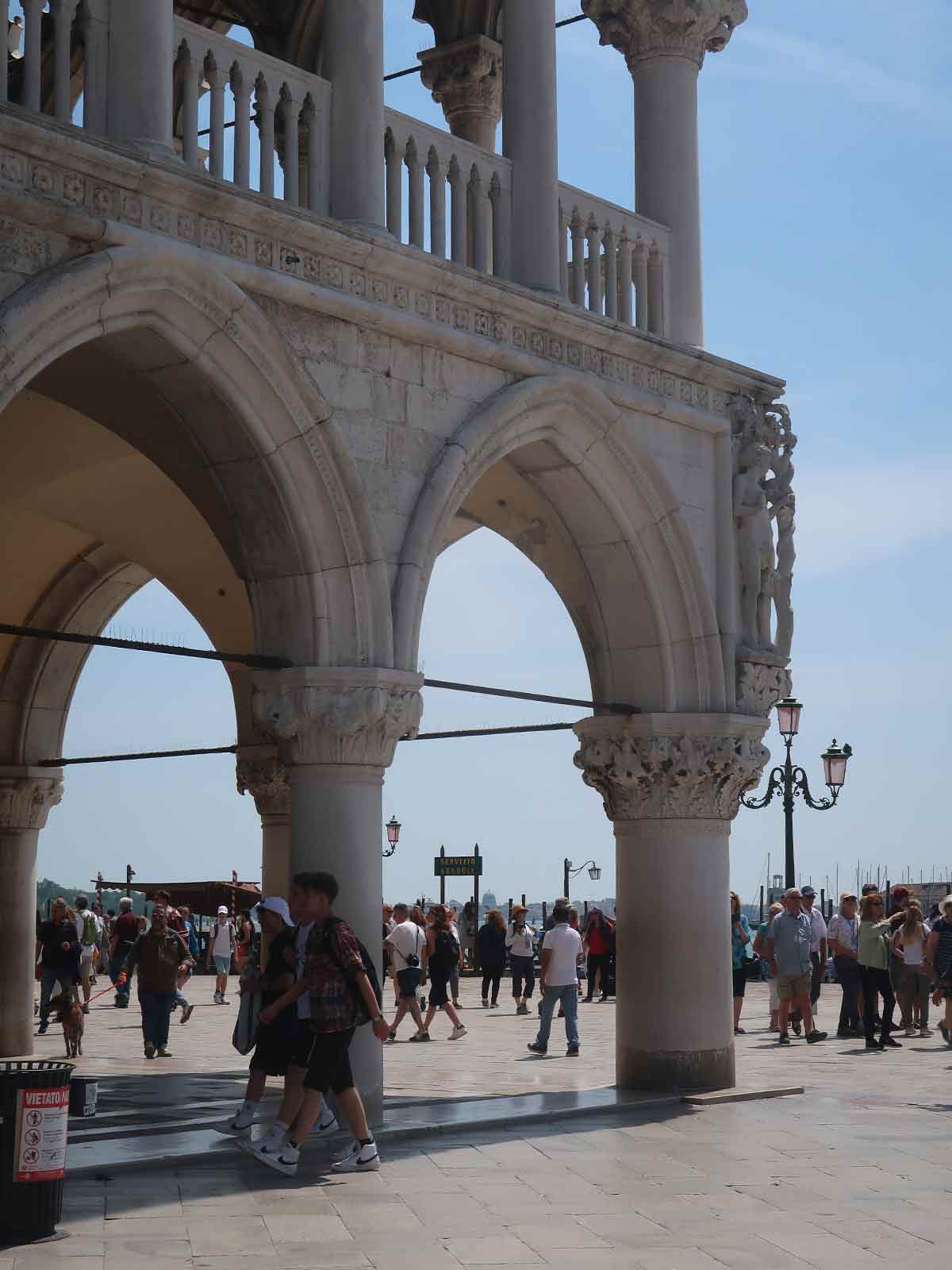
The doge was the chief magistrate of the Serenissima Republic. Even the judicial power was administered here, where there was a system of prisons and an armoury.
The Doge’s Palace is considered one of the most beautiful examples of Venetian Gothic architecture in the city and was built in 1340 using white and pink tiles for the exteriors.
The interiors of the palace are stunning and all chambers are worth visiting. You’ll find both institutional rooms and Doge’s apartments . You can access the building from the Porta del Frumento on the ground floor where there’s also the imposing Scala dei Giganti .
On the first floor, you can stroll around different rooms, in some of which are collected Venetian artists’ masterpieces, such as the some of the most sought after artworks by Tiepolo, Titian, Tintoretto and Canaletto.
By booking this Doge’s Palace admission ticket you can also have access to the prisons and cross the Bridge of Sighs . In fact, what is considered the most romantic bridge of Venice has a sad story behind.
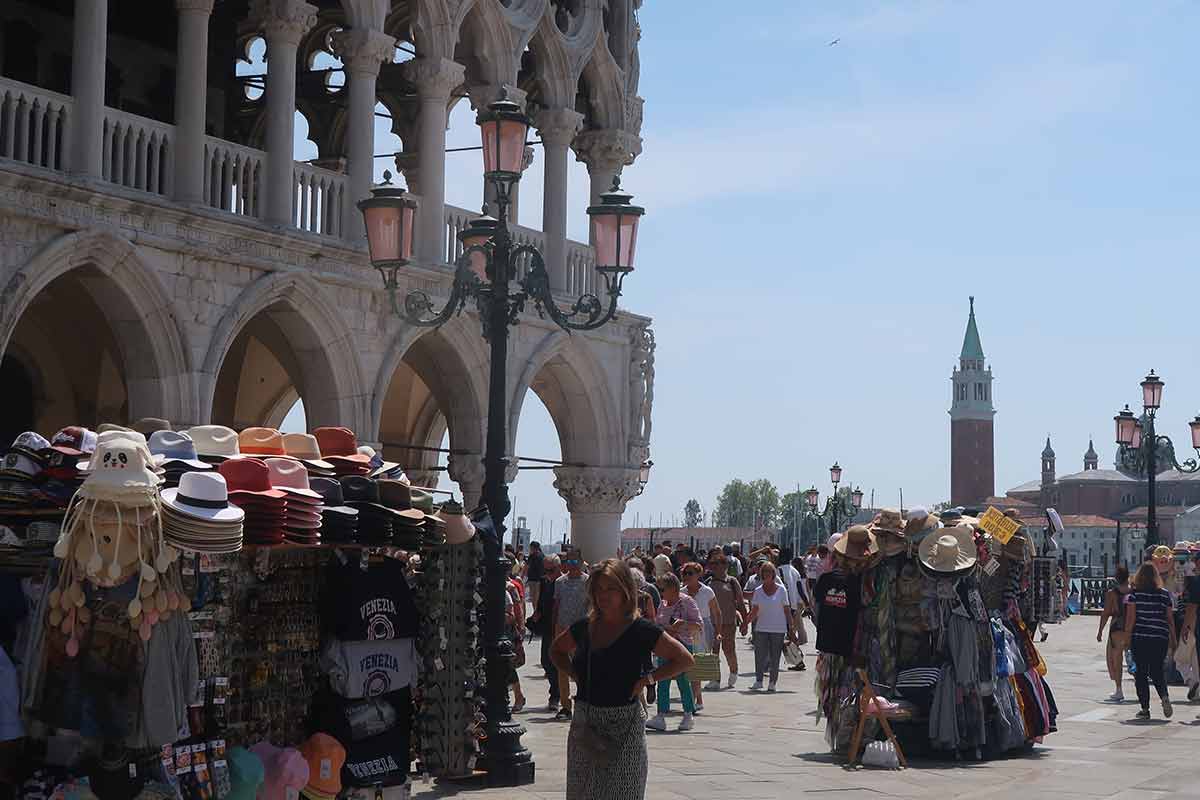
The bridge was connecting the Doge’s Palace to the prisons. All prisoners had to go through this narrow passage to receive the final sentence that could have condemned them to a bitter fate. From those grates, perhaps for the last time, they could observe – sighing – the sea and the Venetian lagoon.
Ticket info: You can purchase your ticket to Doge’s Palace here online.
Choose between:
- Museum Pass – access to Doge’s Palace and 10 museums around the city. The ticket cost is 41 euros for adults, 23 euros for children/teenagers between 6 and 14 and over 65, and children from 0 to 5 are free (available the family ticket that costs 23 euros for each family member).
- Museums of St. Mark’s Square Pass – access to all museums based in St. Mark’s Square (Correr Museum, Archaeological Museum and Marciana Library). The ticket cost is 31 euros for adults, 16 euros for children/teenagers between 6 and 14 and over 65, and children from 0 to 5 are free (available the family ticket costs 16 euros for each family member).
Scala Contarini del Bovolo
4.30 pm – 5.30 pm
The Contarini del Bovolo is an off-the-beaten path landmark you can add to your one day in Venice itinerary as it’s quite close to the main attractions mentioned above. The magnificent external spiral staircase (called ‘bovolo’ staircase in Venetian dialect) makes the facade of the palace such a unique one.
The 80 steps staircase was built in Istrian stone and is 26 meters high. According to legend, the nobleman Pietro Contarini had the staircase built not only as a pure symbol of power , but also because he wanted to reach his bedroom directly from his horse!
What I really love about the staircase are the incredible views of the city you can admire by climbing it, step by step. You can also get your ticket in advance following this link: Palazzo Contarini del Bovolo entrance ticket .
- Recommended to book online, the ticket cost for adults is 8 euros and 6 euros for children/teenagers between 12 and 26 and over 65.

Accademia Bridge
6pm – 6.30pm
The Accademia Bridge (Ponte dell’Accademia) is the only wooden bridge of Venice and one of the few crossing the Grand Canal .

From here, you can admire beautiful views of the city, in particular during sunset. It’s easy to spot the Santa Maria della Salute Basilica’s dome and Punta della Dogana. The bridge is based in the Dorsoduro district , a lively neighbourhood of Venice that I recommend exploring even after sunset for its bars and restaurants.
It’s been named ‘Accademia’ for the nearby Accademia delle Belle Arti di Venezia and the museum Gallerie dell’Accademia.
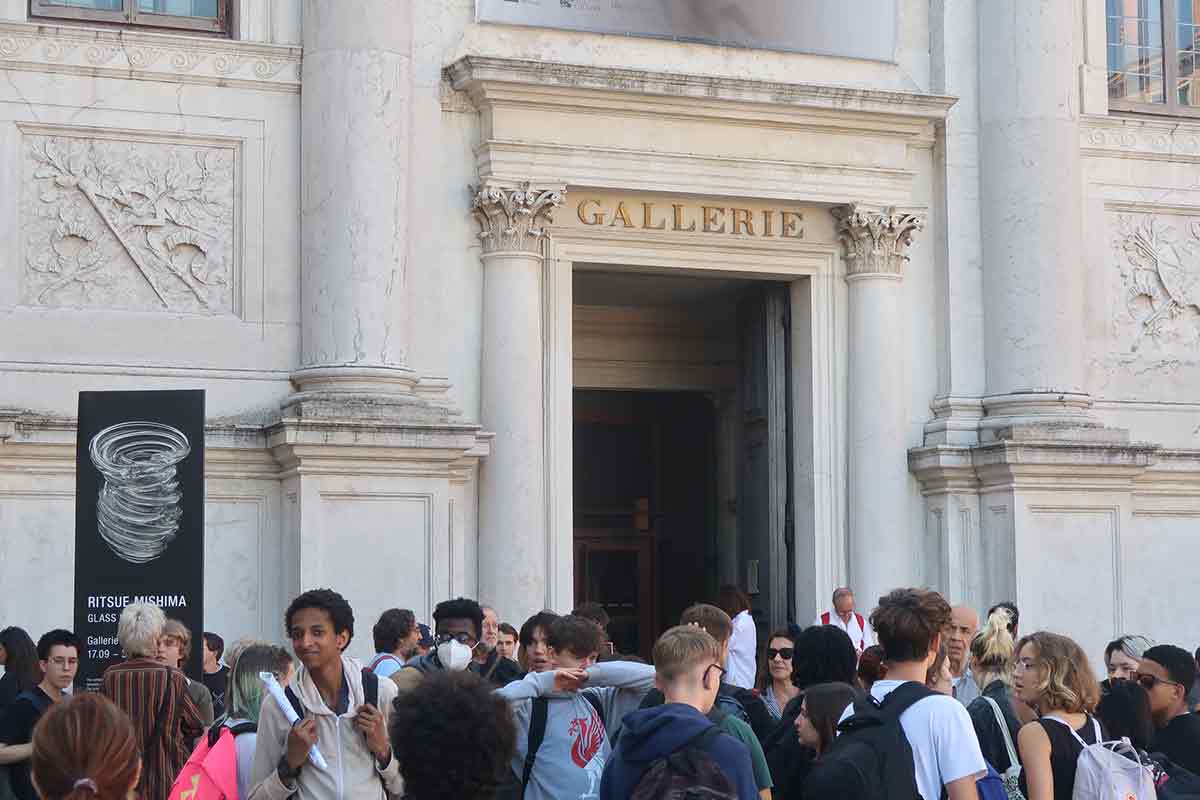
The original bridge was made of stone by the Austrians to create a faster connection between the railway station to St. Mark’s Square. Venetian didn’t like its industrial design and for this reason, has been replaced by the actual one and built in only 37 days !
Aperitivo at Osteria Al Squero
6.30 pm – 8 pm
What do the locals do after 5 pm? Aperitivo! This is an extra activity I suggest adding to your day in Venice. It’s a way to immerse yourself in the culture and feel like a real Venetian. Walking around, you’ll notice many small tavernas and bars.
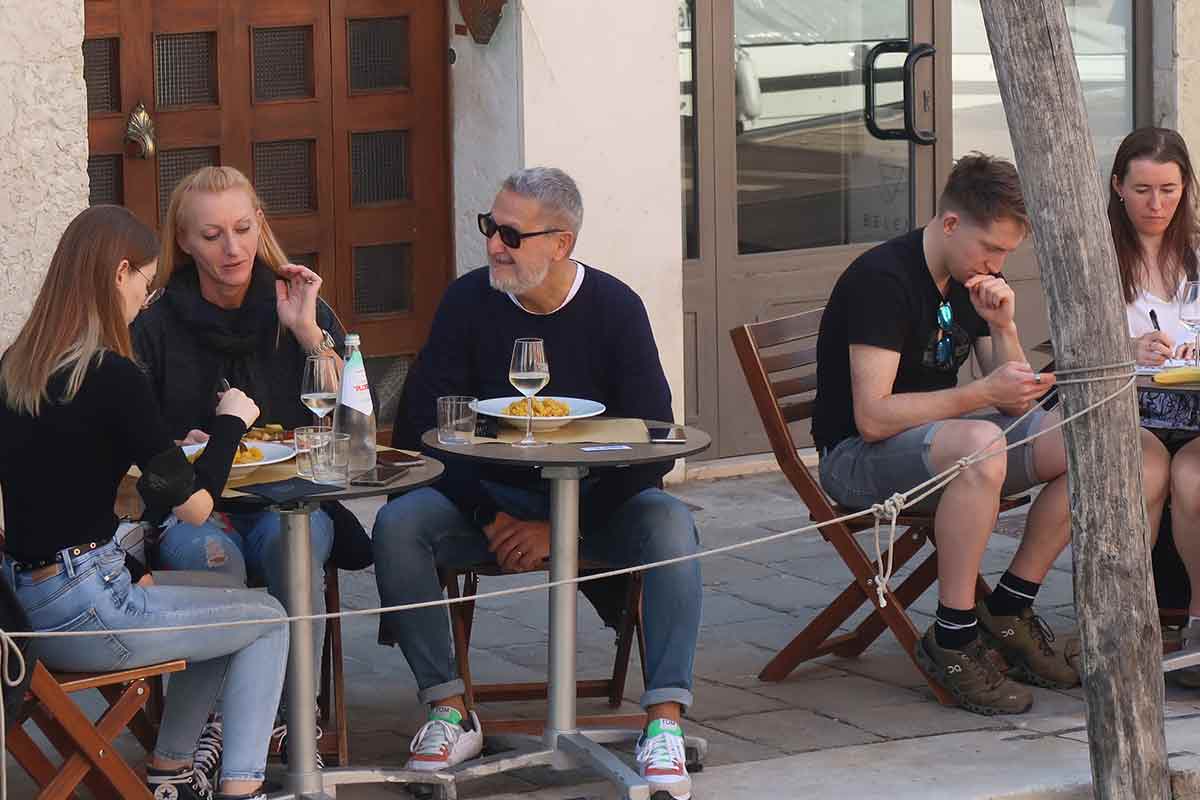
This is where locals like meeting up for a meal or aperitif before dinner. Normally prices are not too high unless you choose a fancy one, for example in the St. Mark’s Square surrounding area.
One of the best ones in the Dorsoduro district is the Osteria Al Squero . It’s a cosy bar that have a vast selection of delicious cicchetti made from local and fresh produces, wines and beers.
Here you can really get an idea of how Venetian have aperitivo! On the other side of the canal where the ‘bacaro’ is located, you can spot the Squero San Trovaso , one of the few gondola boatyards left in the city.
Venice 1 day itinerary highlights

To recap, this is my suggested itinerary for one day in Venice:
- From Venice St. Lucia railway station or Piazzale Roma, cross the Ponte degli Scalzi and follow directions to ‘Rialto/San Marco’. Enjoy walking down Venice’s narrow streets and crossing bridges and canals, and walk along Campo San Polo until when you’ll reach the Rialto area.
- Visit the Rialto Bridge and its market and go for a gondola ride.
- From here, in 10-minute walk, you’ll get to St. Mark’s Square where you’ll visit St. Mark’s Basilica, the bell tower, the Doge’s Palace and the Bridge of Sighs. During this time you’ll also have lunch around this area.
- Only 6 minute’s walk from the square, you’ll get to the romantic Scala Contarini del Bovolo and its palace.
- Move towards the Accademia Bridge from where you can enjoy a fantastic view of Venice for the sunset.
- Have aperitivo like a real Venetian at the Taverna Al Squero and back to the station or your hotel.
Will you be spending more than a day in the city? If so, be sure to see this list of best hotels with canal view in Venice for spectacular overnight stay.
Got travel insurance for Venice?

1 day in Venice FAQ Guide
Here are some questions people ask when it comes to visiting Venice:
Is one day enough for Venice?
No, one day in Venice is not enough. You should at least spend 3 days in Venice to really have enough time to visit the main attractions, wander around its streets and piazzas without rush, include a couple of hidden gems and if you want, a day trip to other islands of the Venetian lagoon or towns in the Veneto region.
Is the entrance to Venice free?
Yes, you can visit Venice for free. For now there is still no entrance fee to visit the city. In the near future, a visitor fee will be introduced and you can book your daily visit to Venice through an online platform and at that point, pay the admission fee. This entrance fee will affect only day visitors.
Do you tip gondoliers in Venice?
It’s not necessary and gondoliers don’t expect that from you. But if you really enjoyed the experience and you think that your gondolier was impeccable, you can absolutely give a tip, that will be much appreciated.
What should I wear in Venice during the day?
Now you have a clear idea of how you can spend 24 hours in Venice . You can change the itinerary based on your preferences, extend it or make it shorter.
This is my suggestion, suitable for first-time visitors that want to have a great time, without rushing into the next attraction and that includes my local tips to make the most of this one day in Venice.
Are you wondering what else you can see around the lagoon or in the Veneto region? Check out my day trips from Venice article for more inspiration!
📌 Like this article? Click to Pin it…
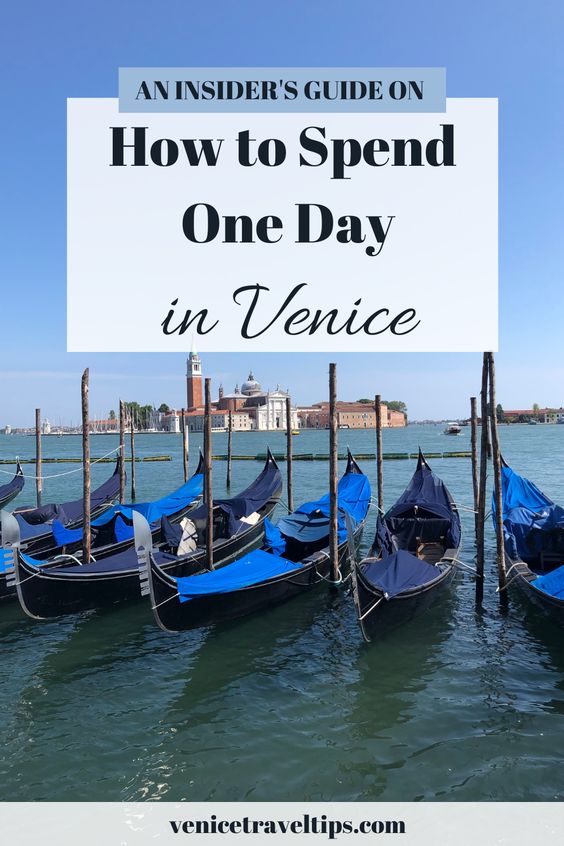
If you found this Venice travel guide helpful, feel free to buy me a virtual coffee here .
“Dear traveller! Some links in this post contain affiliate links. Meaning, if you click through and make a tour booking or reserve a hotel, I may earn a small commission at no additional cost to you. Your support means a lot to me and helps me to keep creating and maintaining the quality of this site for you.”
Sharing is caring!
About Maddy
I love to share tips, advice and resources to help visitors explore Venice and the Veneto region like a local. Learn more about me here.

Recent Posts
- Best food tours in Venice
- First time in Venice: Travel tips for beginners
- Castelfranco Veneto travel guide
- Cheap hotels in Mestre (near train station)
- Visiting Venice in summer 2024
- How to get to Treviso airport for an early morning flight
- How to get from Lido di Jesolo to Venice
- Venetian Culture
- Venetian Food
- Veneto Region
- Venice Accommodation
- Venice Itineraries
- Venice Transport
- Venice Travel Guides
THE 10 BEST Venice Tours & Excursions
Venice tours.
- Walking Tours
- Historical & Heritage Tours
- Sightseeing Tours
- Up to 1 hour
- 1 to 4 hours
- 4 hours to 1 day
- 5.0 of 5 bubbles
- 4.0 of 5 bubbles & up
- 3.0 of 5 bubbles & up
- 2.0 of 5 bubbles & up
- Chinese (Simplified)
- Chinese (Traditional)
- Likely to Sell Out
- Special Offers
- The ranking of tours, activities, and experiences available on Tripadvisor is determined by several factors including the revenue generated by Tripadvisor from these bookings, the frequency of user clicks, and the volume and quality of customer reviews. Occasionally, newly listed offerings may be prioritized and appear higher in the list. The specific placement of these new listings may vary.

1. Venice In a Day: Basilica San Marco, Doges Palace & Gondola ride

2. Legendary Venice St. Mark's Basilica with Terrace Access & Doge's Palace

3. Venice: St.Mark's Basilica & Doge's Palace Tour with Tickets

4. Venice: Grand Canal by Gondola with Commentary

5. Murano & Burano Islands Guided Small-Group Tour by Private Boat

6. Skip-the-Line: Doge's Palace & St. Mark's Basilica Fully Guided Tour

7. Eat Like a Local: 3-hour Venice Small-Group Food Tasting Walking Tour

8. Full Day Venice Shore Excursion from Trieste

9. Welcome to Venice Small Group Tour: Basilica San Marco & Gondola Ride

10. A day among the most beautiful mountains in the world, the Dolomites and Lake Braies

11. St Marks, Doges Palace, with Murano and Burano & Gondola Ride

12. Venice: St Mark's Basilica After-Hours Tour with Optional Doge's Palace

13. Venice: Charming Gondola Ride on the Grand Canal

14. Best Of Venice: Saint Mark's Basilica, Doges Palace with Guide and Gondola Ride

15. Tour of The Real Hidden Venice

16. Venice Food Tour - Eat like a Venetian

17. Venice Tour from Trieste for the First Time Cruise Visitors

18. Murano, Burano and Torcello Half-Day Sightseeing Tour

19. Murano Glass Experience with a Visit to a Burano lace island

20. Venice: Four Seasons Concert in the Vivaldi Church

21. Market Tour and Cooking Class with a Venetian Chef

22. Venice in A Day: St Mark's Basilica, Doge's Palace & Gondola Ride

23. Venice Street Food Tour with Local Guide with Local Food Market Visit

24. Experience Venice Like A Local: Small Group Cicchetti & Wine Tour

25. Venice Marco Polo Airport Link Arrival Transfer

26. Venice Walking Tour and Gondola Ride

27. Eat, drink and repeat: Wine tasting tour in Venice

28. A sparkling day in the Prosecco Hills- From Venice

29. Luxury Tour of Murano & Burano Boat

30. Venice at Sunset: Cicchetti, Food & Wine Tour
What travelers are saying.
- George S 1 contribution 0 5.0 of 5 bubbles Learned a lot and enjoyed immensely Our guide Roberta was Excellent!! She was informative, friendly, funny and very attuned to the needs of our small group. One of which walked with the aid of a cane. She taught us a lot and did it with much charm. I would highly recommend the tour, and especially Roberta, to friends and family. Read more Review of: Legendary Venice St. Mark's Basilica with Terrace Access & Doge's Palace Written April 22, 2024 This review is the subjective opinion of a Tripadvisor member and not of Tripadvisor LLC. Tripadvisor performs checks on reviews.
- Venice: Grand Canal by Gondola with Commentary
- Murano & Burano Islands Guided Small-Group Tour by Private Boat
- Murano, Burano and Torcello Half-Day Sightseeing Tour
- Venice: Four Seasons Concert in the Vivaldi Church
- Venice In a Day: Basilica San Marco, Doges Palace & Gondola ride
- LivTours Venice
- [deTour]ist - Valerio Coppo: Tour Guide. Take a detour in Venice, be a detourist!
- Lucia Venice Walks and Tours
- Alvise Private Tour Guide in Venice
- Nico Venice Tour
- Think Venice
- Best Photo Tour Venice
- Your Local in Venice
- Venice Original Photo Walk and Tour
- Venice Guided Tours
- Friend in Venice Tours
- Venice Kayak
- Sup In Venice
- Venicegroupservices srl
- Venice Deluxe Tour
World Map » Italy » City » Venice » Large Detailed Tourist Map Of Venice
Large detailed tourist map of Venice
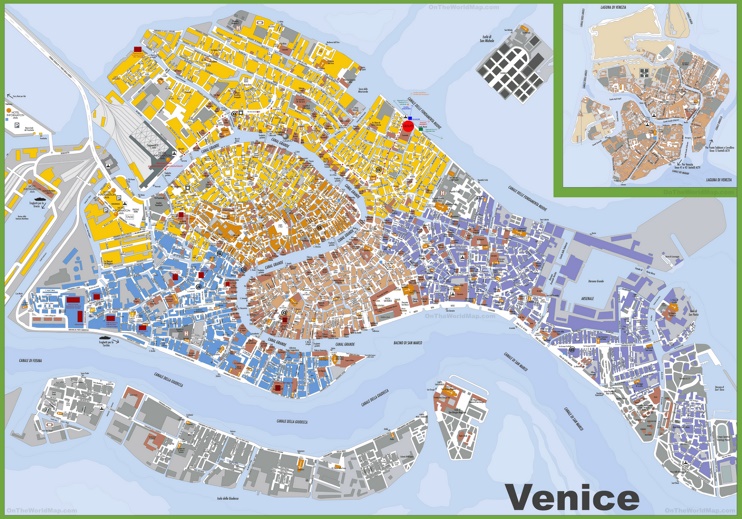
You may download, print or use the above map for educational, personal and non-commercial purposes. Attribution is required. For any website, blog, scientific research or e-book, you must place a hyperlink (to this page) with an attribution next to the image used.
Maps of Italy
- Ski Resorts
- Mappa d'Italia
Cities of Italy
Regions of Italy
- Aosta Valley
- Emilia-Romagna
- Friuli-Venezia Giulia
- Trentino-Alto Adige
- North America Map
- South America Map
- Oceania Map
Popular Maps
- Australia Map
- Germany Map
- Singapore Map
- United Arab Emirates Map
- United Kingdom Map
- United States Map
- New York City Map
- Los Angeles Map
U.S. States
- California Map
- Colorado Map
- Florida Map
- Georgia Map
- Illinois Map
- New York Map
- North Carolina Map
- Virginia Map
Venice Tourist Attractions Map PDF
Printable Map of Venice Attractions, Walking Tours Map

Home / Venice Tours / Attractions Map
Venice Tourist Attractions Maps | City Tours Map
Venice is a truly romantic city surrounded with canals and absolutely charming architecture. If you're exploring Venice for the first time, the best way to get started is to grab a copy of the map of Venice. That way, you will know what to see, where to go, and how to find the Venice's famous attractions and landmark.
Tripindicator has different types of maps that you can use for free. For instance, you can check out our Venice interactive map for a more interactive way of discovering the city. If you want to know how you can get to the Piazza San Marco or Saint Mark's Basilica, then check out our printable tourist map Venice for directions.
Depending on how you would prefer to explore the romantic streets of Venice, there is always a map that you can use to make your stay even more memorable and fun. The best way to explore Venice is on foot. In this case, go check out our Venice tourist map walking, which will serve as your guide into exploring the busy streets of Venice.
Since Venice is surrounded with water, the best way to explore the city is on a boat. There's a hop on hop off boat tour in Venice that will take you to the famous sites in the city, such as the St. Mark's Square and Basilica, Doge's Palace, and more. For more information about this, go check out our Venice hop on hop off boat map.
The printable map of Venice is very useful to tourists who find it easier to explore the city with an actual map on hand. Otherwise, you can save a copy of the Venice tourist map pdf in your phone and refer to it as you explore. If this is your first time visiting Venice and you're not exactly sure how to get started with your tour, then grab a copy of the tourist information Venice map. It contains all the necessary information that every tourist in Venice should know.
So whether you prefer to carry a copy of the Venice city sightseeing maps with you or the Venice tourist map printable version, we have everything available for you!
- Interactive Venice Attractions Map
- Top Rated Venice Attractions
Venice Tourist Map
Venice walking map, venice transport map.
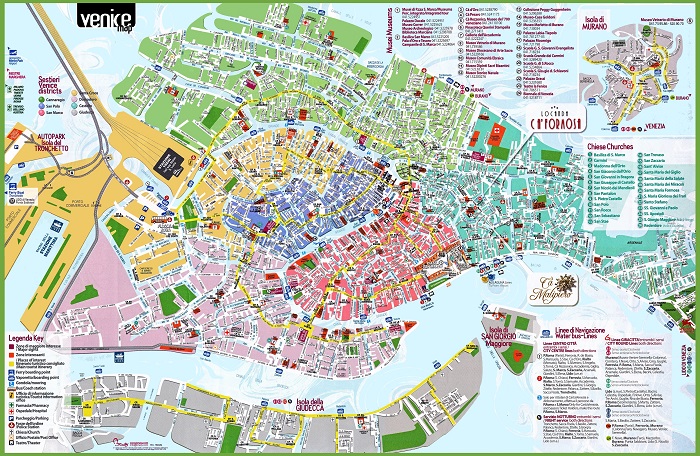
Top Venice Attractions Skip-the-line Tickets & Tours
Redentore Boat Party 2020
Da Vinci Interactive Museum Venice Scuola di San Rocco
Venice Chorus Pass
Mocenigo Palace, Museum of Textiles and Costumes Ticket
Scuola Grande di San Rocco Ticket
Entrance ticket to Scala Contarini del Bovolo
Skip the Line Correr Museum Guided tour
Scuola Grande San Giovanni Evangelista Ticket
Top Incredible Travel Guides of Venice

Venice Tours
A tiny collection of islands-turned-onetime maritime empire, Venice is one of the most enigmatic and...
Our tours in Venice

Exclusive Alone in St. Mark’s Basilica After Hours
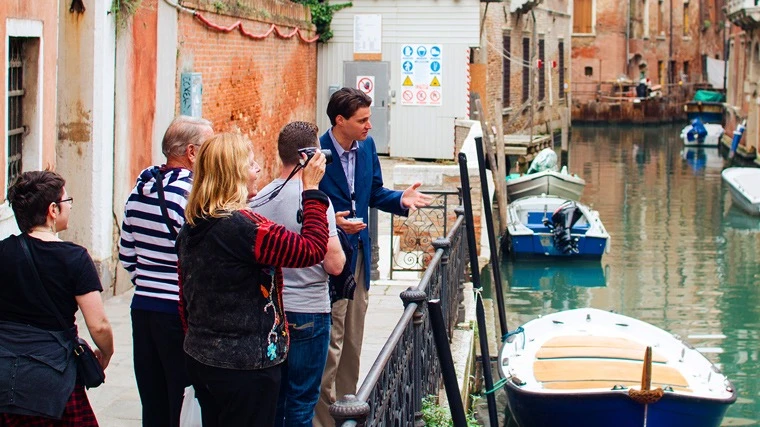
Welcome to Venice: Walking Tour, St Mark's Basilica & Gondola Ride
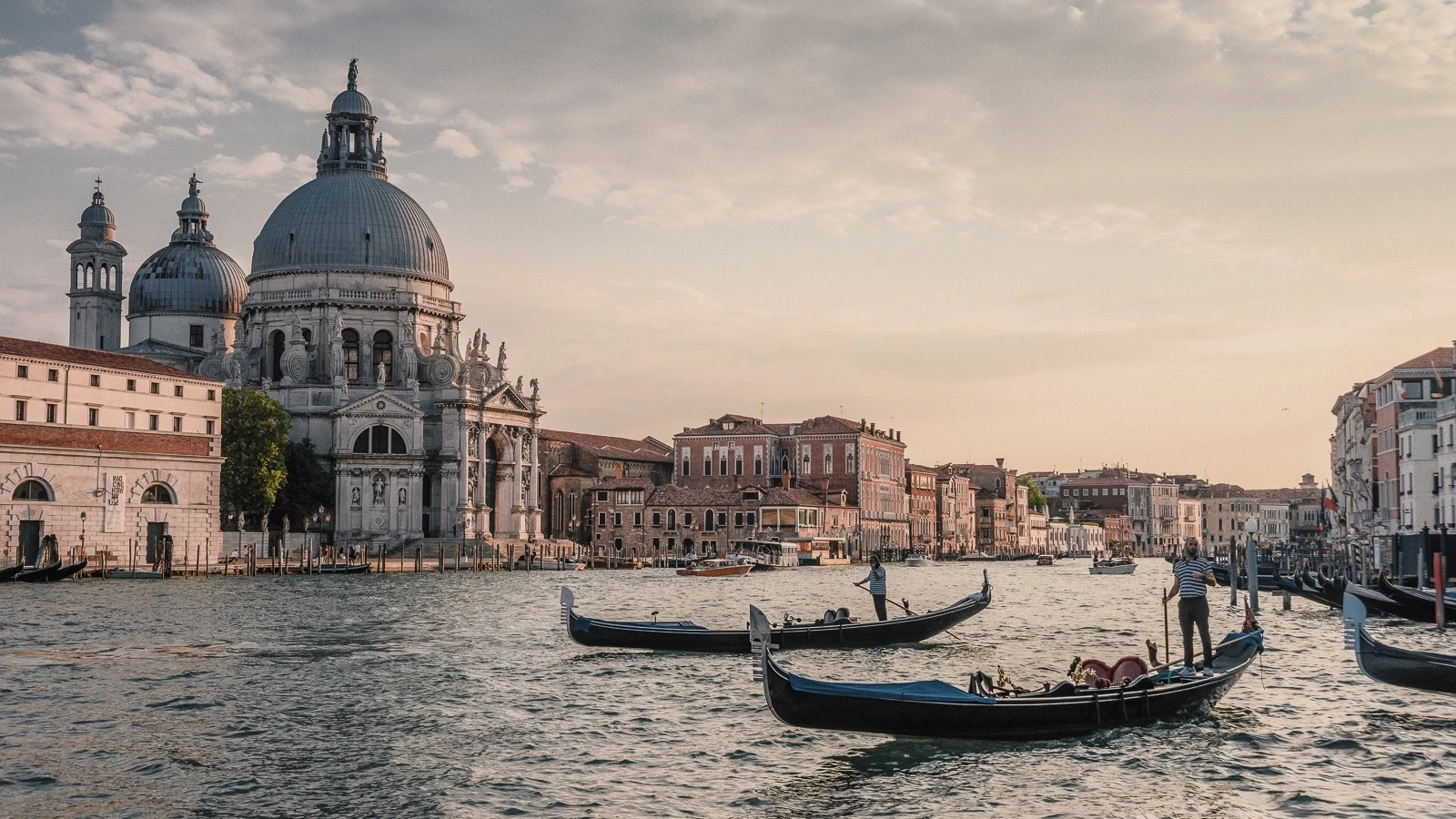
Legendary Venice: St. Mark’s Basilica with Terraces & Doge’s Palace

Venice in a Day with St Mark’s Basilica, Doge’s Palace & Gondola Ride

Tastes & Traditions of Venice: Food Tour with Rialto Market Visit

Exclusive Alone in St. Mark’s & Doge’s Palace Tour

VIP Doge's Palace Secret Passages Tour
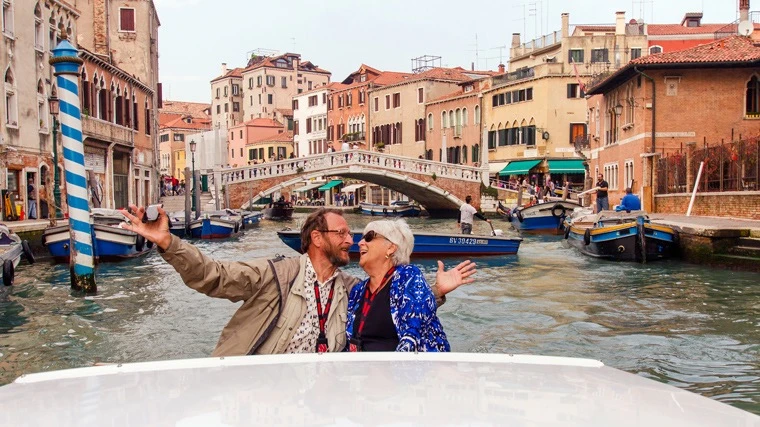
Venice Boat Tour with Grand Canal & Tower Climb

Venice at Sunset: Cicchetti, Food & Wine Tour

Premium Lagoon Excursion: Murano Glass Making, Burano & Wine Tasting
What to know about venice from our local guides.
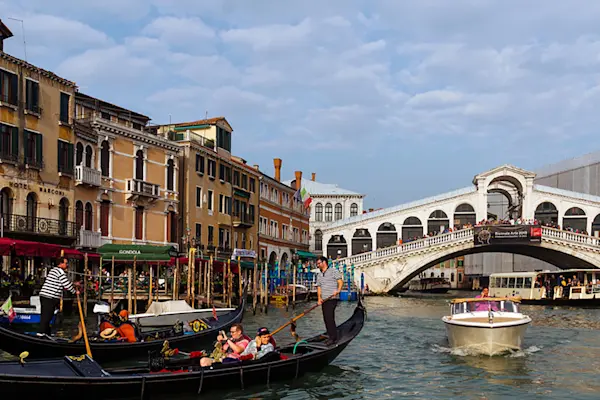
Venice offers countless enchanting experiences that will take your breath away. While you’ll never run out of things to see and do in the Floating City, here are a few can’t-miss options to get you started:
- Take a boat ride along the Grand Canal to admire the architectural beauty and lively waterways
- Step into iconic landmarks like St. Mark's Basilica and the Doge's Palace
- Explore further afield in the Venetian lagoon on an island excursion
- Discover the artistry behind Venetian masks at a workshop
- Immerse yourself in art at the Accademia Gallery and the Guggenheim Museum
- Delve into Venice’s cultural heritage at lesser-known gems like the Friari Church and the Grand School of St. Roch

Venice is a truly magical destination that’s sure to enchant visitors of all ages. And as a compact, car-free city, it’s a safe and enjoyable option for families. Kids and adults alike will be wowed by the breathtaking gold mosaics inside St. Mark’s Basilica. A gondola ride or boat tour is another only-in-Venice experience that’s sure to delight even the littlest travelers.
If you’re after a more organized activity, consider a family-friendly tour. Our Welcome to Venice Tour combines a visit to St. Mark’s with a light introductory stroll and a gondola ride. For food-loving families, our daytime Tastes & Traditions of Venice Food Tour features typical tastes kids will love, like sandwiches made with simple, delicious ingredients and authentic Italian gelato.
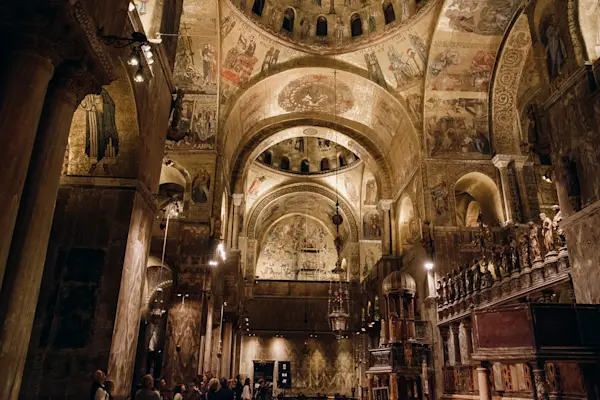
Spending hours waiting in line at St. Mark’s Basilica and the Doge’s Palace can quickly put a damper on what should be a wonderful experience in Venice. To beat the crowds and ensure you make the most of your time, consider booking a guided tour that will let you bypass the lines at these two top sights.
Want to take your Venice experience to the next level and have both St. Mark’s and the Doge’s Palace entirely to yourself? On our Exclusive Alone in St. Mark’s Basilica & Doge’s Palace Tour , you’ll step into both sites after they’ve officially closed to the public for the day for a VIP experience available to a select few.
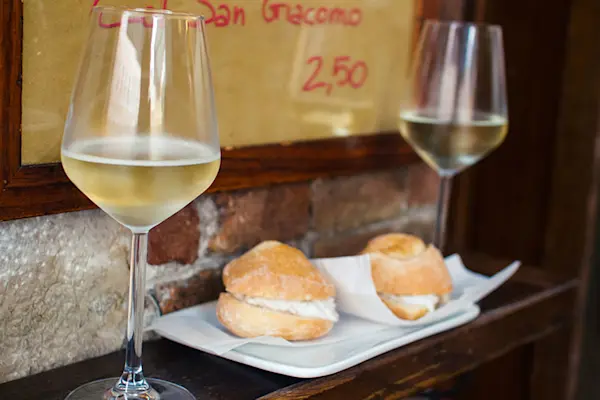
Some of the best eateries in Venice are bacari , or wine bars popular among locals for drinks and light bites known as cicchetti. A few favorites from our guide team are All'Arco, Sepa, Vino Vero, Al Timon, and Vecia Carbonera—several of which feature on our Tastes & Traditions of Venice Food Tour !
Looking for the perfect restaurant for an authentic dinner? Check out Ristorante Al Covo, Casa Bonita, or Da Ignazio.
For a quick bite near St. Mark’s Square, you can’t go wrong with Birreria Forst, RossoPomodoro for delicious pizza to-go, and ll Calice. These are all fantastic options for the lunch break on our Venice in a Day Tour , too!
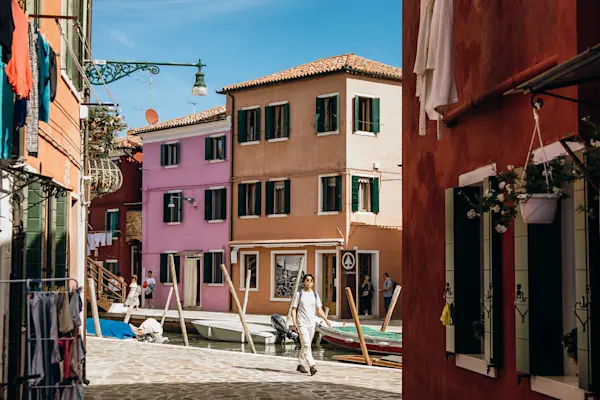
You can access Venice’s best-known outlying islands, Murano and Burano, by water taxi or vaporetto (line 12). For a more hassle-free experience, consider booking a guided tour with private boat transport. Our Premium Lagoon Excursion includes an exclusive Murano glassmaking demonstration and a VIP wine tasting at the only vineyard still operating in the lagoon.

As a city without roads or vehicles, getting around Venice via public transport works a little differently than it does in other cities. Here are a few options for getting around the Floating City.
- Traghetti: A local alternative to gondolas, used to cross the Grand Canal
- Vaporetti: Venice's water buses are a bit pricier than the traghetti, but cover more ground (or water!) with their extensive network.
- Water taxis: While this is easily the most expensive form of public transportation in Venice, it can be convenient if you’re traveling with a larger group (the taxis hold up to 10 people).
- Buses: If you’re traveling to Venice from the Italian mainland, the local public bus system has connections to Santa Croce in the westernmost part of the city—the only place where you’ll find any vehicles.
Check out our popular Venice articles
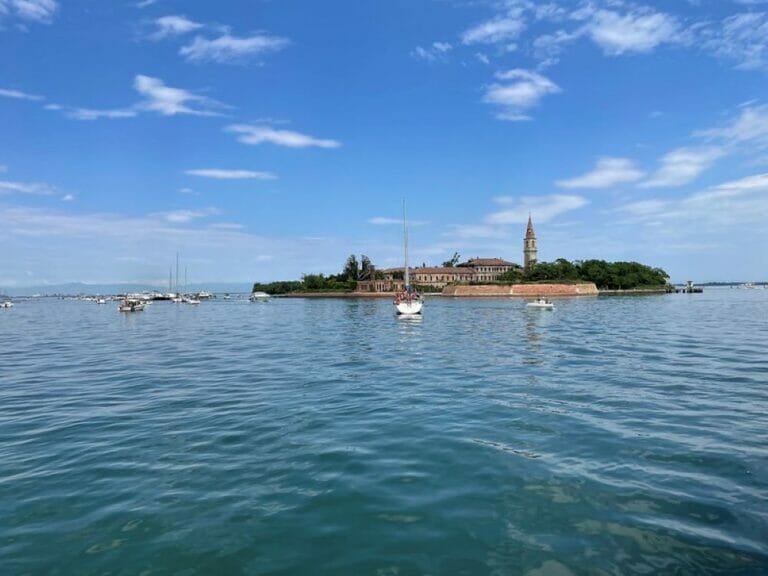
View our tours in these cities
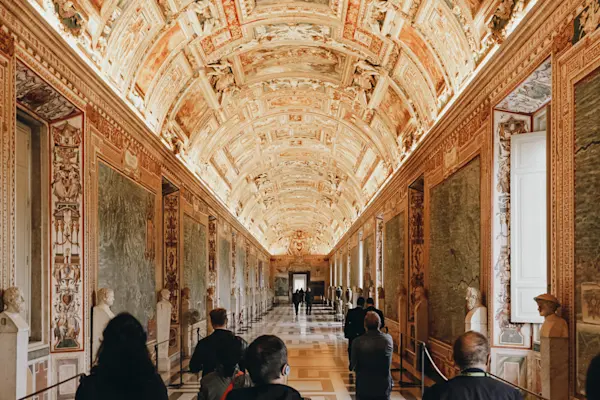
Contact Information

- Help Center
- Terms & Conditions
- Cancellation Policy
- Health & Safety
- Privacy Policy
- Cookie Settings
- Travel Agents
Account Options
2024 guide to spending a day in Venice with itinerary idea
Because very often, when we visit Italy , we generally only have 1 day or 2 to visit the most emblematic cities of the country.
So, if this is your case, here is a guide to fully enjoy your 1-day visit to Venice. Indeed, you will see that with a well-planned itinerary you can discover the main attractions of Venice and learn more about its fascinating history.
This is how I discovered this magnificent city myself by following a self-guided walking tour for which you will find the Google maps itinerary below.

How to visit Venice and what to see in 1 day?
If you want to visit Venice in one day without staying 1 night, consider paying in advance. new access tax to Venice .
That said, to visit Venice in a single day, you have several choices depending on your desires:
- Guided group tour of central Venice + Doge's Palace + Saint Mark's Basilica
- Private tour of Venice with a guide just for you
- Discover Venice by boat
- Venice walking tour by following my self-guided tour which takes a full day and allows you to see the essential of Venice . See itinerary details below.
The trap to avoid, when you only have 1 day to visit a city like Venice, is to go to the heart of the city and go a little randomly without any particular program. Indeed, there is nothing like wasting time, struggling to find a site or traveling miles and not seeing half of the things.
To optimize my day and make it pleasant, I established in advance the list of the most interesting sites to visit in 1 day. Then, I organized them to do a nice circuit on foot but not at a run. Indeed, it is possible to visit all the emblematic monuments of Venice in one day, provided you are well organized.
For this day of discovery, I had to eliminate visits to museums and many churches. The majority of the stages of this route are to be visited from the outside because to visit them in depth, it would be necessary to pass at least 2 days in Venice especially because of the endless queues, even with a pass or a skip the line.
Where to park your car, what parking in Venice?
If, like me, you arrive in Venice by car via the liberty bridge , you can park for the day in the car park on the Piazzale Roma , which is a central square from where all the bus and vaporetto lines leave and from where my walking tour .
How to make the most of your day?
To make the most of your day, it's important to plan ahead and follow a well-organized itinerary. Start your day early and follow my self-guided tour to visit the city's top attractions.
To help you organize your day in Venice, here is an idea for an itinerary:
- Morning: Visit the most beautiful monuments located in the historic heart of Venice
- Noon: Lunch in a local trattoria and tasting of Venetian specialties
- Afternoon: Walk along the canals and explore the picturesque neighborhoods further east of Venice
- Evening: Gondola ride and dinner in a romantic restaurant
Don't forget to take the time to soak up the unique atmosphere of Venice by strolling along the canals and getting lost in the charming alleyways.
Finally, end your day by dining at one of the many Venetian restaurants and enjoying a glass of local wine.
The most beautiful visits to do in Venice in 1 day
My itinerary with the map below takes a tour of the most beautiful monuments of the Venetian capital and ends with a romantic little gondola ride at dusk.
Here are the most beautiful visits to Venice that you can do by following my walking route:
- Place de Rome (start of the tour);
- Venice Santa Lucia Station;
- Church of San Stae;
- Rialto Bridge;
- Saint Mark's Clock Tower;
- St. Mark's Square;
- St. Mark's Basilica;
- Bridge of Sighs ;
- Doge's Palace ;
- Pont della Paglia;
- Sant Giorgio Maggiore viewpoint;
- Danieli Gondola Station for a romantic gondola ride .
Google Maps route to visit Venice
If you follow my self-guided tour, you will need to walk between 3 and 4 kilometers during the day. This is quite little because you can do 2 kilometers in the morning and 2 kilometers in the afternoon. It all depends on your pace but it's very easy.
From the Piazzale Roma , you can follow my itinerary step by step, the interactive map of which you will find below.
And here is how your day in Venice will unfold:
Here are the detailed steps of my walking tour which allows you to visit Venice in 1 day:
- Once you arrive in Venice, either you leave like me from the Piazzale Roma , (departure of my walk), either you start from my 2 rd stage (from Venice-Santa-Lucia station).
- So from the Piazzale Roma car park, you have to go to the avenue Santa Chiara Foundation and turn left towards the Constitution Bridge that the Italians call Calatrava Bridge named after the architect who designed it.
- By taking this bridge, you cross the Grand Canal and continuing straight on, you will come to the Venice Santa Lucia Station .
- From the station, you will have to continue to the left to take the Degli Scalzi bridge ou Pont des Déchaussés (2nd bridge which crosses the Grand Canal).
- Continue to San Stae Church where you can take a short break and have a coffee ... From there, it will take you 10 minutes to walk to the Rialto Bridge (the oldest and most famous of the bridges in Venice). You can climb to the top to admire the view of the Grand Canal and take beautiful photos!

- After crossing the rialto bridge , you will walk about 5 minutes to reach the Saint Mark's Clock Tower which is one of the essentials of the St. Mark's Square .

- Since the St. Mark's Square which is one of the most famous squares in the world, you will go straight to the St. Mark's Basilica which is opposite.

- The famous bridge of Sighs is located just behind the Basilica. It represents the compulsory passage of the Gondola ride (see the end of the article). Legend has it that if two lovers passed in a gondola under the Bridge of Sighs at sunset, their love would be eternal. But in reality, its name comes from the sigh of the prisoners who crossed the bridge before being locked in prison ...

- After Saint Mark's Basilica , you will turn left to reach in 2 minutes the Doge's Palace which is a simply magnificent example of Venetian Gothic architecture. It was the residence of the doges of Venice until the end of the 18th century. The palace also housed a prison which once housed a certain Casanova...
Now, it’s time for romance with the unmissable gondola ride.
If it is in the district of San Marco that we find the most gondoliers, in particular at the stations Orseolo basin and near the Campo San Moise bridge , I preferred to go through the della Paglia bridge to the gondola station opposite the Danieli hotel . Thus, I was able to enjoy one of the most beautiful views of Venice ( Sant Giorgio Maggiore viewpoint ).
Note that the prices of gondolas are the same everywhere in Venice regardless of where you board. It's 80 to 85 Euros for 30 minutes during the day and 100 € at night.
Unless you book in advance via the Internet: Gondola ride on the canals

Other hidden treasures of Venice
Venice is full of hidden treasures and lesser-known places that only the initiated know about.
If you have time left or you spend an extra day, you can explore neighborhoods of Venice less touristy such as Cannaregio or Dorsoduro. There you will find charming alleys, quaint little cafes and artisan shops.
Also be sure to visit the city's lesser-known churches, such as the Church of Santa Maria dei Miracoli or the Church of San Giorgio Maggiore.
If you still have a little time left and by taking a vaporetto, don't miss:
- The church Saint Mary of Health which is located in the district of Dorsoduro almost at the tip of the island on the other side of the Grand Canal. With its imposing size and white walls, it thrones in splendor facing the Grand Canal.
- The palace Ca'd'Oro with its elegant and majestic facade which houses an art museum. It is one of the most beautiful Gothic palaces in Venice!
If you have more than a day to spend in Venice, you could also visit the islands of Murano and Burano, known for their local crafts and colorful houses.
You could also take a guided tour of Venetian palaces or attend a classical music concert in a historic church.
Where to stay to visit Venice on foot?
Obviously, I would have dreamed of spending a night in a real Venetian palace and I know that there are magnificent ones transformed into luxury hotels or Palaces.
But my small budget did not allow it. So I opted for a nice hotel but above all very well located in the historic heart of Venice and at a price that I would qualify as reasonable for Venice!
The rooms are small, but well equipped and clean. In addition to its perfect geographical location in the most beautiful district of Venice .
The biggest advantage of this hotel is its roof top from which you can see the Doge's Palace! For my budget, it was the hotel at the best value for money that I have found and that I allow myself to recommend.
See this hotel on Booking
Fancy another city tour in Europe? So stay in Italy and visit Rome on foot ou Florence in 1 day Why not a little weekend in Lisbon?
Similar publications

Lisbon in 2 days - Walking tours + essential itinerary map

Dublin neighborhoods to avoid and best places to stay

Where to go in Ibiza to party - Where to stay in Ibiza near the best clubs

Dangerous neighborhoods in Warsaw and the best areas to stay
Leave comments cancel reply.
Your email address will not be published. Required fields are marked with *
4 thoughts on “2024 guide to spending a day in Venice with itinerary idea”
Bo dia! Vi que ficou num hotel bem localizado, porém, para quem está com malas, dizem que é ruim a locomoção, correto? Acho que por isso vou preferir ficar num hotel próximo a estação. O que me diz? Thank you!
Good morning, Tudo depende está to procure de conveniência or prazer. Estar a 50 metros da Ponte dos Suspiros e mesmo ao lado dos mais belos monuments de Veneza é, na minha opinião, mais agradável do que ficar ao lado da estação. Mas esta é apenas a minha opinião. But whatever stay or hotel you have, there will be an optimal estadia in Venice! Desfrute your future life!
For the walking tour of Venice, the return is the same as the outward? So it takes twice the time?
Hi Melanie, For the return, I advise you to walk back to the Rialto station (Riva del Ferro). There you can take vaporetto line 2 (to be checked locally) which will take you directly along the Grand Canal to Piazzale Roma (stop 5031). The journey is done in 15 minutes and will save you a little fatigue. Have a nice trip !

24 Top-Rated Tourist Attractions in Venice
Written by Barbara Radcliffe Rogers Updated Dec 22, 2023 We may earn a commission from affiliate links ( )
In a city as filled with tourist attractions as Venice, it's hard to know where to begin. Perhaps the best way is to simply get lost for a few hours wandering through its enchanting little streets and passageways, strolling beside its canals, and finding its secret corners.
At every turn, you'll see something worth remembering with a photo. No matter where this exploration takes you, it's easy to find your way back to Piazza San Marco and the Grand Canal. Most of the best sights you'll want to visit lie around these two landmarks.
Venice is divided into six sestieri, neighborhoods that have distinctly different characters. San Marco is the central one, surrounded on three sides by a great loop in the Grand Canal. Across Rialto Bridge is the artisans' neighborhood of San Polo, and across the Grand Canal to the south is stylish Dorsoduro, with its prestigious art museums and lively squares.
At the outer edges are Santa Croce, Castello, and Cannaregio, home of the original Ghetto. Beyond the six sestieri – neighborhoods – of the city itself, you'll want to hop aboard a vaporetto to its islands: Lido, Murano, Burano, and Torcello. A fourth island, San Giorgio Maggiore, is worth visiting for the beautiful views of San Marco and Venice from the tower of its church.
To plan your stay so you won't miss any of the best places to visit, use this list of the top attractions and things to do in Venice.
1. St. Mark's Basilica
2. piazza san marco (st. mark's square), 3. palazzo ducale (doge's palace) and bridge of sighs, 4. canale grande (grand canal), 5. ponte di rialto (rialto bridge) and san polo, 6. torre dell'orologio (clock tower), 7. campanile, 8. santa maria della salute, 9. scuola grande di san rocco, 10. teatro la fenice, 11. ca' d'oro, 12. murano and burano, 13. peggy guggenheim collection, 14. explore the ghetto and museo ebraico di venezia, 15. santa maria gloriosa dei frari, 16. gallerie dell'accademia (fine arts museum), 17. santa maria dei miracoli, 18. palazzo rezzonico, 19. torcello island, 21. hear classical music in a church, 22. contarini del bovolo palace, 23. ca' pesaro and galleria d'arte moderna, 24. the arsenal and the museum of naval history, where to stay in venice for sightseeing, tips and tours: how to make the most of your visit to venice, venice, italy - climate chart, more things to see and do.
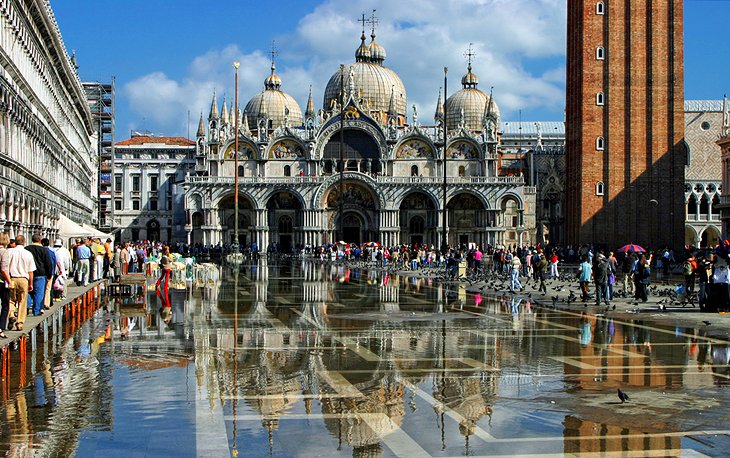
Certainly Venice's best-known church, and one of the most easily recognized in the world, St. Mark's Basilica (Basilica di San Marco) was originally the Doge's private chapel, decorated with Byzantine art treasures that are part of the booty brought back by Venetian ships after the fall of Constantinople.
The gold-backed mosaic pictures above the doorways on the façade only hint at the mosaic artistry inside, where 4,240 square meters of gold mosaics cover the domes and walls. These set a distinctly Byzantine tone to its soaring interior, but you'll find treasures from other periods, including later mosaics designed by Titian and Tintoretto - names you'll encounter all over the city.
The magnificent golden altarpiece, the Pala d'Oro , one of the finest in Europe, was begun by early 12th-century artists, and centuries later, adorned with nearly 2,000 gems and precious stones. If you can tear your eyes from this, the mosaic domes, and the multitude of richly decorated altars, glance down at the floor, a masterpiece of marble inlay. And take time to see the gold reliquaries and icons in the Treasury.
- Read More: Exploring St. Mark's Basilica in Venice: A Visitor's Guide
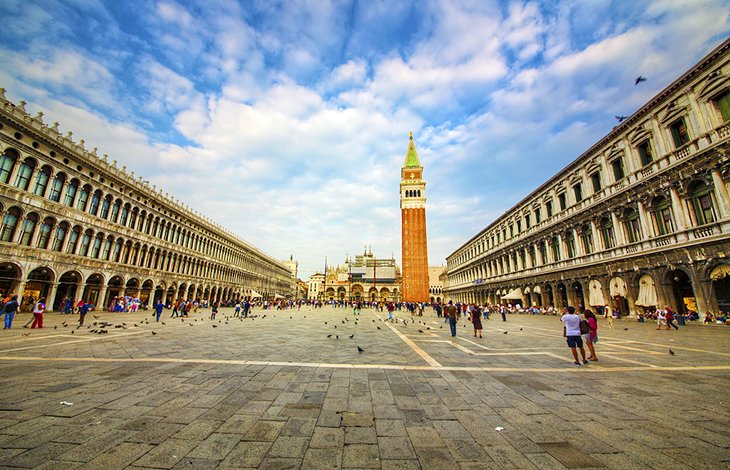
The vast expanse of Venice's largest square is brought together and made to seem almost intimate by the elegant uniformity of its architecture on three sides. But more than its architectural grace, St. Mark's Square (Piazza San Marco) is loved as Venice's living room, the place everybody gathers, strolls, drinks coffee, stops to chat, meets friends and tour guides, or just passes through on the way to work or play.
Three sides are framed in arcades, beneath which are fashionable shops and even more fashionable cafés. The open end is bookmarked by the erratic, exotic curves, swirls, mosaics, and lacy stone filigree of St. Mark's Basilica .
Above it towers the brick shaft of the campanile. For overviews of this busy piazza, you can go to its top or to the top of the Torre dell'Orologio , where a pair of "Moors" strikes the hour.
Author's Tip: Don't be tempted to sit on the steps around the piazza to eat a take-away sandwich. Or throw the crumbs to the pigeons. Both are illegal.
- Read More: St. Mark's Square, Venice: 12 Top Attractions, Tours & Nearby Hotels
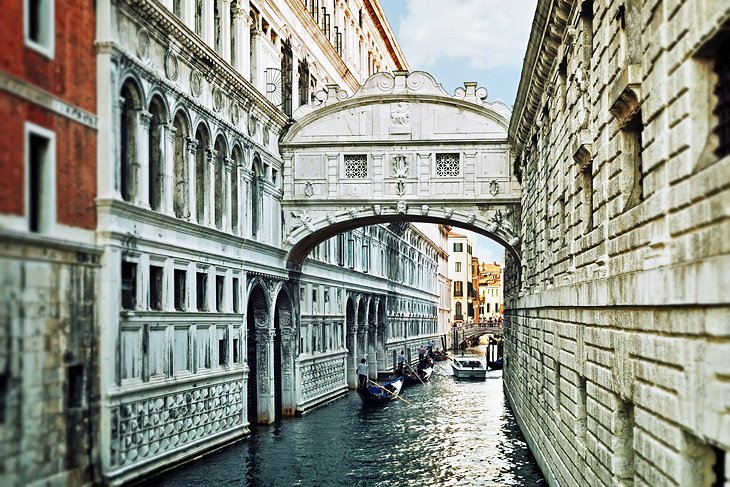
Visitors arriving in Venice once stepped ashore under the façade of this extraordinary palace. They couldn't have failed to be impressed, both by its size and the finesse of its architecture.
If they were received inside by the Doges, the impression would only strengthen as they entered through the Porta della Carta, a perfect example of Venetian Gothic at its height, and ascended the monumental Scala dei Giganti and the gold-vaulted Scala d'Oro to be received in what many consider to be the palace's most beautiful chamber, Sala del Collegio.
Even jaded 21st-century travelers gasp in awe at the palace's grandeur and lavish decoration. You'll see works by all the Venetian greats, including Tintoretto, whose Paradise is the largest oil painting in the world.
Not open on public tours but included on private tours is a walk across the Bridge of Sighs to the dark cells of the Prigioni - the prisons from which Casanova made his famous escape. The best view - and the postcard classic - of the Bridge of Sighs is from the Ponte della Paglia , on the Riva degli Schiavoni behind the Doge's Palace.
Lines for admission to the Doge's Palace are often long, but you can avoid these, and see sections of the palace not open to general visitors, with a Skip the Line: Doge's Palace Ticket and Tour . A local guide will take you past the lines and explain the history and art in each of the dazzling rooms before leading you across the Bridge of Sighs and into the notorious prison.
- Read More: Exploring the Doge's Palace in Venice: A Visitor's Guide
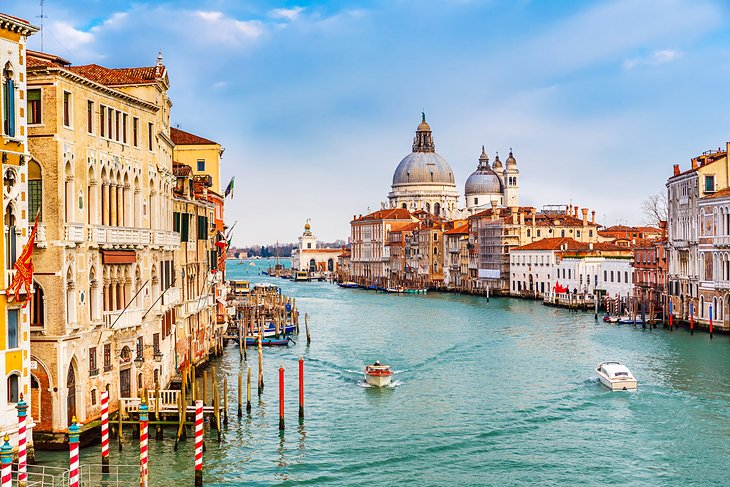
Sweeping through the heart of Venice in a giant reverse S curve, the Grand Canal is the principal boulevard through the city, connecting Piazza San Marco , Rialto Bridge, and the arrival points of the rail station and bridge from the mainland.
Only four bridges cross its 3.8-kilometer length, but stripped-down gondolas called traghetti shuttle back and forth at several points between bridges. The Grand Canal was the address of choice for anyone who claimed any influence in Venice. Palaces of all the leading families open onto the canal, their showy Venetian Gothic and Early Renaissance facades facing the water, by which visitors arrived.
These grand palaces – or at least their facades – are well preserved today, and a trip along the canal by vaporetto, Venice's floating public transport system, is the best way to see them. Or you can see the palaces at a more leisurely speed on a Venice Grand Canal Small Group 1-Hour Boat Tour , which also includes some of the smaller canals. And, of course, a ride along the Grand Canal in a gondola is one of the most romantic things to do in Venice at night.
- Read More: Exploring the Grand Canal in Venice: Top Attractions
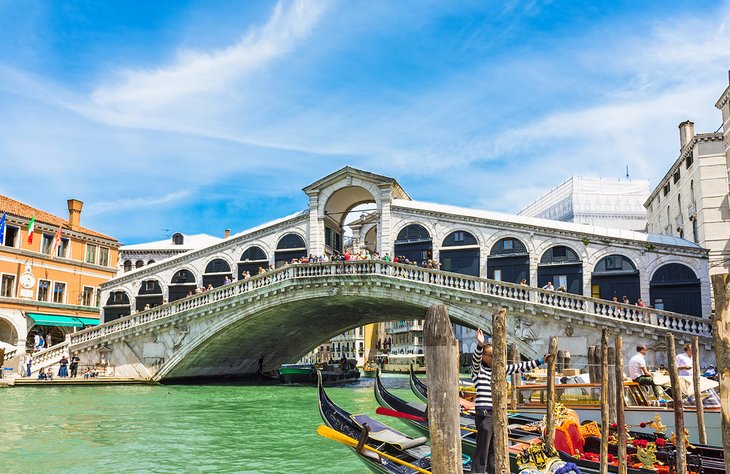
Once the only bridge across the Grand Canal , Rialto Bridge marks the spot of the island's first settlement, called Rivus Altus (high bank). Built in 1588, some 150 years after the collapse of a previous wooden bridge, this stone arch supports two busy streets and a double set of shops.
Along with serving as a busy crossing point midway along the canal, it is a favorite vantage point for tourists taking - or posing for - photos, and for watching the assortment of boats always passing under it.
The church of San Bartolomeo , close to the San Marco end of the bridge, was the church of the German merchants who lived and worked in the Fondaco dei Tedeschi (German Commodity Exchange) bordering the canal here. It has an excellent altarpiece, The Martyrdom of St. Bartholomew , by Palma the Younger. The former exchange is now a popular place to go shopping.
On the other side of Rialto Bridge is the busy food market, where Venetians and chefs shop for fresh produce and seafood. In the narrow streets of San Polo, beyond the market, are artisans' shops and mask-making studios, one of the best places for shopping in Venice . You'll also find places to eat that are not so filled with tourists as those nearer San Marco.
Author's tip: If you're visiting Venice with children , look for the carnival mask and costume studios in San Polo. Masks are inexpensive souvenirs of their trip to Venice.
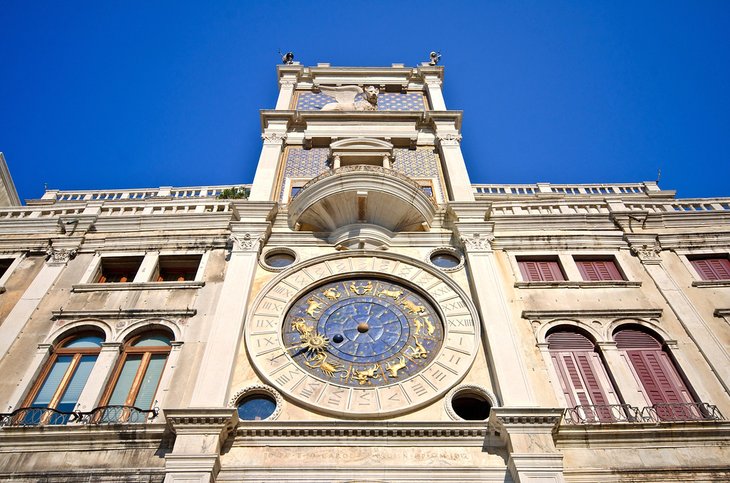
To one side of the basilica, facing onto Piazza San Marco, is one of Venice's most familiar icons, a clock tower surmounted by a pair of bronze Moors that strike the large bell each hour. The face of the clock shows phases of the moon and the zodiac in gilt on a blue background, and above the clock is a small balcony and a statue of the Virgin.
Above that, the winged Lion of St. Mark and a mosaic of gold stars against a blue background were added in 1755 by Giorgio Massari. The tower itself is from the 15 th century and typical of Venetian Renaissance architecture. Through an arched gateway at its base runs one of Venice's busiest streets, the narrow Calle Mercerei.
If you're in Venice during Ascension Week or at Epiphany, as the Moors strike each hour, you can see the Three Kings led past the Madonna by an angel. You can climb the tower for a closer look at the clockwork.
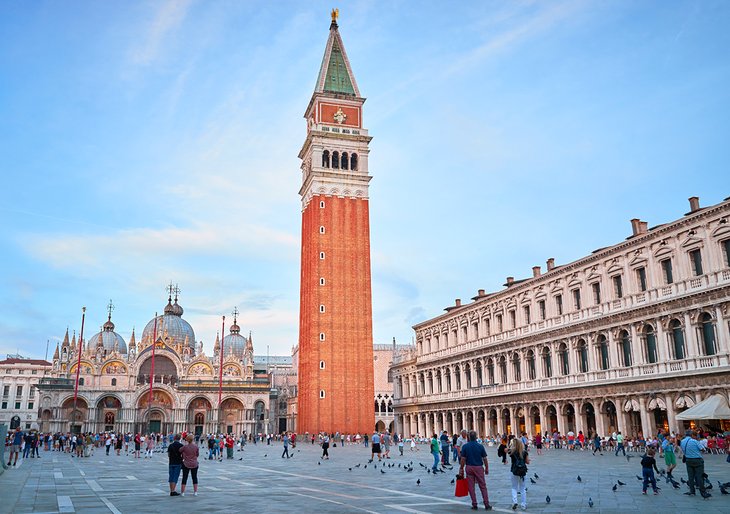
Standing like a giant exclamation point above the expanse of Piazza San Marco, the Campanile is not the first to stand here. The original one, erected as a lighthouse in 1153, collapsed dramatically into the piazza in 1902, and was rebuilt on a firmer footing. Also rebuilt was the Loggetta at its base, a small marble loggia completed in 1540, where members of the Great Council assembled before meeting in the sessions.
In the loggia at the base, you can see Sansovino's four bronze masterpieces between the columns, all of which were rescued from the rubble after the collapse. The Campanile has a grimmer side to its history: in the Middle Ages, prisoners, including renegade priests, were hoisted halfway up the outside in cages, where they hung suspended for weeks.
Today, the Campanile is a popular attraction for the views from the platform on top, which extends across the city and lagoon to the Adriatic (try to go early or late in the day, as lines for the lift can be very long).
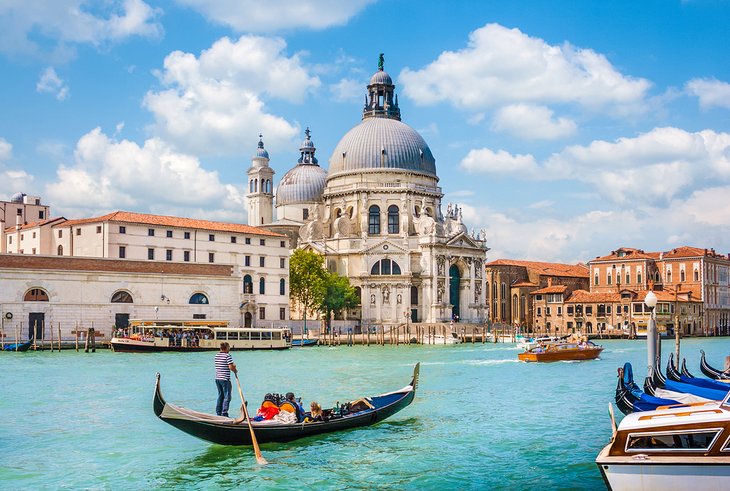
One of the most photographed churches in Venice, Santa Maria della Salute has a postcard setting, rising at the tip of a peninsula across from the Doge's Palace.
The monumental Baroque church was built as thanks for the end of the plague of 1630. But the fragile land wouldn't support its tremendous weight, so its architect, Baldassare Longhena, had more than a million timbers driven into the floor of the lagoon before he could erect the church.
The vaporetto landing is right in front of the church, and the highlight of its interior – apart from the magnificent dome – is the Sacristy, where you'll find paintings that include Tintoretto's Marriage at Cana .
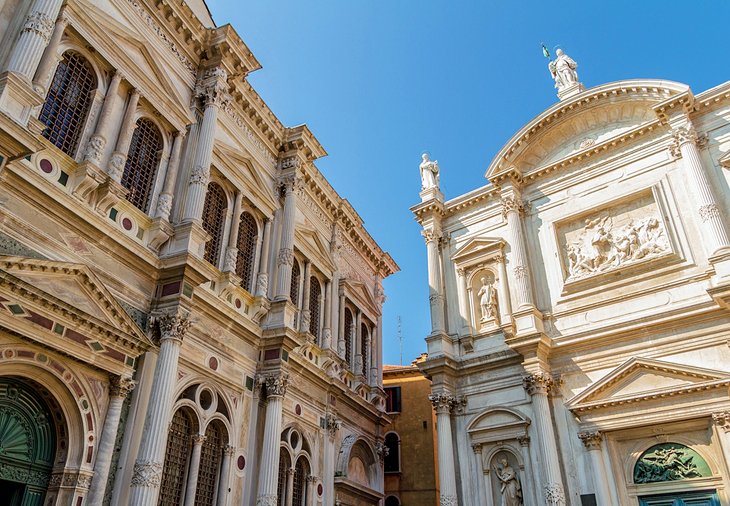
This impressive white marble Scuola Grande di San Rocco was built between 1515 and 1560 to house a charitable society dedicated to San Rocco. Soon after its completion, the great 16th-century Venetian artist Tintoretto won the competition to paint a central panel for the ceiling of the Sala dell'Albergo by entering the building and putting his painting in its intended place before the judging, much to the irritation of his rival artists.
He later decorated its walls and ceilings with a complete cycle of paintings, which are considered to be the artist's masterpiece. The earliest works, in the Sala dell'Albergo, date to 1564 and 1576 and include The Glorification of St. Roch, Christ before Pilate, the Ecce Homo, and the most powerful of all, The Crucifixion . Those in the upper hall depict New Testament scenes, painted between 1575 and 1581.
The lighting is not good, and the paintings themselves are dark, but you can still appreciate Tintoretto's innovations in the use of light and color. You can see the ceilings more easily with one of the mirrors that are provided. More works by Tintoretto are in the chancel of the adjacent church of San Rocco.
Address: Campo San Rocco, San Polo, Venice
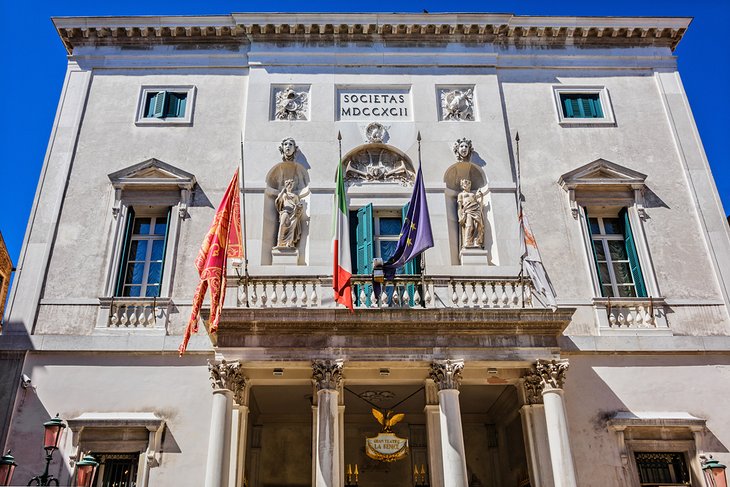
The name La Fenice (The Phoenix), chosen at the constriction in 1792, proved prophetic, as like the mythical phoenix, it has risen from the ashes. The theater has been destroyed by fire three times, the last one, in 1996, leaving only the outer walls standing. Each time, it has been rebuilt, and continues to be one of the world's great opera houses.
Throughout its history, but particularly in the 19th century, La Fenice saw the premiers of many of the most famous Italian operas, including those of Rossini, Donizetti, and Verdi, and today schedules performances of opera, ballet, and musical concerts.
Even after its reopening in 2003 with somewhat expanded seating, La Fenice is still a comparatively small opera house, so tickets are very hard to get, especially for major performances. You can take a tour of the spectacular Rococo interior, however, using an audio guide; these self-guided tours last about 45 minutes and include the public areas of the theater.
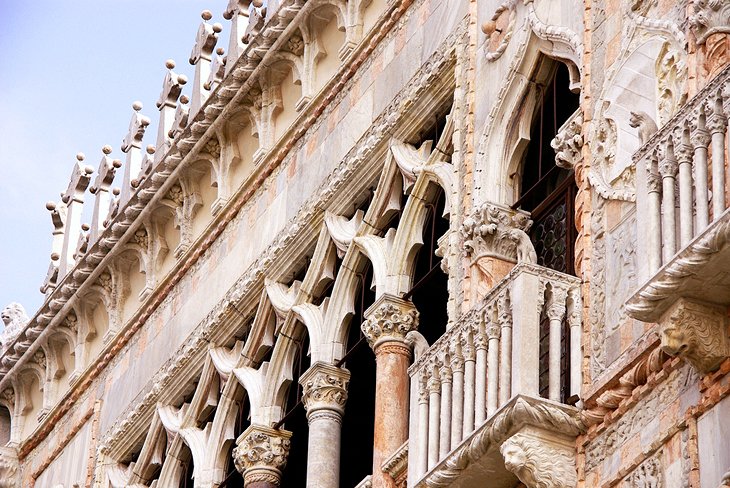
The delicate marble filigree by Bartolomeo Bon seems too lace-like to be carved of stone, and you can only imagine the impression this façade must have made covered in its original paint and gold. Along with the Porta della Carta in the Palazzo Ducale , also created by Bartolomeo Bon, The Ca' d'Oro is considered the most perfect example of Venetian Gothic.
You can admire the interior, too, as this palazzo is now an art museum, restored to provide both a setting for the art works and a look at the way wealthy Venetians lived in the 15th and 16th centuries. The connoisseur responsible for saving the palace, Baron Giorgio Franchetti, gave his art collection to the state in 1922, with works by Titian, Mantegna, Van Dyck, Tullio Lombardo, and Bernini.
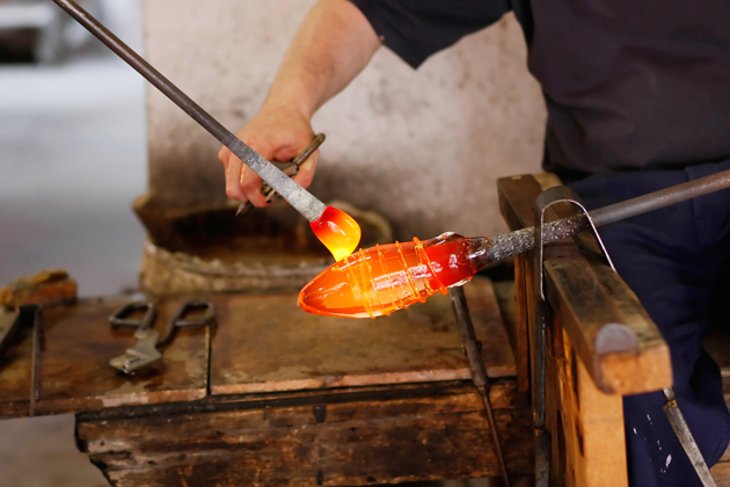
A trip to Venice wouldn't be complete without hopping aboard a vaporetto for the ride across the lagoon to Murano, home of Venice's fabled glass workers. They were sent here in the 13th century in hope of decreasing the risk of fire from one of the glass furnaces sweeping through Venice's tightly compacted center.
Or so they claimed. Just as likely, it was to keep the secrets of glassblowing a Venetian monopoly. This was no small matter to the Venetians, whose Council of Ten decreed in 1454: "If a glassblower takes his skill to another country to the detriment of the Republic he shall be ordered to return; should be refuse, his nearest relatives shall be thrown into prison so that his sense of family duty may induce him to return; should he persist in his disobedience secret measures shall be taken to eliminate him wherever he may be." It was a lot easier to keep track of them if they were confined to an island.
The canal sides today are lined by glass showrooms and studios, showing everything from cheap imported trinkets to exquisite works of art. Inside the 17th-century Palazzo Giustinian is the Glass Museum , with one of the largest and most important collections of Venetian glass from the time of the Romans to the 20th century.
But it's not all glass: The church of Santi Maria e Donato combines Veneto-Byzantine and Early Romanesque features, a result of its various stages of building between the seventh and 12th centuries. Notice especially the columns of Greek marble with Veneto-Byzantine capitals, the 12th-century mosaic floor with animal figures, and the St. Donato above the first altar on the left. Dated 1310, it is the earliest example of Venetian painting.
The 14th-century San Pietro Martire contains several splendid Venetian paintings: Bellini's Madonna in Majesty with St. Mark and the Doge Agostino Barbarigo and his Assumption of the Virgin , along with St. Jerome in the Wilderness and St. Agatha in Prison by Paolo Veronese.
It's a quick hop to the next island, Burano, a fishing village of brilliantly painted houses, known historically for its lace making. The Scuola dei Merletti (lace school) and its small museum will help you distinguish the real thing from the cheap imports you'll find in most shops.
The slender campanile of the 16 th -century church of San Martino leans at an alarming angle, made all the more dramatic by its height.
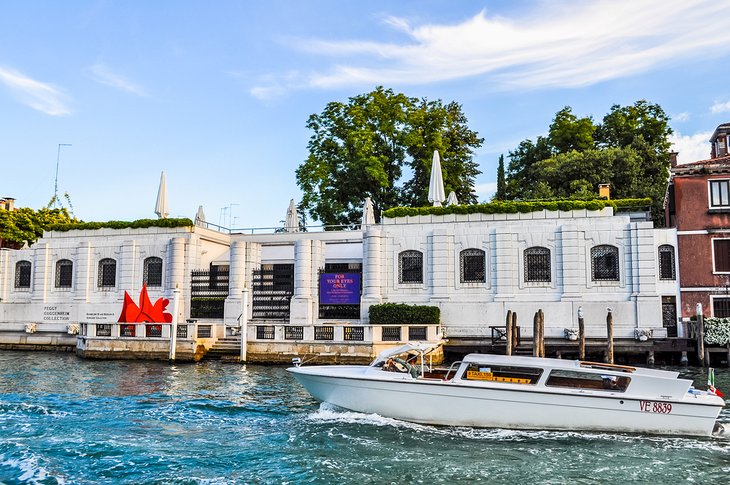
The personal art collections of heiress Peggy Guggenheim are housed in her former home alongside the Grand Canal, Palazzo Venier dei Leoni. Although most of Italy's great art museums are filled with masters of the Middle Ages and Renaissance, the Peggy Guggenheim concentrates on American and European art from the first half of the 20th century.
The low building, with its spare, white interior, is a fitting venue for these bold and often dramatic works, which represent Cubist, Futurist, Abstract Expressionist, Surrealist, and avant-garde schools of painting and sculpture.
The permanent collection includes works by Picasso, Dali, Braque , Léger , Mondrian , Kandinsky , Klee, Ernst , Magritte , and Pollock , and frequent exhibitions bring in works from other major artists. In the museum's sculpture gardens are works by Calder , Holzer , Caro , Judd , and Hepworth .
Address: 704 Dorsoduro, Venice
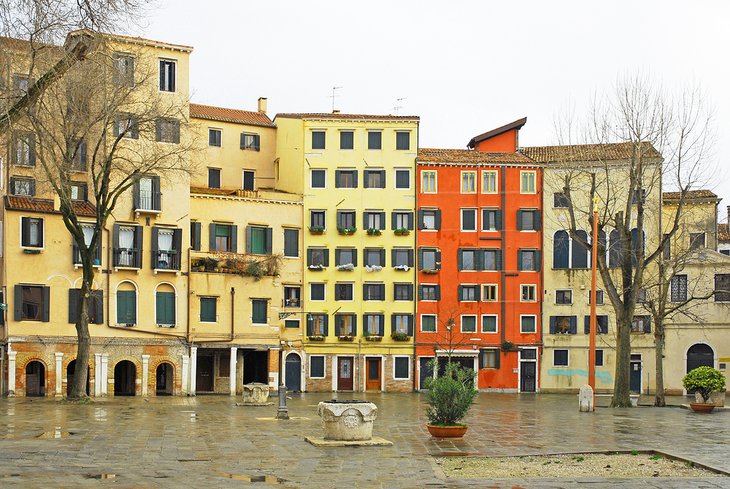
The Venetians called the foundry here geto , and in 1516 it was decreed that all Jews in the city would live on this islet, the origin of the word "ghetto." Residents could only leave in the daytime, and the gates were locked and guarded at night.
This part of the Cannaregio sestiere still has distinct Jewish presence, with synagogues and the Museo Ebraico di Venezia (Jewish Museum) with artifacts of Jewish life here from the 17 th and later centuries. Facing the Ghetto Nuovo Square, a touching memorial of bronze panels, created in 1980 by artist Arbit Blatas, remembers the victims of the deportation during the Nazi occupation of the city in 1943.
Address: Museo Ebraico di Venezia, Campo del Ghetto Nuovo, Cannaregio
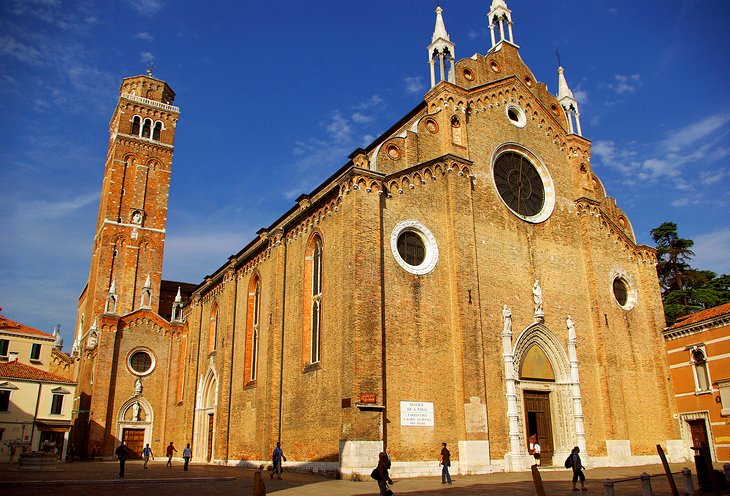
This Gothic church was begun by the Franciscans about 1340 and finished with the completion of the facade, interior, and two chapels in the middle of the 15th century. Its impressive 14th-century campanile is the second highest in the city.
Although the interior is in keeping with the simple unadorned style of Franciscan churches, it contains a wealth of artistic treasures. In the right transept is an important wood statue of St. John the Baptist by Florentine sculptor Donatello, done in 1451 (first chapel to the right of the sanctuary).
In the sacristy is a triptych Madonna and Child Enthroned with Four Saints by Giovanni Bellini. In the left transept, the statue of St. John the Baptist on the stoup of the Cappella Cornaro was created by the sculptor and master-builder Jacopo Sansovino
The Monks' Choir is an outstanding example of the wood-carving of Marco Cozzi, with reliefs of saints and Venetian scenes. And the sanctuary contains the tomb of two Doges by Antonio Rizzo, and over the high altar is Titian's Assunta , painted between 1516 and 1518. The Mausoleum of Titian in the south aisle was a gift from Ferdinand I of Austria, when he was King of Lombardy Veneto.
You can't help noticing the pyramidal mausoleum made by the students of the sculptor Antonio Canova in the north aisle, and opposite, the large monument to Titian, also by students of Canova. Beside the Cappella Emiliani, which has a fine mid-15th-century polyptych with marble figures, is Madonna di Ca' Pesaro , completed in 1526 and one of Titian's most important works.
Address: Campo dei Frari, I-30100 Venice
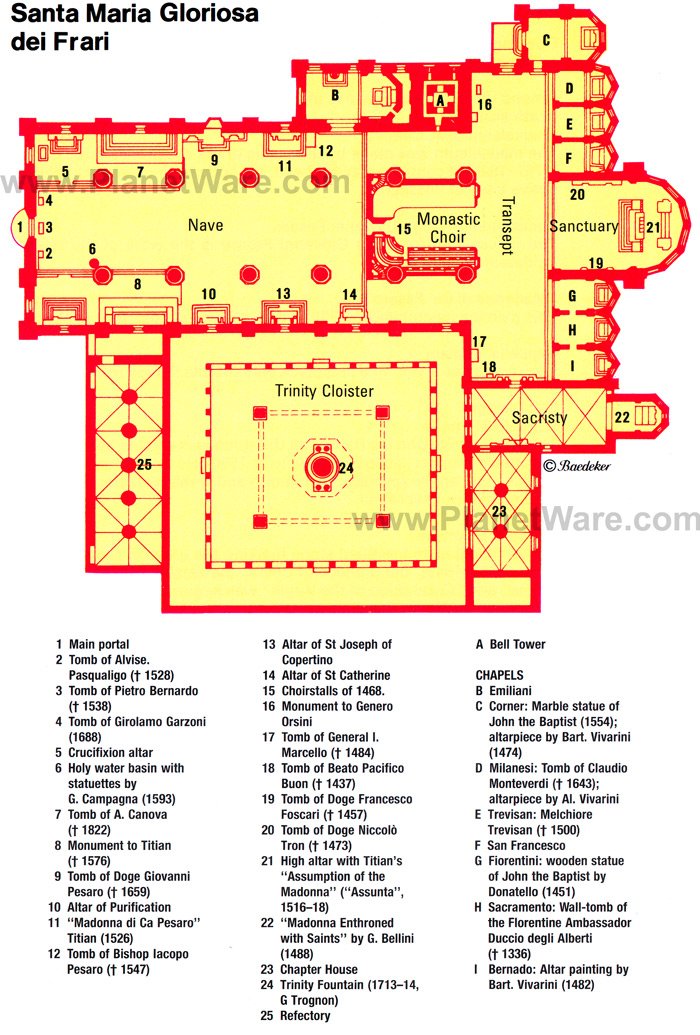
Called " The Accademia " for short, this museum on the Grand Canal has the most important and comprehensive collection of 15th-18th-century Venetian painting in existence. Much of the collection was assembled from monasteries and churches that were closed and from the clearing of palaces of noble families, now displayed in the former Monastery of Santa Maria della Carità.
Some of the galleries, such as the first one, which contains Venetian Gothic Painting, have richly carved and gilded 15th-century ceilings. Works are arranged chronologically, so you can not only trace the evolution of styles, but can compare the works of contemporaries.
Highlights of the 15th- and 16th-century paintings are St. George by Andrea Mantegna, St Jerome and a Donor by Piero della Francesca, Madonna and Saints by Giovanni Bellini, Portrait of Christ by Vittore Carpaccio, and Madonna under the Orange Tree by Cima da Conegliano.
St. John the Baptist and a magnificent Pietà by Titian, Tintoretto's Cain and Abel and The Miracle of St. Mark, Paolo Veronese's Marriage of St. Catherine and Supper in the House of Levi , St. Ursula by Vittore Carpaccio, and several works by Giambattista Tiepolo are also worth special notice.
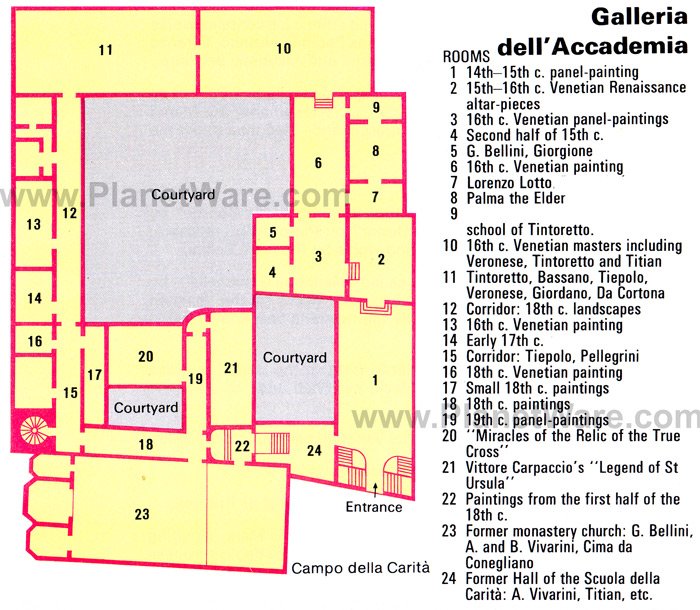
After the vast grandeur of St. Mark's and the soaring expanse of Frari, little Santa Maria dei Miracoli is like a fresh breeze, a masterpiece of Early Renaissance architecture by Pietro Lombardo. This jewel box of pastel inlaid marble was built from 1481 to 1489 to enshrine a miraculous picture of the Virgin.
Unlike Venice's other churches, whose facades are embellished with architectural flourishes and statues, Lombardo used painstakingly matched colored marble to create delicate patterns of rosettes, circles, octagons, and crosses on the facade. The method continues inside, which heightens the effect of the golden domed ceiling rising above gray and coral marble walls.
The nave is separated from the chancel by an exquisite Early Renaissance balustrade decorated with figures. It's no wonder that this is Venetians' favorite place to be married, as its interior is one of the most beautiful in the city.
Address: Campo dei Miracoli, Venice
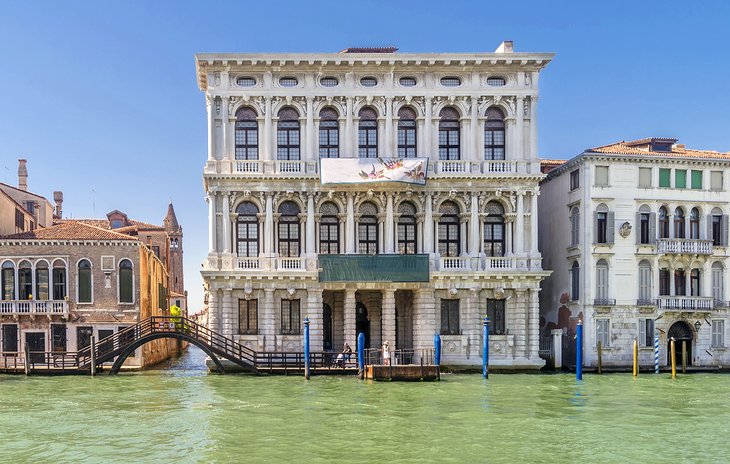
Just as Ca' d'Oro lets you glimpse into the life of the late Middle Ages, Palazzo Rezzonico gives a vivid picture of life here in the Baroque and Rococo periods, in the 18th century. Designed and begun by Venice's master of Baroque architecture, Baldassare Longhena, the palace was completed nearly 100 years later in 1750 by Giorgio Massari.
The furnishings and collections complete the picture painted by the building, including its interior decoration of silk wall coverings, elegant finish details, and Flemish tapestries. The costume collection highlights the importance of silk production in Venice from the late Middle Ages through the 18th century, when it was a major competitor with Lyon, France.
Rigid technical regulations were enforced, resulting in some of the most beautiful silk fabrics ever made. So important was silk that even in times of war with the Turks, battle lines parted for the silk-laden ships to pass through.
The museum details the importance of luxury goods, particularly clothing and fashion, for the Venetian economy in the 18th century, when brocades embellished with gold and silver thread produced here were treasured throughout Europe and the New World.
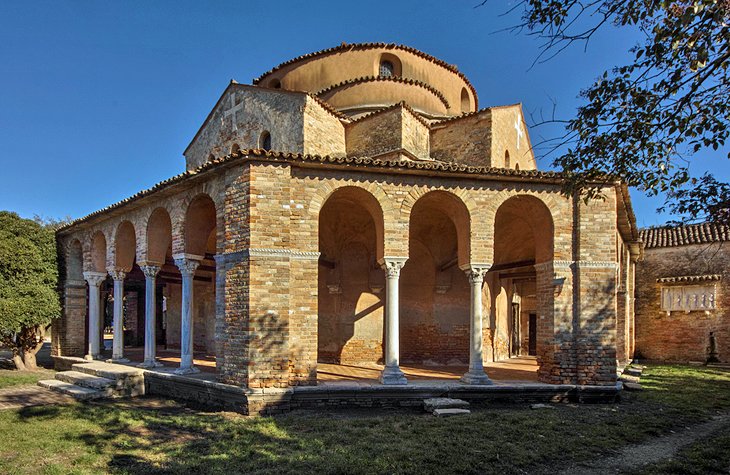
Venice began on this outer island of Torcello, founded here as early as the seventh century, and by the 12th century, it was a flourishing commercial town. Of its palaces, churches, shipyards, and docks, only two churches and a handful of houses remain, dotted over the large island.
You can get some idea of the importance of Torcello from its cathedral, dedicated in 639 to Santa Maria Assunta . It is considered the best remaining example of Venetian-Byzantine architecture. It was reconstructed in 834 and 1008, and the portico and two lateral apses were added in the ninth century; much of the building dates from the 11th century. The mosaics lining the interior are outstanding.
The oldest of these are in the chapel to the right of the high altar, where 11th-century angels carrying a medallion with the Lamb of God show a strong Byzantine influence. The Fathers of the Church ; Gregory, Martin, Ambrose, and Augustine; were added later, along with Christ in Majesty between two Archangels .
The 12th-century mosaics in the main apse and the Virgin and Child above a frieze of the Twelve Apostles surrounded by flowers are all on a gold background. The west wall is covered in tiers of a Byzantine mosaic of the Last Judgment from the late 12th or early 13th century.
Along with the exquisitely detailed marble carvings on the rood screen, notice the 11th-century mosaic floor and the pulpit, which was assembled in the 13th century from earlier fragments.
Adjoining the cathedral is the little 11th-century church of Santa Fosca , on a pure Byzantine central plan with a portico. Your admission ticket includes the interesting little historical museum with artifacts from antiquity to the 16th century.
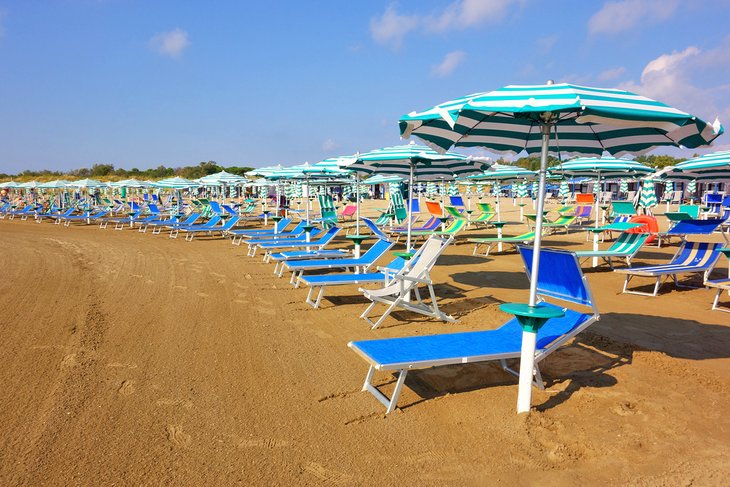
The long (12-kilometer) strip of sand that separates the Venetian lagoon from the Adriatic Sea was Europe's first real beach resort, and in its heyday, at the turn of the 20th century, was Europe's most fashionable watering hole for royalty and the day's celebs. Today, the grand hotels where they reposed still welcome guests and still own the beautiful fine-sand beaches, although for a price you can share them with hotel guests.
Public beaches are at the north end of the island, near the church of San Nicolo, where relics of St. Nicholas are revered. After considerable controversy between Venice and Bari, which also claims the saint's relics, it has been established by an anatomical expert that both have an equal claim; about half the skeleton, including the skull, is in Bari and the other half in Lido. The cloisters are lovely, and in the church are paintings by both Palma the Elder and Younger.
You can tour Lido on foot or a bicycle rented near the landing stage where the 10-minute Motonave or longer vaporetto ride from St. Mark's deposits you. The island is filled with Art Nouveau villas and hotels; to see the villas, wander along some of the side streets. In August and September, the Lido is the venue for the International Film Festival, held in the Palazzo del Cinema.

Two churches in Venice are venues for concerts of classical music , both featuring the works of Venetian composer and virtuoso violinist, Antonio Vivaldi. One of these churches, Santa Maria della Pietà , was Vivaldi's own, where he taught and composed the music for major church feasts. Near Saint Mark's Square, it is a beautiful mid-18 th -century church.
The other church where you can hear concerts is San Vidal church, in Campo Santo Stefano, not far from the Academia bridge. Along with the concerts, the church is notable for its magnificent main altarpiece, San Vidal on Horseback with Eight Saints, painted in 1514 by Vittore Carpaccio. Concerts in both these venues feature "The Four Seasons" and other works by Vivaldi. 123
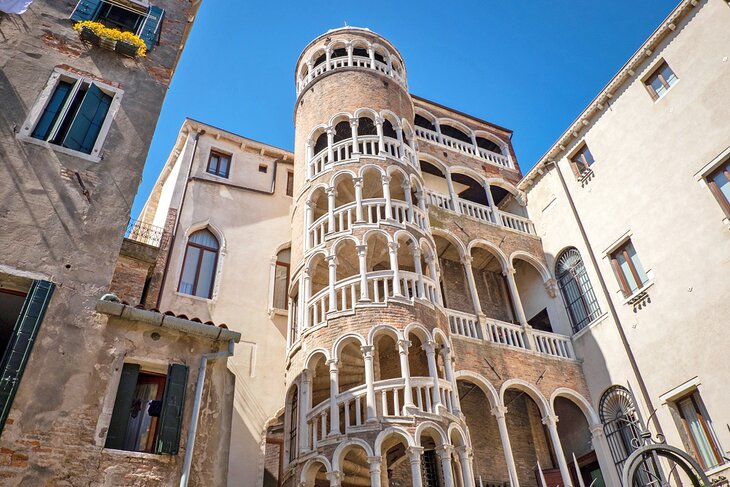
During the 15 th -century renovations of an earlier Gothic building near Campo Manin, a unique spiraling staircase was added to the outside, creating one of the city's most unusual places to visit. The staircase spirals upward, encased by a balustrade and a series of graceful arches that give it an almost delicate air. The building became known as the Contarini del Bovolo Palace , referring to the Venetian word for snail.
Alongside the round tower, a series of 5 layered loggias decreasing in height with each level provides access to the building's five stories. You can see the exterior from the courtyard, or climb the tower for views from the roofed terrace at the top.
Address: San Marco, Campo Manin
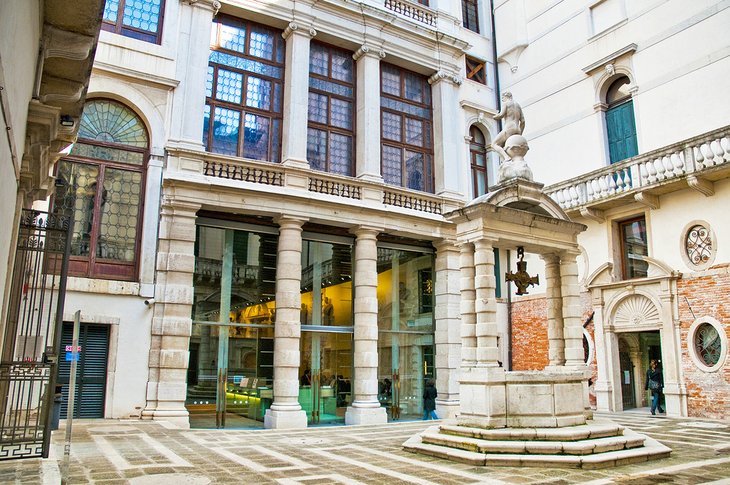
The impressive façade of Ca' Pesaro overlooking the Grand Canal, was inspired by the Sansovino Library that stands across from the Doge's Palace, built a century earlier. The lavish Venetian Late Baroque interior contrasts sharply with the art displayed there, for the palazzo now houses the Galleria d'Arte Moderna.
One of Italy's finest collections of modern art, it contains works by important 19th- and 20th-century painters and sculptors including Gustav Klimt, Marc Chagall, and Auguste Rodin. Highlights include decorative arts of the 20 th century such as works in glass made by Carlo Scarpa in the 1930s and 1940s and rare furniture pieces by the cabinetmaker Carlo Bugatti.
The Museo d'Arte Orientale occupies the third floor of the palace, with collections of fine and applied arts from Asia. Highlights are the Chinese vases and Japanese enamels, porcelains, and armor of the Edo period.
Ca'Pesaro is reached by Vaparetto from the San Stae stop, at the church of Sant'Eustachio, more commonly known as San Stae. Step inside the church to see paintings by early 18th-century artists, including Tiepolo and Pellegrini.
Address: Santa Croce, Venice
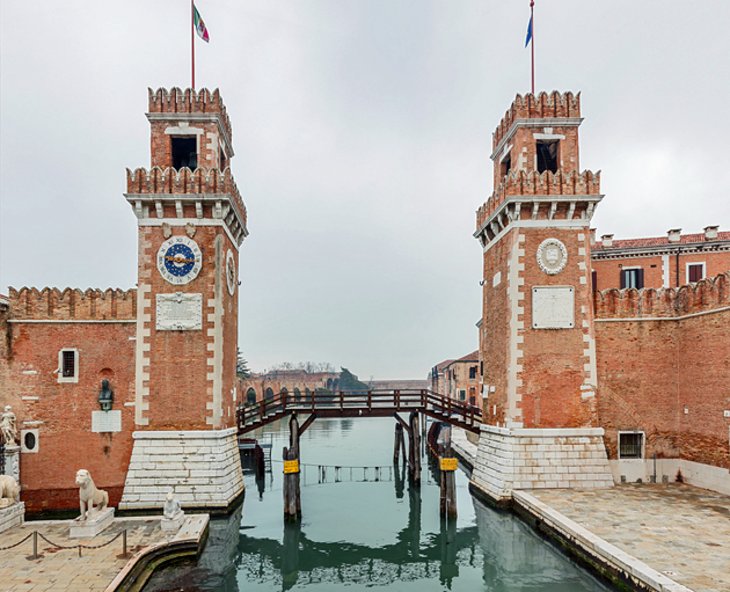
The Arsenal, the shipyard of the Venetian Republic, was the largest and busiest in the world until the end of the 17th century. From its founding in 1104, it was continuously expanded, until in its heyday, it employed as many as 16,000 workers.
Closely guarded to preserve the secret production methods that enabled it to build a fully sea-ready ship in a single day, the Arsenal was accessible by one land and one sea approach only. So tight was its security that the Republic managed to keep its art of shipbuilding secret until about 1550.
At its imposing land entrance is a Renaissance-style triumphal arch guarded by lions brought from Greece as booty after the reconquest of the Peloponnese in the 17th century. Of the two lions on the left, the larger one stood guard over the port of Piraeus, while its fellow stood on the road from Athens to Eleusis.
Adjacent to the shipyard is the Museum of Naval History , displaying impressive booty brought back from the numerous maritime wars of the Republic, along with fascinating collections that include votive paintings made on wood panels in thanks for rescues at sea. These charming pictures are interesting for their depiction of sea life, not so much for their artistic finesse.
Models and artifacts relate to shipbuilding, the types of vessels afloat in the period that Venice was a sea power, and the Republic's strongholds throughout the Adriatic. A large model of the legendary ship of state Bucintoro , the Doge's sumptuous official galley, is especially interesting.
Address: Riva degli Schiavoni, Castello, Venice
While it's nice to stay close to St. Mark's Square, or between there and the Rialto, it's not essential for sightseeing. Attractions are all fairly close, and you'll have to walk between them anyway. Just as important is how close the hotel is to a Vaporetto stop on the Grand Canal. In addition to hotels near San Marco and San Zaccaria stops, consider those near Salute and Academia stops in Dorsoduro. Here are some highly rated and convenient hotels in Venice:
Luxury Hotels :
- Only a few steps from the Salute stop and one stop from St. Mark's, Ca' Maria Adele is a lush island of serenity near the Guggenheim Collection, with antiques-furnished rooms and superb guest services.
- The Gritti Palace, A Luxury Collection Hotel was once the home of a Venetian Doge, and its large, sumptuously appointed rooms (some with balconies) overlook the Grand Canal or a quiet piazza close to St. Mark's.
- Set on a small canal less than two minutes' walk from Piazza San Marco, Bauer Palazzo could hardly have a more convenient location for tourists. Opulent appointments include marble floors and Murano glass chandeliers; guest rooms and the rooftop terrace overlook views of the Grand Canal and other landmarks.
Mid-Range Hotels:
- Elegant and luxurious Hotel Ai Cavalieri di Venezia is also a walk from the Rialto stop, but well located near attractions.
- Londra Palace could hardly be better located, a three-minute walk from St. Mark's at the San Zaccaria stop, with balconies overlooking the lagoon; breakfast is included.
- The large rooms at NH Collection Venezia Palazzo Barocci overlook the Grand Canal, at the San Angelo vaporetto stop.
Budget Hotels:
- In a quiet neighborhood of Santa Croce, a short walk from a Vaporetto stop, about 20 minutes from Rialto and close to a good choice of restaurants, Hotel Tiziano has comfortable rooms and includes breakfast.
- Rio Venezia Hotel is just behind St. Mark's, a block off the Grand Canal.
- Also just steps from St. Mark's, Hotel Orion is on the shortest route to Rialto.
Exploring the Islands:
- A highlight for most travelers is a visit to the islands of Murano and Burano. The easiest way to explore these islands is on a five-hour guided Murano Glass and Burano Lace Tour from Venice , which includes motorboat transport to the islands, with visits to a glassblowing factory on Murano and lace makers on Burano.
Sightseeing and Gondola Rides :
- Venice is a little bit of a maze, and if you have limited time, taking a guided tour is a good idea. The Venice Walking Tour and Gondola Ride includes the best of both worlds, with an opportunity to learn the history of the sites as you wander the city and then relax and enjoy the scenery on a gondola ride.
- Alternatively, to just soak up some of the ambience, skip the walking piece and see the sites from the water on a 35-minute shared gondola ride while being serenaded on the Venice Gondola Ride and Serenade .
- A third option, the Venice Super Saver: Skip-the Line Doge's Palace and St. Mark's Basilica Tours, Venice Walking Tour and Grand Canal Cruise offers priority admission to the two must-see sights with the longest lines, a guided walking tour that takes you to some of Venice's secret sights, and a water-taxi cruise along the Grand Canal.
Good to Know
- Beginning in 2025, day visitors will be charged an access tax of between €6 and €10, depending on the season and expected tourist numbers. Visitors staying overnight in Venice already pay a lodging tax of €1 to €5 per person per night for the first 5 nights.
- If you plan to use the Vaporetto, either on the Grand Canal or to visit the islands of Murano, Burano, Lido and Torcello, ACTV transit passes are a good value. Single fares are €9.50, and a full-day pass is €25, less than the cost of three single rides. Multiple day passes save even more: 2 days for €25, 3 days for €45 and €65 for an entire week.
- While Venetians are quite tolerant of the masses of tourists that pour in every day, the city has some rules for visitor behavior. While these are not uniformly enforced, recent violations have resulted in steep fines. Some that you should be aware of include prohibitions on picnicking in a public place, buying from street vendors, lying down on a public bench, putting padlocks on bridges, and leaning against store fronts.
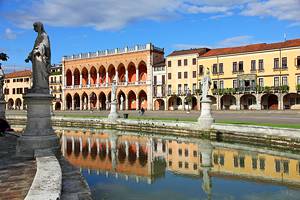
Where to Go near Venice : After you've visited the city's top tourist attractions, you may want to explore some of the beautiful nearby towns. Only 20 kilometers away is pretty Treviso , enclosed by walls and with its own waterside villas. Padua , with its famous shrine of St. Anthony, is easy to reach by train or by a cruise along the historic Brenta Canal. Stop along the way at Villa Pisani, one of the most beautiful gardens in Italy .
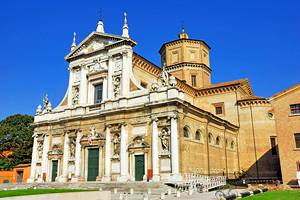
Places to Visit from Venice: North of Treviso are the soaring Dolomites, with some of the top ski resorts in Italy but with plenty of things to do in all seasons. Along the Adriatic to the east is Trieste , where Italian blends with Hapsburg architecture reminiscent of Vienna. Following the Adriatic coast south, you'll reach Ravenna , with its magnificent Byzantine mosaics.

More on Italy


One Day in Venice – Itinerary, Map, Tips & Guide
This post may contain affiliate links, from which we earn an income.
We don’t think there could be an easier city to explore in a day than Venice, also known as La Serenissima . This incredible city is the capital of northern Italy’s Veneto region and is built on more than 100 small islands in a lagoon in the Adriatic Sea.
In our one day Venice itinerary, you’ll find information and tips for visiting all the most important must-see Venice tourist attractions, with an interactive map, organised to make the best use of your time.
We also share recommendations for central places to stay, ideas about where to eat local food, and tips about how to make the most of Venice in a day.
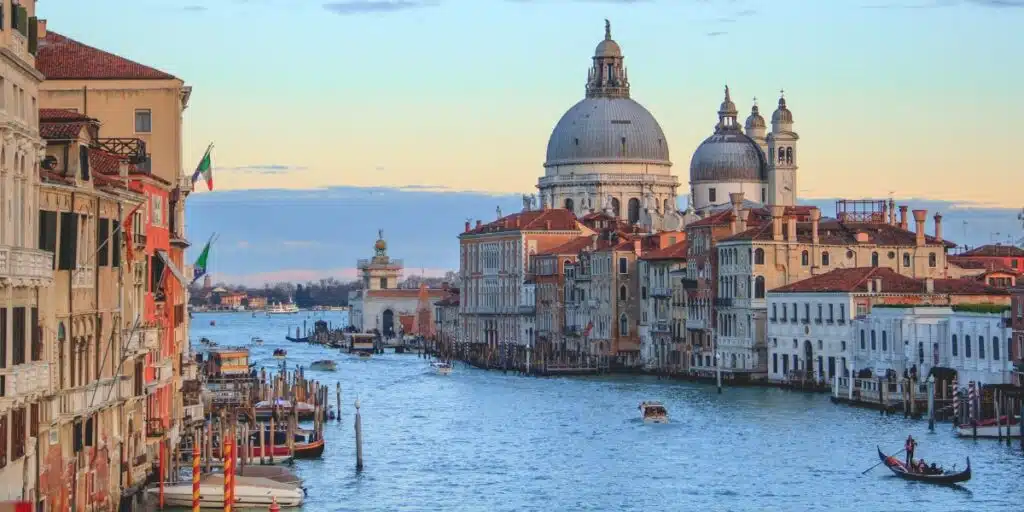
When to Visit Venice
Several times every year, between September and April , the sea level in Venice rises to flood the streets, squares, and palaces. While this occasional inundation, known as acqua alta , can be inconvenient, Venice has become adept at managing high tides and provides boardwalks in the main streets in order to allow people to move around.
Is this your first time visiting Italy? Get all the information you need in our Italy Travel Guide , including what to pack, the best time of year to go, getting there and practical tips to help you have the best trip!
In the spring, Venice starts to defrost, with temperatures rising from 12ºc/54ºf in the latter half of March to the low 22ºc/72ºf in May . In the early part of spring, you will definitely need to pack warm clothes and an umbrella, as March can bring quite a bit of rain.
May is considered one of the best times to visit Venice. The weather is lovely, the city has yet to be overrun with tourists and all the attractions are open. Landmarks such as St Mark’s Square would still be better visited early in the morning, to beat the crowds.
The Biennale Art and Architecture Exhibition normally runs from April to November . On even years the exhibition focuses on art, on odd years, it is dedicated to architecture. The city is filled with exhibitions, installations and various types of events for you to enjoy.
Summer is the peak season for tourism, with costs at their most expensive. As there are no roads in Venice, the waterways are crammed with gondolas and the streets are filled to bursting with tourists. The weather is also at its most humid and because of the waterways there can be quite a lot of bugs, and the occasional canal smell as the water dries out
August is when Venice is at its hottest, and many of the locals have packed up and left the city for the month for the almost countrywide Italian summer holiday.
One of the most famous activities in the summer is the Jazz Festival. From June to the end of August , there are musical performances from all over the world, as well as many other events. They are held at locations all over the city, such as St Mark’s Square, the Sala Apollinne, The Teatro la Fenice and the Pallazzo Grimani.
September is still quite warm, and the number of tourists has dropped, so it’s a great time to spend a day in Venice.
The annual Venice Film Festival takes place as well as the annual Regata, or Regata Storica , which is held on the Grand Canal on the first Sunday of September and commemorates the history of Venice. This festival has been held in the Venetian lagoon for hundreds of years and today is well-known for the wonderful historical water pageant that takes place before the race.
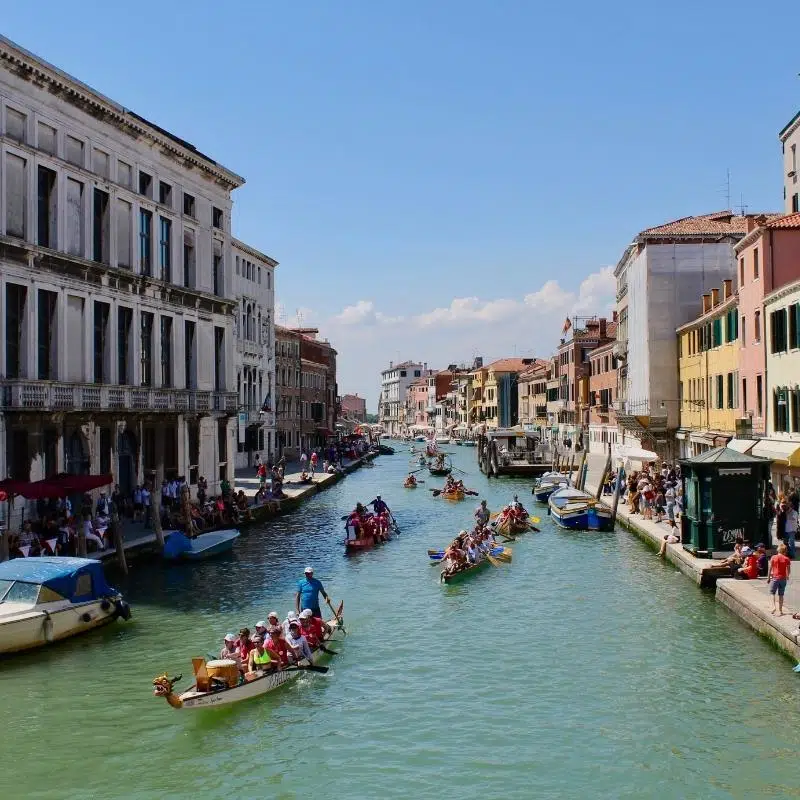
The temperature gets cold in November , so make sure you pack warm clothes, especially if you want to enjoy a romantic gondola ride or take a water bus. The city will be less busy, and cheaper for a visit, however, some landmarks and attractions may keep shorter hours, so make sure you check beforehand.
February is all about the Venice Carnivale, one of the biggest celebrations in all of Italy. It takes place in Venice 40 days before Easter, with a final party before Ash Wednesday and Lent. The events typically last for two to three weeks before the actual Carnival Day on Shrove Tuesday.
A lot of events will require an invite or ticket which can be costly, but there are also many events that are free, such as the candlelit parade of boats. There are also street performers and concerts for the public to enjoy. The finale is held in the main public square of St. Mark’s, where you will get to see all the amazing masks and costumes. If you would like to visit Venice for Carnivale you will need to book well in advance as the city will be very busy for this period.
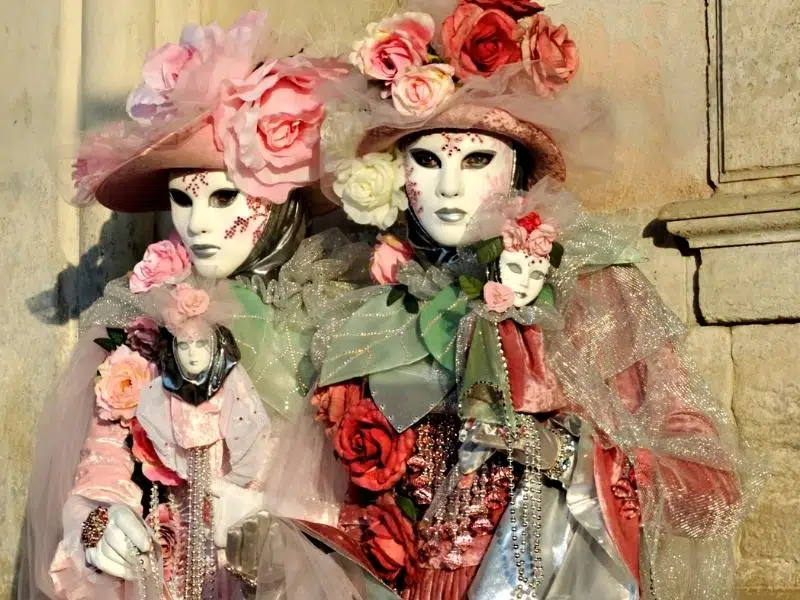
Are you planning a road trip in Italy? Get our Italian bucket list road trip guide for maps, itineraries, accommodation + places to see/things to do en route and nearby attractions so you don’t miss a thing!
Venice Trip Resources
Fly into Marco Polo or Treviso Airport
Drive in from Europe or hire a car in Italy
Travel Insurance
Cover medical costs, delays and lost luggage
Getting to Venice
When flying to Venice you can land at one of two airports Marco Polo Airport , which is 8km from the city, or Treviso Airport which is 33km away.
There are several different ways to get to the city from Marco Polo Airport. You can go by express bus, No5, or the shuttle bus No35, both can be picked up in the second lane outside the arrivals terminal. They leave every 15 minutes and take around 25 minutes to get to Piazzale Roma terminal. You can buy your express bus tickets here .
If you want to make your arrival in Venice unforgettable take a water taxi directly from the airport to your hotel , an amazing way to start your visit.
The best way to get to Venice from Treviso Airport is by bus, you can catch the bus in Via Noalese, to the right of the airport exit. It takes about 50 minutes, you can buy your express bus tickets here .
You can also book a private transfer from the airport with Klook directly to your accommodation in the city. Klook works with a large range of local operators to bring the the best options and prices for your transfer.
Planning your car rental in Italy? Find out all you need to know about hiring a car and driving in Italy and if you’re planning on driving to Italy from the UK, find out how and get all the best routes here !
Where to Stay in Venice
Luxury: Sina Centurian Palace – Booking.com | Agoda
Mid-Range: Palazzo Veneziano- Booking.com | Agoda
Budget: Hotel Saturnia & International – Booking.com | Agoda
Hostel: Combo Venezia – Booking.com | Agoda
What to See & Do in Venice
Our Venice in one day itinerary is very walkable, and you’ll be able to complete the route without needing public transport. As Venice is a relatively small city, you can see a lot in a short amount of time.
When visiting Venice you will notice there are no roads, just canals and bridges. The city has 417 bridges, 72 of which are private, and 177 canals. The largest of these is the Grand Canal, which runs in an S shape, splitting the city in half.
The city is divided into six districts or sestieri – Cannaregio; Dorsoduro; San Polo; San Marco; Santa Croce and Castello.
If you prefer to have your day organised for you, check out this popular and highly-rated private guided walking tour , where you’ll explore the charming streets of Venice and admire some of the city’s most famous landmarks as you discover the city’s history and culture alongside an expert guide.
Venice One Day Walking Map
How to use this map – Use your fingers (or computer mouse) to zoom in and out. Click or touch the icons to get more info about a place, and click the arrow in the box top left to open the index. To add to your own Google Maps account, click the star next to the title of the map.
Ponte della Paglia & Ponte dei Sospiri – Bridge of Sighs
Start your morning at the Ponte della Paglia. The original structure was built in 1360 and was the oldest stone bridge in Venice, the current structure dates back to 1847. This bridge will give you a fantastic view of the Grand Canal and the lagoon and looking the other way, the famous Ponte dei Sospiri or Bridge of Sighs.
The Bridge of Sighs is a fully enclosed limestone bridge which was built in the early 1600s and linked the prison to the interrogation rooms in the Doge’s Palace. It was described by Lord Byron as “the last point where condemned prisoners could see the beautiful city of Venice” before they were taken to be executed.
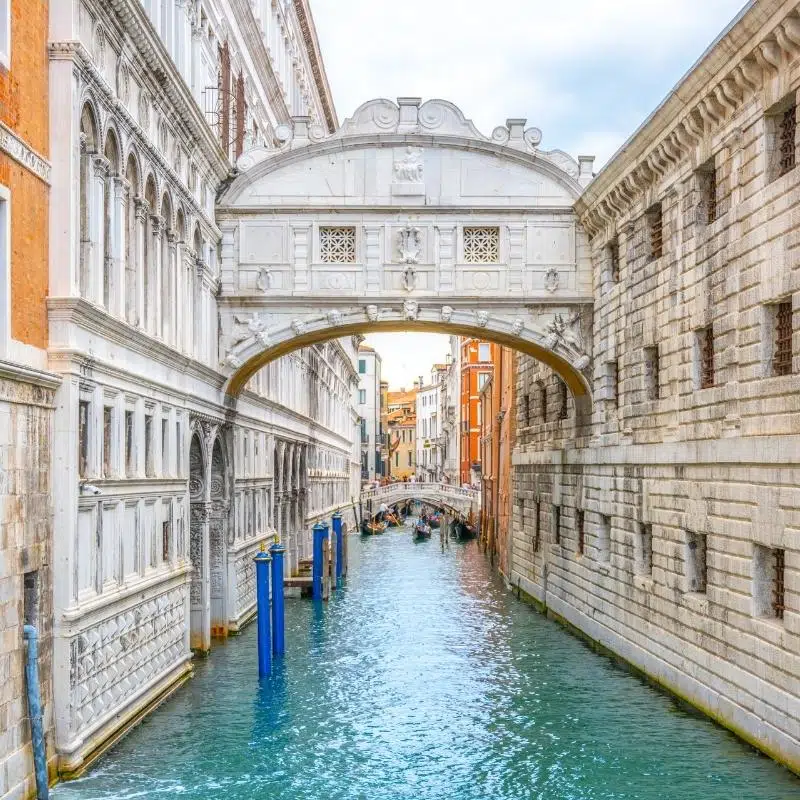
Palazzo Ducale – Doge’s Palace
The Doge’s Palace is one of the main landmarks in Venice and is a masterpiece of Gothic architecture. Made up of three blocks, the wing towards St Mark’s Basin is the oldest, built in 1340 and modified and extended throughout the following centuries.
The wing towards St Mark’s Square is still as it was built in 1424, and the canal side wing was built between 1483 and 1565, during the Renaissance.
The palace was the home of the Doge of Venice, who was the supreme authority of the former republic. It not only housed the Doge’s fabulous apartments but also a political office and a prison.
In the early 1600s, a new prison was built across the Rio del Palazzo and the prison and the palace were linked by the Bridge of Sighs. After the republic fell the Palace was used by many different administrations until it became a museum in 1923.
The Doge’s Palace is one of the top tourist attractions in Venice and is super busy for much of the year. Don’t waste time waiting in line when you only have one day to see the city! Instead, get a reserved entry skip-the-line ticket for the Doge’s Palace , with which you’ll also get to walk across the famous Bridge of Sighs.
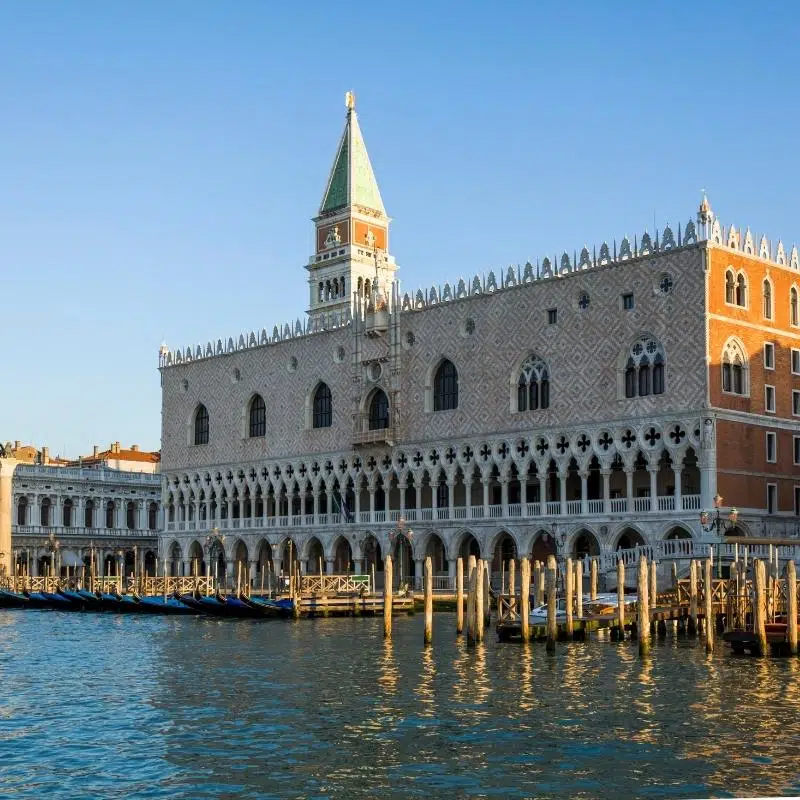
Piazza San Marco – St Mark’s Square
Walk along the Riva degli Schiavoni and you’ll come to St Mark’s Square, the most famous Piazza in Italy, if not the world. Home to some of Venice’s most impressive historical buildings, the square gets very busy so it’s advised to get there early to enjoy everything on offer without the larger crowds which congregate later in the day.
The square is lined with fancy stores, (overpriced) cafés and eateries and in the furthest corner from the water is the Museo Correr which houses objects and works of art that reflect Venetian culture, history and art. The Correr Museum entrance is included in your Doge’s Palace ticket.
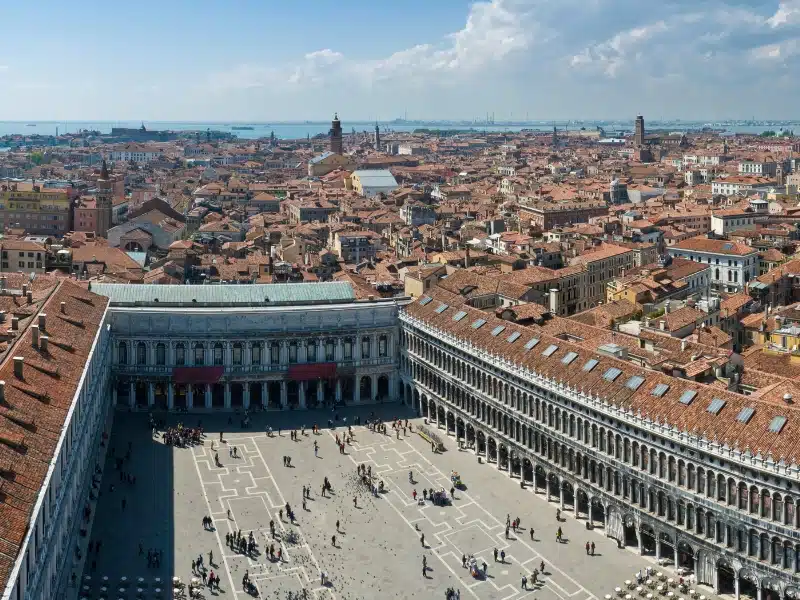
Basilica di San Marco – St Mark’s Basilica
Built by the Venetians in 820 and consecrated in 832, St Mark’s Basilica takes its name from the remains of the Saint preserved inside. In 828 merchants from Venice stole the body of St Mark the Evangelist, and transported the body via ship, but the ship was hit by a storm. The legend goes that St Mark appeared to the captain and told him to lower his sails, thus saving the ship.
When Constantinople was defeated in the Fourth Crusade, many treasures made their way to Venice and were installed in the basilica. The four bronze Horses of Saint Mark, also known as the Triumphal Quadriga or Horses of the Hippodrome of Constantinople, are just one example of the many treasures that came from Constantinople.
The church is also home to the high altar table Pala d’Oro , considered one of the most amazing works of the Byzantine era and the jewel in the crown of the Basilica.
The interior of the domes, the vaults, and the upper walls were slowly covered with gold-ground mosaics depicting saints, prophets, and biblical scenes. Many of these mosaics were later retouched as tastes changed and together they now represent eight hundred years of history.
Another of Venice’s most popular attractions, it’s advisable to book your fast-track entry and audio guide for St Mark’s Basilica online in advance of your visit.
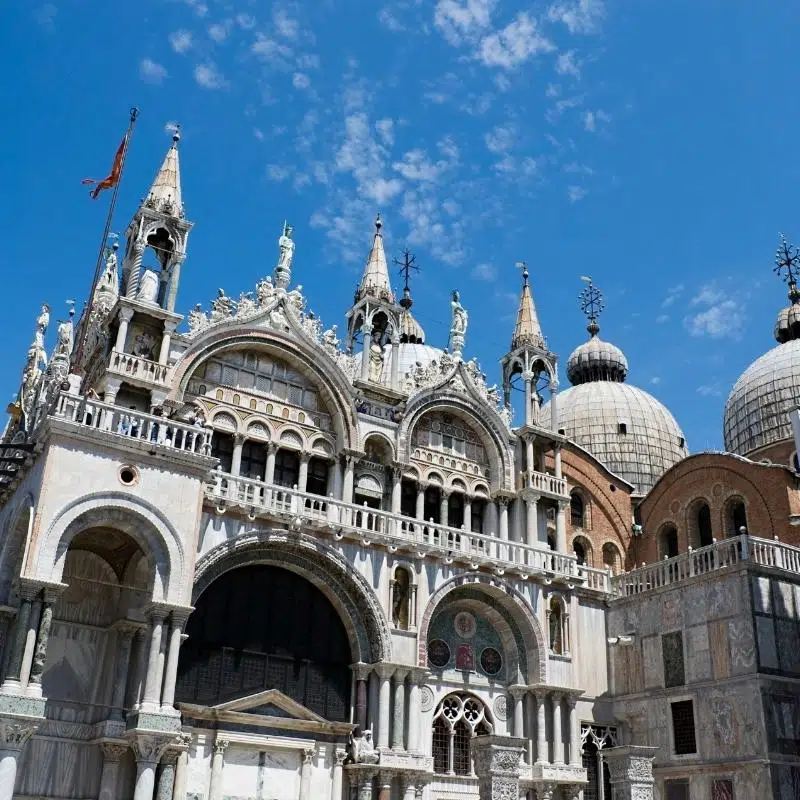
Campanile de San Marco – St Mark’s Campanile
St Mark’s Campanile is the bell tower for St Mark’s Basilica. Built in the 12th century on the site of what was probably a watchtower and rebuilt in its current form early in the 16th century with the addition of a belfry, the campanile is the perfect spot from which to enjoy a spectacular bird’s eye view of the city and Venice lagoon.
In fact, the view was so good that the campanile was used in 1609 by Galileo to demonstrate his telescope to the Doge!
In 1902 the campanile suddenly collapsed as a result of bad construction work and it was agreed that the tower should be rebuilt exactly as it was. The rebuild started in 1903, and the campanile was re-opened in 1912. When visiting the tower, you get to the top by elevator, which only takes 30 seconds so there’s no need to climb a whole lot of stairs!
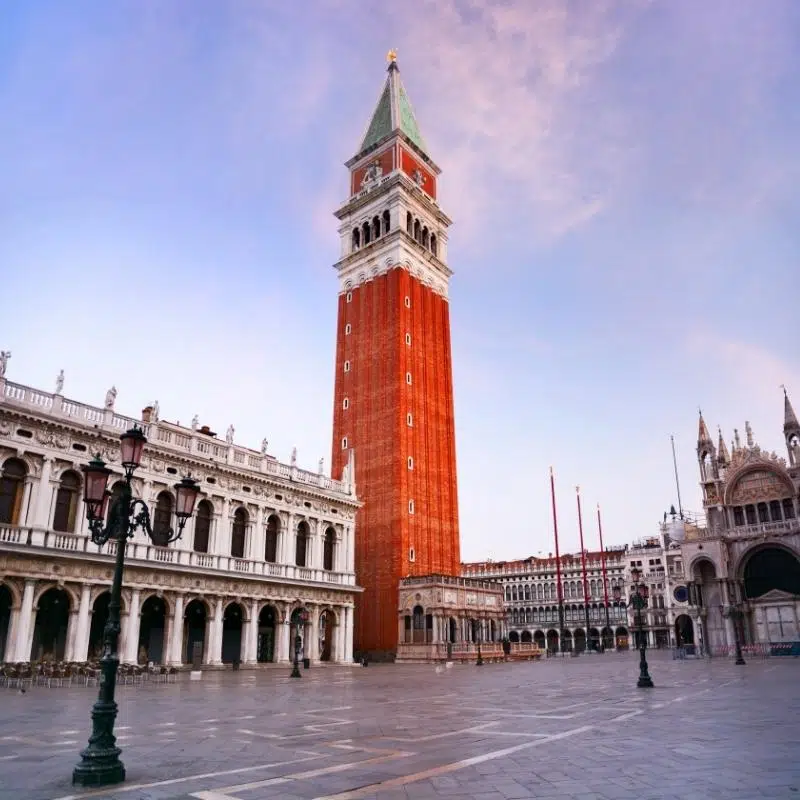
Libreria Acqua Alta
Literally meaning ‘the book store of high water’, this hidden gem is an indoor/outdoor bookshop which protects its stock from the famous floods of Venice using ingenious means!
Stacked wall-to-wall with books, magazines and maps, Libreria Acqua Alta stores the books in boats, waterproof containers, bathtubs and even a full-sized gondola!
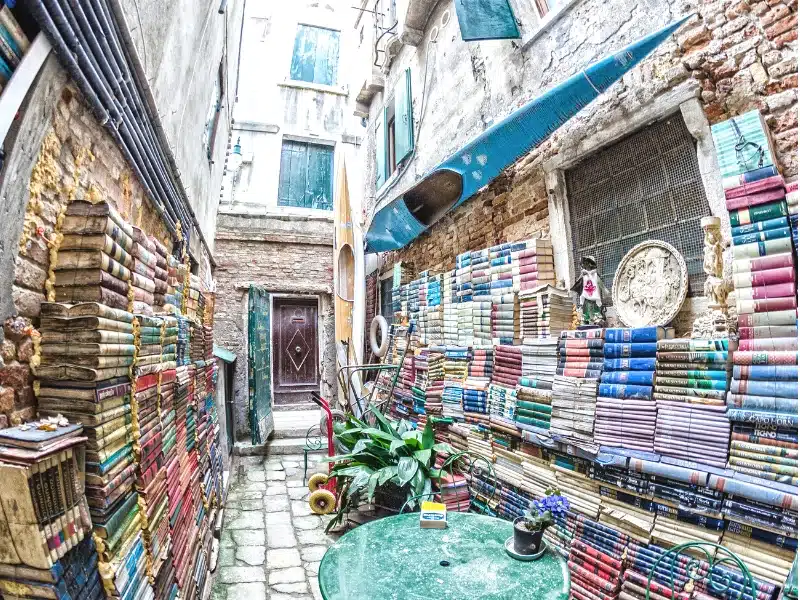
Ponte di Rialto – The Rialto Bridge
The iconic Rialto Bridge is the oldest bridge spanning the Grand Canal. It connects the districts of San Marco and San Polo and has been rebuilt several times since its first construction as a pontoon bridge in 1173. Whilst there visit the Mercati de Rialto or Rialto Market and look at the amazing array of fresh foods on display.
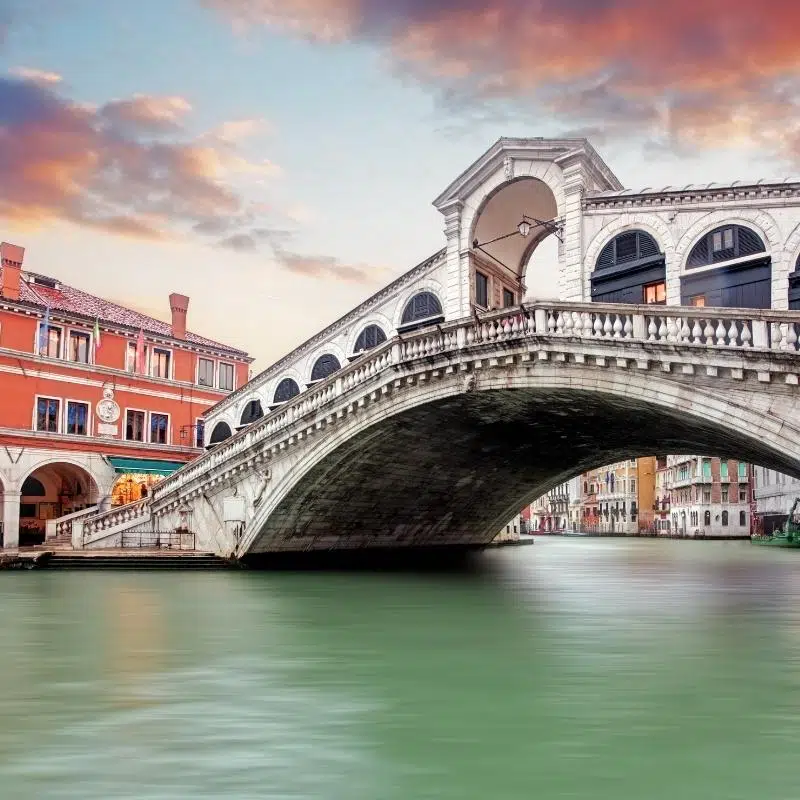
Ca’ Pesaro International Gallery of Modern Art
The incredible Ca’ Pesaro museum is housed in a marble palace on the Grand Canal and is a magnificent example of the Venetian Baroque style. The façade is an imposing edifice of statues and bas-reliefs, while the interior is magnificently decorated by Giovanni Battista Pittoni.
The museum has a fabulous collection of 19th and 20th century paintings and sculptures, including works by Morandi, De Chirico, and Carrà, as well as Kandinsky, Mirò and Matta.
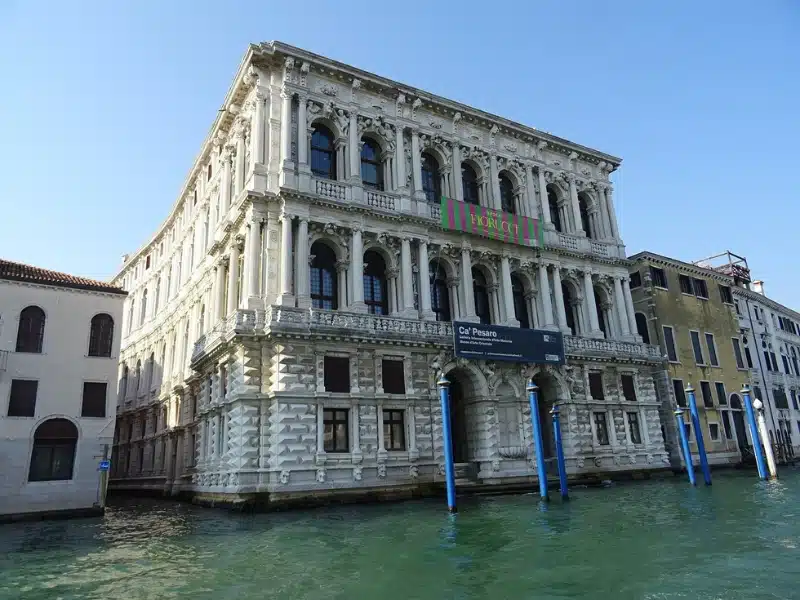
Casa Di Carlo Goldani – Carlo Goldani’s House
Carlo Goldoni was a famous Venetian playwright who dedicated his life to the theatre, starting as a small boy aged eight, with puppets in a small theatre at his home. The home is now a writer’s museum and well worth a visit.
Goldoni’s theatrical work consists of five tragedies, sixteen tragicomedies, 137 comedies, two sacred actions, twenty interludes, thirteen dramas, 49 playful dramas, three farces and 57 scenarios!
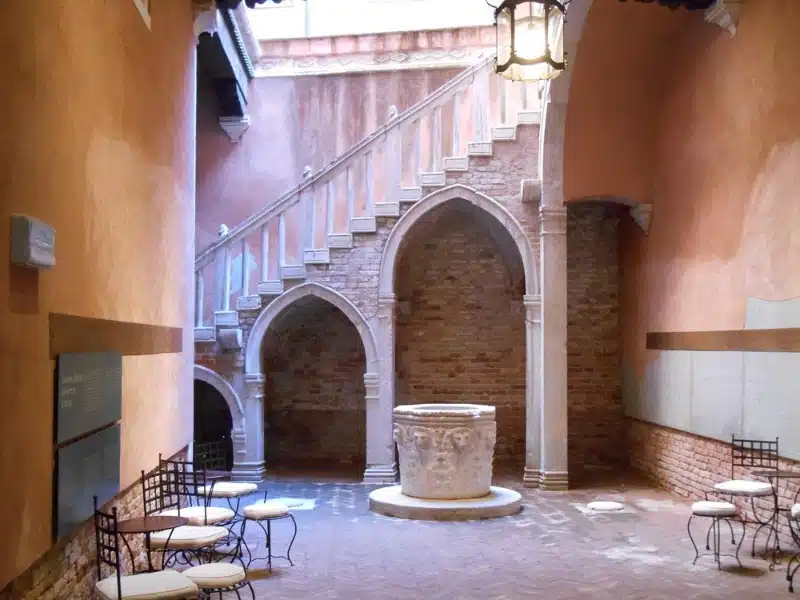
Basilica De Frari
Basilica De Frari in the San Polo neighborhood is also known as the Basilica Santa Maria Gloriosa and is one of the most remarkable churches in Venice. Built over a period of 100 years in the 15th century the exterior is pretty plain compared to some of the other churches in Venice, but step inside to see some amazing sculptures and a famous painting by Titian called ‘Assumption of the Virgin’.
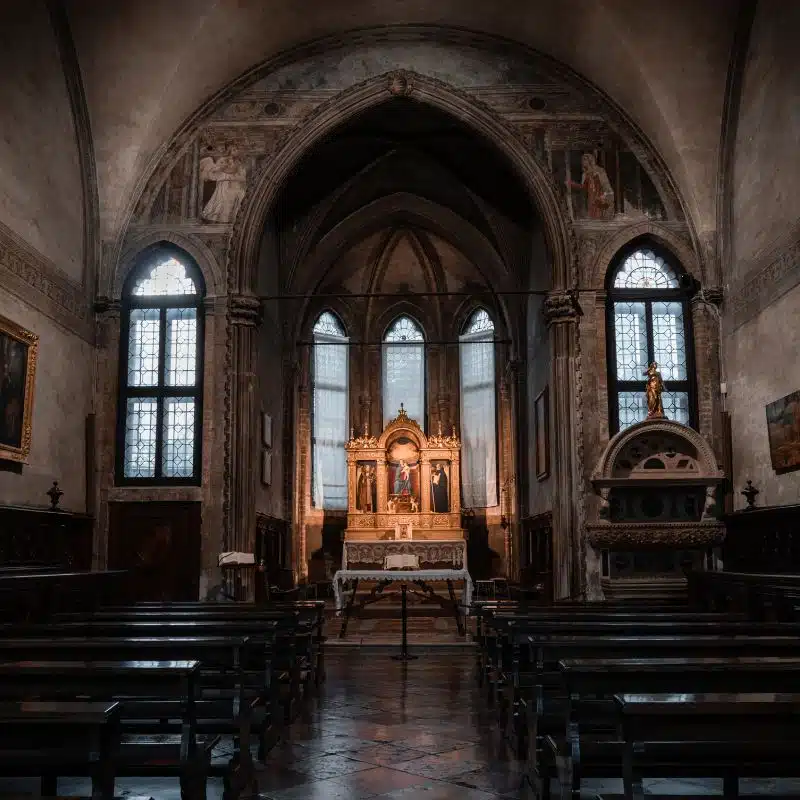
The Migrant Child by Banksy
It may not be thousands of years old or hold any historic significance, but it’s still a really cool piece of artwork by Banky in reference to the plight of migrants and refugees, stencilled onto the wall of the canal on the island of Dorsoduro.
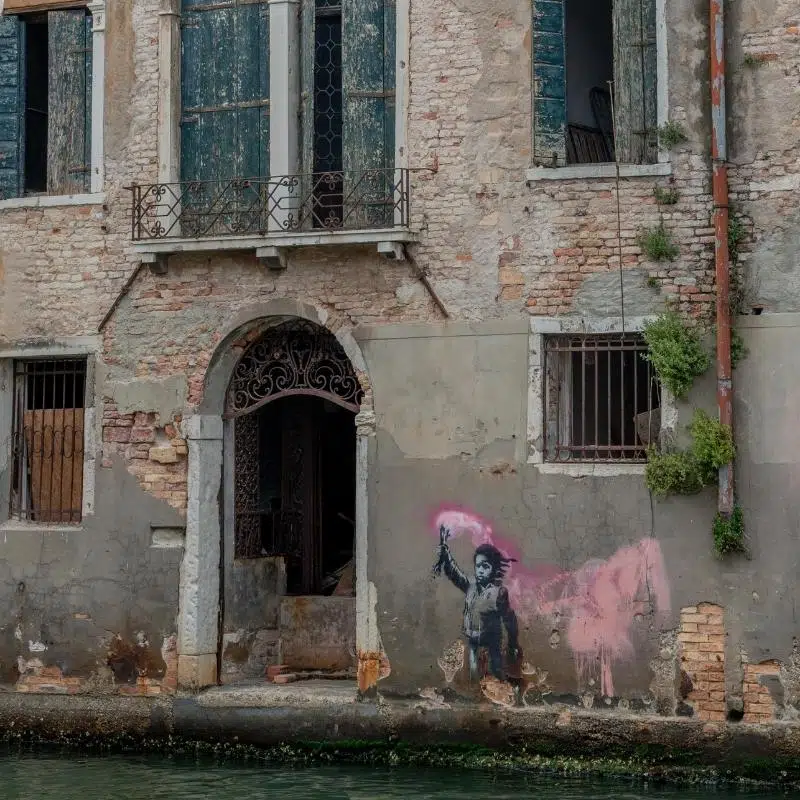
Museo di Leonardo Da Vinci – Leonardo Da Vinci Museum
Housed in a beautiful former church, this museum dedicated to Da Vinci is quite small but interactive, so it really is a unique experience. They have replicas of Da Vinci’s masterpieces so you can really get up close and look at them in detail without the need for high security. They also have replicas of his inventions which you can touch and try.
This family-friendly exhibition will stimulate your curiosity and allow you to really explore Da Vinci’s groundbreaking work. Stroll through the four sections of earth, water, air and fire, and discover machines built according to Da Vinci’s original designs. This excellent museum gets very busy in high season, so make sure to get your skip-the-line tickets before visiting.
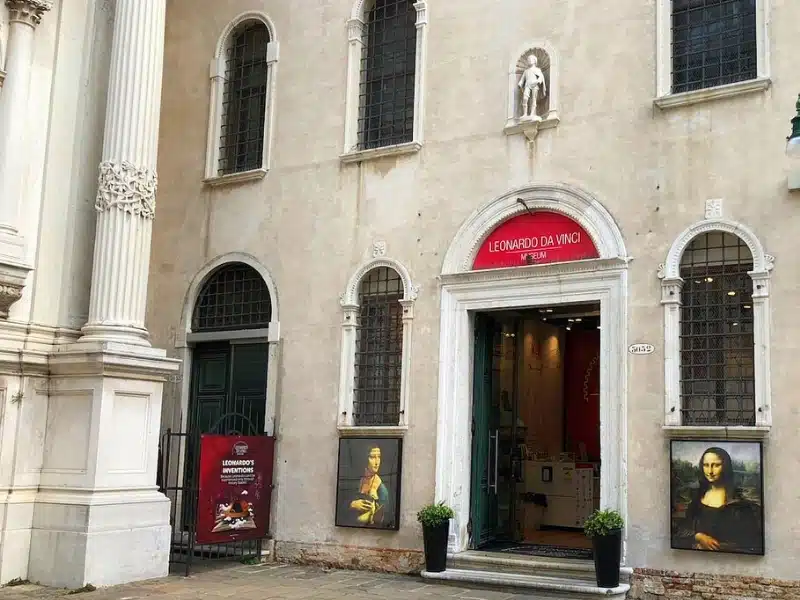
The Peggy Guggenheim Museum
The Peggy Guggenheim Collection is located on the Grand Canal between Santa Maria della Salute and the Gallerie dell’Accademia, in the Dorsoduro district. It is one of Europe’s premier museums devoted to modern art, and one of the most visited attractions in Venice.
The core of the museum is Peggy Guggenheim’s personal collection of 20th century art ranging in style from Cubism and Surrealism to Abstract Expressionism.
Explore one of the most important cultural attractions in Venice with a skip-the-line ticket , so you can enjoy works of modern art by Picasso, Pollock, and Dalí instead of standing in a queue!
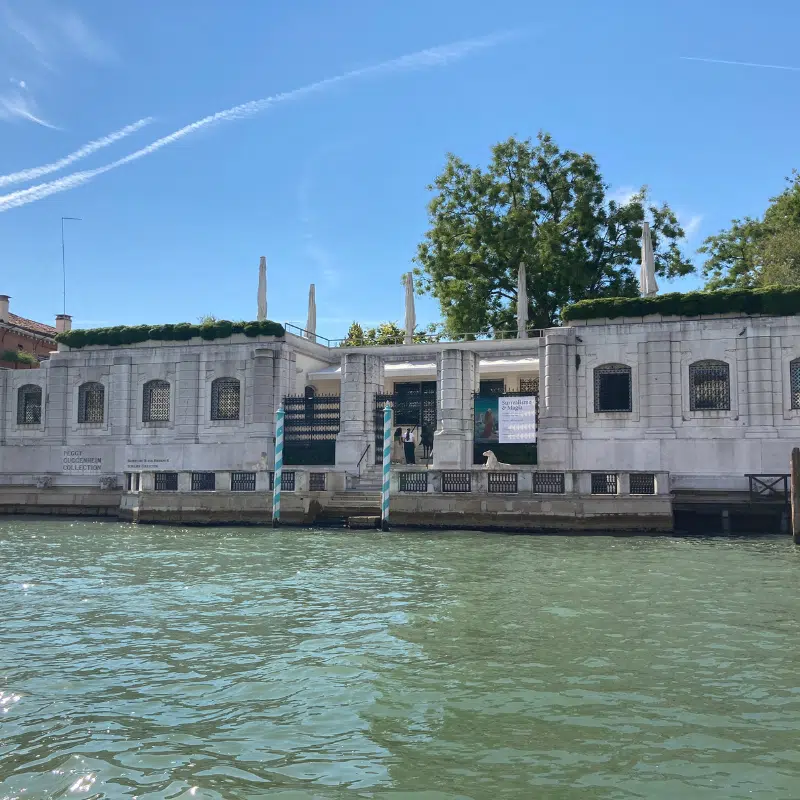
Basilica di Santa Maria della Salute
The basilica, known simply as Salute , is a Roman Catholic Church commissioned by the city as a prayer and as a thank you to the Virgin Mother of God for saving the city of Venice from the terrible plague of 1630. The first stone was laid on 1st April 1631 and it was consecrated in 1687.
The basilica faces the entrance of the Grand Canal and the amazing double dome has characterized the skyline of the San Marco Basin in Venice for more than three hundred years.
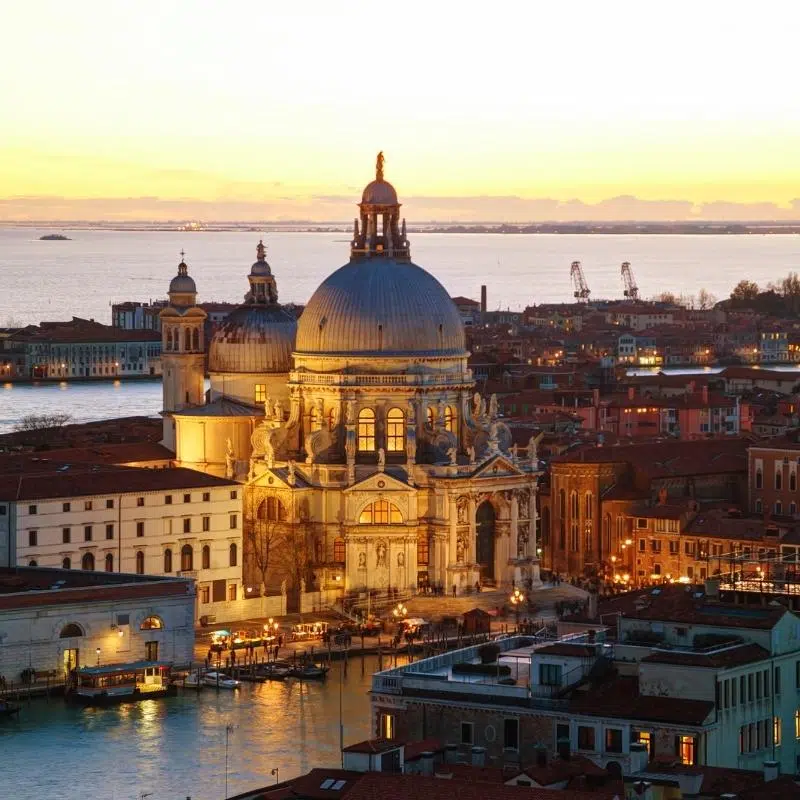
Grab a Cicchetti & Ombra in Dorsoduro
Head to the Dorsoduro district, home to Venice University, which is quieter and less touristy than the other districts in Venice, so prices are much more reasonable.
There are many small Bacari bars to try here, which serve the typical Venetian aperitif of an ombra (small glass of wine) and a cicchetti . You can even do a Bacari crawl, where you can eat a cicchetti , a small snack much like a Spanish tapa, with a glass of local wine.
The Cantina Schiavi is an amazing experience – the walls are covered in bottles of wine, and they serve fresh cicchetti on the side. There are no seats, so take your aperitif outside to watch one of the city’s last gondola shops at work.
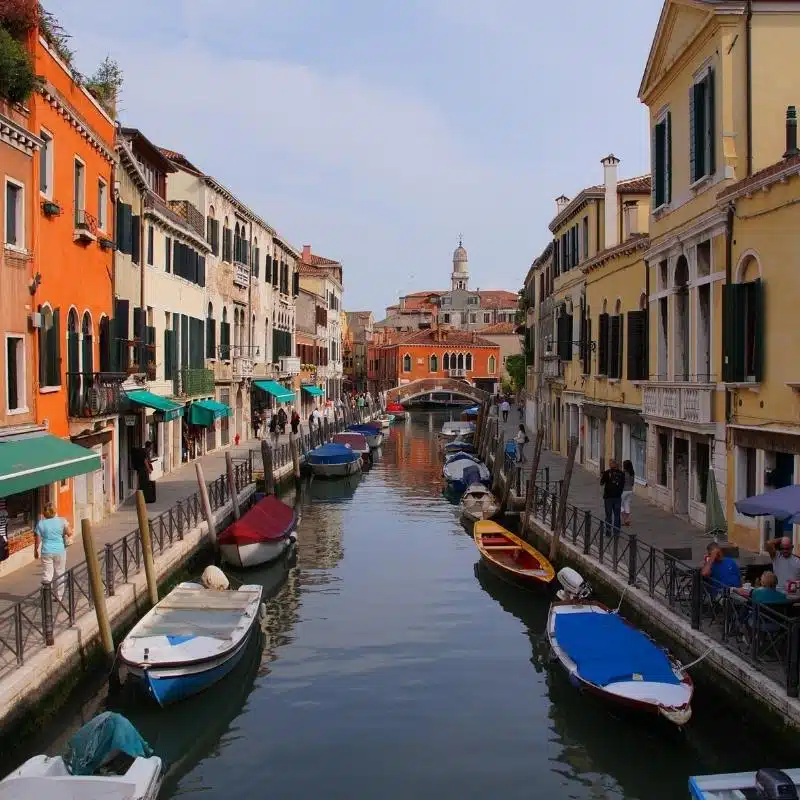
Take a Nighttime Gondola Ride
What could be more fun or romantic than an evening gondola ride to see Venice from the water while you float down the majestic Grand Canal to spot Venice’s top sights in the moonlight?
Trying to catch a gondola and then negotiate the price can be a stressful experience, and you risk paying over the odds to enjoy this quintessential Venetian experience. Pre-book a private gondola ride so that you can just arrive, board and enjoy floating along the gorgeous Venetian canals.
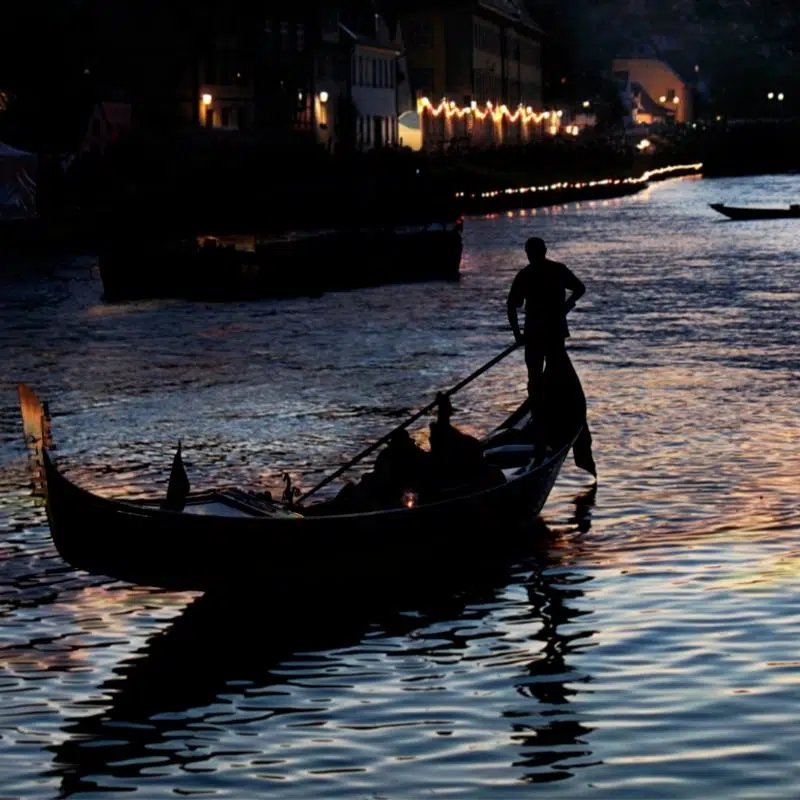
Have Amazing Cocktails at Taverna Al Remer
Just a stone’s throw from the canal and a great nighttime view of the Rialto Bridge is the Taverna Al Remer. This is a fantastic location for a late-night cocktail, sit inside at the very cool bar or in the summer months outside in the small Piazzetta with a view of the canal and molo , the broad stone quay that was once the ceremonial landing spot for great officials and distinguished visitors.
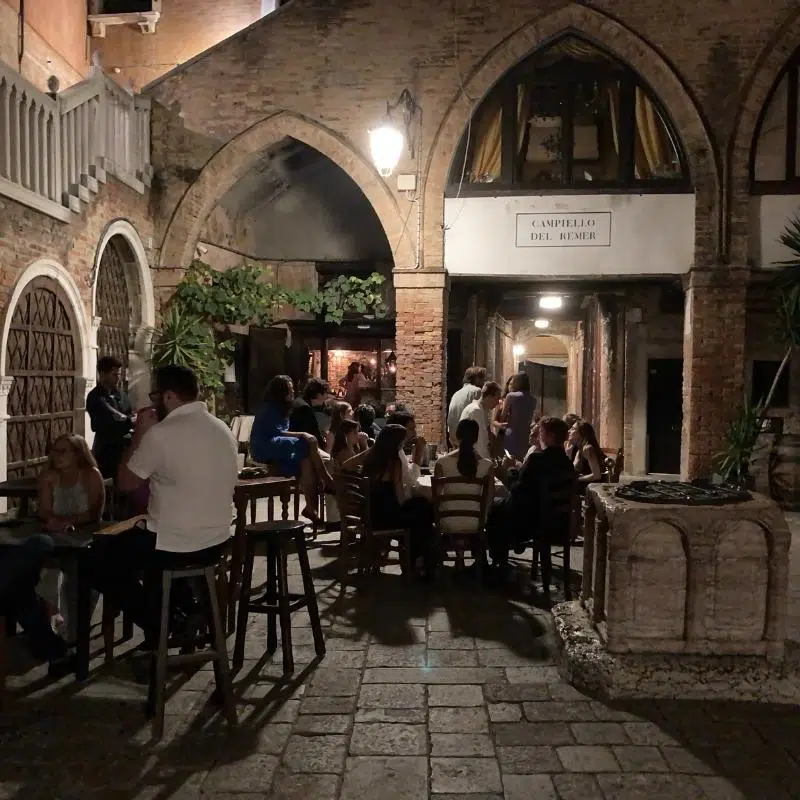
Other Italian Travel Guides
- FREE Self-Guided Bologna Food Tour
- How to Visit Pompeii & Vesuvius in One Day
- Rome in a Day – Itinerary, Map, Tips & Guide
- Great Dolomites Road: Absolutely Everything You Need to Know!
- Tuscan Road Trip: Itinerary, Map & Tips
- A Bucket List Amalfi Coast Road Trip
- How to Spend 36 Hours in Palermo
- Dolomites Road Trip: Explore the Best of Northern Italy
- One Day in Florence – Itinerary, Map, Tips & Guide
- Northern Italy Road Trip: Itinerary, Map & Tips
Where to Eat in Venice
All’ arco.
Head to All’ Arco for lunch, this is a tiny restaurant with only three tables, but you can eat standing up outside and they offer an amazing selection of meat and fish cicchetti .
Boccadargento
Boccadargento is a wonderful restaurant off the beaten track serving authentic Venitian food. They don’t have a website but I can tell you from personal experience the food is excellent and the service great.
Osteria Alla Fresca
Osteria Alla Fresca is another wonderful traditional Venetian restaurant, with a great price point to boot. Head to this small osteria away from all the crowds and tourists and sit under a canopy of vines and enjoy the wonderfully fresh food.
Osteria Giorgione Da Masa
If you feel like something slightly different, then Osteria Giorgione Da Masa could be the place for you. A fusion of Japanese and Venetian cuisines, that includes ramen and cicchetti . There is also a very reasonably priced tasting menu, which can be made allergen and gluten-free if requested before ordering.
Street Food Tour with a Local Guide & Tastings
If you want some expert guidance in Venetian food, eat your way around Venice on a tasting tour of some of the city’s eateries with a foodie guide, and see historical monuments along the way!
This highly rated Venetian street food tour will take you from the historic Rialto Market alongside the Grand Canal to Campo San Polo for the Basilica dei Frari and Campos San Bartolomeo before arriving at Campo Santa Margherita square, which is surrounded by local restaurants and farmers’ markets. You’ll learn about the districts and historical monuments you pass by and get to taste the food of Venice.
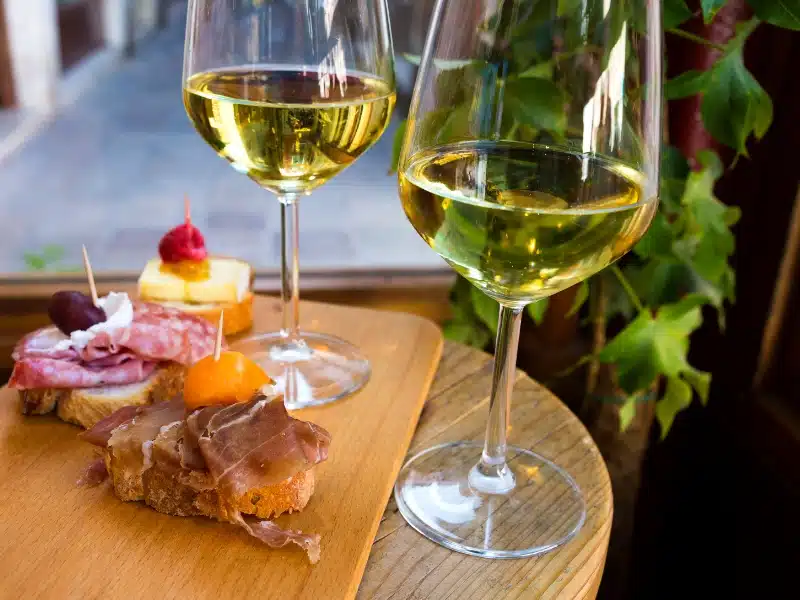
Top Five Venice Travel Tips
- Make sure you start your day early to try and avoid the crowds as much as possible. The city with its narrow streets gets very busy and the going can be slow going when walking.
- Always ask about prices before getting a water taxi or a gondola as they can be expensive. You could always take a shared gondola ride or shared water taxi to help with cost. Or you can get the water bus, which offers a similar (but not quite!) experience, and the tickets can be purchased in advance for less than a tenth of the cost of a gondola ride.
- Do not sit down to eat or drink a coffee in St Mark’s Square, unless you are a millionaire! They way overcharge here, and there are much nicer, off-the-beaten-path places which offer a more authentic experience.
- Before travelling to Venice invest in a City Card and enjoy the city to the fullest, saving money at the same time. The Venice Museum Pass is valid for 180 days once you have exchanged it, you take your electronic voucher and exchange it in one of many locations in the city for the official Venice pass. This pass will gain you entry to the Doge’s Palace, the Correr Museum and another ten civic museums of your choice. This is also a skip-the-line pass, so you will get to see more of these amazing attractions.
- Keep vigilant about your personal space and belongings, pickpockets operate all over Venice and prey on tourists in particular.
More Than 1 Day in Venice
Take the train to conegliano.
Conegliano is a wonderful town that sits in the foothill of the Dolomites and is the heart of the Prosecco region, just 35 minutes by train from Venice. Once there you can see the works of Giovanni Battista Cima, one of the famous Italian Renaissance artists, at Casa Cima .
Take a walk up to the castle and have a glass of local Prosecco as you admire the view of the Dolomites all the way to the Venice lagoon. This is definitely one place that should be added to your Italy bucket list.
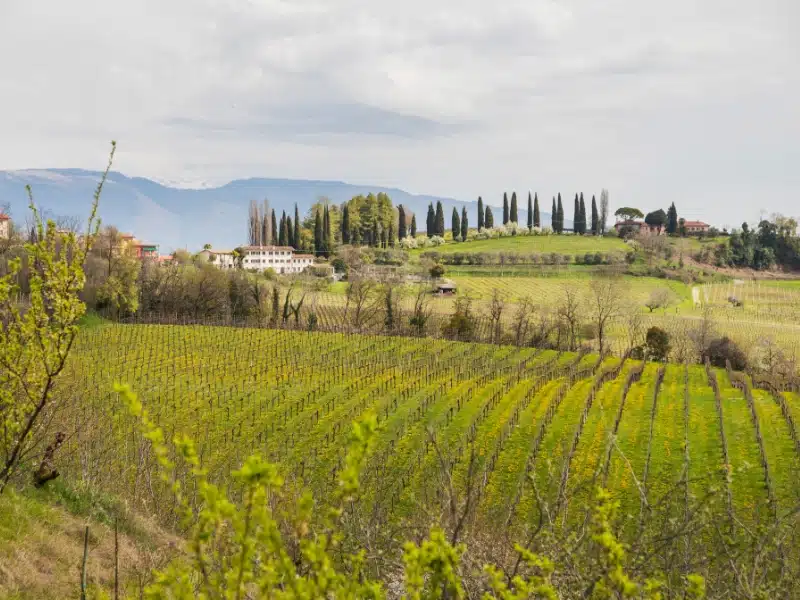
Visit Sant’Erasmo – St. Erasmus Island
St. Erasmus Island is the largest of all the islands in the Venice lagoon, and is often referred to as ‘the vegetable garden of Venice’. This is a place to get out of the hustle and bustle of the city and get back to nature. As well as growing vegetables on the islands there are also vineyards
The island is rich in orchards and vineyards and is very famous for the violet artichoke of Saint Erasmo, a variety that grows only on the island. They are a real delicacy and are only available locally for 10-15 days a year.
You can also see the Massimilania Tower, built between 1843 and 1844, it was erected during the French and Austrian occupation for defending the lagoon. Now its used for cultural events and photography exhibitions.
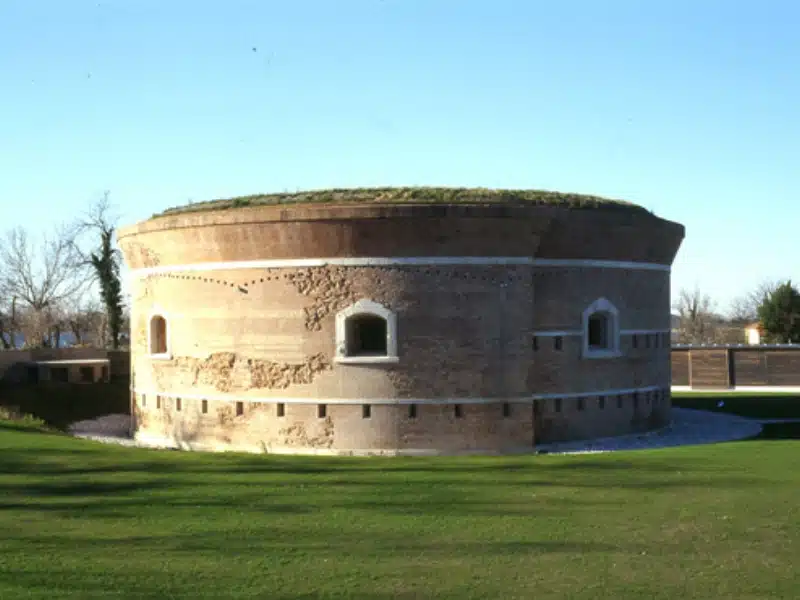
Burano, Murano and Torcello Boat Tour
If you take one day trip from Venice, make it this highly recommended and well-organised tour.
Depart from Venezia San Marco and get the five-star treatment as you ride by boat to the islands of Murano , Burano and Torcello . Visit Murano and find out why the island is renowned for its glassworks with a visit to a local glass factory , then watch a skilled artisan during a glass-making demonstration before exploring the glass shops on the island.
Next, head for Burano , which is known for its brightly painted houses and lacework. Follow your guide to the heart of the town and have time to explore the lace museum and enjoy a coffee.
Sail to Torcello , the first center of civilization in the estuary. See the Venetian-Byzantine mosaics at the Basilica di Santa Maria Assunta and discover the 10th century Torcello bell tower .
With a professional guide to offer insights, an organised tour is the perfect opportunity to see more of Italy in less time!
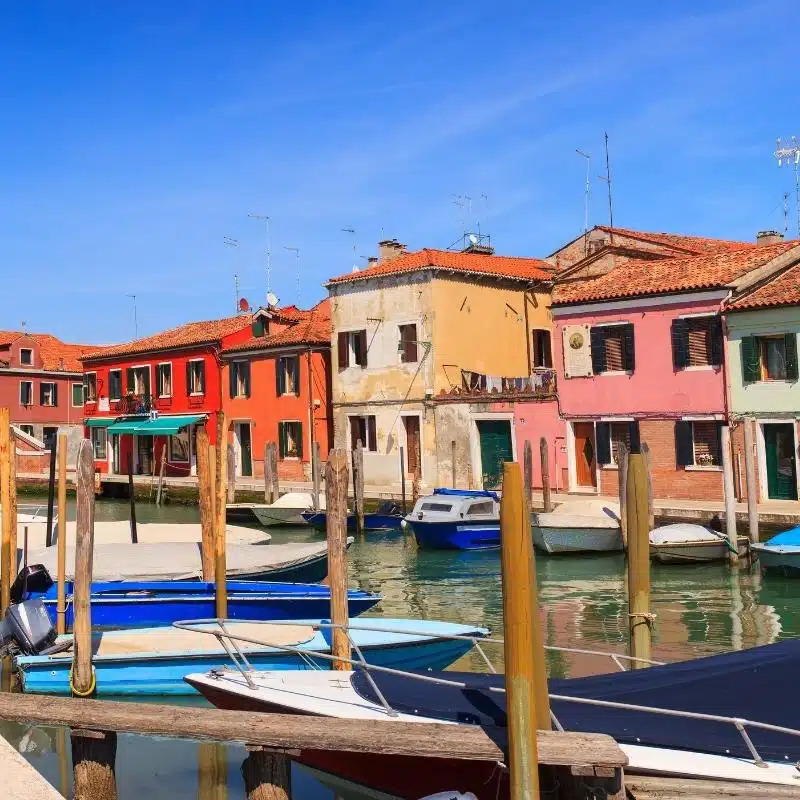
Are you looking for more one day city itineraries? Check out these top posts…
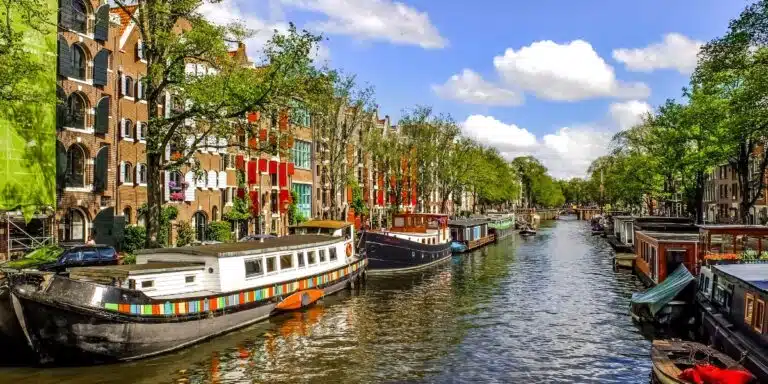
Amsterdam One Day Itinerary + Map, Tips & Guide
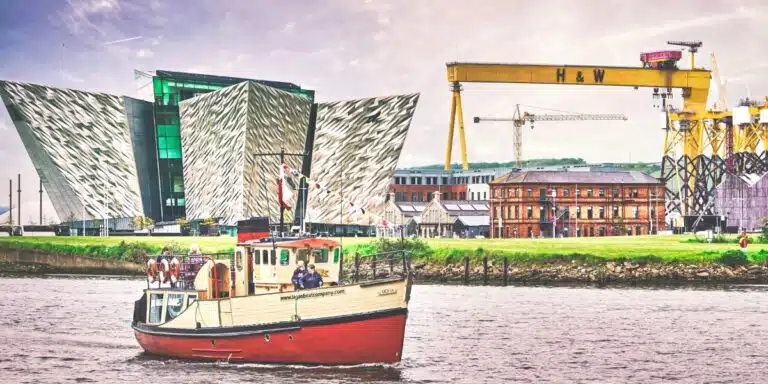
Belfast in A Day: Itinerary, Map & Tips
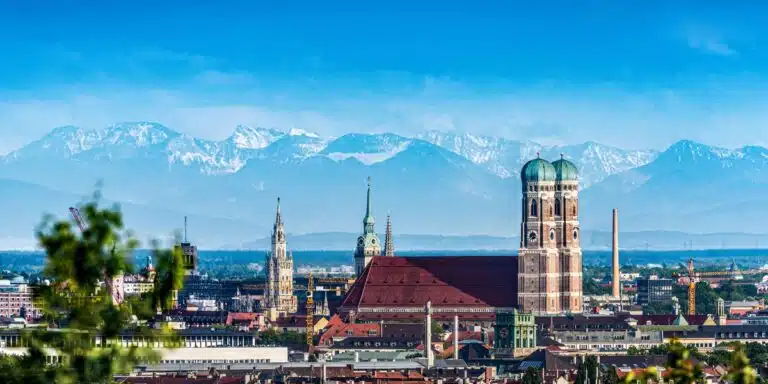
One Day Munich Itinerary + Map, Tips & Guide
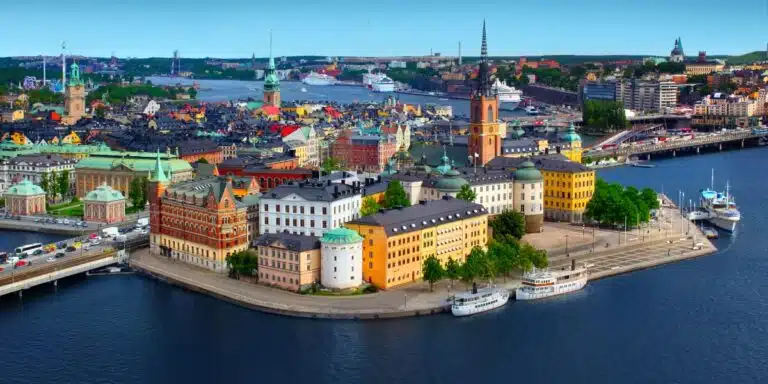
Stockholm One Day Itinerary + Map, Tips & Guide
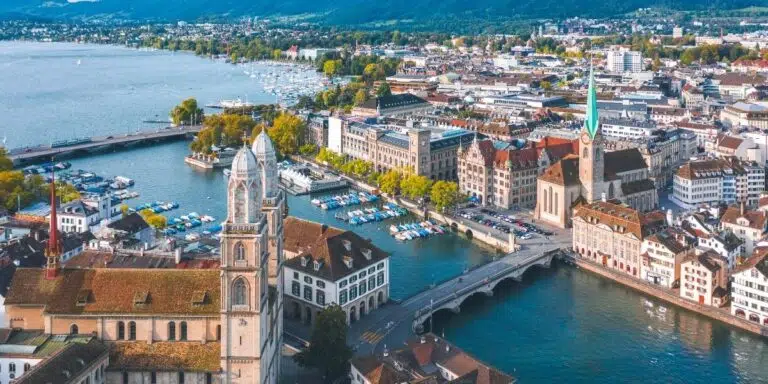
One Day in Zurich – Itinerary, Map, Tips & Guide
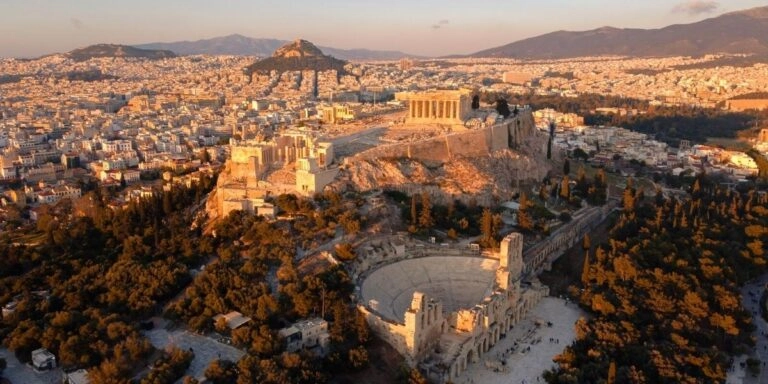
One Day in Athens – Itinerary, Map, Tips & Guide
Love it pin it.
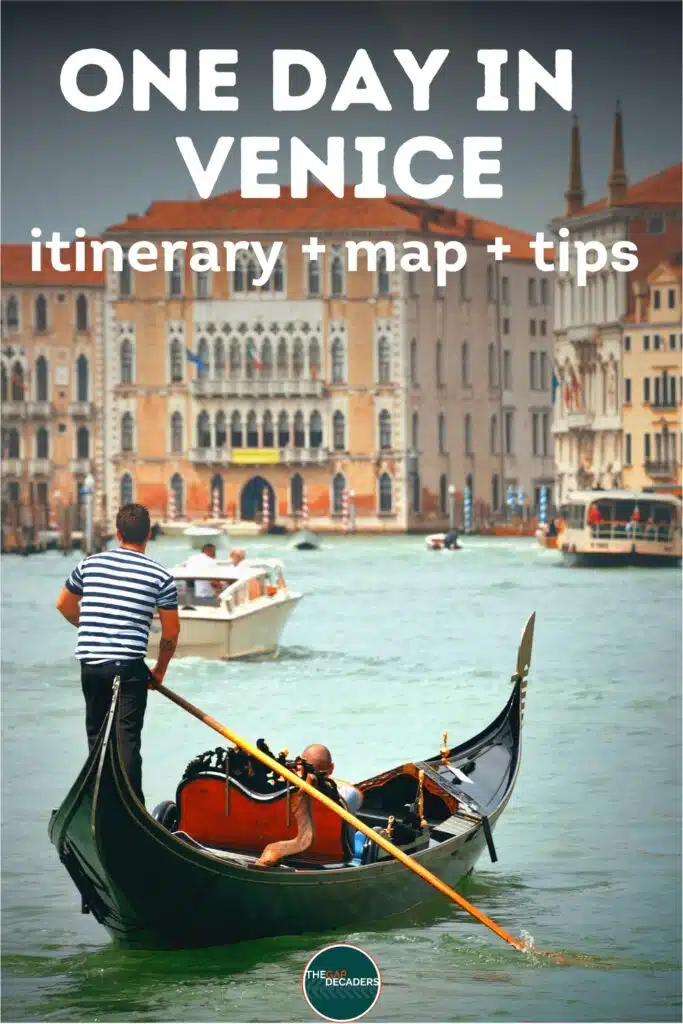

Best things to do and see in Venice
In Venice there are many places to visit as it is one of the most spectacular cities in the world because of everything in it. It is located in northern Italy and is bathed by the Adriatic Sea, like Dubrovnik. Its streets, always accompanied by canals crossed by gondolas, boats or vaporettos, allow you to live a different experience than any other place can offer you. It has a main street that is the Grand Canal that is where they usually circulate (browse rather) a large number of people every day. Doing a free tour is a different way of getting to know Venice . In fact, you have the possibility of doing a more generic tour of 2-3 hours in which you can see the most representative places in the city or choose a guided tour focused on a specific neighborhood or theme. In any case, the places you should visit yes or yes being there are the following: the Ducal Palace, the Rialto Bridge, the Grand Canal, the emblematic San Marcos Square, Burano and Murano, two of the most beautiful islands in the world. archipelago of the lagoon of Venice, the palace Ca 'Rezzonico, the Basilica of San Marcos and that of San Giorgio Maggiore and the Basilica of Santa María de la Salud. All free walking tours of Venice have a local guide (guru) who can show you the least known and most beautiful part of the city. In addition, walkers who make a tour usually leave their opinions and ratings to serve other reference travelers. There are cities like Rome, Turin or Milan are also other similar destinations in this same area of Italy.
Free walking tour near Venice
Others cities to visit after venice, find other guruwalks in venice, where are you traveling to.

IMAGES
VIDEO
COMMENTS
Famous Landmarks. This free Venice walking tour map includes all the famous landmarks you won't want to miss. Including some famous bridges. Venice is known for its bridges — there are over 400 of them after all! Under those bridges, some 300 gondolas roam about among the winding canals.
Venice Tourist Tax. Starting January 1st, 2023, Venice will implement a Tourist Tax for anyone staying in the city overnight.This tassa di soggiorno or tourist tax will be included in your hotel, B&B and alternative accommodation fee.. But soon, the city will be implementing a day-visit ticket. This is set to cost anywhere from €3 to €10.
This excellent tour of Venice can be done in about 5 hours at a medium walking pace (excluding the extra time to rest, take pictures, go inside buildings, etc.), provided you do not get lost in the labyrinth of Venetian streets (which is likely to happen when using a paper map; I recommend a combination of an offline, electronic map showing a ...
Venice Walking Tour The Walking Tour Route. Distance: . This self-guided walking tour loop is 2.8 miles/4.5 km long. The Libreria Acqua Alta is the half-way point of the walk, to the far right of the map.. Walk half the loop or do the full tour. Either way, it's a great way to spend the day exploring the less-trodden neighborhoods of Venice.
In this interactive walking map of Venice, you'll find attractions, restaurants, gelato & walking instructions. Blue pins show top Venice attractions. Recommended restaurants are in green and ...
Venice Itineraries A series of walking maps dedicated to the culture, sights, art, architecture, folklore, and food of 'La Serenissima'. The walks are based around the six 'sestiere' (districts) that were established in the year 1171.
Interactive map of Venice with all popular attractions - Piazza San Marco, Basilica di San Marco, Ponte dei Sospiri and more. Take a look at our detailed itineraries, guides and maps to help you plan your trip to Venice. ... Enjoy a walking tour of the city to discover its treasures ... read more. Details & Booking Venice in 1 Day: St Mark's ...
This walk map of Venice will allow you to easily plan your walking tours through the streets of Venice in Italy. The walking map of Venice is downloadable in PDF, printable and free. Discover the awe-inspiring St. Mark Basilica in Venice without the headache of long lines with a Venice walking tour. Head to the front of the queue with your ...
Rialto Bridge. 8.30 am - 9.30 am. Your one-day in Venice itinerary can easily start from this location and the main reason is that usually it is not too overcrowded early in the morning. There are hundreds of bridges in Venice you can see, but only four span the Grand Canal. Among these, the best known is the Rialto Bridge, which is also a ...
Murano, Burano and Torcello Half-Day Sightseeing Tour. 6,843. Visit Torcello, Murano, and Burano—three islands in the Venetian Lagoon—on this tour from Venice by motorboat. With a guide, watch glass being blown at a Murano glass factory, see historical cathedrals on Torcello, and admire exquisite handmade lace on Burano.
5. Murano & Burano Islands Guided Small-Group Tour by Private Boat. 1,672. Historical Tours. 5 hours. The islands of Murano and Burano, with their artisan glass and lace workshops, are just a ferry ride from Venice, and visitors…. Free cancellation. Recommended by 91% of travelers. from.
World Map » Italy » City » Venice » Large Detailed Tourist Map Of Venice. Large detailed tourist map of Venice Click to see large. Description: This map shows streets, canals, palaces, points of interest, tourist attractions and sightseeings in Venice.
Venice Walking Tour - Google My Maps. Sign in. Open full screen to view more. This map was created by a user. Learn how to create your own. Starting and ending at Ponte dell'Accademia. Approx. 2. ...
Want to Explore Venice City? Use our Venice interactive FREE printable attractions map, sightseeing bus tours maps to discover free things to do in Venice. Find out where each historic building and monument, gallery, museum is located in the Venice and click the icon for more information.
Welcome to Venice: Walking Tour, St Mark's Basilica & Gondola Ride. 956. Explore the most famous sights of Venice, including the Rialto Bridge, then sit back and relax on a gondola ride through the peaceful canals. from $80.
Venice Sightseeing Map - Google My Maps. Sign in. Open full screen to view more. This map was created by a user.
Morning: Visit the most beautiful monuments located in the historic heart of Venice. Noon: Lunch in a local trattoria and tasting of Venetian specialties. Afternoon: Walk along the canals and explore the picturesque neighborhoods further east of Venice. Evening: Gondola ride and dinner in a romantic restaurant.
4. Canale Grande (Grand Canal) Canale Grande (Grand Canal) Sweeping through the heart of Venice in a giant reverse S curve, the Grand Canal is the principal boulevard through the city, connecting Piazza San Marco, Rialto Bridge, and the arrival points of the rail station and bridge from the mainland.. Only four bridges cross its 3.8-kilometer length, but stripped-down gondolas called traghetti ...
Spring. In the spring, Venice starts to defrost, with temperatures rising from 12ºc/54ºf in the latter half of March to the low 22ºc/72ºf in May.In the early part of spring, you will definitely need to pack warm clothes and an umbrella, as March can bring quite a bit of rain.. May is considered one of the best times to visit Venice. The weather is lovely, the city has yet to be overrun ...
This tourist places map of Venice will allow you to easily plan your visits of tourist attractions of Venice in Italy. The Venice attractions map is downloadable in PDF, printable and free. There are numerous attractions in Venice, such as St Mark Basilica, the Grand Canal, and the Piazza San Marco as you can see in Venice attractions map.
The best guruwalks in Venice (18 / 25) ESSENTIAL VENICE: THE HEART OF VENICE. 2089 ratings. 4.5. Duration: 2h. Starts at: 10:00, 12:30 and 2 more. sun.